Palm 710000 1900MHz GSM/GPRS PDA Communicator User Manual 2 of 2
Palm Inc 1900MHz GSM/GPRS PDA Communicator 2 of 2
Palm >
Contents
- 1. User Manual 1 of 2
- 2. User Manual 2 of 2
- 3. CRN 5889 question 1
User Manual 2 of 2
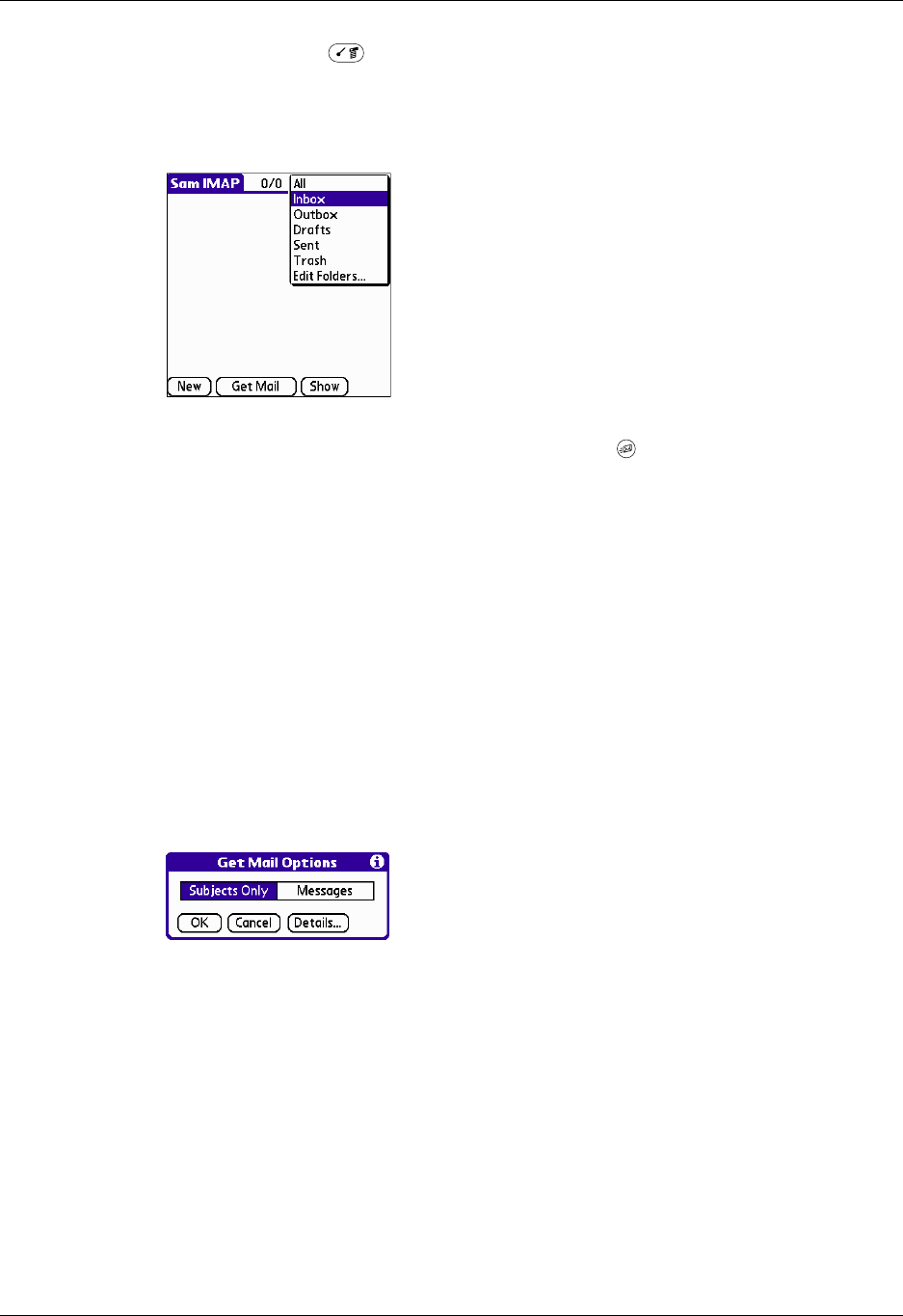
Getting, sending, and managing e-mail
187
3. Press Command + the number of the account you want from the list.
Alternately, tap the name of the account.
4. Tap the folders pick list, and tap Inbox if the Inbox is not displayed.
TIP Alternately, you can press the VersaMail button repeatedly to scroll through
the accounts you have configured in the VersaMail application until you get to the
account you want.
Getting e-mail by subject or getting the entire message
When you get e-mail messages, you can choose to get the subject only or to get the
entire message. You can also use the Details dialog box to select options for getting
unread e-mail only, downloading attachments, and using filters.
To get e-mail messages:
1. Tap Get Mail.
If you have e-mail stored in your Outbox, tap Get & Send.
2. In the Get Mail dialog box, tap Subjects Only to download subjects only or tap
Messages to download entire messages.
TIP You can turn off the Get Mail dialog box in VersaMail Preferences. See
“Setting preferences for getting and deleting e-mail” later in this chapter.
3. (Optional) Tap Details and select options for retrieving unread e-mail,
attachments, using filters, auto-disconnect, maximum download size, and
default connection type for this account. Up to ten attachments may be
retrieved with a message. Tap OK.
Palm, Inc. Confidential
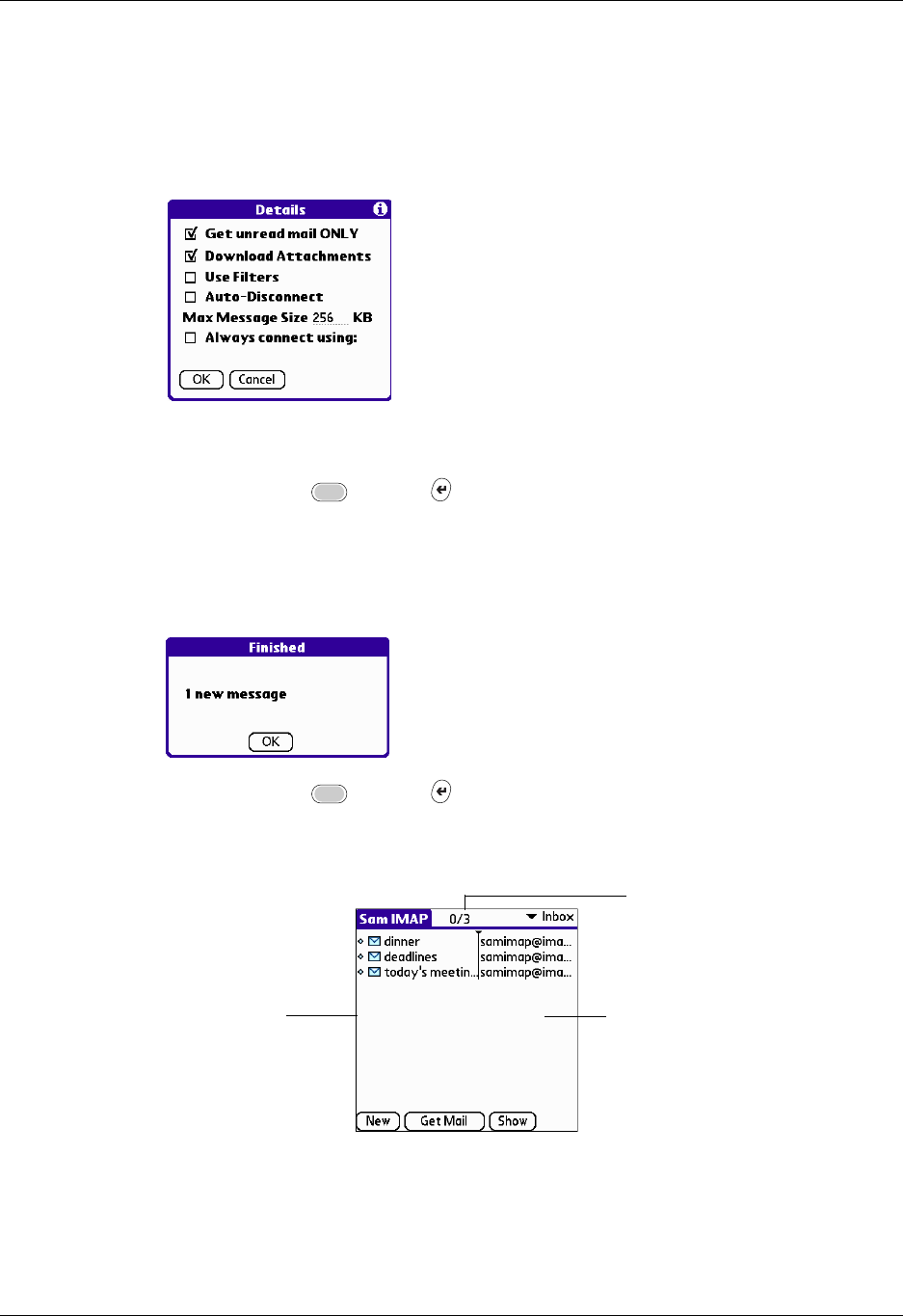
Chapter 17 Using Palm™ VersaMail™ Personal E-mail Software
188
NOTE See “Setting VersaMail connection preferences” earlier in this chapter
for information on the auto-disconnect feature. See “Selecting a different
service for a given e-mail account” earlier in this chapter for information on
setting a default connection type. See “Creating mail filters” later in this
chapter for more information about filters.
NOTE The maximum size of an incoming message is 5KB by default.
4. Press Function + Enter , or tap OK.
The Getting Messages dialog box shows updates as your e-mail is downloaded.
When the Getting Messages dialog box disappears, another dialog box appears
and displays the number of new e-mail messages.
5. Press Function + Enter , or tap OK.
A list of your e-mail appears in the Inbox.
Envelope icons
indicate whether a
message or
subject has been
downloaded, and
whether there are
any attachments
Shows unread/
total messages
Displays the time for
messages received today
and the date for all other
messages
Palm, Inc. Confidential
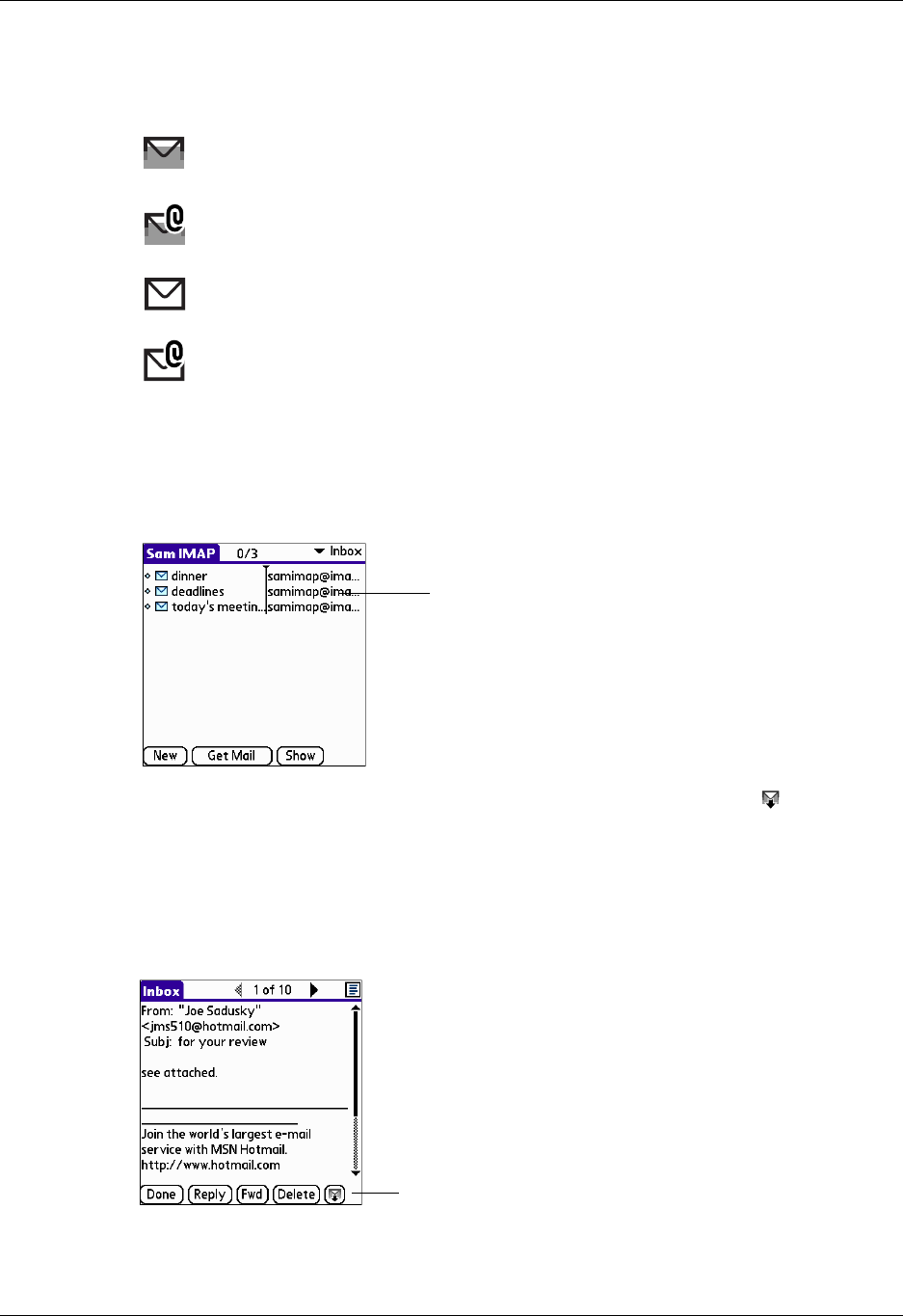
Getting, sending, and managing e-mail
189
Icons in the VersaMail application
The icons to the left of a message in the Inbox indicate the message’s status.
Reading e-mail
To read e-mail, tap the e-mail message in the Inbox or the folder where the message
is located.
If you chose to get messages by subjects only, tap the More button to view the
body of the e-mail message, plus any attachments. See “Getting e-mail by subject
or getting the entire message” earlier in this chapter.
If you chose to get entire messages, the body of the e-mail message is displayed.
However, if the downloaded message exceeds your maximum message size, only
a partial message is displayed. Tap the More button to view the entire message.
Only the subject header information is downloaded.
Only the subject header and attachment information are downloaded.
Part or all of the message text is downloaded.
Part or all of the message text and attachment information are
downloaded.
Tap to read
Tap More to view the entire
message
Palm, Inc. Confidential
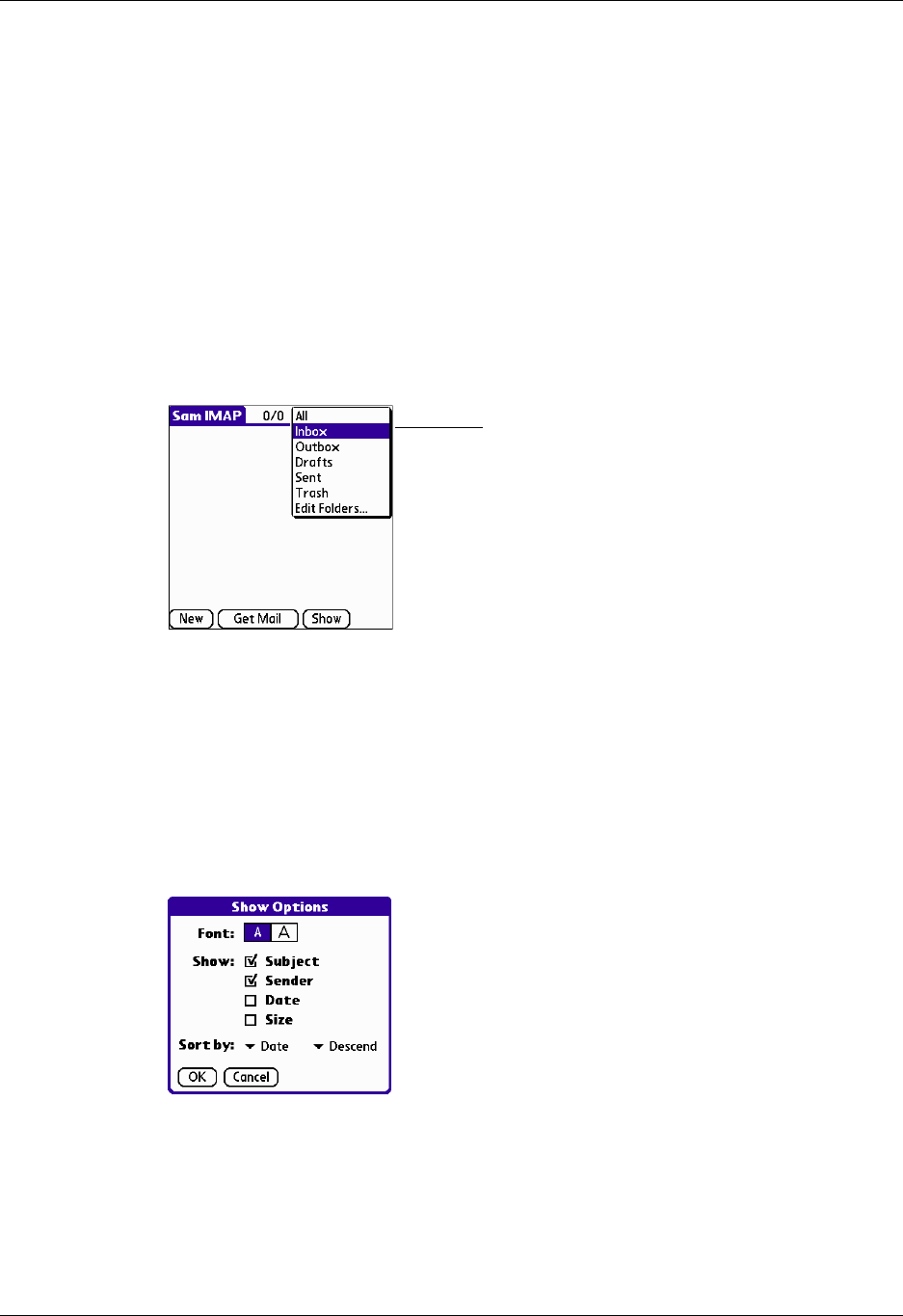
Chapter 17 Using Palm™ VersaMail™ Personal E-mail Software
190
To read a message:
1. Press Up or Down on the navigator to scroll to the message you want to read.
2. Press Select to select the message, and then press Select again to open the
message.
3. After reading the message, press Select to close the message.
Viewing other folders
When you get new e-mail, it appears in the account’s Inbox folder. You can move
e-mail between folders and then view it in the other folder.
To view other folders:
1. Tap the folders pick list in the upper-right corner of the screen.
2. Tap the folder you want to view.
Managing columns in the folder’s list view
The columns in each folder display various types of information, such as the
subject, date, or size of a message. You can display or hide specific columns or
change the width of the columns in the folder’s list view.
To display or hide a column in a folder’s list view:
1. Tap Show.
2. Tap the check box for each column that you want to show.
NOTE If you select Date, the Date column displays the message time for any
messages received today—that is, any message received after 12:01 A.M.
Otherwise, the Date column shows the date the message was received.
3. Tap the Font letter to display information in a larger or smaller font size.
Available folders
Palm, Inc. Confidential
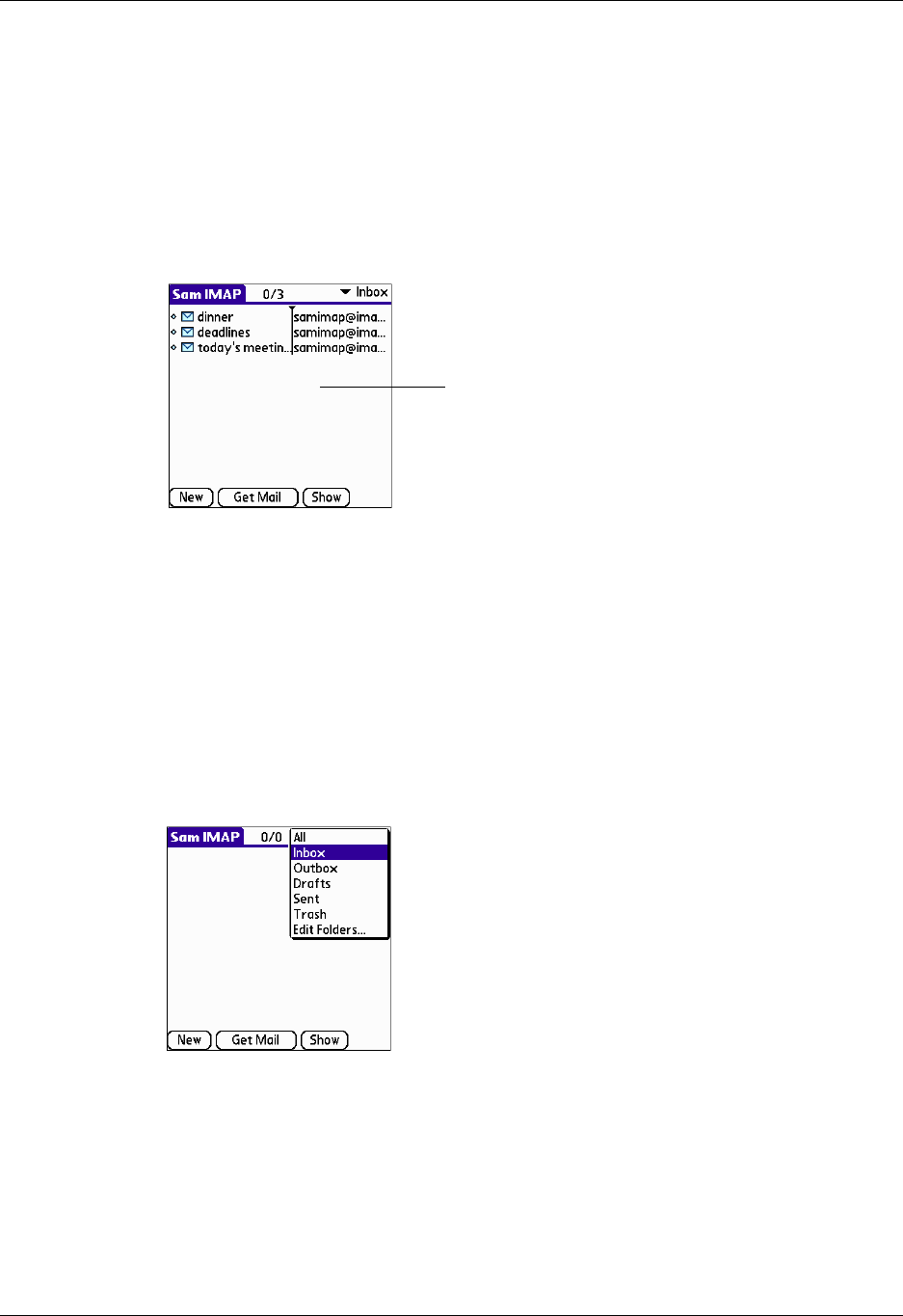
Getting, sending, and managing e-mail
191
To change the sort order:
1. Tap the Sort By pick list, and then tap the column name.
2. Tap Descend or Ascend to change the sort order.
To change the size of a column in the folder’s list view:
1. Tap and hold the stylus on the column divider.
2. Drag the column divider to change the width of the column.
Moving e-mail between folders
You can move one or more e-mail messages between folders.
To move one e-mail message:
1. Press Right on the navigator to move to and open the folders pick list in the
upper-right corner of the screen. Press Up or Down to move to the folder you
want, and the press Select to select the folder.
Alternately, tap the folders pick list in the upper-right corner of the screen, and
then tap the folder name.
2. Tap the icon to the left of the message, press Right on the navigator to open the
Message menu, press Down to move to the Move To option, and then press
Select to select this option.
Drag the column
divider left or right to
make the column
narrower or wider
Palm, Inc. Confidential
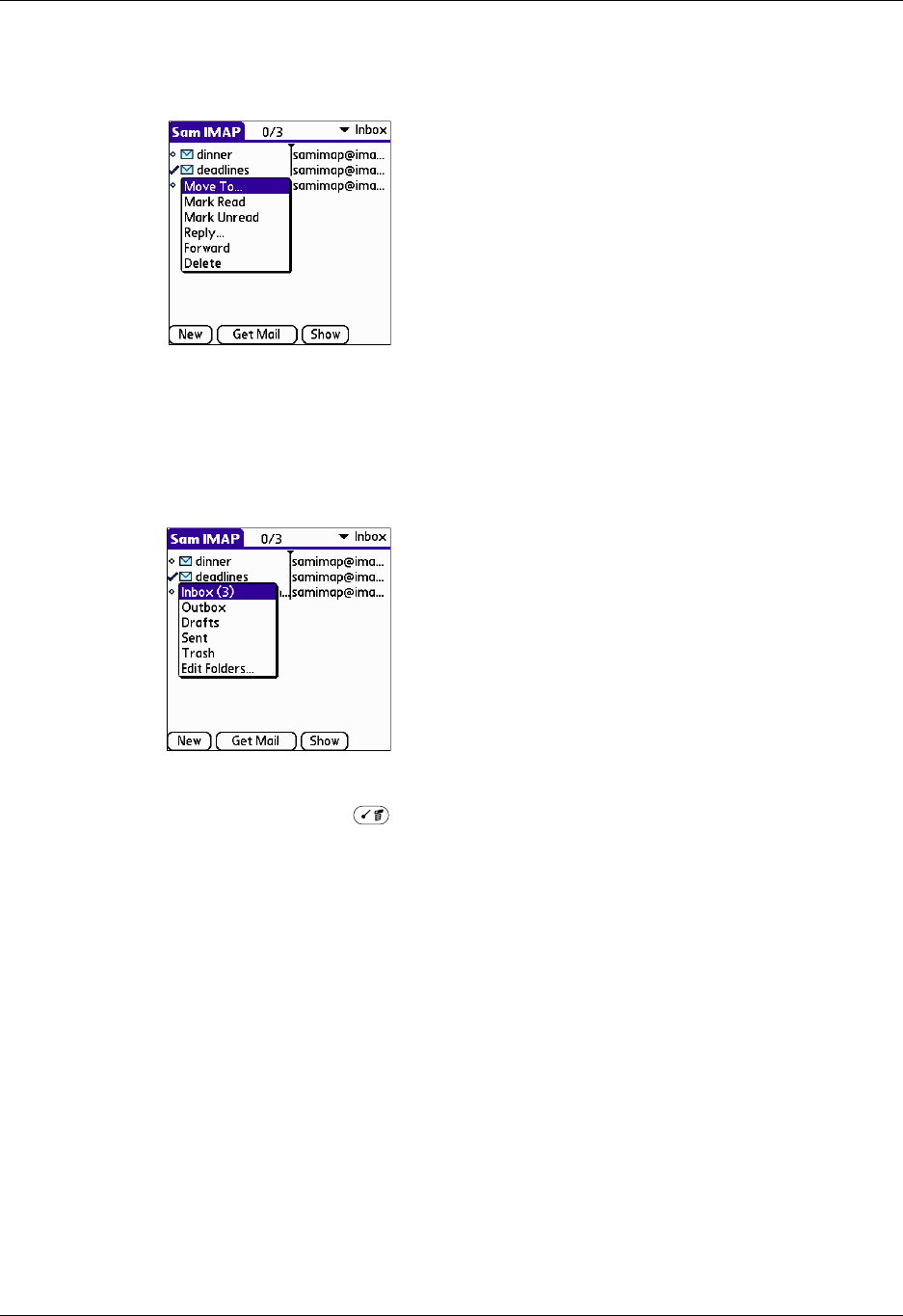
Chapter 17 Using Palm™ VersaMail™ Personal E-mail Software
192
Alternately, tap the icon to the left of the message, and then tap Move To from
the pop-up menu.
The folders pick list appears.
3. Press Up or Down on the navigator to move to the folder you want, and then
press Select to select the folder.
Alternately, tap the folder that you want.
TIP You can also move a single e-mail message from within the body of the message
by pressing Command , tapping the folder icon, and selecting the destination
folder from the pick list. See “Using the command bar” later in this chapter for more
information on the command bar.
To move multiple e-mail messages:
1. Tap the folder that contains the e-mail messages you want to move.
2. Select the messages by tapping to the left of each message icon.
TIP To select a group of messages, drag the stylus to the left of the message
icons.
Palm, Inc. Confidential
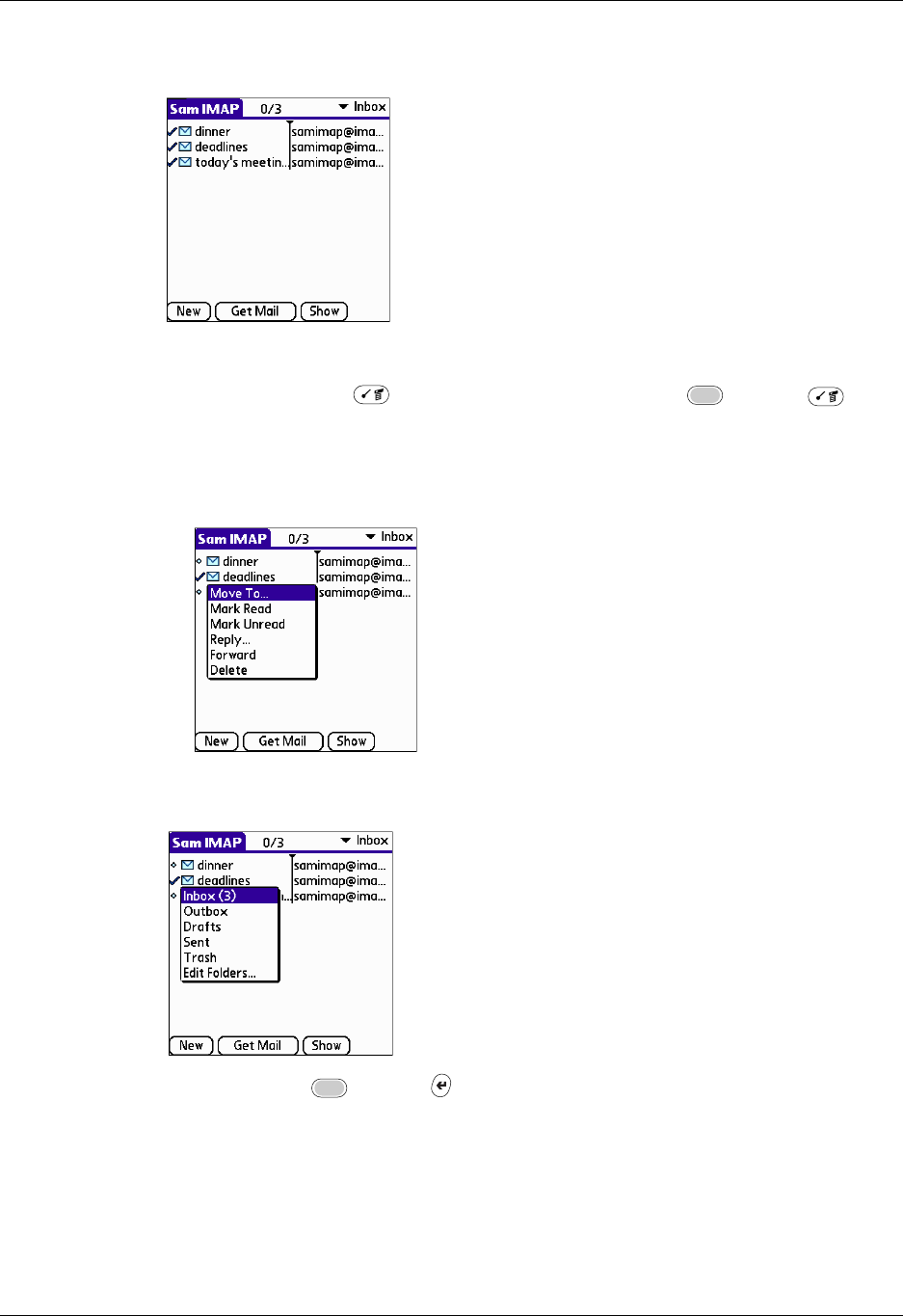
Getting, sending, and managing e-mail
193
A checkmark appears next to the selected messages.
3. Do one of the following:
– Press Command + V (alternately, press Function + Menu ), and
then select Move To on the Message menu.
– Tap a message icon next to a selected message, and then tap Move To on the
pick list.
4. Tap the folders pick list, and select a destination folder.
5. Press Function + Enter , or tap OK.
Palm, Inc. Confidential
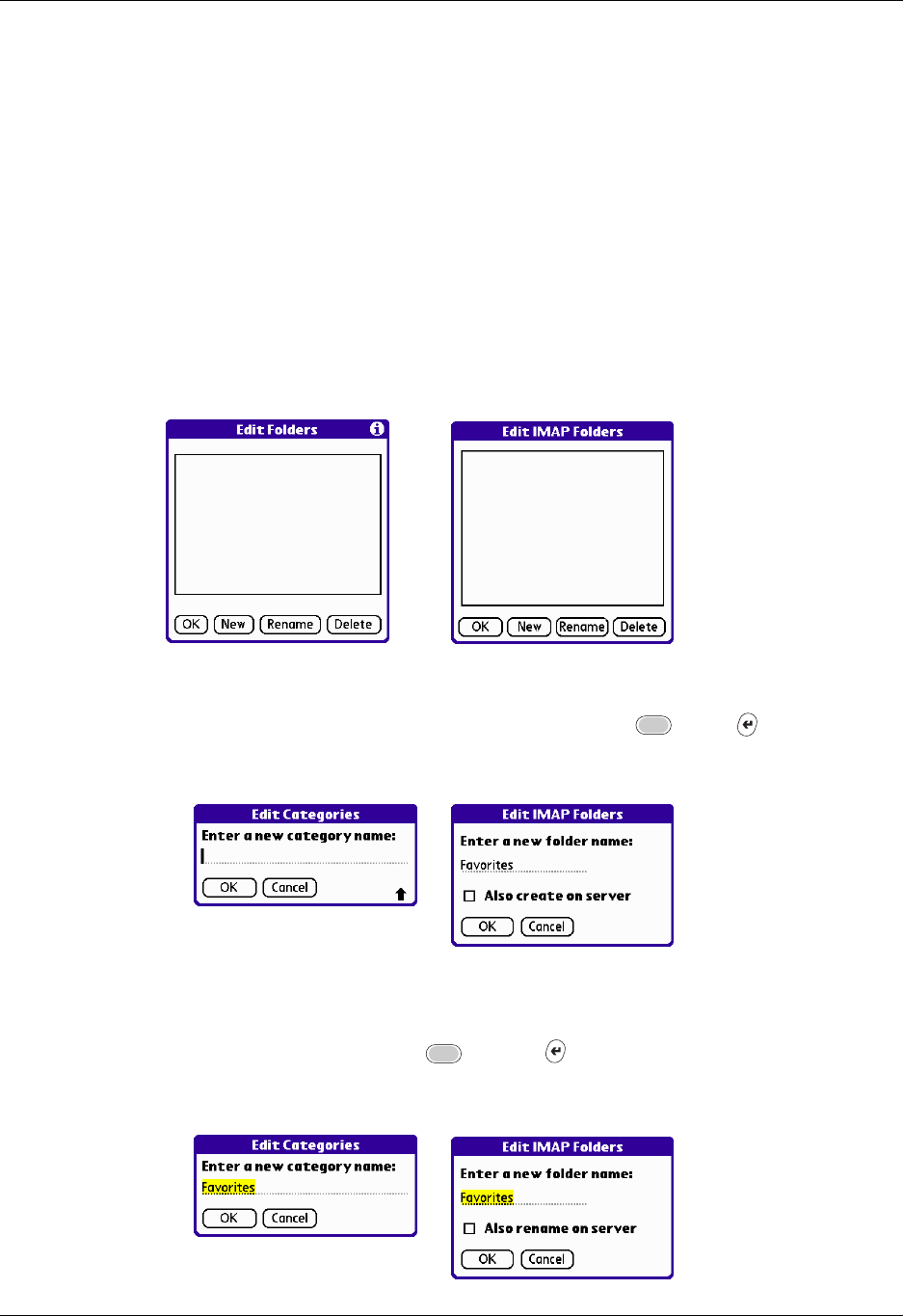
Chapter 17 Using Palm™ VersaMail™ Personal E-mail Software
194
Creating and editing mail folders
You can also create new folders so that you can store e-mail messages by subject,
person, or project. The VersaMail application has certain existing folders, such as
Inbox, Outbox, Drafts, and Trash.
The procedure for creating and editing folders varies slightly between POP and
IMAP e-mail accounts, as described in the following procedure.
To create and edit e-mail folders:
1. Tap the folders pick list in the upper-right corner of the screen, and then tap Edit
Folders.
2. On the Edit Folders or Edit IMAP Folders screen, select any of the following:
– To create a new folder, tap New, and then enter the new folder name. For
IMAP accounts only, select the check box if you also want to create the folder
on the server. When finished, press Function + Enter , or tap OK.
– To rename a folder, tap the folder name from the list on the screen, tap
Rename, and then enter the new folder name. For IMAP accounts only, select
the check box if you also want to rename the folder on the server. When
finished, press Function + Enter , or tap OK.
POP accounts IMAP accounts
POP accounts IMAP accounts
POP accounts IMAP accounts
Palm, Inc. Confidential
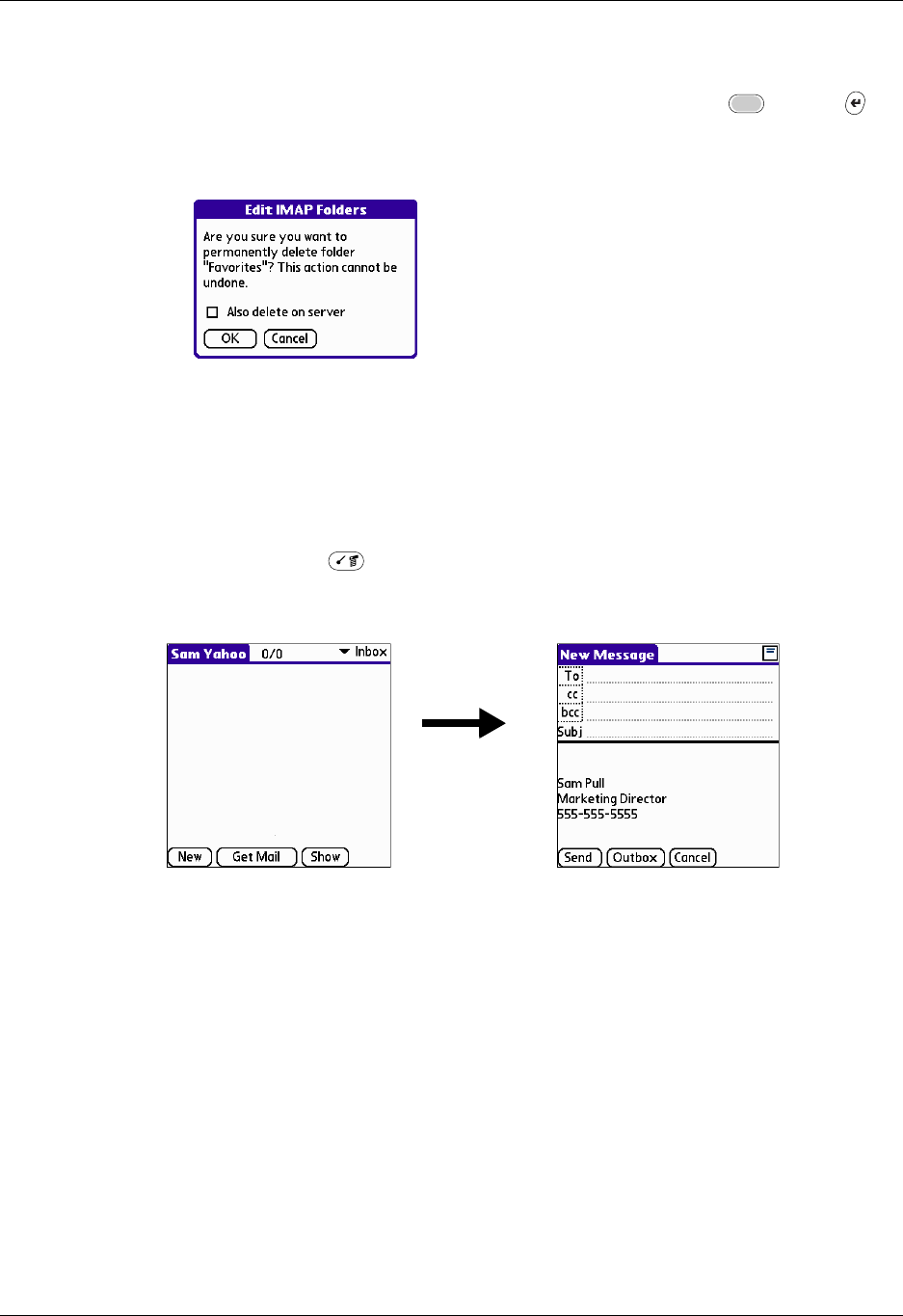
Getting, sending, and managing e-mail
195
– To delete a folder, tap the folder name from the list on the screen, and then
tap Delete. For IMAP accounts only, select the check box if you also want
to delete the folder on the server, and then press Function + Enter , or
tap OK. For POP accounts, the folder will be deleted immediately and you
will not see a confirmation screen.
Creating and sending new e-mail
When you create a new e-mail message, you can enter the person’s e-mail address
or use the Lookup screen to find a particular address.
To create a new e-mail message:
1. Press Command + N.
Alternately, tap New.
2. Enter the recipient’s name using one of the methods described in the next
procedures.
NOTE When you address a message to several recipients, you do not see all the
recipients on the To list because the list is truncated on the To line. If you tap the To
field, a dialog box shows all recipients for the current message.
Delete confirmation
appears for IMAP
accounts only
Palm, Inc. Confidential
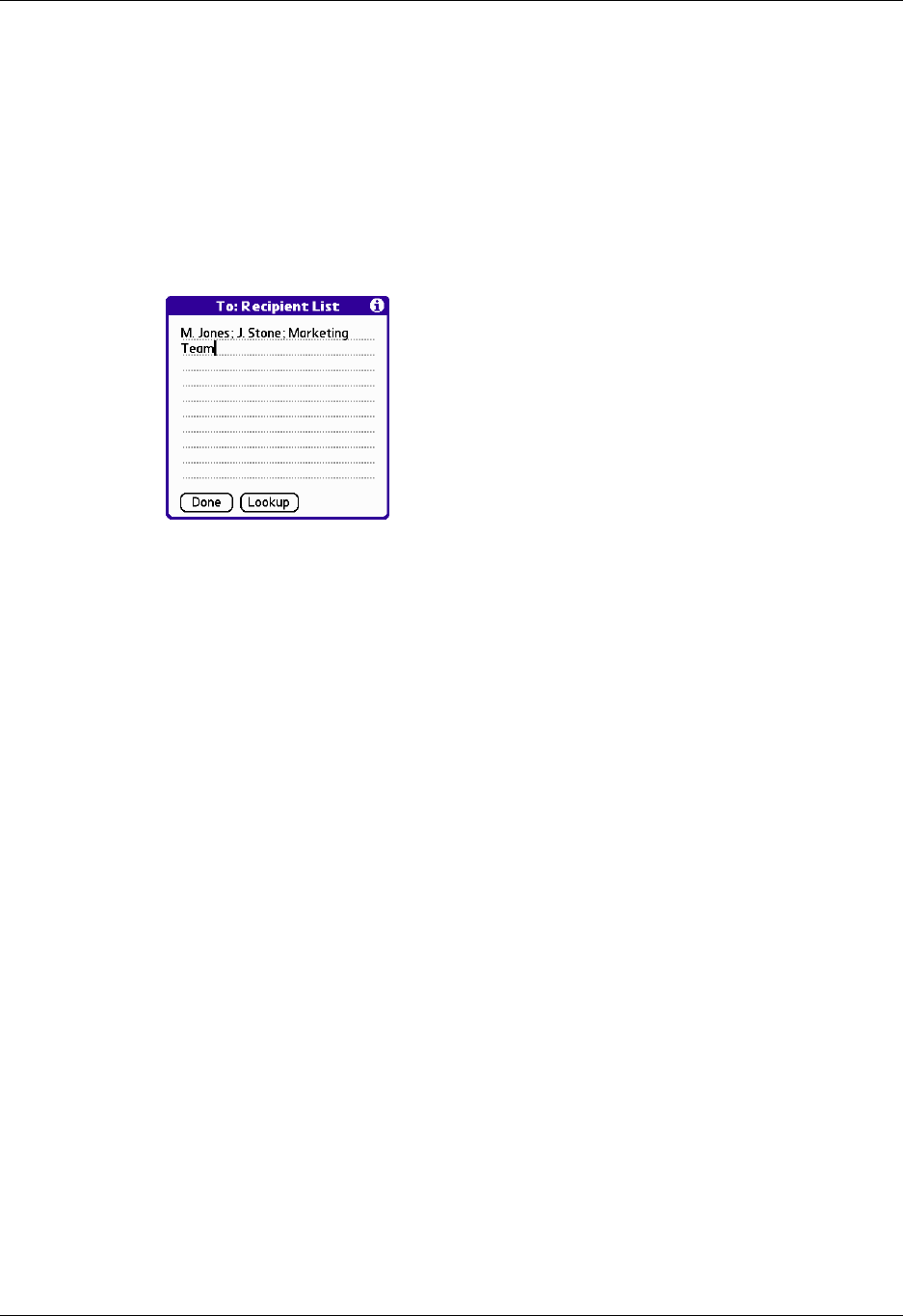
Chapter 17 Using Palm™ VersaMail™ Personal E-mail Software
196
Addressing a message by typing the address
You can address a message by entering the complete address.
To enter the address:
1. In the New Message screen, tap the To field and enter the address, and then tap
Done.
For multiple recipients, type a semicolon (;) and then a space between recipient
names.
NOTE If you enter a comma instead of a semicolon, it is automatically changed
to a semicolon. If you enter a space with no punctuation between names,
semicolons are not inserted and the e-mail message is improperly addressed.
If you want to edit an e-mail address that is longer than the line provided in the
New Message screen, tap the To field and edit the address.
2. To send copies, tap cc: or bcc: and enter the recipient’s address.
Copies (cc:) allow recipients to see the addresses of the other recipients, but
addresses in the blind copies (bcc:) field are hidden from all other recipients.
TIP To automatically fill in the address as you type, see “Using Smart
Addressing to address a message” later in this chapter.
Addressing a message using Address Book
You can enter a recipient’s address by using the Lookup screen to select the
address. The names and addresses in the Lookup screen come from Address Book.
To use an address from Address Book:
1. In the New Message screen, tap the word To.
2. On the Recipient List screen, tap Lookup.
Palm, Inc. Confidential

Getting, sending, and managing e-mail
197
3. On the Address Lookup screen, tap the address you want, and then tap Add.
4. Repeat steps 2 and 3 to add more addresses.
5. Tap Do ne.
6. To enter an address in the cc: or bcc: field, tap the field name and follow the steps
given for the To field.
Using Smart Addressing to address a message
Smart Addressing types ahead and completes a recognized e-mail address. Smart
addressing automatically fills in fields when the recipient’s name and e-mail
address are in your Address Book.
By default, Smart Addressing is selected in VersaMail Preferences.
To use Smart Addressing to address a message:
1. In the New Message screen, tap the word To.
2. Start entering the person’s name, such as Joe Smith.
Once the name is recognized from your Address Book, the name and e-mail
address are automatically completed on the recipient list. For example, if you
have a Joe Smith and a Joan Smith in your Address Book (and no other names
starting with J), once you type “Joe,” the entry “Joe Smith” is completed with
the correct e-mail address.
3. Tap Do ne.
Palm, Inc. Confidential
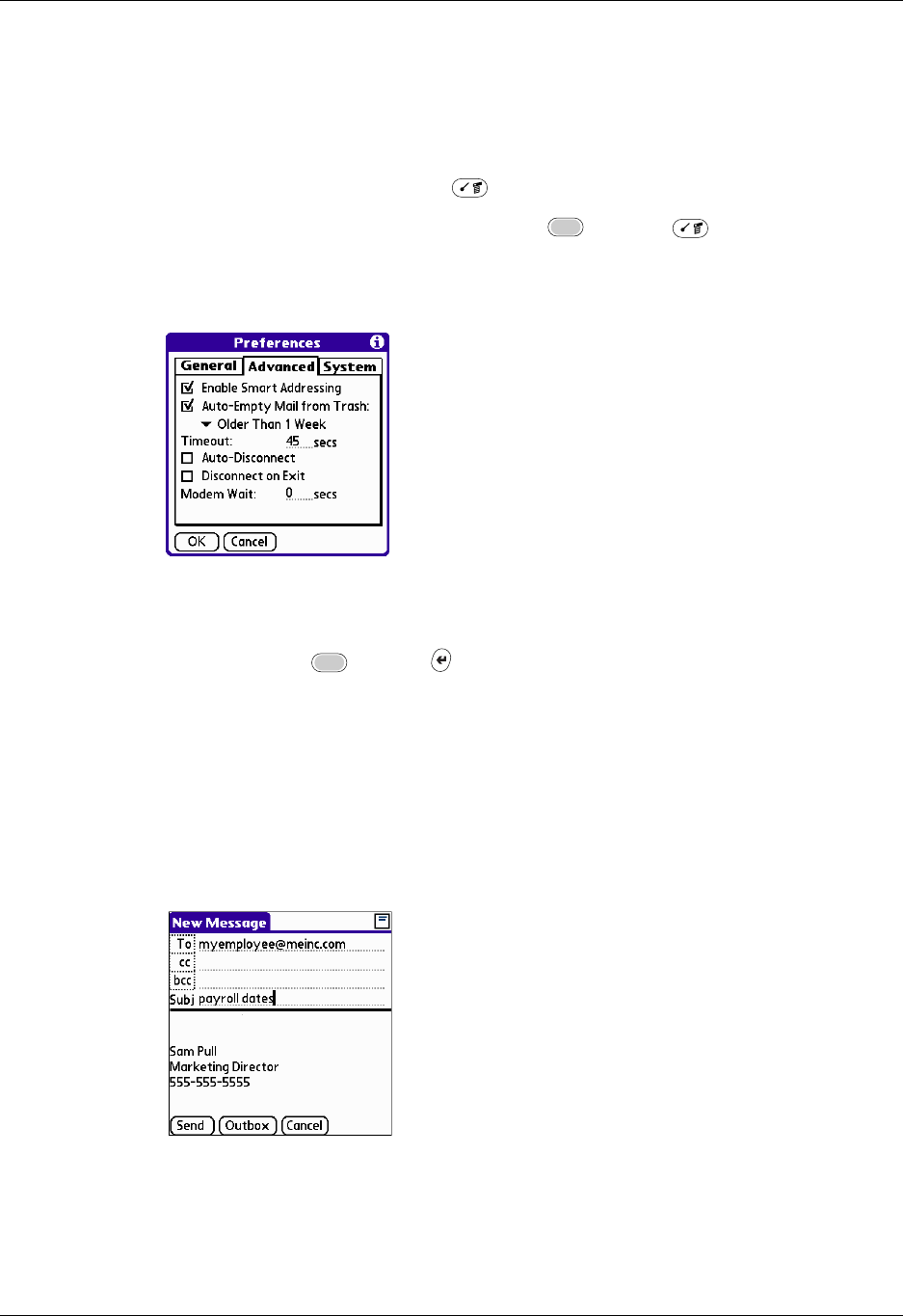
Chapter 17 Using Palm™ VersaMail™ Personal E-mail Software
198
Turning Smart Addressing on or off
You can turn Smart Addressing on or off in VersaMail Preferences. By default,
Smart Addressing is turned on.
To turn Smart Addressing on or off in VersaMail Preferences:
1. In the Inbox, press Command + R.
Alternately, in the Inbox, press Function + Menu , tap Options, and
then tap Preferences.
2. Tap Advanced.
3. Tap the Enable Smart Addressing check box if it is not selected. A checkmark
means it is turned on.
4. Press Function + Enter , or tap OK.
Composing and sending e-mail
After you enter your recipient addresses, you can compose the rest of the e-mail
message.
To compose the rest of the e-mail and send it:
1. Tap the Subject field and enter the subject of your e-mail.
Palm, Inc. Confidential
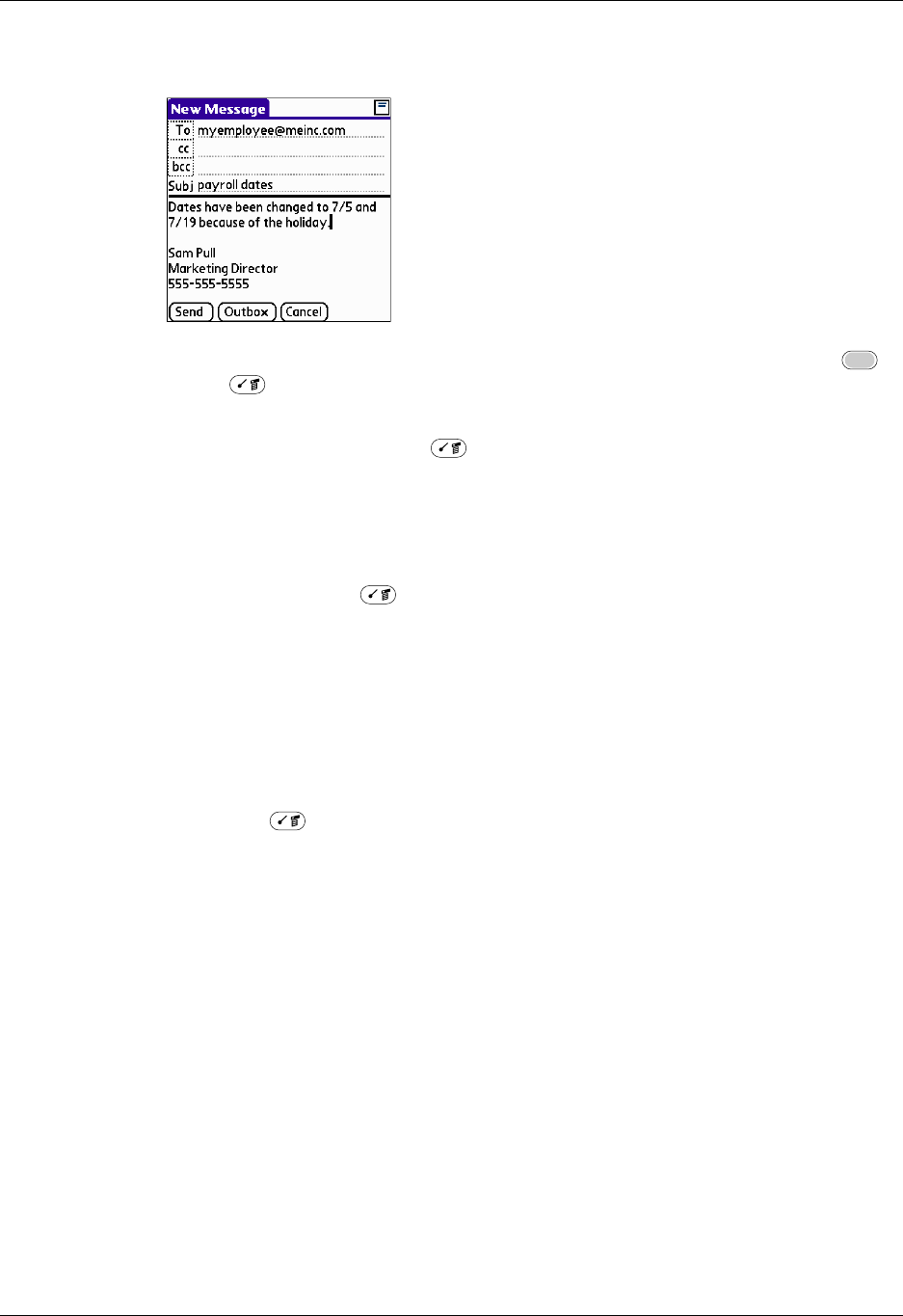
Getting, sending, and managing e-mail
199
2. Tap the area below the Subject line and enter the text of your e-mail.
To access the editing features available on the Edit menu, press Function +
Menu . The first character of each sentence is automatically capitalized for
you.
3. (Optional) Press Command + A (alternately, tap the Options menu and
select Add Attachments). See “Attaching files to e-mail” later in this chapter.
4. Tap one of the following to send the e-mail:
TIP You can also tap Save To Drafts from the Options menu (or press
Command + W) to save this message in the Drafts folder rather than
sending it.
Completing drafts
If you are composing an e-mail message and you exit the VersaMail application
before tapping Outbox, Send, or Cancel, the e-mail automatically moves to the
Drafts folder. To finish editing the e-mail, tap the folders pick list and select Drafts.
Select the e-mail you want to complete or edit, and tap Edit. You can also delete the
e-mail in the Drafts folder.
Send Sends the e-mail immediately. (Alternately, press
Command + Y.)
Outbox Stores e-mail in the Outbox so you can compose e-mail
offline and then send all e-mail during one connection with
the server. To send your e-mail later, go to the Outbox and
tap Get & Send. The connection to the mail server is
truncated and all the e-mail in the Outbox is delivered.
Palm, Inc. Confidential
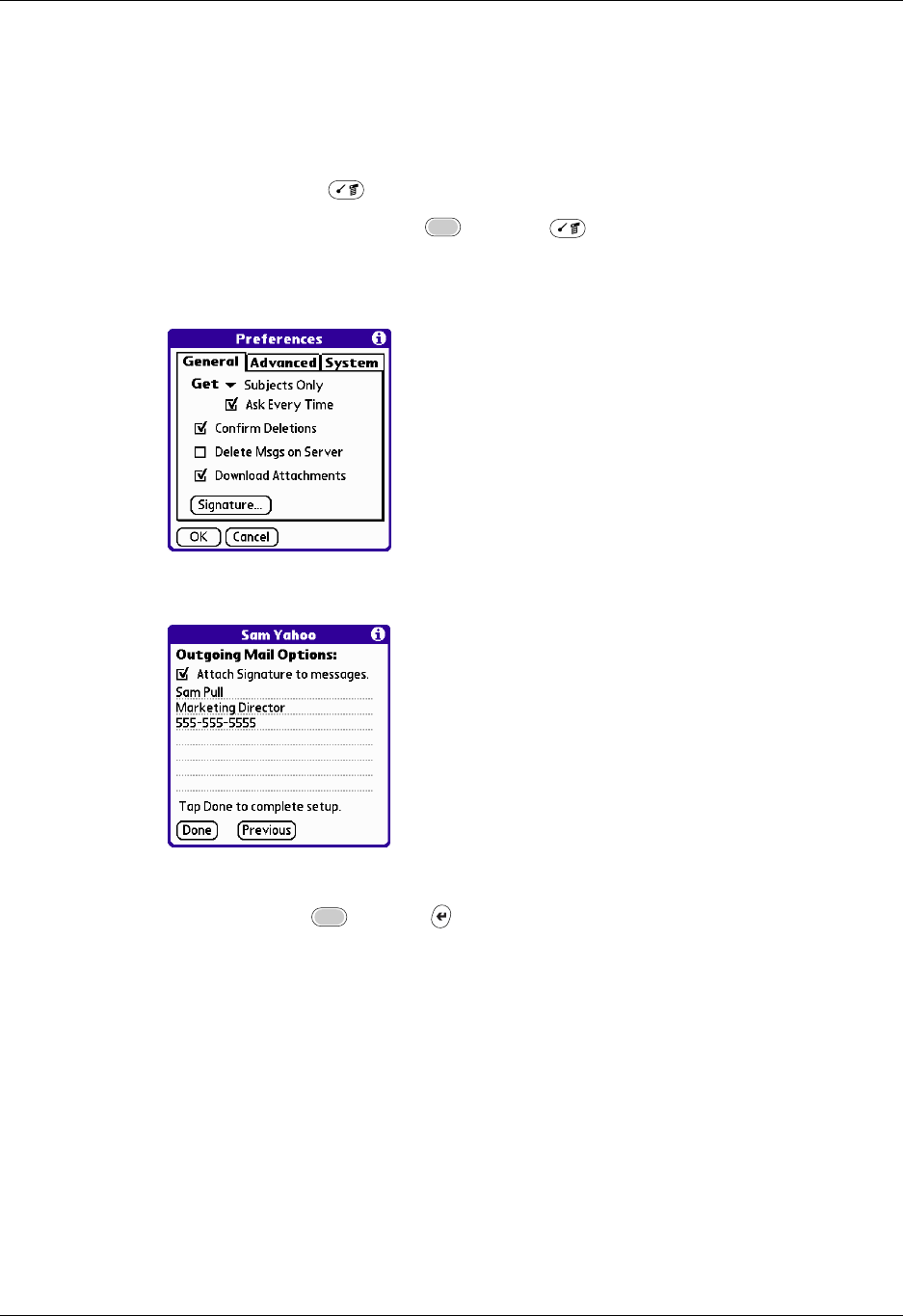
Chapter 17 Using Palm™ VersaMail™ Personal E-mail Software
200
Attaching a personal signature
You can include a personal signature, such as your name, e-mail address, and
telephone number, to each e-mail you send.
To create a personal signature:
1. Press Command + R.
Alternately, press Function + Menu , tap Options, and then tap
Preferences.
2. Tap Signature.
3. Tap the Attach Signature check box to select it.
4. Enter your signature information.
5. Press Function + Enter , or tap OK.
Palm, Inc. Confidential
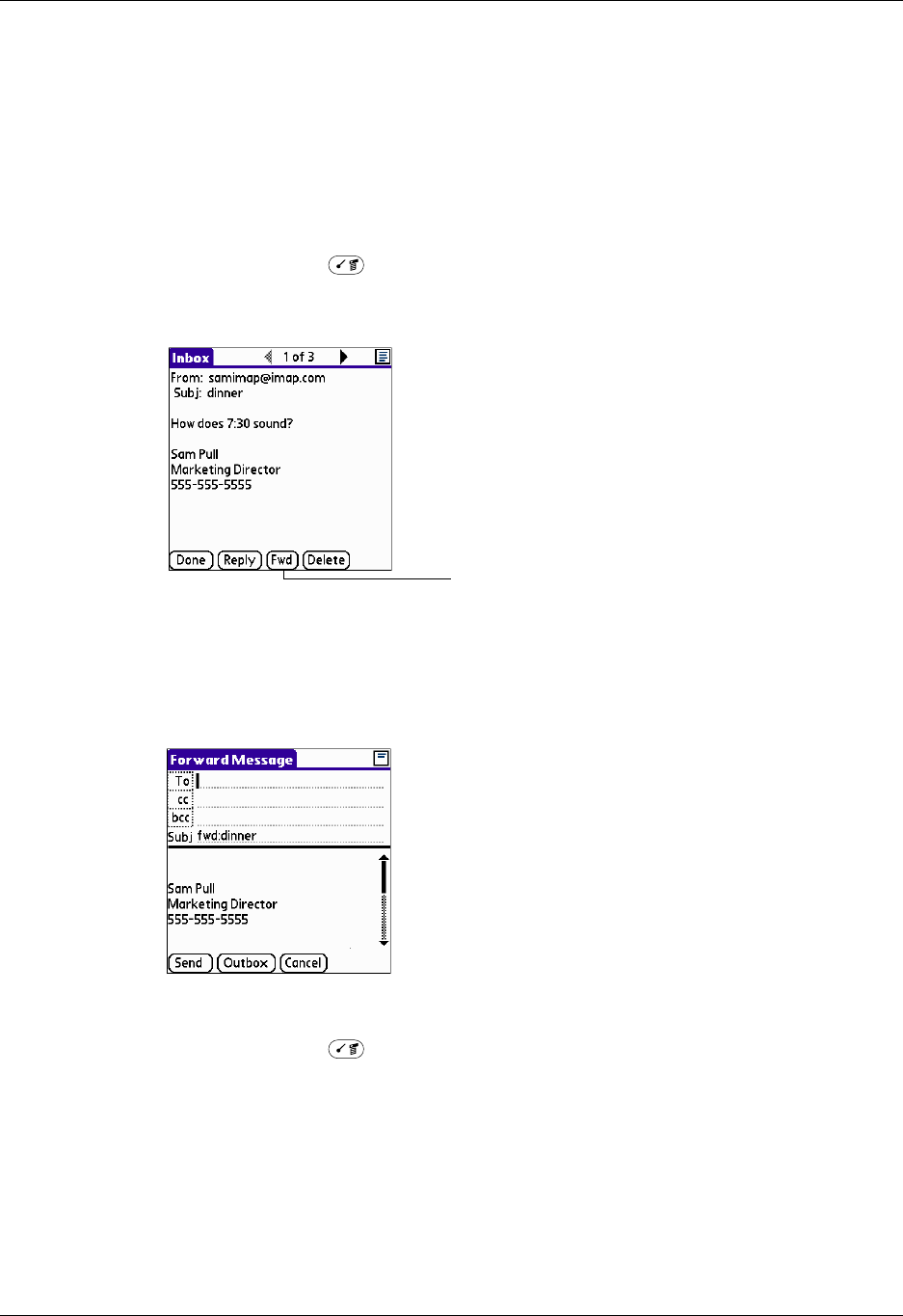
Getting, sending, and managing e-mail
201
Forwarding e-mail
You can quickly forward e-mail messages from any folder other than the Outbox
folder.
To forward e-mail:
1. Tap the folders pick list and select the folder that contains the e-mail.
2. Tap the e-mail message to display it.
3. Press Command + F.
Alternately, tap the Forward button.
4. Tap the word To.
5. On the Recipient List screen, enter or look up the recipient address. See the
procedure for creating new e-mail earlier in this chapter for more information
on addressing messages.
6. (Optional) Enter some text describing the forwarded message.
7. Press Command + Y (alternately, tap Send) to send the message, or tap
Outbox to store it in the Outbox.
Ta p For wa r d
Palm, Inc. Confidential
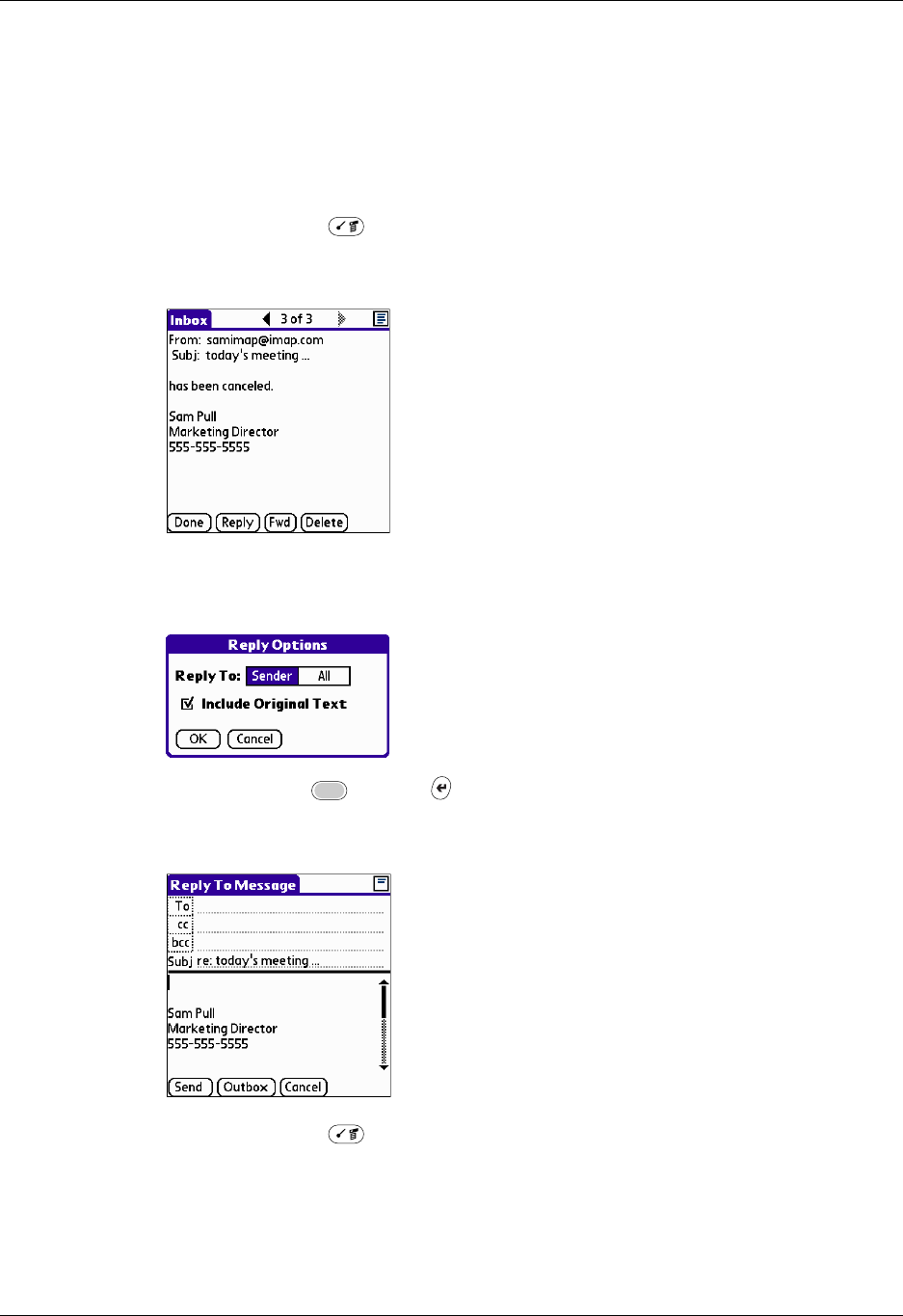
Chapter 17 Using Palm™ VersaMail™ Personal E-mail Software
202
Replying to e-mail
You can reply to an e-mail as you are reading it, or start the reply when viewing
messages in the folders list view.
To reply to an e-mail that you are reading:
1. Tap the e-mail you want to reply to.
2. Press Command + O.
Alternately, tap Reply.
3. In the Reply Options dialog box, select options for replying to the sender only
or to all e-mail recipients, and for including original message text.
4. Press Function + Enter , or tap OK.
5. Enter a reply.
6. Press Command + Y (alternately, tap Send) to send the message, or tap
Outbox to send it later.
Palm, Inc. Confidential
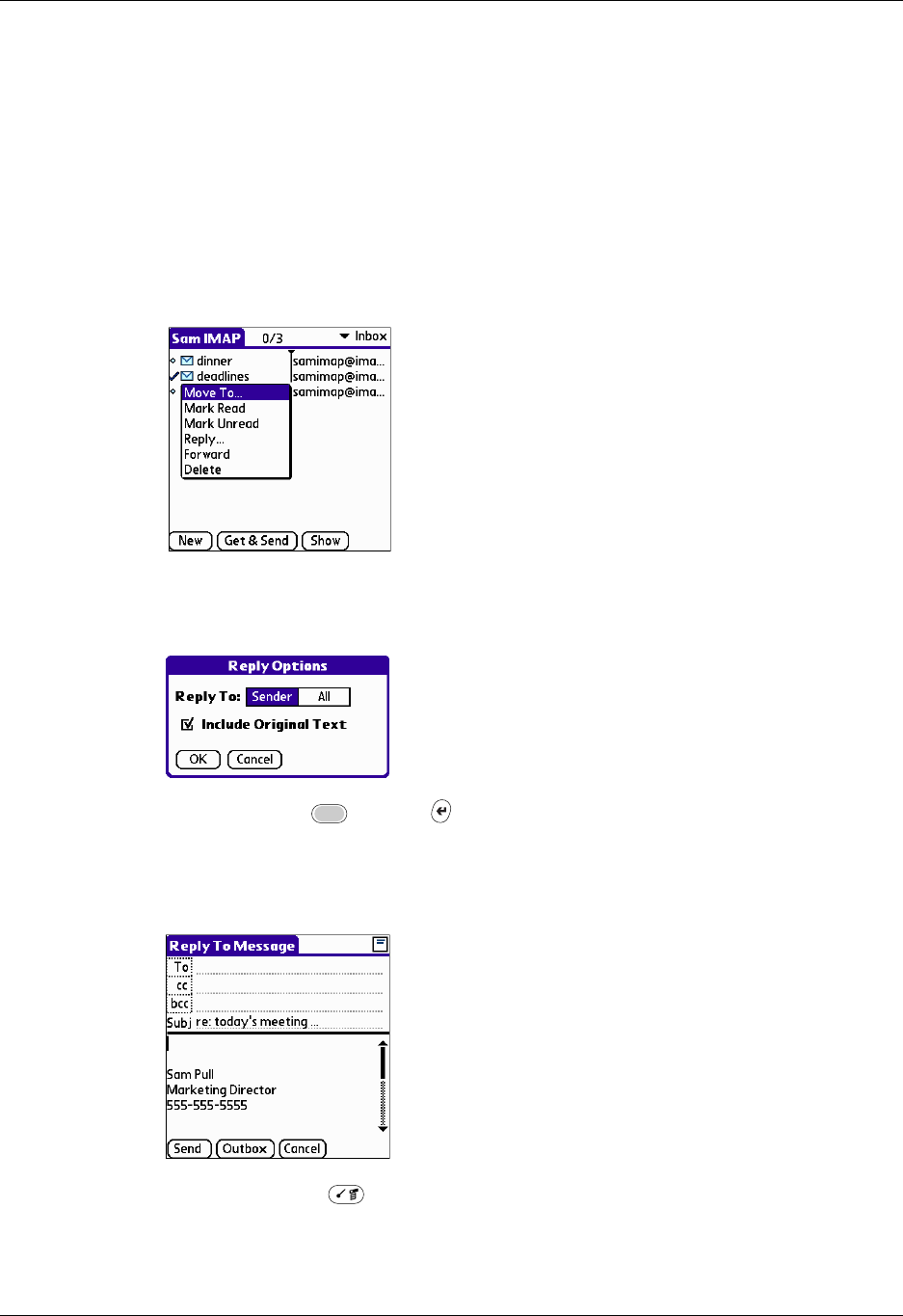
Getting, sending, and managing e-mail
203
To reply to an e-mail from the folders list:
1. On the message screen, press Right on the navigator to move to and open the
Options menu.
2. Press Down on the navigator to move to the Reply option, and then press Select
to select this option.
TIP Alternately, you can tap the folders pick list, select the folder that contains
the e-mail, tap the envelope icon next to the message, and then tap Reply on
the pick list.
3. In the Reply Options dialog box, select options for replying to the sender only
or to all e-mail recipients, and for including original message text.
4. Press Function + Enter , or tap OK.
The e-mail is addressed.
5. Enter a reply.
6. Press Command + Y (alternately, tap Send) to send the message, or tap
Outbox to send it later.
Palm, Inc. Confidential

Chapter 17 Using Palm™ VersaMail™ Personal E-mail Software
204
Working with attachments
You can easily download, view, and send attachments with e-mail messages.
Viewing attachments on your handheld
At times e-mail contains attached files, such as Microsoft Word or text files, that
you want to view on your handheld. You can view the following attached files:
vCard (.vcf) This is an address.
vCal (.vcs) This is usually a calendar appointment or a To Do task.
Text (.txt) This is usually a memo or another plain text file.
HTML (.html or
.htm) Usually a web page or a formatted text file. By default, the
VersaMail application strips the formatting and shows only the
text of most HTML attachments. However, some browsers allow
other applications to pass them a file for viewing in full HTML.
If your browser supports this function, you can view HTML
attachments with all formatting intact. You do not need to do
anything different in the steps for downloading and viewing
attachments; the attachment is automatically opened in the
correct format for your handheld (text only or full HTML) based
on the applications you have installed.
Microsoft Word
(.doc) The formatting is stripped and shows the text of most Microsoft
Word documents is shown.
Other application
files (such as
graphics files)
For other types of application files, your handheld may contain
a viewer that allows other applications to pass it a file for
viewing. For example, your handheld may contain an image
viewer that allows another application to pass it a JPEG or GIF
attachment for viewing. You do not need to do anything
different in the steps for downloading and viewing attachments;
if your handheld contains such a viewer, the attachment is
automatically opened. If your handheld does not contain such a
viewer, you cannot view the attachment.
PRC (.prc) This is a Palm OS® application that you can install and run on
your handheld.
PDB (.pdb) This is a file that works with specific Palm™ applications.
Palm, Inc. Confidential
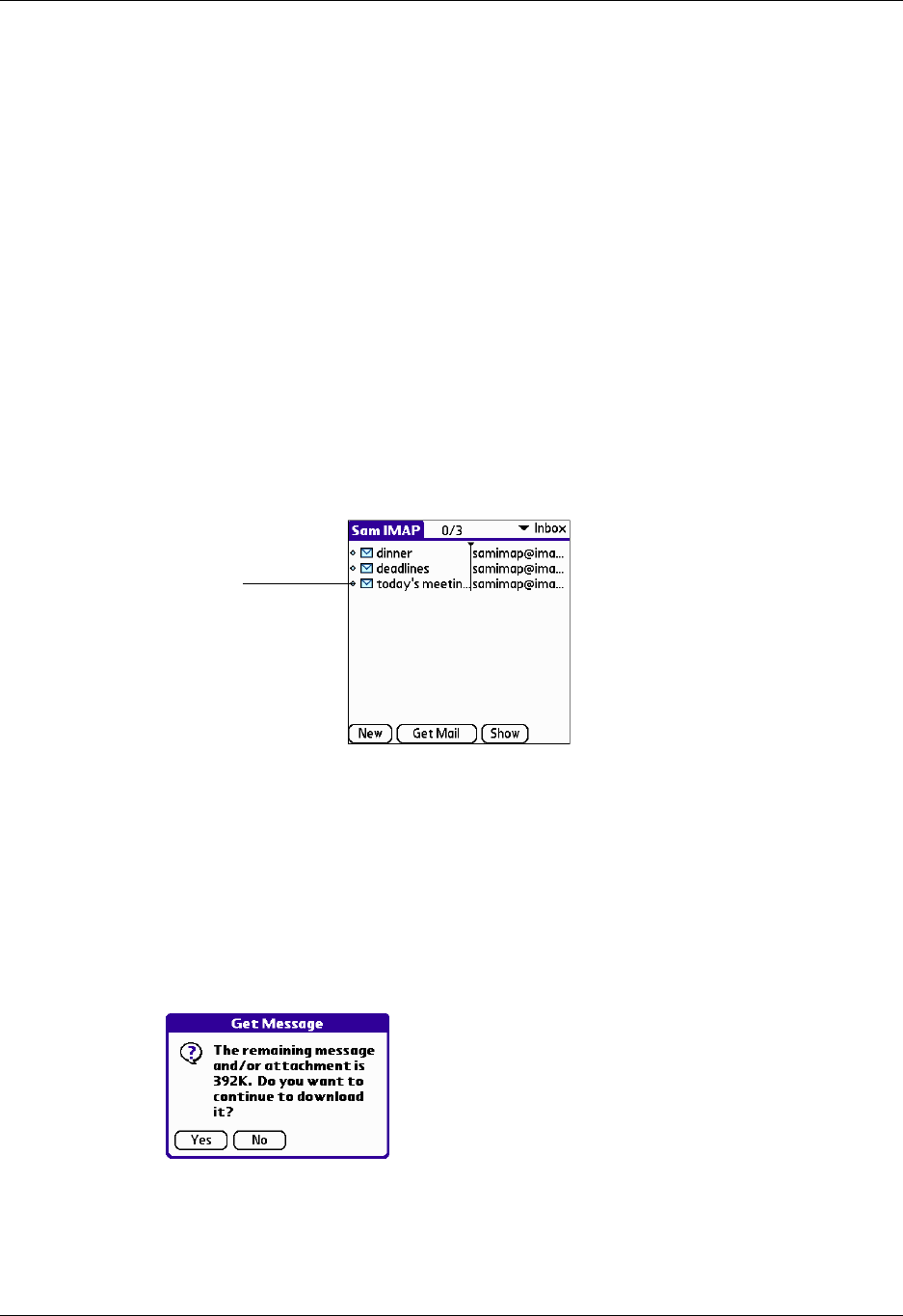
Getting, sending, and managing e-mail
205
Among the types of attachments you can receive are the following handheld
application files:
■Address Book entries
■Date Book appointments
■To Do list items
■Memos
NOTE The maximum message size that you can retrieve is 60KB for the body text
and 2MB total, including attachments. If the attachment is too large, it cannot be
downloaded to the handheld.
To view an attachment:
1. In the Inbox, tap the message with the attachment.
A paper clip icon appears on the message’s icon if the message has an
attachment that has been downloaded.
If you choose to get messages by subject only, you must tap More for each
downloaded message in order to view the body of the e-mail message plus any
attachments.
If the option Download Attachments is selected in the VersaMail Preferences,
any attachments that do not cause the message to exceed the maximum
message size are downloaded. Otherwise, you see a message showing that the
attachments were too large and asking if you would like to continue
downloading them.
For example, if the maximum message size is 5KB and you download a body of
2KB, then any attachment under 3KB is also downloaded, and any attachment
over 3KB is not. See “Downloading large attachments” later in this chapter.
Paper clip icon
indicates
downloaded
attachment
Palm, Inc. Confidential
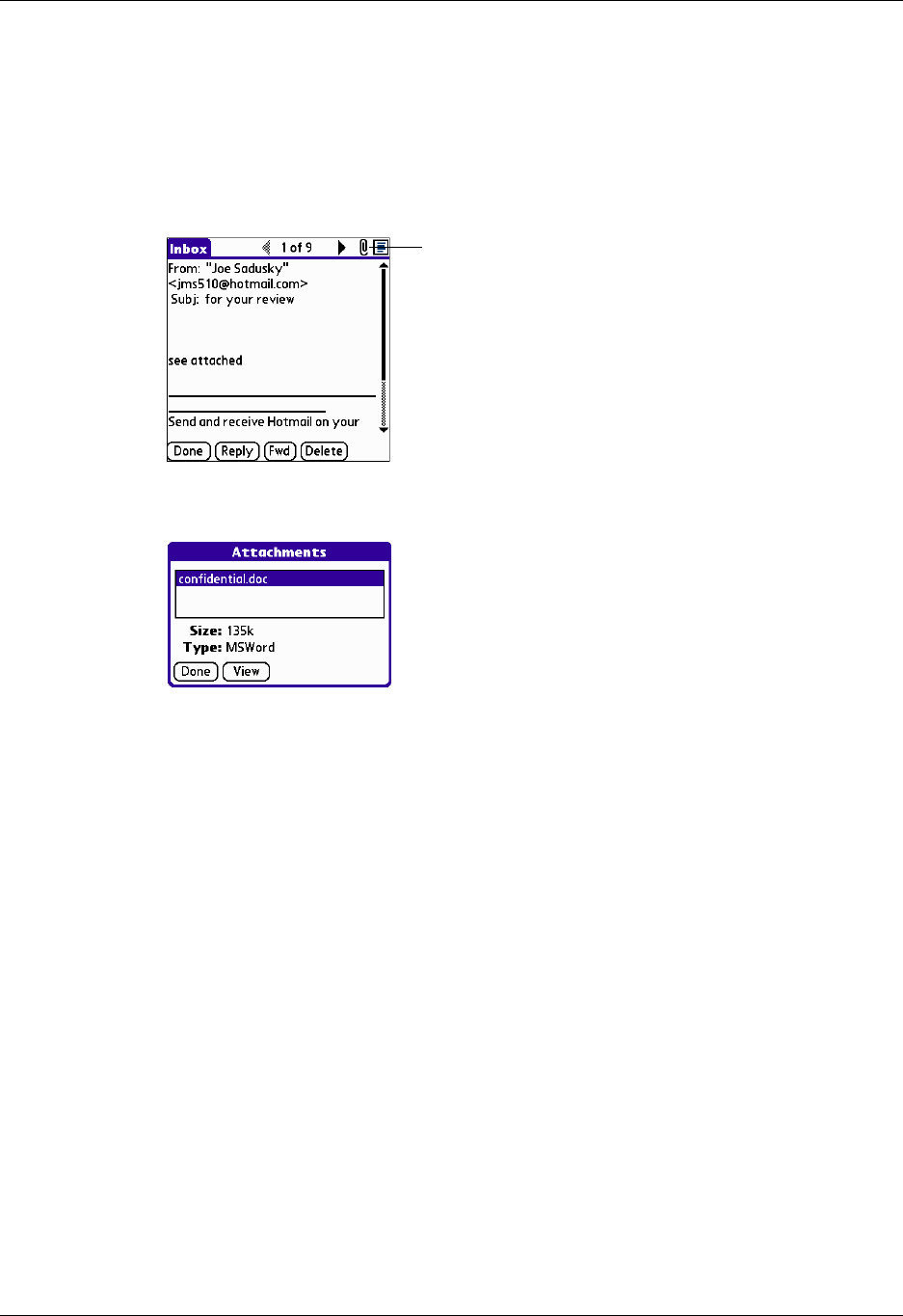
Chapter 17 Using Palm™ VersaMail™ Personal E-mail Software
206
If an attachment is not downloaded, the message will not show a paper clip icon
in the Inbox even though it was sent with an attachment.
2. Click the paper clip icon in the upper-right corner. If the attachment is not
downloaded, a paper clip icon will not appear even though the message was
sent with an attachment. You must download the attachment for the paper clip
icon to appear.
3. Tap the name of the attachment you want to view, and tap View.
4. When you have finished viewing the attachment, tap Done. This returns you to
the Attachments dialog box, where you can select another attachment to view if
you want to.
5. When you have finished viewing all attachments, tap Done on the Attachments
dialog box. This returns you to the Message screen.
Downloading large attachments
Downloading and viewing a message with a single attachment that exceeds your
maximum message size, or a message with multiple attachments whose total size
exceeds your maximum message size, requires some extra steps.
Tap paper clip icon to view
attachment
Palm, Inc. Confidential
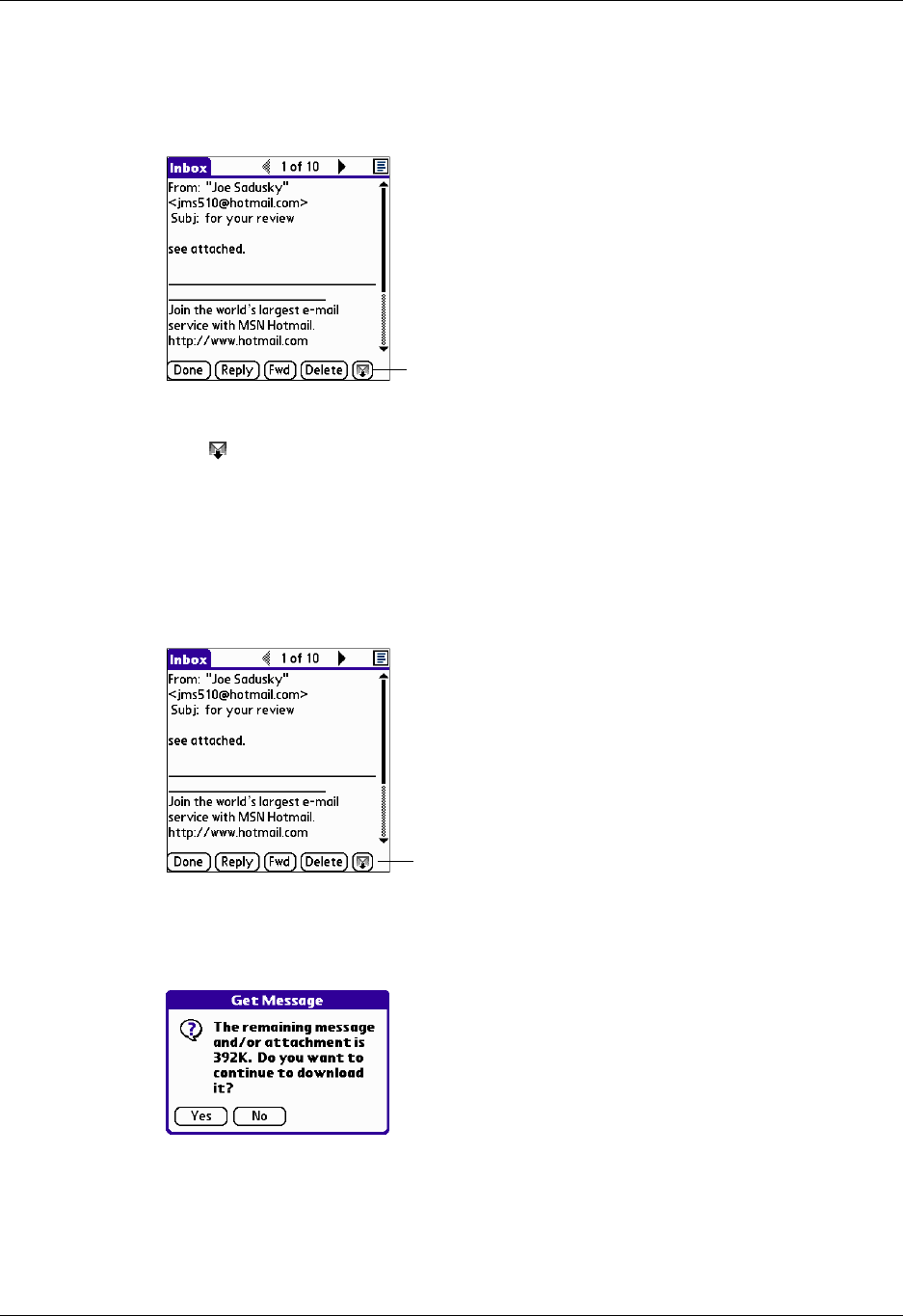
Getting, sending, and managing e-mail
207
To determine if a message has an attachment or multiple attachments that exceed the
maximum message size:
■In the Inbox, tap the message title.
If the message plus attachments exceeds the maximum message size, the More
button appears on the Message screen. In the case of multiple attachments, if
some of the attachments were downloaded completely, you see both the paper clip
icon (indicating fully downloaded attachments) and the More button (indicating
incompletely downloaded attachments).
To download a single attachment that exceeds the maximum message size:
1. Tap the More button.
2. Tap No to stop downloading and return to the Message screen.
Tap Yes to continue downloading the entire message with attachment.
3. (Optional) Tap Cancel to stop downloading and return to the Message screen.
When downloading is complete, the paper clip icon appears and the More button
is no longer displayed. Follow the procedure for viewing an attachment presented
earlier in this chapter.
More button indicates that message
plus any attachments exceeds
maximum message size
Ta p M o r e
Palm, Inc. Confidential
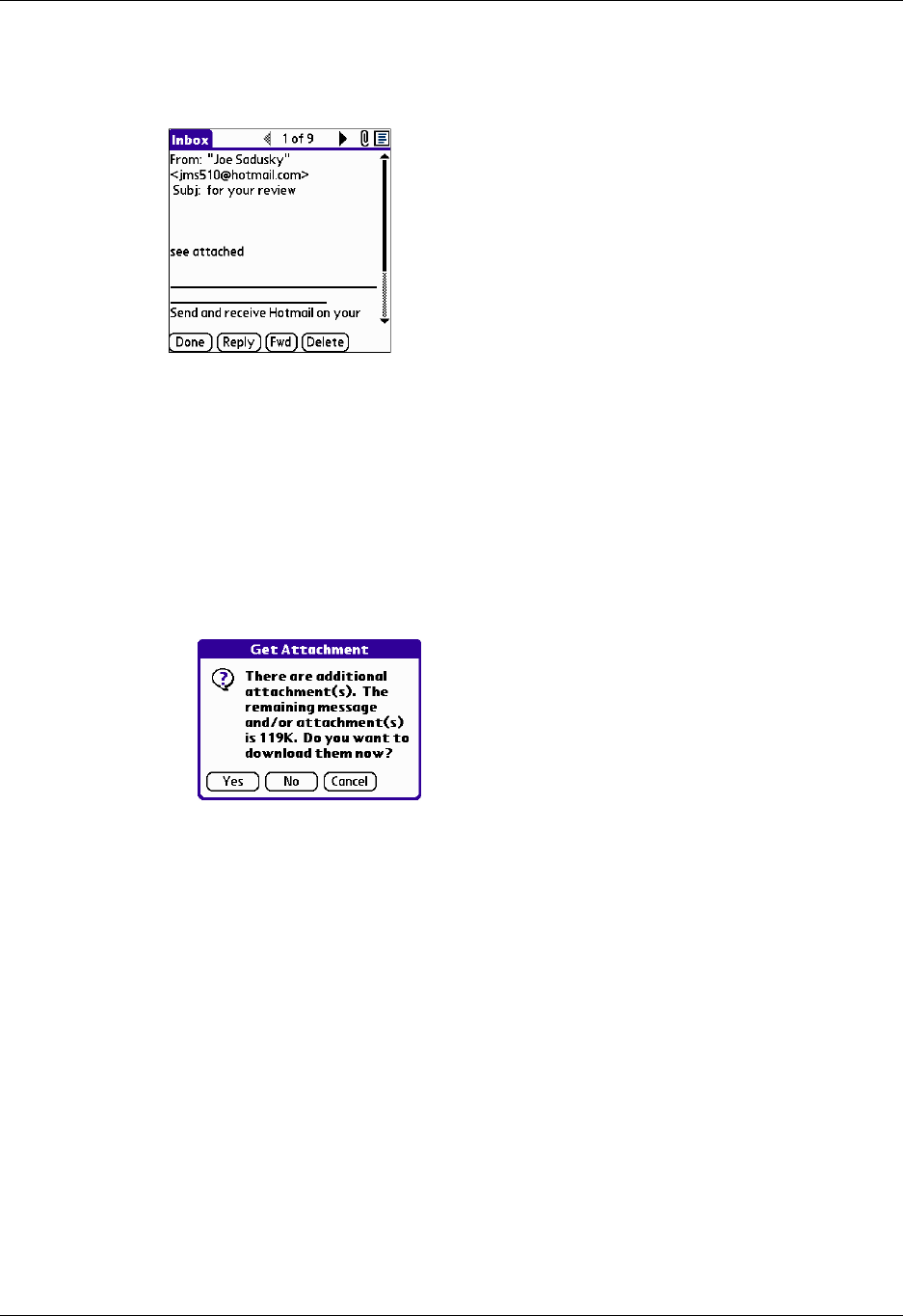
Chapter 17 Using Palm™ VersaMail™ Personal E-mail Software
208
To download multiple attachments whose total size exceeds the maximum message size:
1. Tap the paper clip icon.
2. Select one of the following:
– To return to the Message screen, tap Cancel.
– To view any fully downloaded attachments without continuing to download
additional attachments, tap No.
Follow the procedure for viewing an attachment presented earlier in this
chapter.
– To continue downloading all messages, tap Yes.
3. (Optional) Tap Cancel to stop downloading and return to the Message screen.
When downloading is complete, the Attachments dialog box appears, showing all
downloaded messages. Follow the procedure for viewing an attachment presented
earlier in this chapter.
Attaching files to e-mail
You can attach files on your handheld to e-mail messages you send. For example,
you can attach files from the various handheld applications, such as any Date Book
appointment (.vcs), To Do List tasks (.vcs), or memos (.txt).
NOTE The maximum size message you can send is 60KB for the body text and 2MB
total, including attachments. The maximum number of attachments for any e-mail is
ten, regardless of the attachments’ total size.
Palm, Inc. Confidential
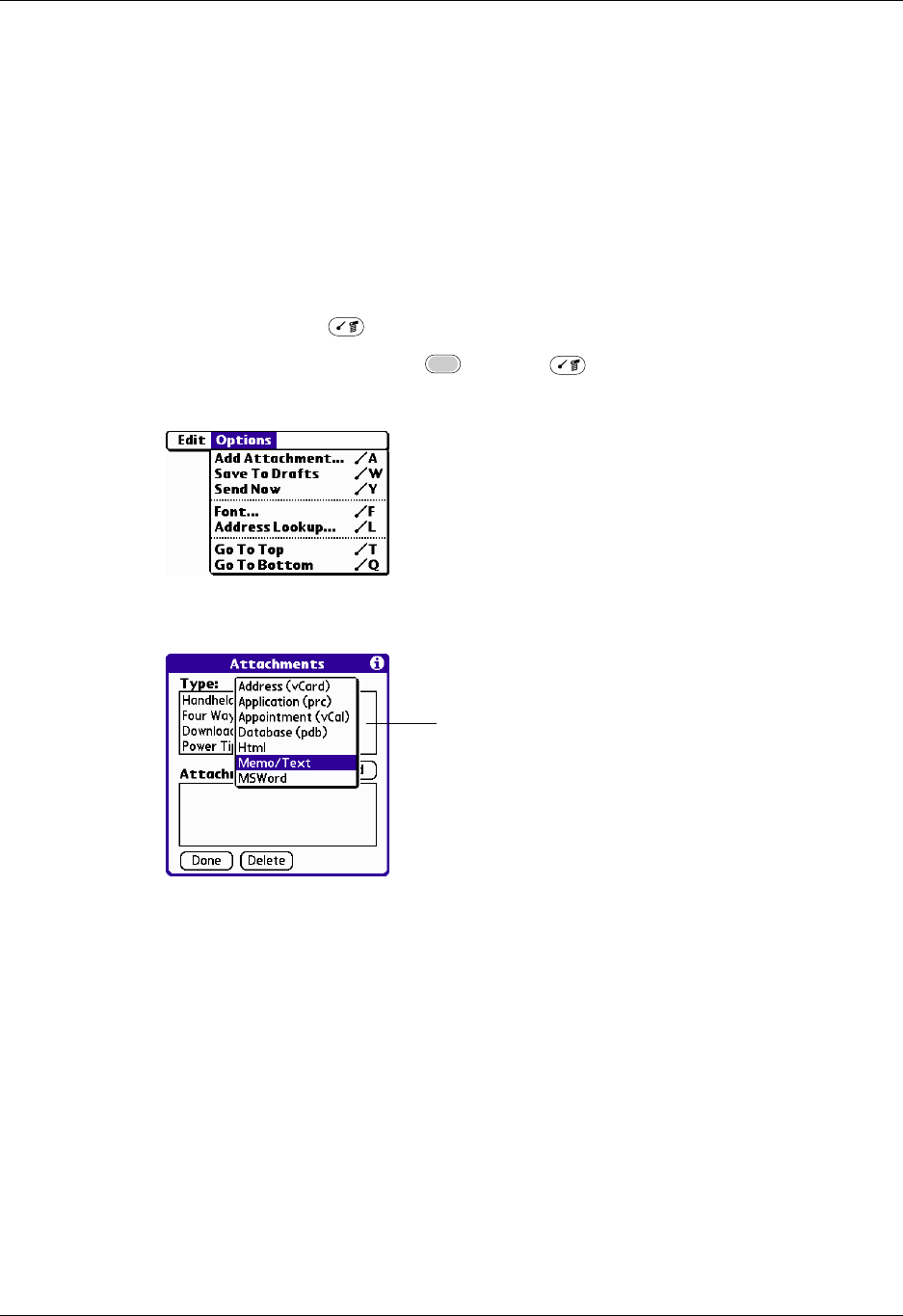
Getting, sending, and managing e-mail
209
You can attach the following types of files:
■vCard (.vcf)
■vCal (.vcs)
■Memo/Text (.txt)
■PRC (.prc)
■PDB (.pdb)
To attach a file to a message:
1. Press Command + A.
Alternately, press Function + Menu , tap Options, and then tap Add
Attachment.
2. Tap the Type pick list and select the file type.
All files of the selected type appear in the Type box. For example, if you select
Appointments (vCal), tap Date Book to see a list of appointments from a
particular date that you can attach, or tap To Do to see To Do List tasks.
Select type of file you want to
attach
Palm, Inc. Confidential
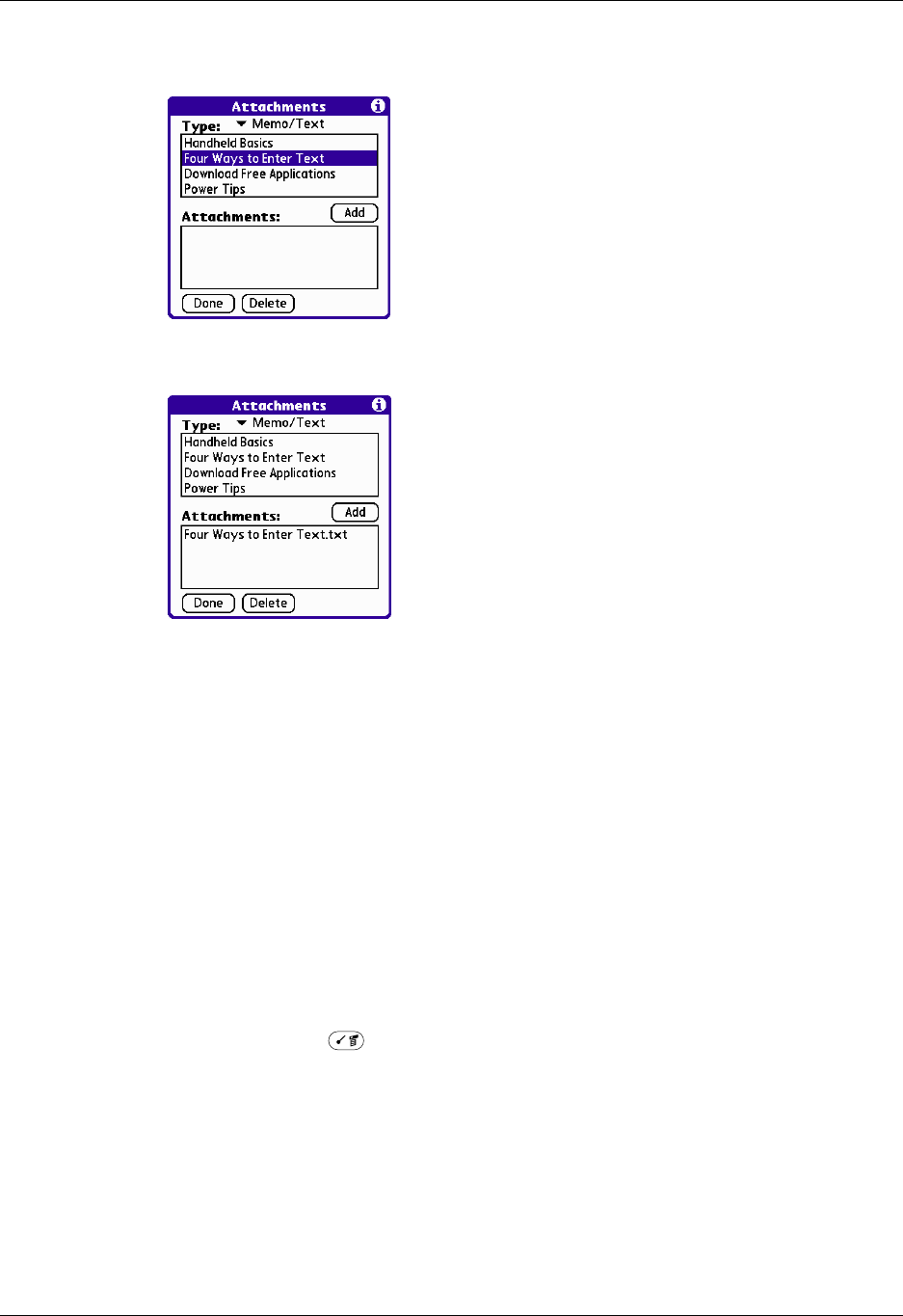
Chapter 17 Using Palm™ VersaMail™ Personal E-mail Software
210
3. Tap the file that you want to attach, and then tap Add.
The selected file appears in the Attachments box.
4. Repeat steps 4 and 5 to for each attachment you want to add, and then tap Done.
TIP To delete an attachment from an e-mail message, tap the attached file in
the Attachments box and then tap Delete.
5. Tap Send or Outbox.
Forwarding an attachment
You can include an attachments on any message you forward, up to the maximum
message size.
To forward a message with an attachment:
1. Tap the folders pick list and select the folder that contains the e-mail.
2. Tap the e-mail message to display it.
3. Press Command + F.
Alternately, tap the Forward button.
4. Tap the word To. On the Recipient List screen, enter or look up the recipient
address. See the procedure for creating e-mail earlier in this chapter for more
information on addressing messages.
5. Follow the steps for the procedure for attaching files presented earlier in this
chapter.
Palm, Inc. Confidential

Getting, sending, and managing e-mail
211
Deleting messages
You can delete one or more e-mail messages from any folder. For example, you can
delete old messages in the Inbox or messages that you were working on in the
Drafts folder. When you delete a message, it is placed in the Trash folder. See
“Emptying the trash” later in this chapter.
To delete messages on the server when you empty the trash on your handheld, you
can select the Delete Msgs on Server setting in VersaMail Preferences. If you don’t
periodically empty the trash and delete messages on the server, any incoming e-
mail may “bounce” back to the sender. See “Setting preferences for getting and
deleting e-mail” later in this chapter.
To delete one or more messages:
1. Tap the folders pick list and select the folder that contains the message you want
to delete.
2. Do one of the following:
3. Press Right on the navigator to move to and open the Message menu.
4. Press Down on the navigator to move to the Delete option, and then press Select
to delete the message.
TIP Alternately, you can tap the message icon next to a selected e-mail
message and then tap Delete, or press Function + Menu and then
select Delete.
5. Press Function + Enter , or tap OK.
Item to delete Action
One message Tap the bullet next to the message’s icon.
Multiple
messages
Tap the bullet next to the icon of each message that you want
to delete.
A group of
adjacent
messages
Drag the stylus along the left of the message icons. To select
another group, lift the stylus and select the next group of
messages.
Palm, Inc. Confidential
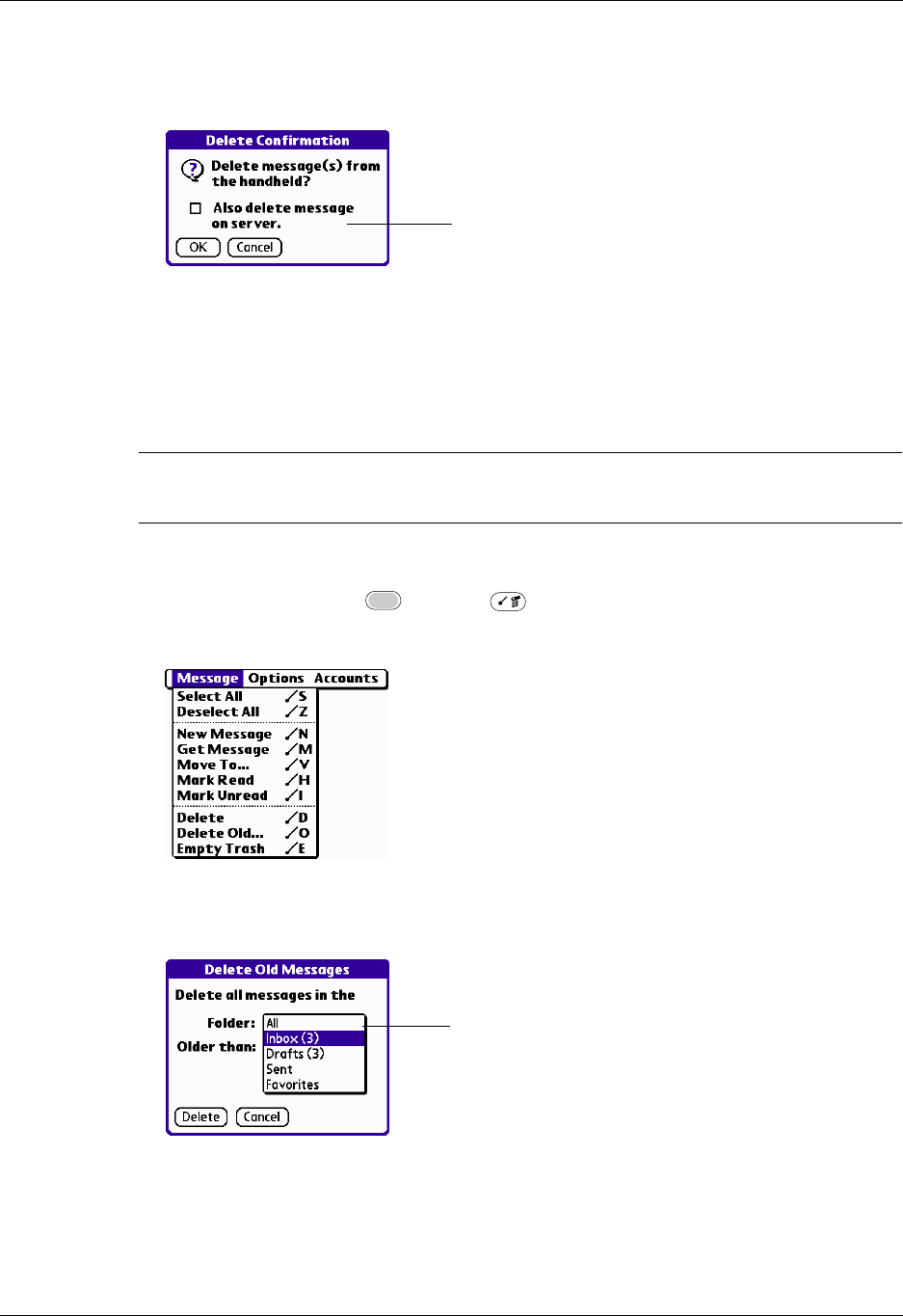
Chapter 17 Using Palm™ VersaMail™ Personal E-mail Software
212
6. (Optional) Tap Also delete message on server if you want to delete the message
from the server now.
The selected messages move to the Trash folder and are deleted from your
handheld when you empty the trash. If you set the preference to automatically
empty the trash, the messages are deleted when the trash is emptied. By default,
the trash auto-empties all deleted e-mail older than one week. See “Emptying
the trash” later in this chapter for more information.
IMPORTANT If you delete a message on the server, you cannot retrieve it and view it
again later.
To delete messages before a certain date:
1. Press press Function + Menu , and then tap Delete Old from the
Message menu.
2. Tap the Folder pick list and select the folder that contains the messages you
want to delete.
If you selected the setting
Delete Msgs on Server in
VersaMail Preferences, this
check box is selected
Displays the current
folder for deleting
messages
Palm, Inc. Confidential
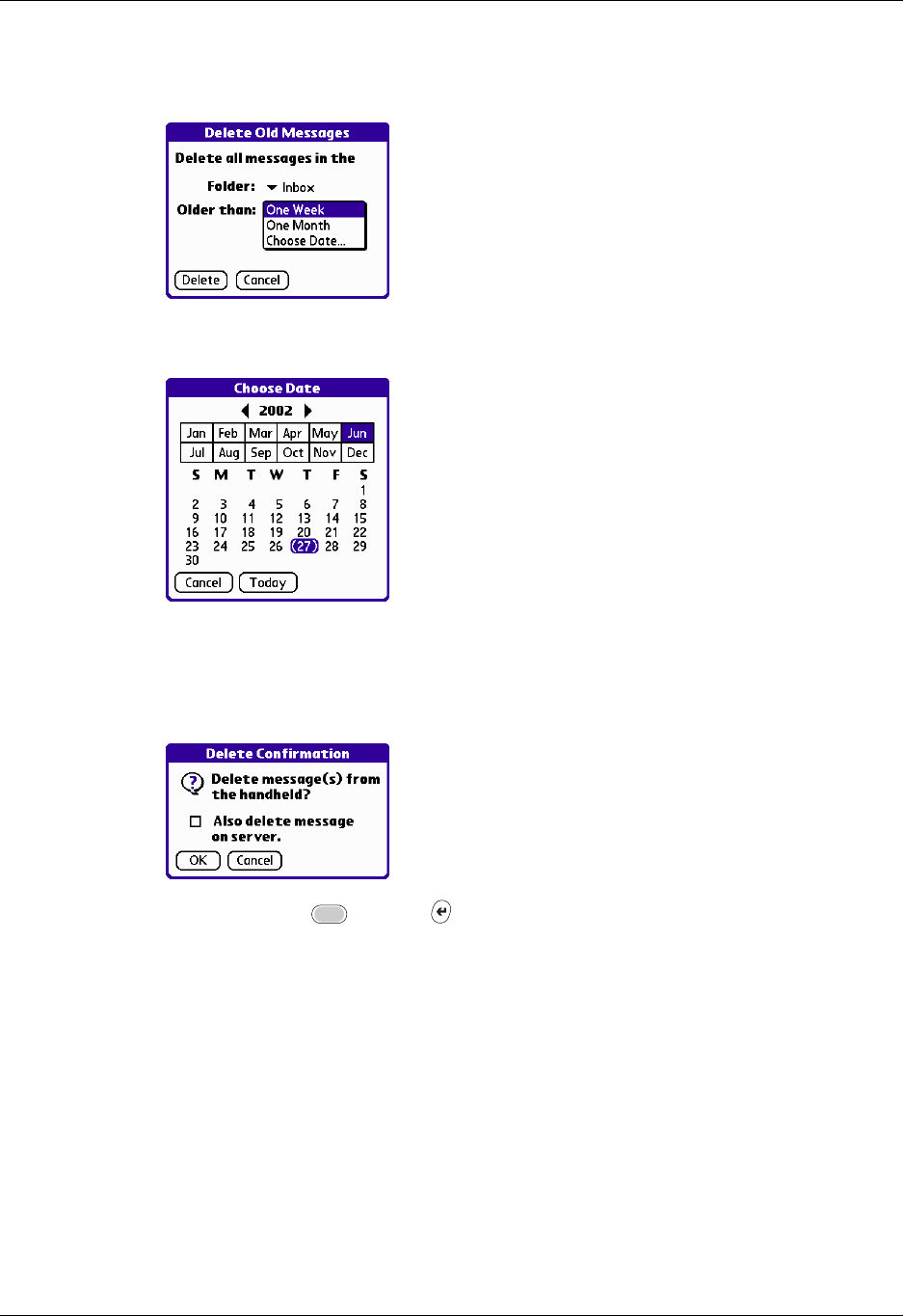
Getting, sending, and managing e-mail
213
3. Tap the Older than pick list, and then tap One Week, One Month, or Choose
Date.
If you tap Choose Date, you can select a date from the calendar.
4. Tap Delete.
5. (Optional) Tap Also delete message on server if you want to delete the message
from the server now.
6. Press Function + Enter , or tap OK.
Tap a date to select it,
or tap Today
Palm, Inc. Confidential
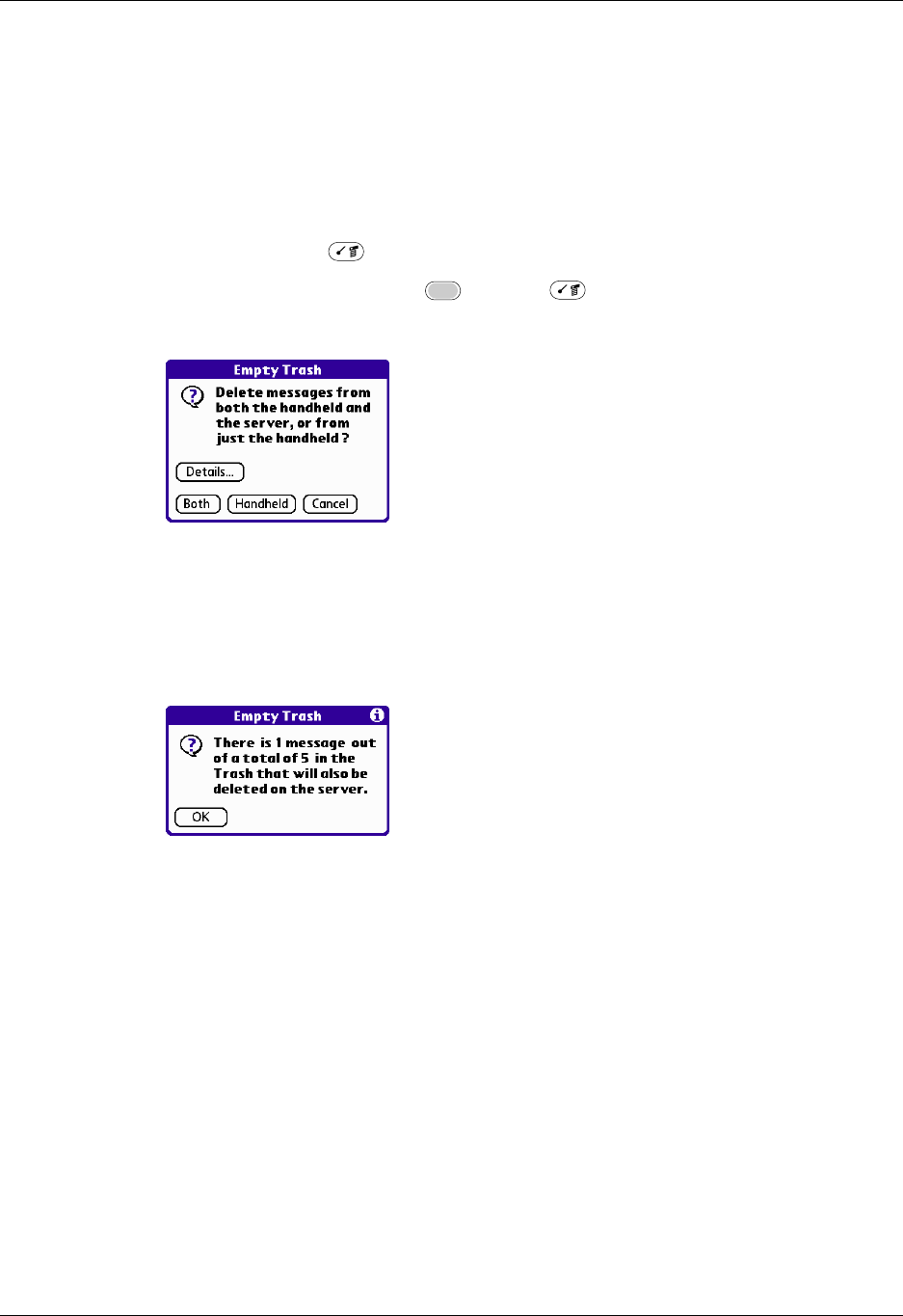
Chapter 17 Using Palm™ VersaMail™ Personal E-mail Software
214
Emptying the trash
Deleted e-mail accumulates in the Trash folder and takes up space on your
handheld. To increase memory, you should empty the trash regularly. If you want
to automatically empty the trash, you can set a preference to empty the trash
immediately or empty any e-mail older than a certain number of days.
To empty the trash:
1. Press Command + E.
Alternately, press Function + Menu , and then select Empty Trash
from the Message menu.
NOTE If Auto-Empty Mail from Trash is selected in VersaMail Preferences, a
message asks if you want to delete the trash.
2. (Optional) Tap Details to see how many messages are in the Trash, and whether
the messages are set to be deleted on the server.
3. If you want to delete messages from the handheld as well as from the server, tap
Both. A message asks if you want to update the server now.
To delete the message from only the handheld now, tap Handheld.
NOTE Many e-mail providers, such as Yahoo, have size restrictions for mail storage.
If your mailbox on the server becomes full, messages are returned to the senders.
Palm, Inc. Confidential
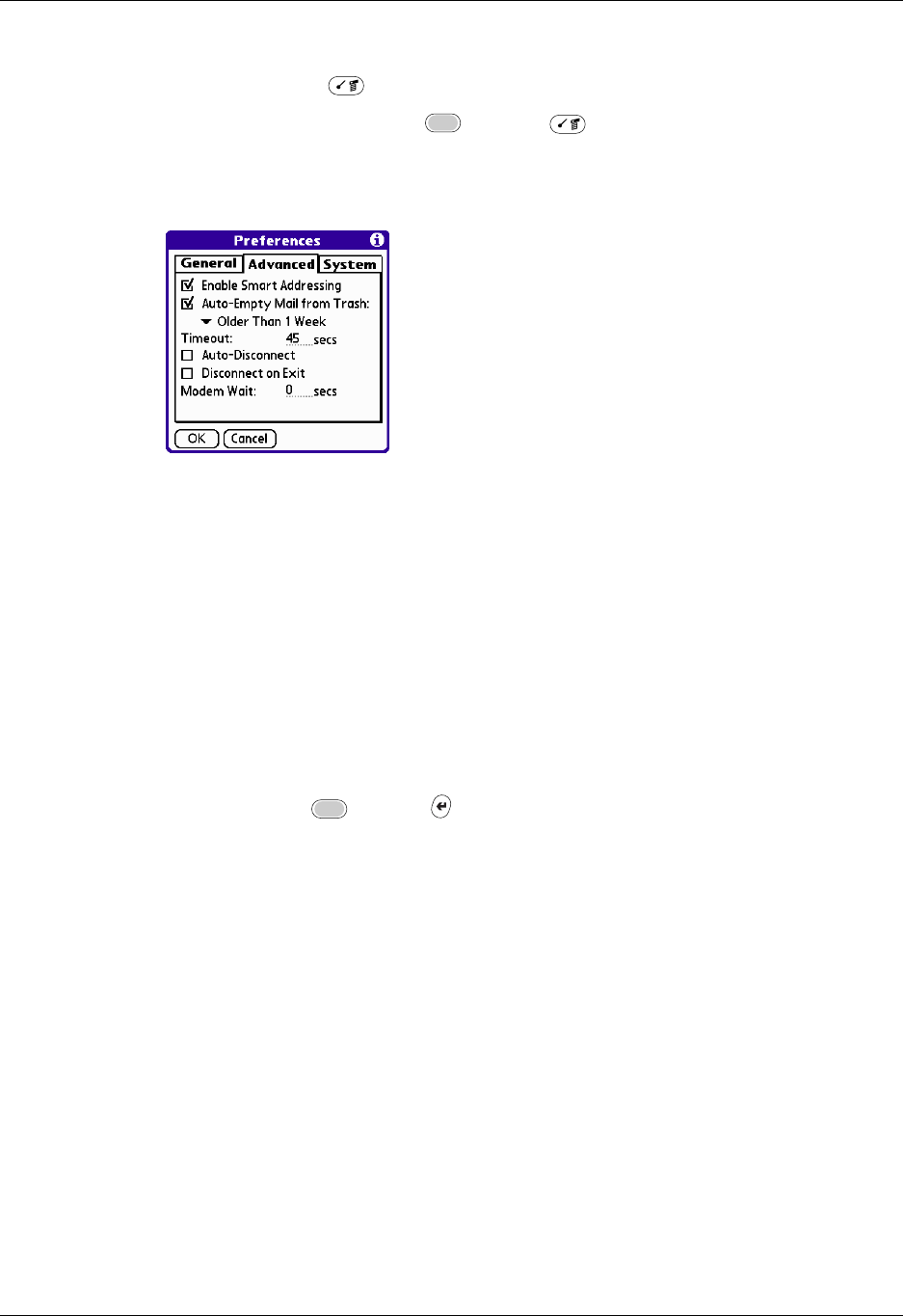
Getting, sending, and managing e-mail
215
To have the trash emptied automatically:
1. Press Command + R.
Alternately, press Function + Menu , select Options, and then select
Preferences.
2. Tap Advanced.
By default, Auto-Empty Mail from Trash is selected, and the time interval is set
at Older Than 1 Week.
3. Tap the pick list, and select how often you want the e-mail messages
automatically emptied from the trash.
– Immediately.
– Older Than 1 Day.
– Older Than 3 Days.
– Older Than 1 Week.
– Older Than 1 Month.
4. Press Function + Enter , or tap OK.
Marking messages as read or unread
You can mark messages as read or unread. When you tap a message to read it, it is
automatically marked as read.
NOTE Because POP servers do not support the read or unread message feature, the
message is in bold or regular typeface for POP accounts on the handheld, but you
can’t connect with the server to change the message state.
To mark messages as read or unread:
1. Tap the folders pick list and select the folder you want.
2. Tap the icon next to the message you want to mark.
Palm, Inc. Confidential
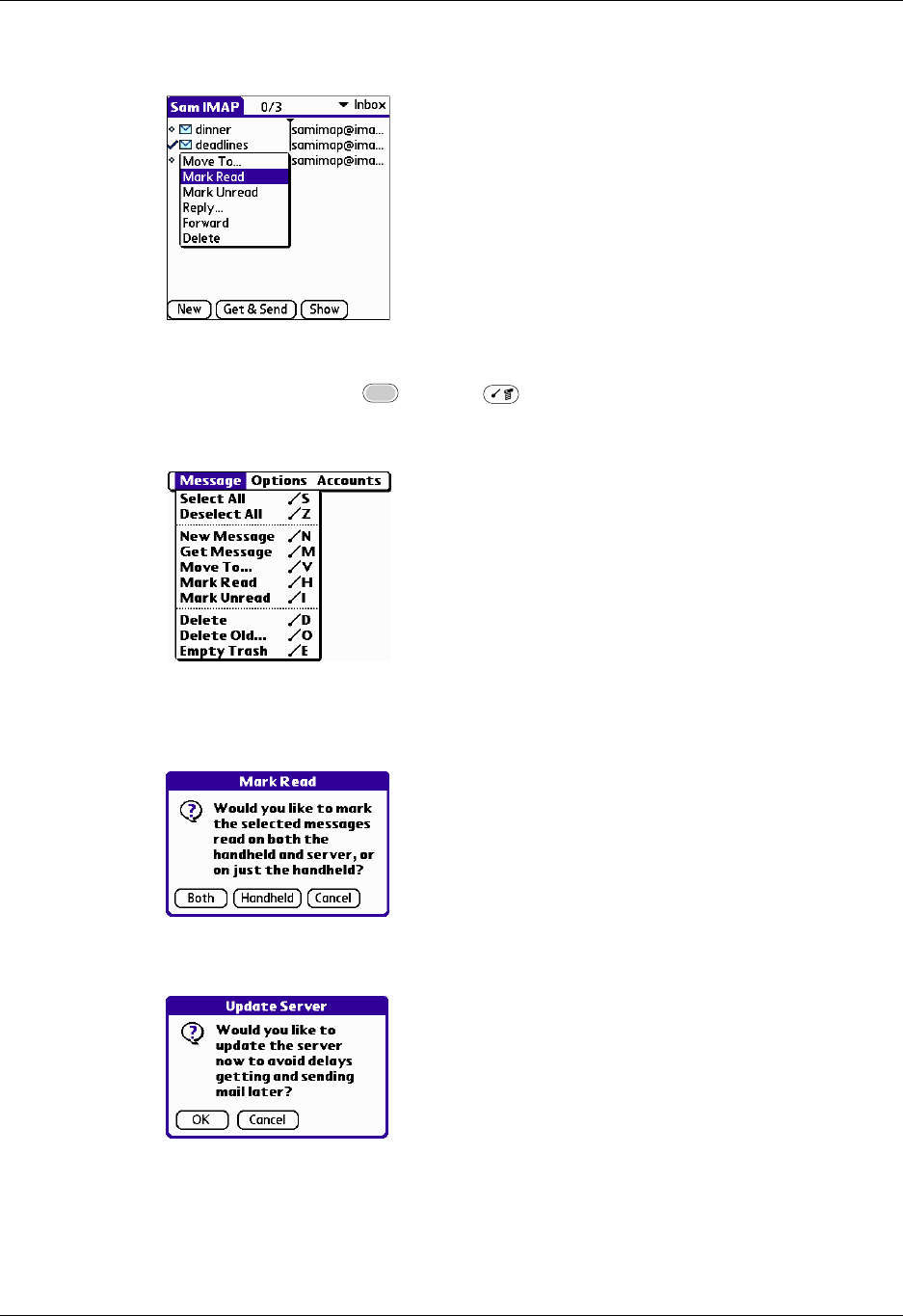
Chapter 17 Using Palm™ VersaMail™ Personal E-mail Software
216
3. Tap Mark Read or tap Mark Unread.
TIP To mark multiple messages, tap the bullets next to the messages you
want, press Function + Menu and then select Mark Read or Mark
Unread.
4. Tap Handheld to mark the messages as read or unread on your handheld. Tap
Both to mark the messages on both the handheld and the server.
If you tap Both, this message appears.
Tap OK to connect with the server and immediately mark the messages as read
or unread on the server. This action also processes any other pending actions on
the server, such as messages not yet deleted.
Palm, Inc. Confidential
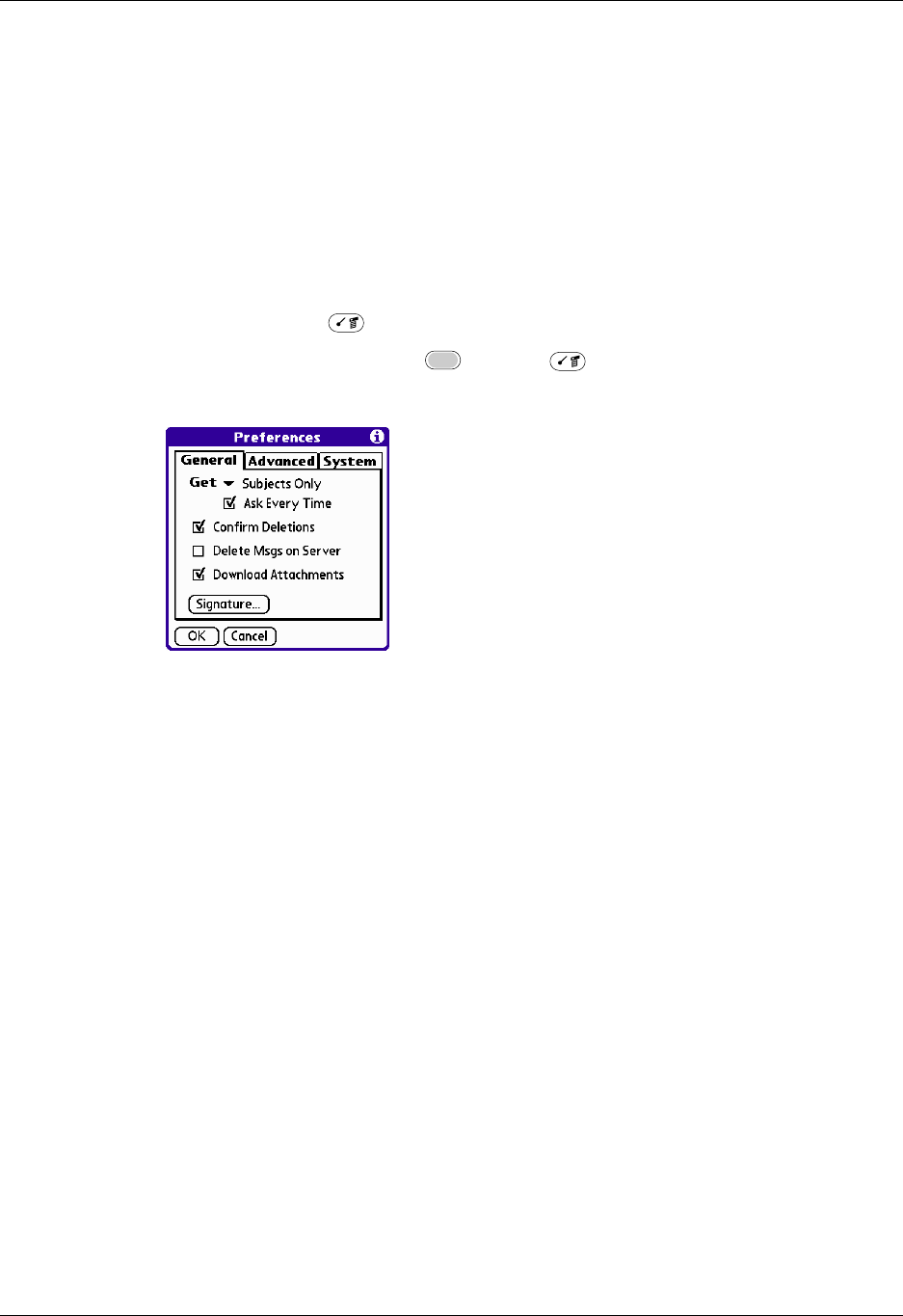
Getting, sending, and managing e-mail
217
Tap Cancel if you want the messages marked during the next HotSync
operation or the next time you connect to the server.
Read messages appear in plain text; unread messages appear in bold text.
Setting preferences for getting and deleting e-mail
VersaMail Preferences determine how the VersaMail application gets, sends, and
deletes e-mail.
To set e-mail preferences:
1. Press Command + R.
Alternately, press Function + Menu , select Options, and then select
Preferences.
2. Select preferences:
Get Enables you retrieve the subject only or the entire message.
Ask Every Time Displays a dialog box for choosing subjects only or entire
messages each time you retrieve e-mail. If deselected,
messages are retrieved according to the option you select in
the Get pick list.
Confirm
Deletions Displays a confirmation dialog before deleting e-mail.
Delete Msgs on
Server If selected, automatically deletes messages on the server that
you have deleted on your handheld. If not selected, you will
be asked each time you delete messages on your handheld
whether you want to also delete them on the server. Because
mailboxes on the server usually have size restrictions, we
recommend periodically deleting messages on the server.
Palm, Inc. Confidential
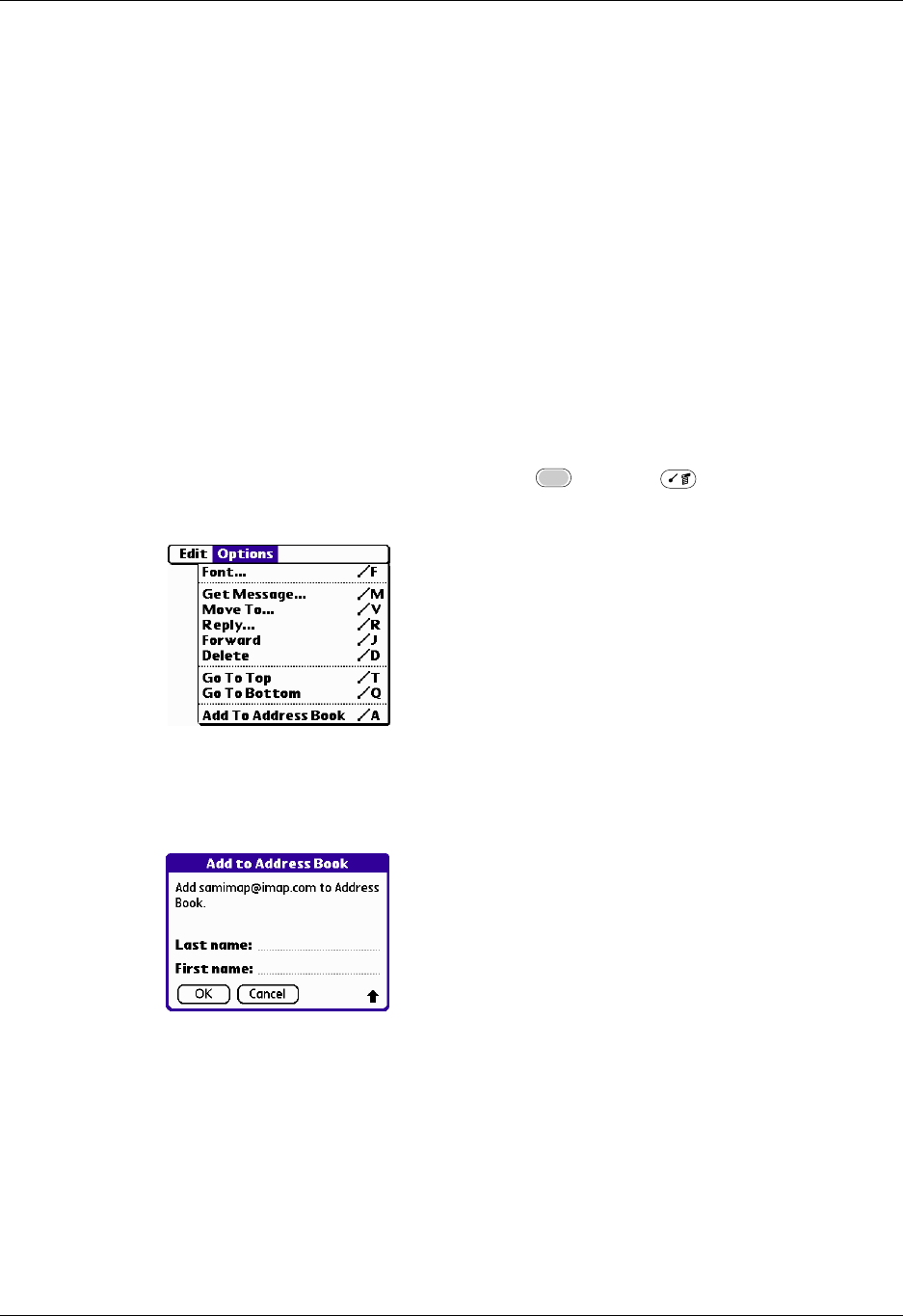
Chapter 17 Using Palm™ VersaMail™ Personal E-mail Software
218
Adding or updating an Address Book entry directly from a message
You can add or update an e-mail address in the Address Book directly from the
body of a received e-mail message.
To add a new Address Book entry:
1. On the Message screen, press Function + Menu , select Options, and
then select Add to Address Book.
A dialog box appears with the “From” address displayed. If a Display Name
exists for this Address Book entry, the Last name and First name fields show the
display name.
2. (Optional) If the Last name and First name fields are blank, enter the first and
last name associated with the “From” e-mail address.
3. Tap OK to add the e-mail address to the Address Book, and then tap OK in the
confirmation dialog box.
Download
Attachments Causes files attached to e-mail to be automatically
downloaded to your handheld. Attachments that exceed the
maximum message size cannot be downloaded. See
“Working with attachments” earlier in this chapter for more
information.
Signature Enables you to attach a default signature to all your outgoing
messages. See “Attaching a personal signature” earlier in
this chapter for more information.
Palm, Inc. Confidential

Synchronizing e-mail between the handheld and the desktop
219
You can also update an existing Address Book entry with a new e-mail address, or
create a second Address Book entry for a name that has an existing record. The
procedure is the same as for adding a new Address Book entry. If you tap Add to
Address Book from the body of an e-mail message and a record already exists for
the recipient name, you are prompted either to update the e-mail address for the
recipient or to create a new record for the recipient.
Synchronizing e-mail between the handheld and the desktop
To manage your e-mail on your desktop as well as on your handheld, you can
synchronize an e-mail account on the handheld with an e-mail application on the
desktop. You can use many popular e-mail applications, called clients, such as
Microsoft Outlook, Eudora, Lotus Notes, Outlook Express, or any other e-mail
clients that use MAPI.
You must have a Windows computer to synchronize e-mail between your
handheld and your computer.
This section describes the following:
■Starting the Palm VersaMail HotSync Conduit
■Configuring and activating accounts in the HotSync Manager
■Synchronizing e-mail on the handheld with a desktop e-mail application
■Converting attached files using attachment conversion plug-ins
Configuring an account in HotSync Manager
Before synchronizing an e-mail account, you configure the account’s settings in the
Palm VersaMail HotSync Conduit. The settings have to be specified only once
unless you need to make changes.
To start Palm VersaMail HotSync Conduit:
1. Click the HotSync Manager icon in the Windows system tray.
2. Select Custom.
3. Select VersaMail in the Conduit list.
Palm, Inc. Confidential
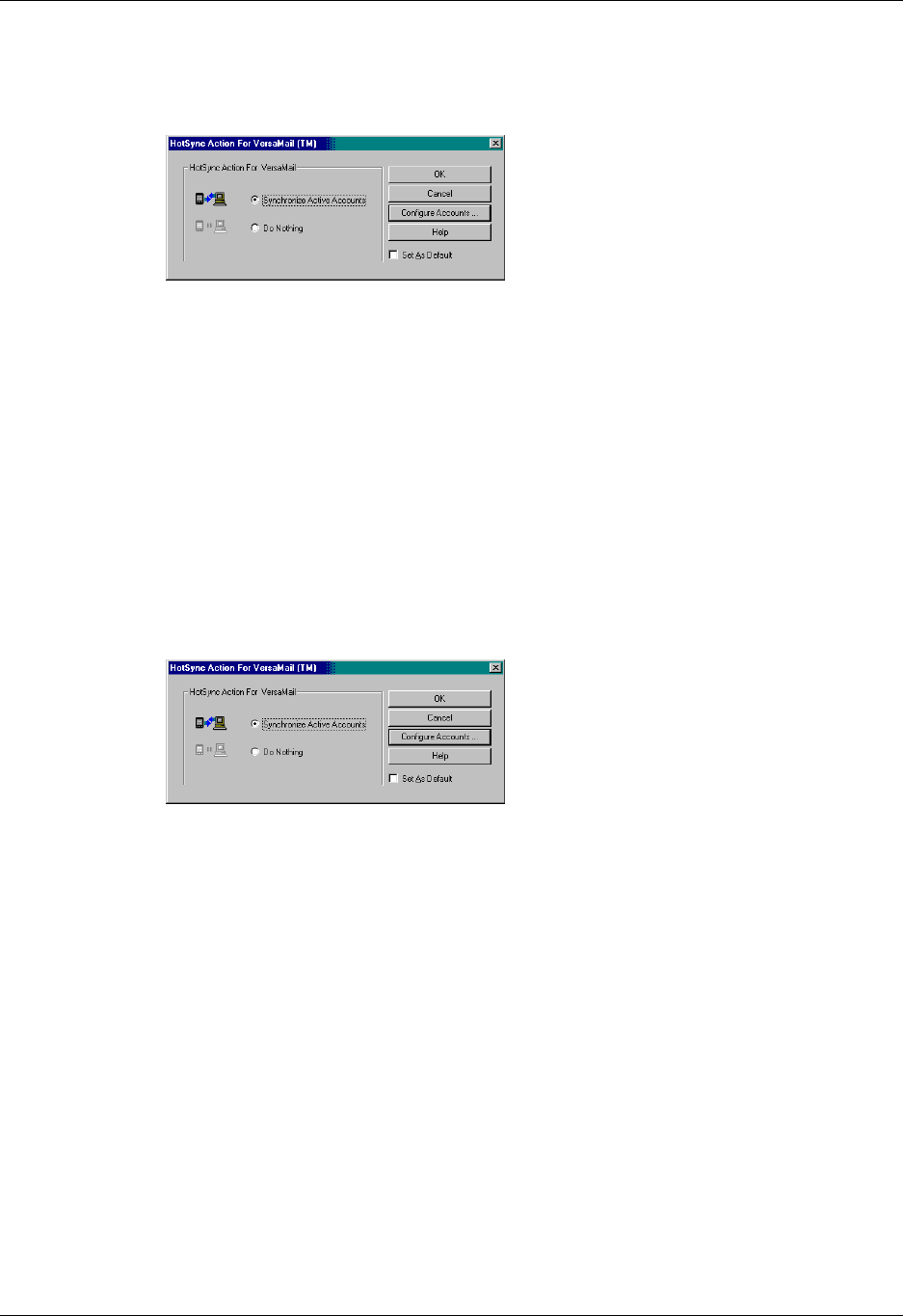
Chapter 17 Using Palm™ VersaMail™ Personal E-mail Software
220
4. Click Change.
5. Select Synchronize Active Accounts.
Curly accesses POP servers through MAPI only, and accesses IMAP servers
through configuration in MultiMail
Setting synchronization options and account settings
Next, you must configure each e-mail account’s general synchronization settings.
For example, if you created an Earthlink e-mail account on the handheld and want
to synchronize that with the desktop, set the synchronization options for the
Earthlink account. During a HotSync operation, the Earthlink account on the
handheld and the e-mail application specified in the conduit are synchronized.
To configure an account and set the synchronization options:
1. In the HotSync Action For VersaMail dialog box, click Configure Accounts.
Palm, Inc. Confidential
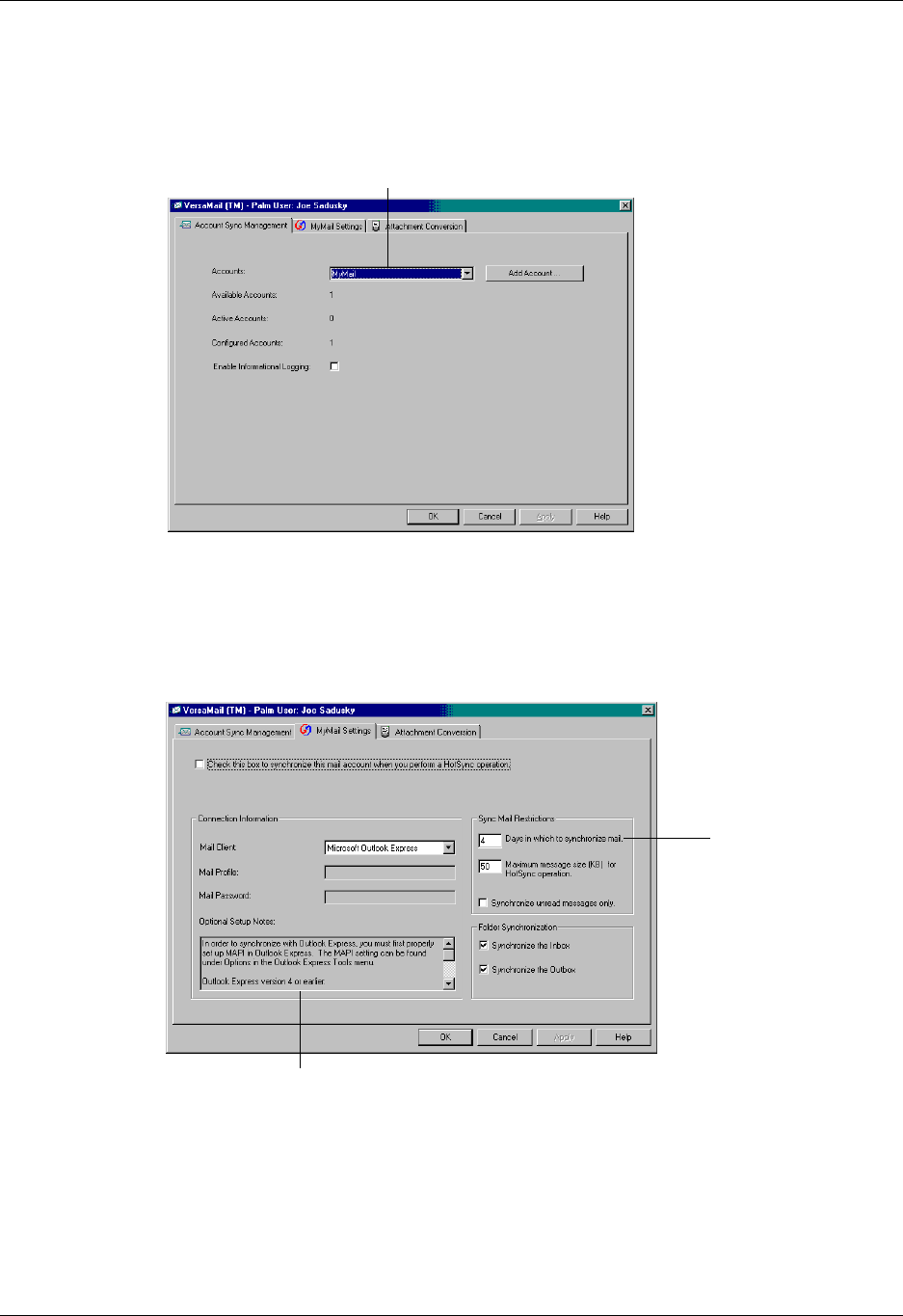
Synchronizing e-mail between the handheld and the desktop
221
2. (Optional) Select the check box Enable Informational Logging if you want the
HotSync log to record information, such as errors encountered, about the
conduit during a HotSync operation.
3. Select the account that you want to configure from the Accounts drop-down
list.
The tab with the account’s name and settings, such as MyMail Settings or Yahoo
Settings, is displayed.
4. Select the option Check this box to synchronize this mail account when you
perform a HotSync operation; otherwise, the account cannot be synchronized.
5. Under Connection Information, select the desktop e-mail application, such as
Microsoft Exchange 5.0 or later, Outlook Express, or Eudora, that you are
synchronizing the account with and specify any necessary settings.
Select the account to configure
and synchronize
Check here for helpful notes when
configuring an e-mail client
Enter the message
size and the number
of days before today
that synchronization
occurs
Palm, Inc. Confidential

Chapter 17 Using Palm™ VersaMail™ Personal E-mail Software
222
TIP If your e-mail application is compatible with Extended MAPI, try Microsoft
Exchange 5.0 or later as a choice for the Mail Client option. If your e-mail
application is compatible with Simple MAPI (SMAPI), try Microsoft Outlook
Express as a choice for the Mail Client option. Although Netscape uses SMAPI,
Netscape is not supported.
Mail Client Action
Microsoft
Exchange 5.0 or
later
Select a MAPI profile to access the mail server. The conduit
displays any existing MAPI profiles in the list.
Microsoft
Outlook 97 or
later
Select the MAPI profile to access the mail server. The conduit
checks for any existing MAPI profiles and displays them in the
list. Enter your password for Outlook. See “Configuring
Microsoft Outlook” later in this chapter for the changes you
need to make in Outlook.
Microsoft
Outlook Express
5.5 or later
If you select Microsoft Outlook Express, enter the password for
your e-mail account. See “Configuring Microsoft Outlook
Express” later in this chapter for details.
Lotus Notes Enter your Lotus Notes ID and password. Click Browse if you
need to locate your Notes ID.
Eudora 5.0 or
later
See “Configuring Eudora” later in this chapter for more
information about the settings to make in Eudora.
Direct POP
connection to
server
Select this option to synchronize an account by connecting
directly with a POP server. You must enter the information
about the server in the VersaMail application on your
handheld when you create the e-mail account to access the
server. You will enter information about the incoming (POP)
server, outgoing (SMTP) server, your e-mail username, your
password, and your e-mail address.
During the HotSync operation, the conduit reads the settings
you made. If the settings do not exist or all server information
is wrong, an error is reported in the HotSync.log file. However,
if the incoming server (POP) is correct, the Inbox is
synchronized if the option to synchronize the Inbox is selected.
If the outgoing server (SMTP) is correct, the Outbox is
synchronized (send e-mail) if you selected the option to
synchronize the Outbox. If neither is correct, then nothing
happens.
Palm, Inc. Confidential

Synchronizing e-mail between the handheld and the desktop
223
NOTE A profile contains configuration information, such as the location of
incoming e-mail, your personal address book, and other information services
that you can use. The profile may be MS Exchange Settings, your name, or
something different. For more information on profiles, see your e-mail
application’s documentation.
If you want to synchronize e-mail for an account that requires
APOP authentication, you must select the option to use APOP
on your handheld. See “Adding APOP to an account” later in
this chapter for details.
If you want to synchronize e-mail for an account that requires
ESMTP authentication (for example, Yahoo accounts require
ESMTP authentication), you must select the option to use
ESMTP on your handheld. See “Adding ESMTP to an account”
later in this chapter for details.
Direct IMAP
connection to
server
Select this option to synchronize an account by connecting
directly with an IMAP server. You must enter the information
about the server in the VersaMail application on your
handheld when you create the e-mail account to access the
server. You will enter information about the incoming (IMAP)
server, outgoing (SMTP) server, your e-mail username, your
password, and your e-mail address.
During the HotSync operation, the conduit reads the settings
you made. If the settings do not exist or all server information
is wrong, an error is reported in the HotSync.log file. However,
if the incoming server (IMAP) is correct, the Inbox is
synchronized if the option to synchronize the Inbox is selected.
If the outgoing server (SMTP) is correct, the Outbox is
synchronized (send e-mail) if you selected the option to
synchronize the Outbox. If neither is correct, then nothing
happens.
If you want to synchronize e-mail for an account that requires
ESMTP authentication (for example, Yahoo accounts require
ESMTP authentication), you must select the option to use
ESMTP on your handheld. See “Adding ESMTP to an account”
later in this chapter for details.
Other e-mail
applications
Select Microsoft Exchange 5.0 or later as a choice for the Mail
Client option if your e-mail application is compatible with
extended MAPI. If your e-mail application is compatible with
SMAPI, select Microsoft Outlook Express as a choice for the
Mail Client option.
Mail Client Action
Palm, Inc. Confidential

Chapter 17 Using Palm™ VersaMail™ Personal E-mail Software
224
6. Enter the Sync Mail Restrictions you want:
–Days in Which to Synchronize Mail: Set how many days of e-mail, between 0
and 999, that e-mail should be synchronized. A value of 0 synchronizes all
e-mail in the Inbox during the next HotSync operation. For other values, the
conduit synchronizes e-mail for today and the number of days preceding
today. For example, if you enter a value of 2, e-mail is synchronized for today
and yesterday, but if you enter 3, e-mail is synchronized for today,
yesterday, and the day before.
–Maximum Message Size (KB) for HotSync Operation: Enter the maximum
message size from 1 to 2048KB. If the message exceeds the maximum size,
the conduit truncates the message. For example, the maximum message size
might be 50KB, and the message might have the following:
In this case the conduit puts the message header, body, and
attachment 2—totaling 41KB—on the handheld. Attachment 1 is removed
because adding it to the message causes the message to exceed the
maximum.
–Synchronize unread messages only: Select whether to synchronize all
e-mail between your desktop and your handheld, or unread e-mail only. By
default, the check box is unselected, meaning that all e-mail will be
synchronized.
7. Select the folder synchronization you want:
– Select the Synchronize the Inbox check box to synchronize the Inbox during
the next HotSync operation.
– Select the Synchronize the Outbox check box to send any e-mail in the
handheld’s Outbox during the next HotSync operation.
8. Click Apply.
Message header 1KB
Body 20KB
Attachment 1 40KB
Attachment 2 20KB
Palm, Inc. Confidential

Synchronizing e-mail between the handheld and the desktop
225
Verifying handheld account settings before synchronizing accounts
Certain settings you configure on your handheld for a given e-mail account must
be set correctly for the synchronization process as well. Before configuring an
e-mail client on your desktop for synchronization, be sure to verify the following
settings on your handheld:
■APOP and ESMTP: If you want to synchronize e-mail for an account that
requires either APOP or ESMTP authentication (for example, Yahoo accounts
require ESMTP authentication), you must select the option to use APOP or
ESMTP on your handheld. See “Adding APOP to an account” and “Adding
ESMTP to an account” later in this chapter for details.
■Mail filters: Any mail filters you have configured for a given e-mail account on
your handheld also apply during the synchronization process. For example, if
you have set filters to accept only e-mail containing the subject words “Current
Software Project,” only those same messages are synchronized between your
desktop and your handheld. Be sure to turn mail filters off if you want to
synchronize all messages between your desktop and your handheld. See
“Turning filters on and off” later in this chapter for details.
Configuring Microsoft Outlook
You can synchronize Microsoft Outlook 97/98/2000/XP with a VersaMail e-mail
account, but you must set Microsoft Outlook as the default e-mail handler. You
must check your username and password.
To configure Microsoft Outlook:
1. In the Control Panel, click Internet Options.
NOTE For Windows XP, click Network and Internet Connections, and then click
Internet Options.
2. Click the Programs tab.
3. Select Microsoft Outlook as the default e-mail program.
4. Click OK.
NOTE Make sure your username and password are set up correctly within Microsoft
Outlook.
Configuring Microsoft Outlook Express
You can synchronize a VersaMail e-mail account with Microsoft Outlook Express
5.5 or 6.0, but you must set Outlook Express as the default e-mail handler.
NOTE Make sure your username and password are set up correctly within Outlook
Express.
Palm, Inc. Confidential

Chapter 17 Using Palm™ VersaMail™ Personal E-mail Software
226
To configure Outlook Express:
1. In the Control Panel, click Internet Options.
NOTE For Windows XP, click Network and Internet Connections, and then click
Internet Options.
2. Click the Programs tab.
3. Select Outlook Express as the default e-mail program.
4. Click OK.
TIP You can also make Outlook Express the default e-mail handler within the e-mail
application. From the Tools menu, select Options. Click the General tab, and then click
Make Default.
Configuring Eudora
If you are using Eudora as your e-mail application, you must set up MAPI in
Eudora.
To set up MAPI in Eudora:
1. From the Eudora Tools menu, select Options.
2. Do one of the following:
– If Eudora is the only e-mail application that you use, select Always as the
MAPI setting.
– If you use more than one e-mail application, select When Eudora is running
as the MAPI setting.
3. Ensure that your username and password are set up correctly within Eudora.
This information is needed to log in to Eudora to retrieve and synchronize your
e-mail.
IMPORTANT Eudora must be running in order for you to perform a HotSync
operation. The VersaMail application synchronizes with your Dominant Personality in
Eudora 5.1 or later.
Converting attached files
You can use attachment conversion plug-ins to convert attached files that you are
receiving. Documents To Go plug-ins are automatically configured; however, you
must install Documents To Go version 5 on your desktop computer and on your
handheld for attachments to be converted properly. Version 5 of Documents To Go
is included on the Software Essentials CD-ROM that came with your handheld. See
the Documents To Go Getting Started Manual for more information.
Palm, Inc. Confidential
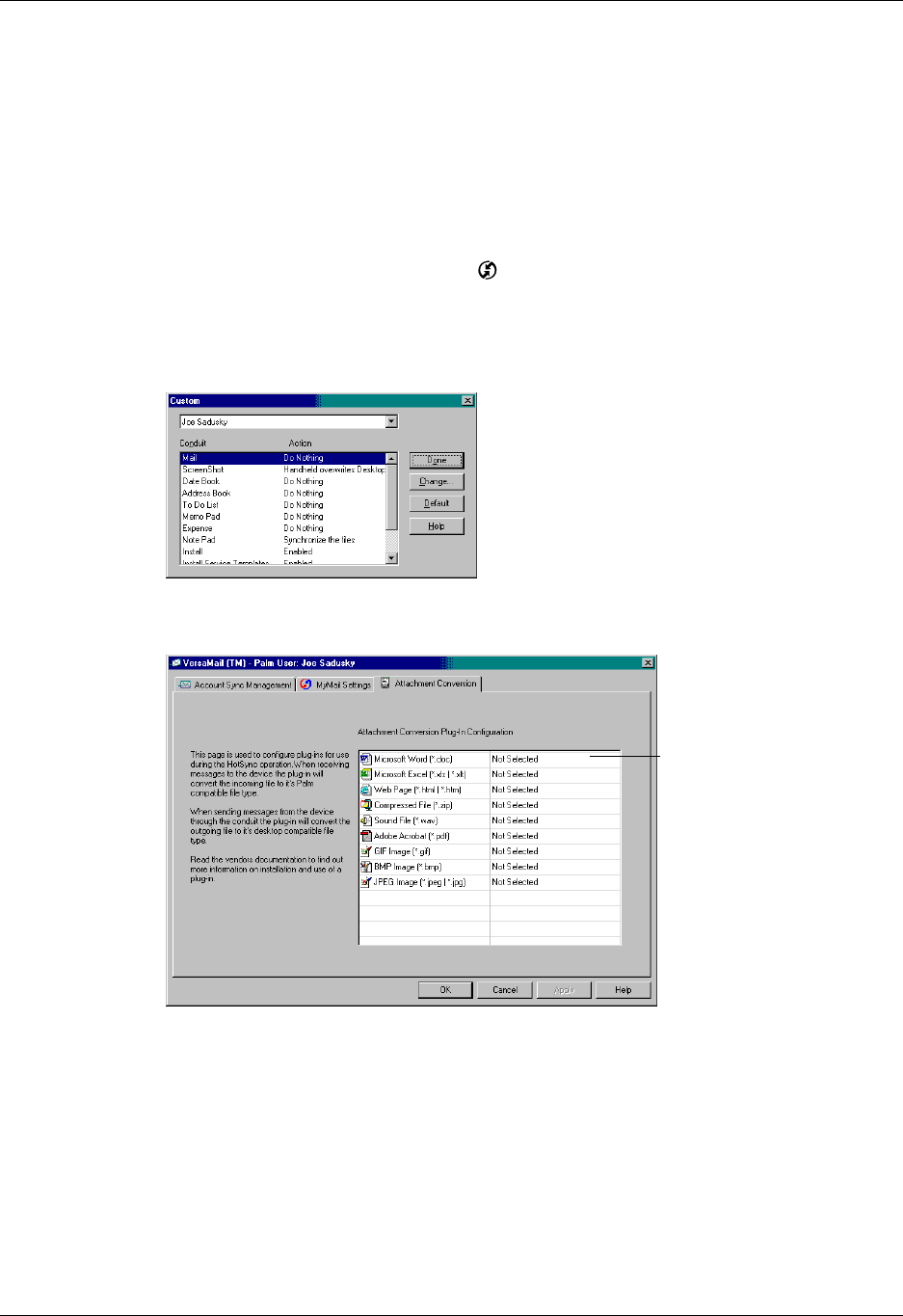
Synchronizing e-mail between the handheld and the desktop
227
When you receive a message with an attachment on your handheld, the file is
converted to the DataViz format on the handheld when you perform a HotSync
operation. You can then read and edit the file in Documents To Go on the
handheld.
In the Palm VersaMail HotSync Conduit, you can turn off DataViz Documents To
Go plug-ins or select other plug-ins.
To turn off attachment conversion plug-ins:
1. Click the HotSync Manager icon in the Windows system tray.
2. Select Custom.
3. Select VersaMail in the Conduit list.
4. Click the Attachment Conversion tab.
5. To deselect a plug-in, select Not Selected from the drop-down list. To select a
plug-in, select Selected from the drop-down list.
6. Click OK.
Documents To Go
plug-ins are configured
automatically
Palm, Inc. Confidential
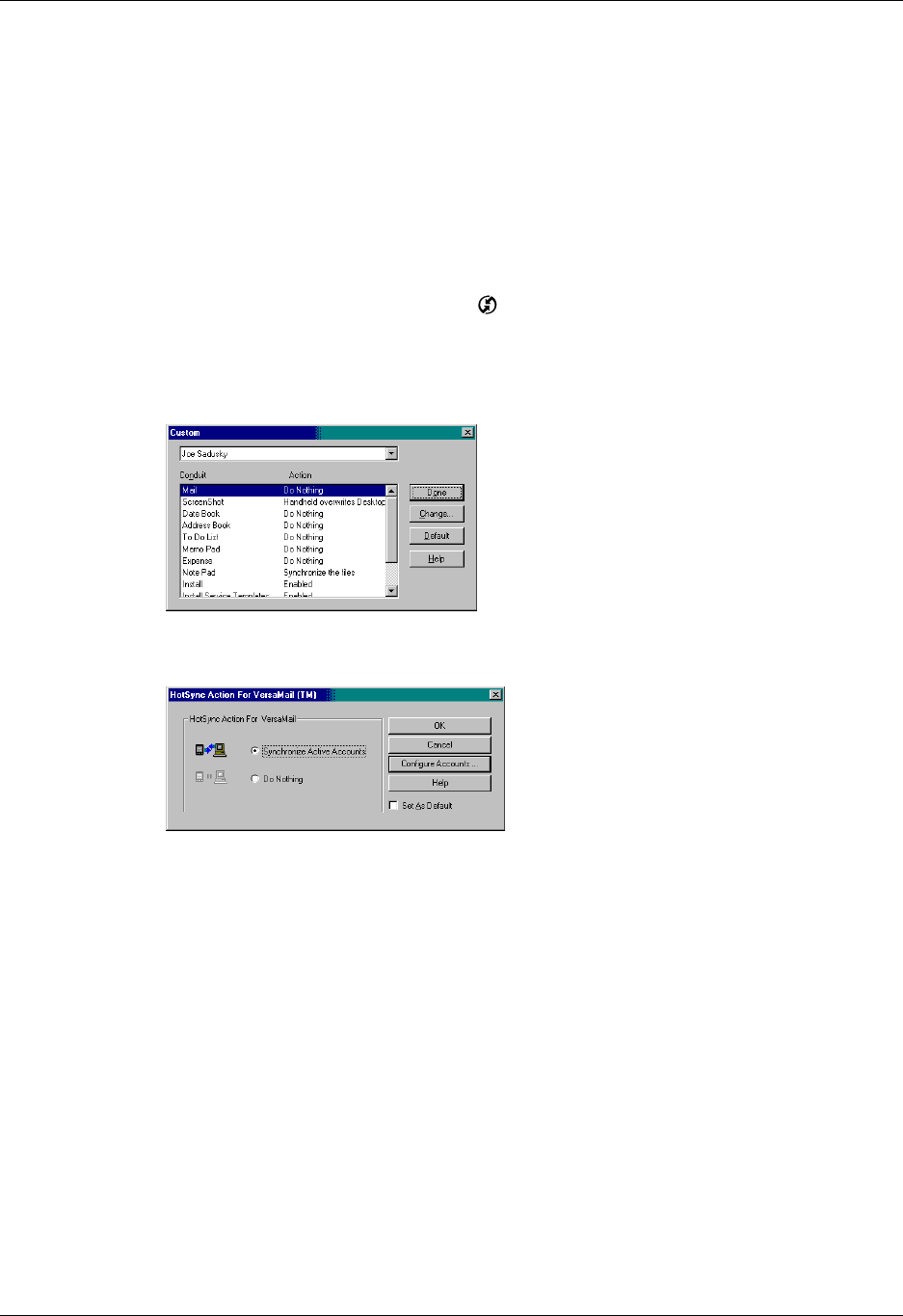
Chapter 17 Using Palm™ VersaMail™ Personal E-mail Software
228
Synchronizing an account
To synchronize accounts, you must set the HotSync action for the VersaMail
application in the HotSync Manager. You can, however, exclude e-mail accounts
from a HotSync operation.
TIP If you don’t want an account synchronized, deselect the check box Select this
check box to synchronize this e-mail account when you perform a HotSync operation.
To select which accounts are synchronized during a HotSync operation:
1. Click the HotSync Manager icon in the Windows system tray.
2. Select Custom.
3. Select VersaMail in the Conduit list.
4. Click Change.
5. Select one of the following:
–Synchronize Active Accounts: Select this option to include active accounts in
the next HotSync operation. For an account to be synchronized, you must
have selected the option Check this box to synchronize this mail account
when you performed a HotSync operation.
–Do Nothing: Select this option to exclude e-mail accounts from the next
HotSync operation.
6. (Optional) Select Set as Default to apply the options you selected to all
subsequent HotSync operations. Otherwise, the settings apply to the next
HotSync operation only.
7. Click OK.
8. Perform a HotSync operation.
Palm, Inc. Confidential

Going beyond the basics
229
Going beyond the basics
Many of the VersaMail application features, such as getting and sending e-mail,
you use daily. Other features are used less frequently but are especially valuable
in certain situations. For example, filtering e-mail is helpful if you are traveling and
want to receive messages only from certain people or about specific subjects.
Filters and other special features are discussed in this chapter.
This section describes the following:
■Creating and using filters to determine which e-mail you actually view
■Managing mail settings
■Adding APOP to an account
■Adding ESMTP to an account
■Copying text from an e-mail message for use in other applications
■Using the command bar
■Viewing e-mail header details
■Backing up your mail databases
■Synchronizing IMAP folders wirelessly
■Accessing corporate e-mail
■A summary of the VersaMail application navigator controls and keyboard
shortcuts
Setting server options for an IMAP account
To set mail retrieval server options for an IMAP account:
1. Tap Next.
2. If you want only unread mail to be downloaded to your handheld, make sure
Get unread mail ONLY is selected. If you don’t choose this option and you tap
Get & Send, all e-mail in your Inbox is downloaded.
3. Tap More.
Palm, Inc. Confidential

Chapter 17 Using Palm™ VersaMail™ Personal E-mail Software
230
4. If you want to limit the maximum size of an incoming e-mail message, tap the
maximum size field and enter the size in kilobytes.
5. Tap the check box to delete messages on the server when they are deleted in
MultiMail Deluxe.
If you are selecting this option for an account you created, such as a Yahoo or
Earthlink account, the messages are deleted the next time you access your
Yahoo account on the web.
6. Tap OK .
7. Tap Finish.
8. Tap Do ne.
Managing mail filters
Filters provide efficient ways to manage e-mail retrieval and storage. When you
tap Get Mail or Get & Send, filters determine which e-mail messages are
downloaded to your handheld and in which folder the downloaded messages are
stored.
For example, you may want to file e-mail about sales meetings in a Sales folder.
You can create a filter that automates this action, so that whenever you receive
e-mail about sales meetings, it is immediately sent to the Sales folder, which you
created in the filters screen.
Creating mail filters
To create a mail filter, you select various criteria, such as To, From, and Contains.
This information makes up the filter statement.
For example, if you want stock quotes from your online brokerage service sent to
a specific folder, you can filter those e-mail messages and store them in the Inbox
Palm, Inc. Confidential
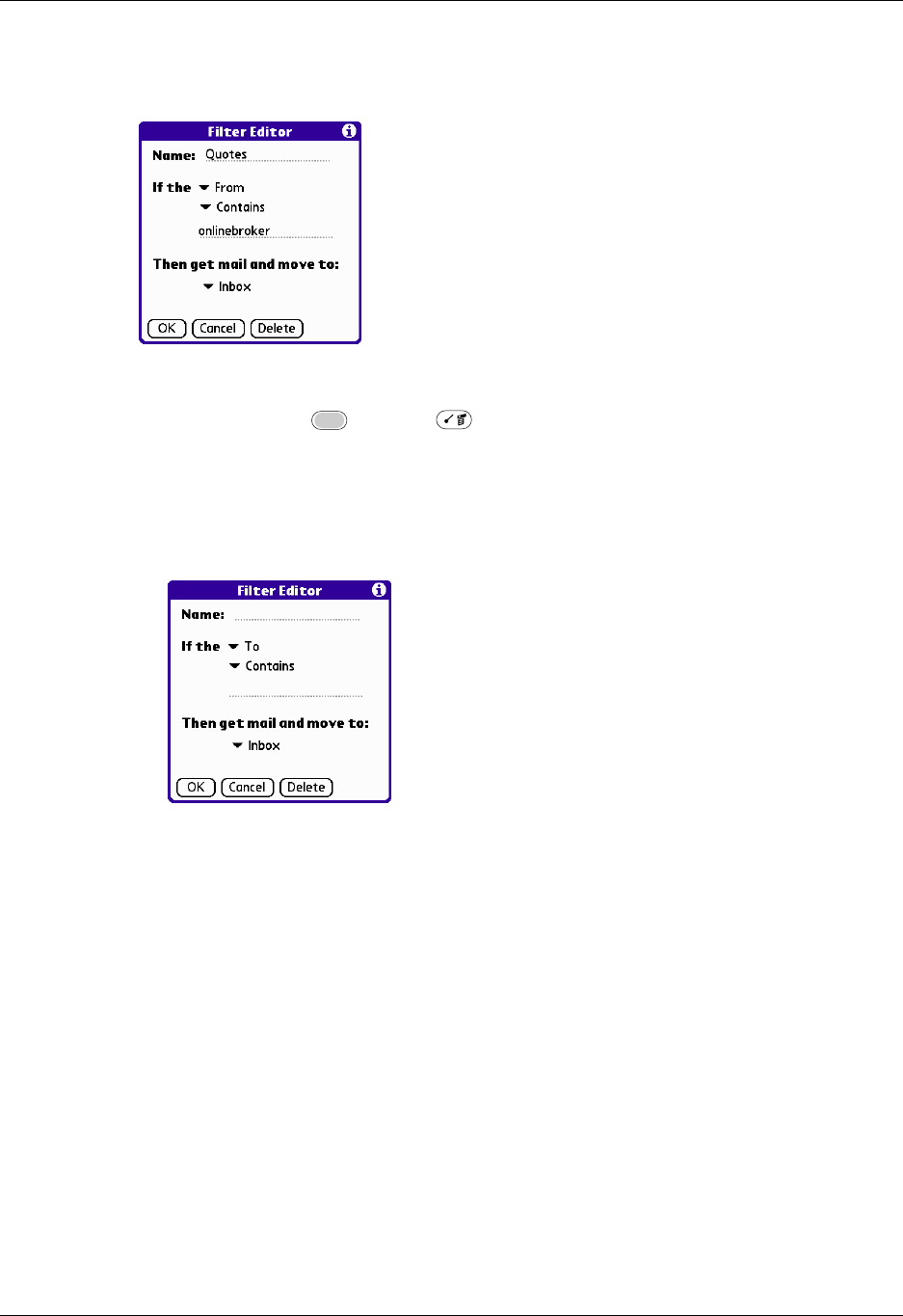
Going beyond the basics
231
folder. The filter statement, which is displayed in the Filter Editor, is shown in the
following figure.
To create a filter:
1. Press Function + Menu .
2. Select Options, and then select Filters.
3. Tap New.
4. Enter a short description of the filter in the Name field.
5. Use the If the pick lists to create criteria for the filter.
The three pick lists and the edit line combine to create a statement that identifies
the type of e-mail and where you want the e-mail stored. For example, a filter
might read, “If the [Subject] [Contains] sales meeting, Then get mail and move
to [Sales].” When you use this filter to sort incoming e-mail, any e-mail
containing sales meetings in the subject line is filed in the Sales folder.
To pick list Select the message header field with the information
contained in the edit line: To, From, Subject, cc, Date, Size.
For example, you might select Date to download only
messages that are less than a certain number of days old.
Contains pick
list Select a filter action: Contains, Starts with, Does NOT
Contain.
Palm, Inc. Confidential
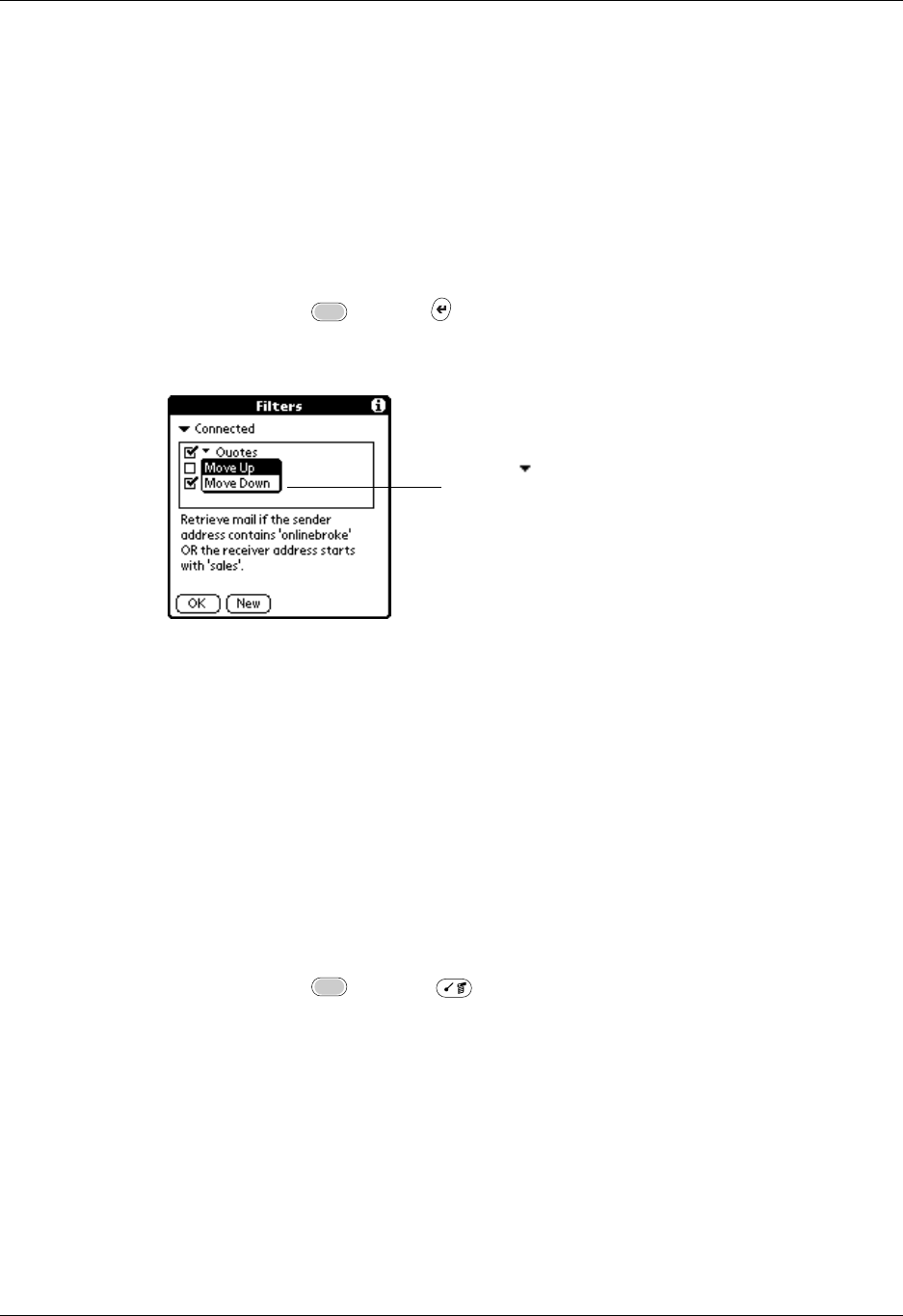
Chapter 17 Using Palm™ VersaMail™ Personal E-mail Software
232
6. Press Function + Enter , or tap OK.
The filter appears in the Filters list.
Selected filters execute in the order in which they appear on the list. Move filters
up and down the list to ensure that they execute in the correct order.
NOTE Filters created on the handheld also apply to e-mail synchronization. See
“Synchronizing an account” earlier in this chapter for more information.
Turning filters on and off
By default, a filter that is turned on or selected affects all subsequent downloads of
e-mail until you deselect it. More than one filter can be in effect at once. Before you
download e-mail, be sure to turn on the filters you want and turn off those you
don’t want.
To turn a filter on or off:
1. Press Function + Menu .
2. Select Options, and then select Filters.
Edit line Enter the text that must be found in the header field. For
example, if you want to sort e-mail with the subject Sales,
enter “Sales.” If you enter more than one criteria, separate
each with a comma, for example—Sales, New York.
Then get mail
and move to
pick list
Select the folder or mailbox into which you want your
filtered e-mail to go. You can also create a new folder for
storing the incoming e-mail. Tap Edit Folders, and then
create a new folder or delete or rename existing ones.
Tap the icon and then
move the filter up or down
in the list
Palm, Inc. Confidential
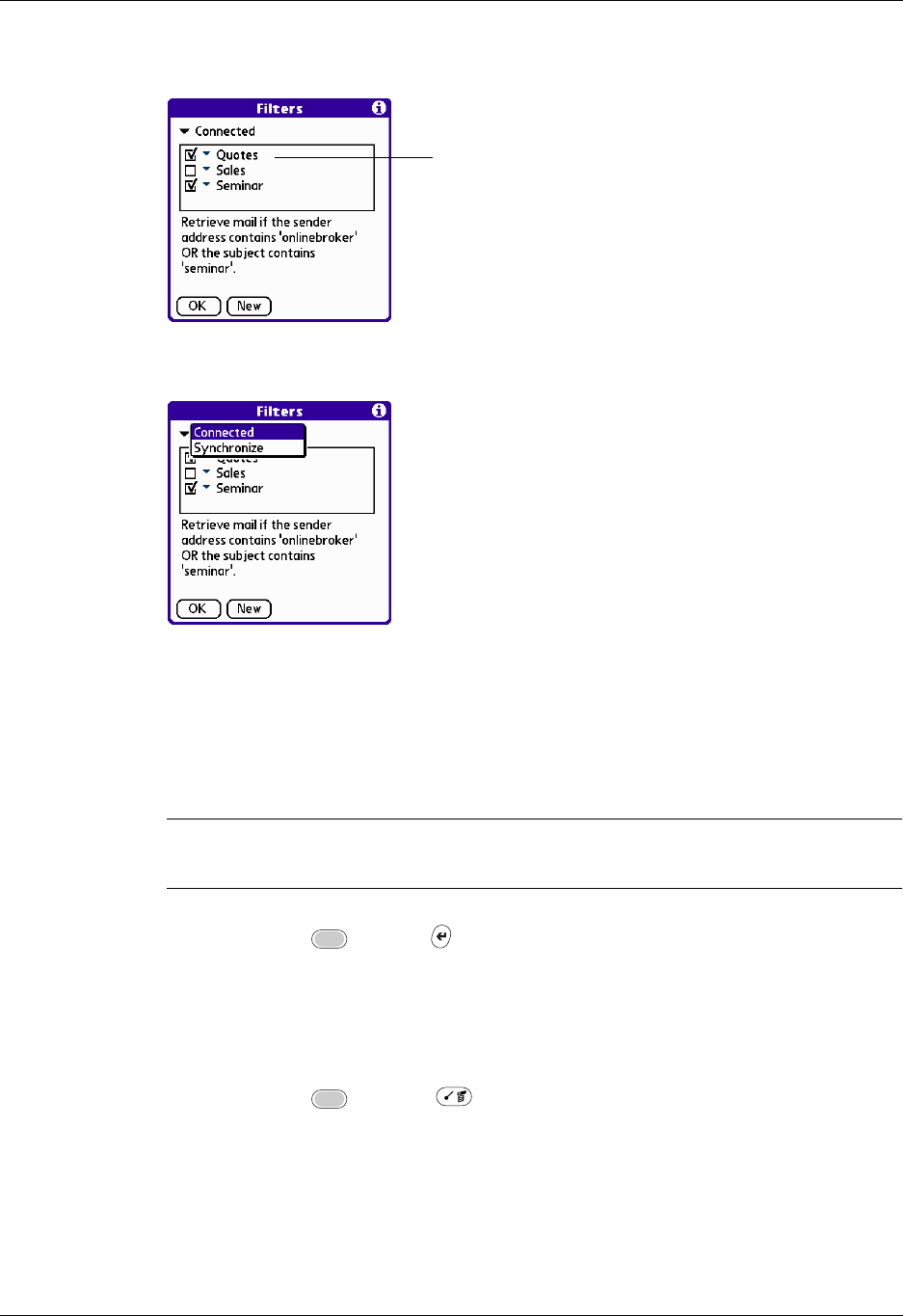
Going beyond the basics
233
The Filters dialog box appears with the filters you created.
3. Tap the pick list in the upper-left corner, and select Connected or Synchronize.
– Connected applies a filter to a modem transaction.
– Synchronize applies a filter to a HotSync operation.
4. Tap the filter check boxes to select the filters you want to use for subsequent
e-mail transactions.
IMPORTANT If you deselect a filter listed under Connected, be sure that the filter
is deselected also under Synchronize.
5. Press Function + Enter , or tap OK.
Editing or deleting a filter
You can edit a filter to change its name or the criteria in the filter.
To edit or delete a filter:
1. Press Function + Menu .
2. Select Options, and then select Filters.
3. Tap the name of the filter.
Filters with a check mark are
turned on
Palm, Inc. Confidential
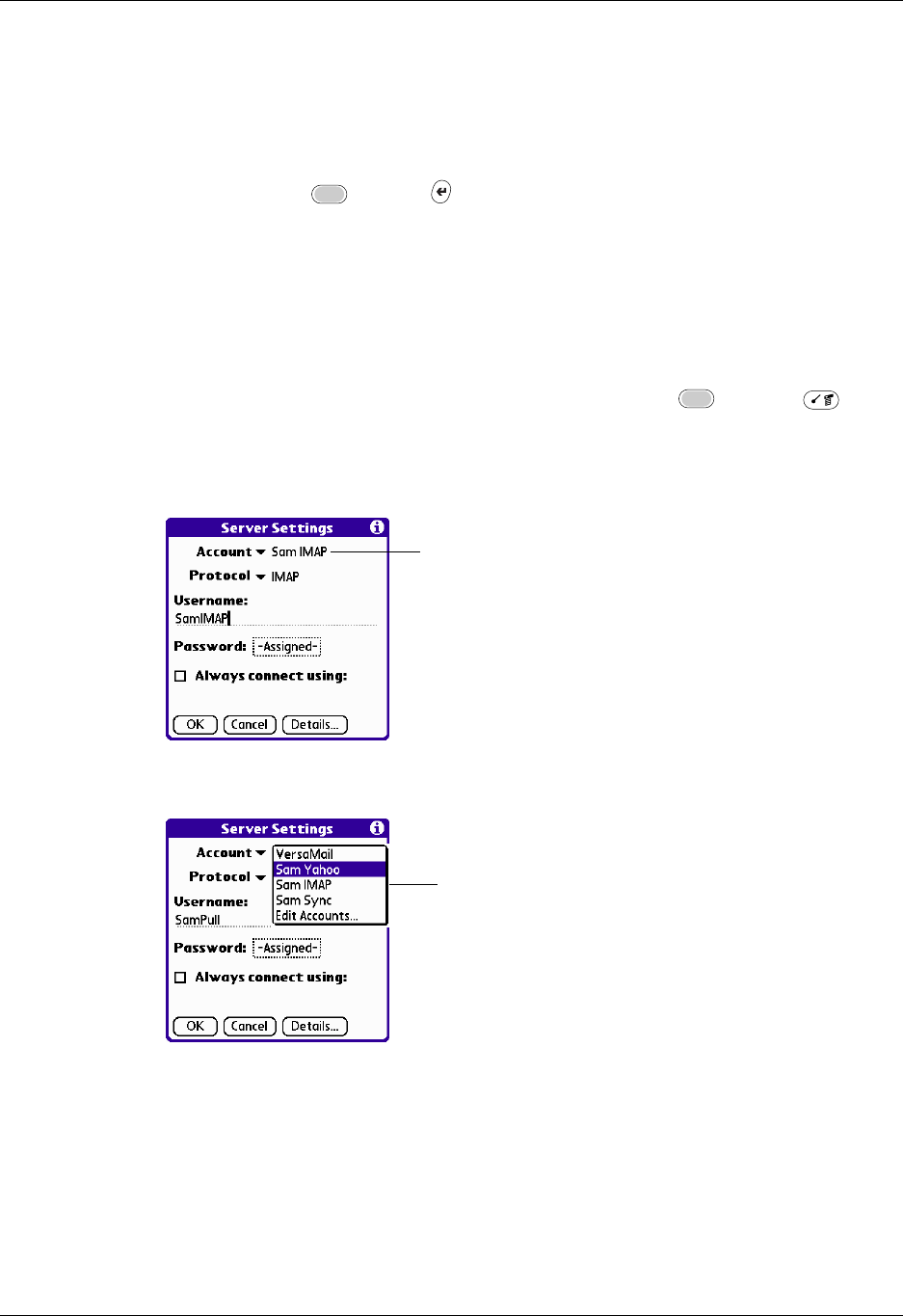
Chapter 17 Using Palm™ VersaMail™ Personal E-mail Software
234
4. Do one of the following:
– To edit the filter, revise your entry in the Name field and/or your selections
in the pick lists, and revise the text in the edit line. Tap OK.
– To delete the filter, tap Delete, and then tap Yes to confirm deletion.
5. Press Function + Enter , or tap OK.
Managing mail settings
You can configure advanced mail settings such as server information, incoming
and outgoing mail server options, and more for each e-mail account.
To select the account whose settings you want to manage:
1. In your Inbox or another folder screen, press Function + Menu .
2. Select Options.
3. Select Mail Servers.
4. Tap the Account pick list, and then tap Edit Accounts.
5. Tap the name of the account whose settings you want to manage, and then tap
OK.
Shows server settings for current
account. Tap the Account pick list
to edit the account
All e-mail accounts
appear in the list
Palm, Inc. Confidential
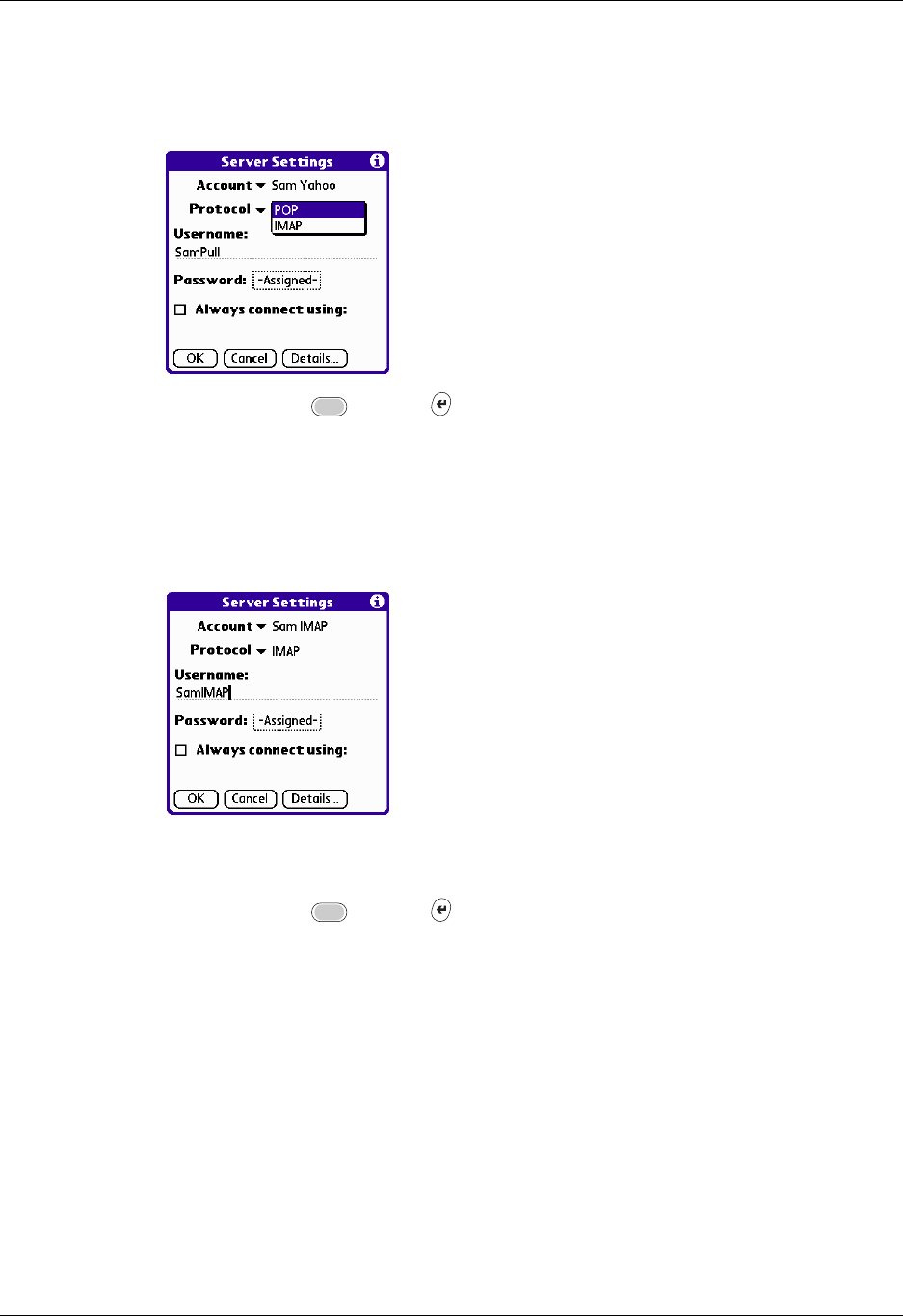
Going beyond the basics
235
To change the protocol type:
1. In the Server Settings screen, tap the Protocol pick list, and then tap POP or
IMAP.
2. Press Function + Enter , or tap OK.
To change your username or password:
1. In the Server Settings screen, enter a new username.
Your username is typically the first part of your e-mail address, which appears
before the @ symbol.
2. Tap the Password box, and enter a new password in the Password Entry dialog
box.
3. Press Function + Enter , or tap OK.
Palm, Inc. Confidential
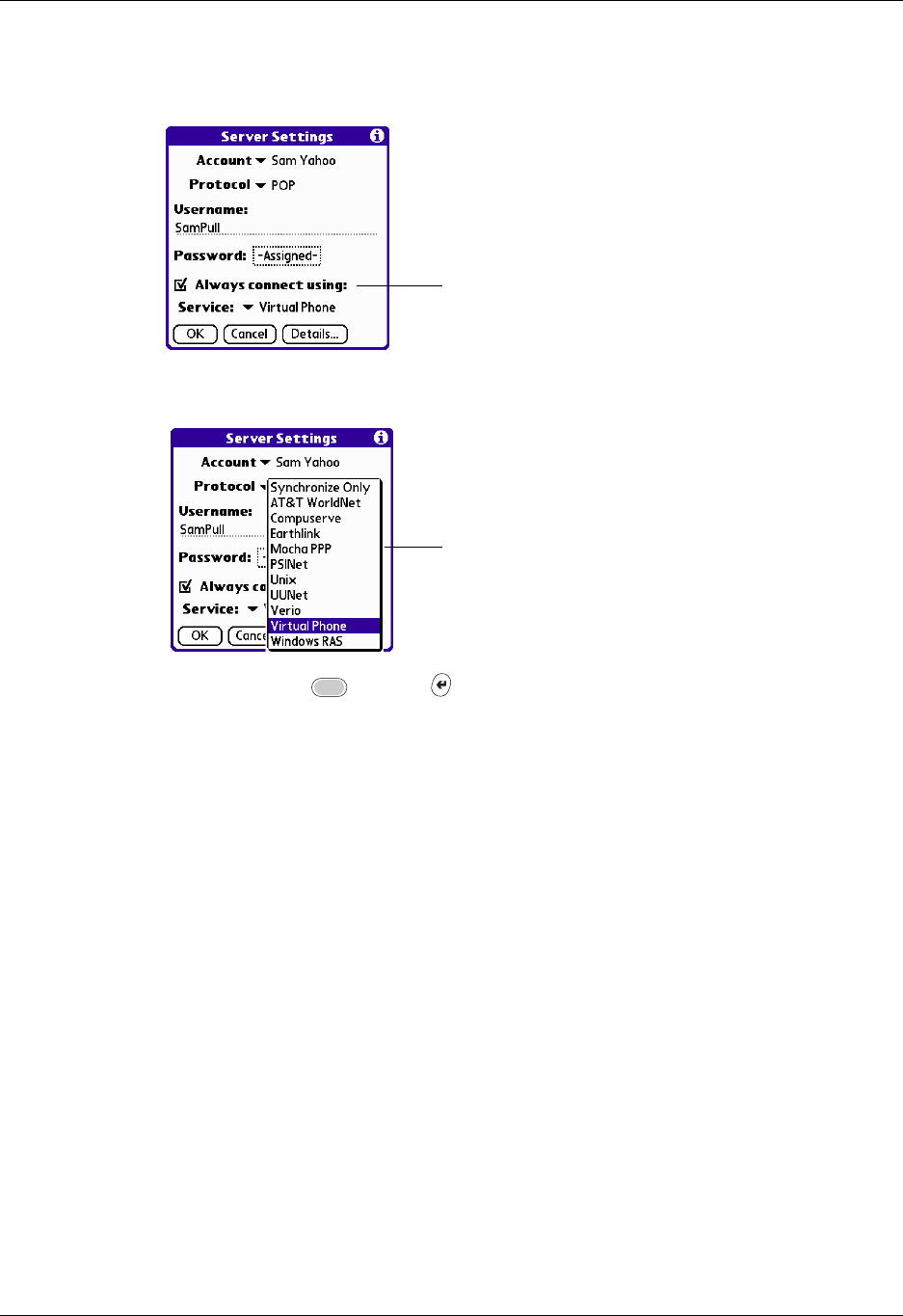
Chapter 17 Using Palm™ VersaMail™ Personal E-mail Software
236
To set a default service for this account (different from the default service for your handheld):
1. In the Server Settings screen, tap the Always Connect Using check box.
2. Tap the connection type you want from the Services pick list.
3. Press Function + Enter , or tap OK.
NOTE Select this option only if you want a given e-mail account to use a
different service from the default service you set for your handheld. For
example, you may have selected a default service that uses the built-in GPRS
radio on your handheld to make a network connection. However, for your
Earthlink account, you may want to switch to the Earthlink service, which uses
dial-up GSM to make a network connection. To do this, tap this check box, then
select Earthlink from the Services pick list. Leave this box deselected if you
want to use your default handheld service for this e-mail account.
See Chapter 21 for information on setting connection types and selecting a
default service for your handheld. See “Selecting a different service for a given
e-mail account” earlier in this chapter for details on using a different service for
a specific e-mail account.
Tap to change the service
connection for this e-mail
account only from your default
handheld service connection
Select a service connection for
this e-mail account only
Palm, Inc. Confidential
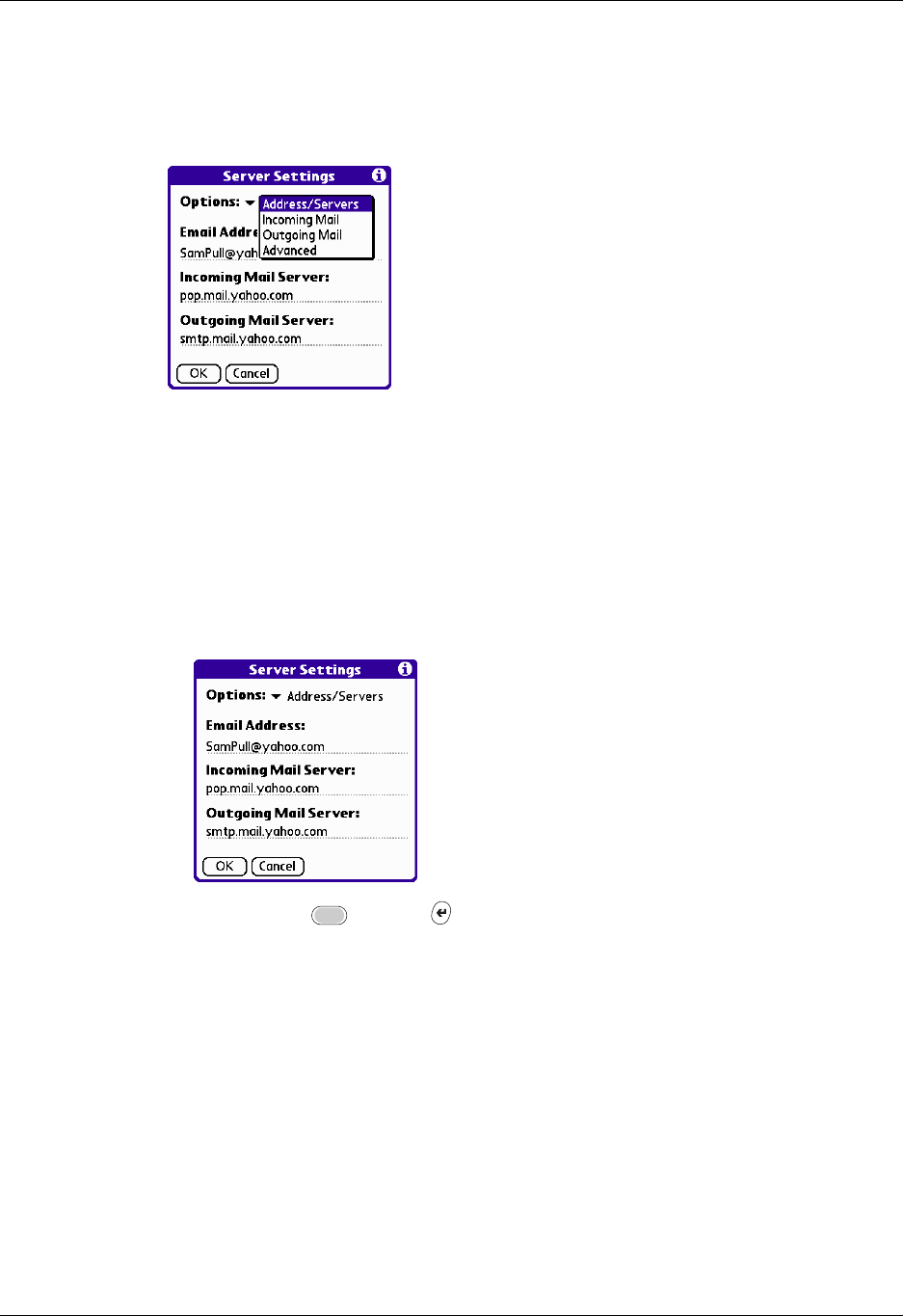
Going beyond the basics
237
To change e-mail address/mail server settings:
1. In the Server Settings screen, tap Details.
2. Tap the Options pick list and select Address/Servers.
3. Edit any of the following:
–E-mail address: Enter the e-mail address of the account you are accessing,
such as examplename@yahoo.com.
–Incoming mail server: Enter the name of your incoming (POP) mail server,
such as pop.mail.yahoo.com.
–Outgoing mail server: Enter the name of your outgoing (SMTP) mail server,
such as smtp.mail.yahoo.com.
4. Press Function + Enter , or tap OK.
Palm, Inc. Confidential
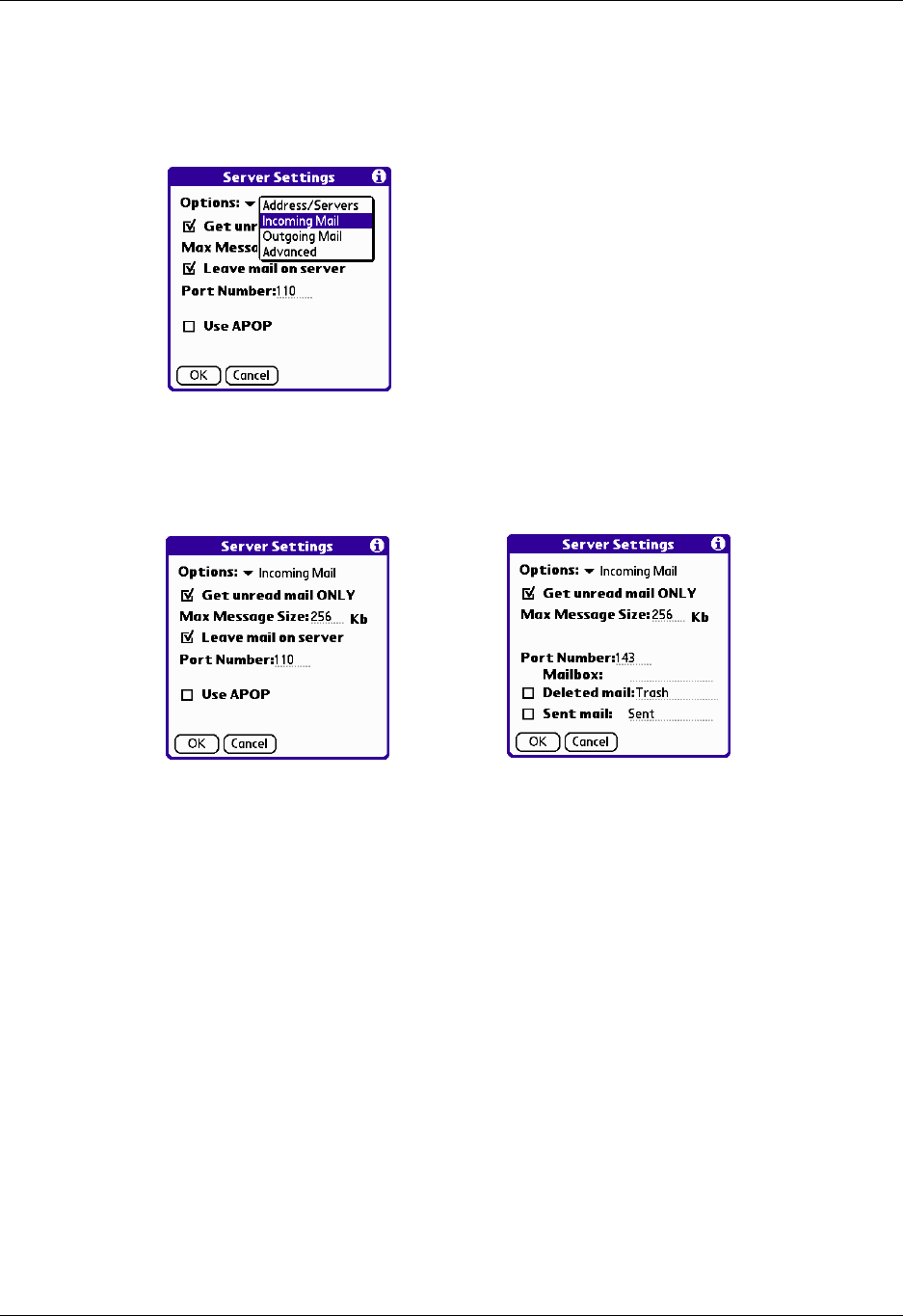
Chapter 17 Using Palm™ VersaMail™ Personal E-mail Software
238
To change incoming mail server settings:
1. In the Server Settings screen, tap Details.
2. Tap the Options pick list and select Incoming Mail.
3. The incoming mail options are different depending on the connection type you
selected and the server protocol—POP or IMAP.
.
Leave mail on
server (POP only) Leaves e-mail that you receive on the handheld on the server
also.
Get unread mail
ONLY Retrieves unread e-mail only. To get all e-mail and not just
unread e-mail, deselect Get unread mail ONLY.
Maximum
Message Size Shows the maximum message size that you can receive.
Use APOP (POP
only) Encrypts your username and password when traveling over
the network. Some services require APOP to work properly,
while others do not work properly if APOP is used. If you
aren’t sure if your ISP or web e-mail provider supports
APOP, check with your e-mail provider. See “Adding APOP
to an account” later in this chapter.
Port Number Defaults to 110 for POP and 143 for IMAP servers
respectively. If you are not sure about the correct port
number, check with your mail server administrator.
POP accounts IMAP account
Palm, Inc. Confidential
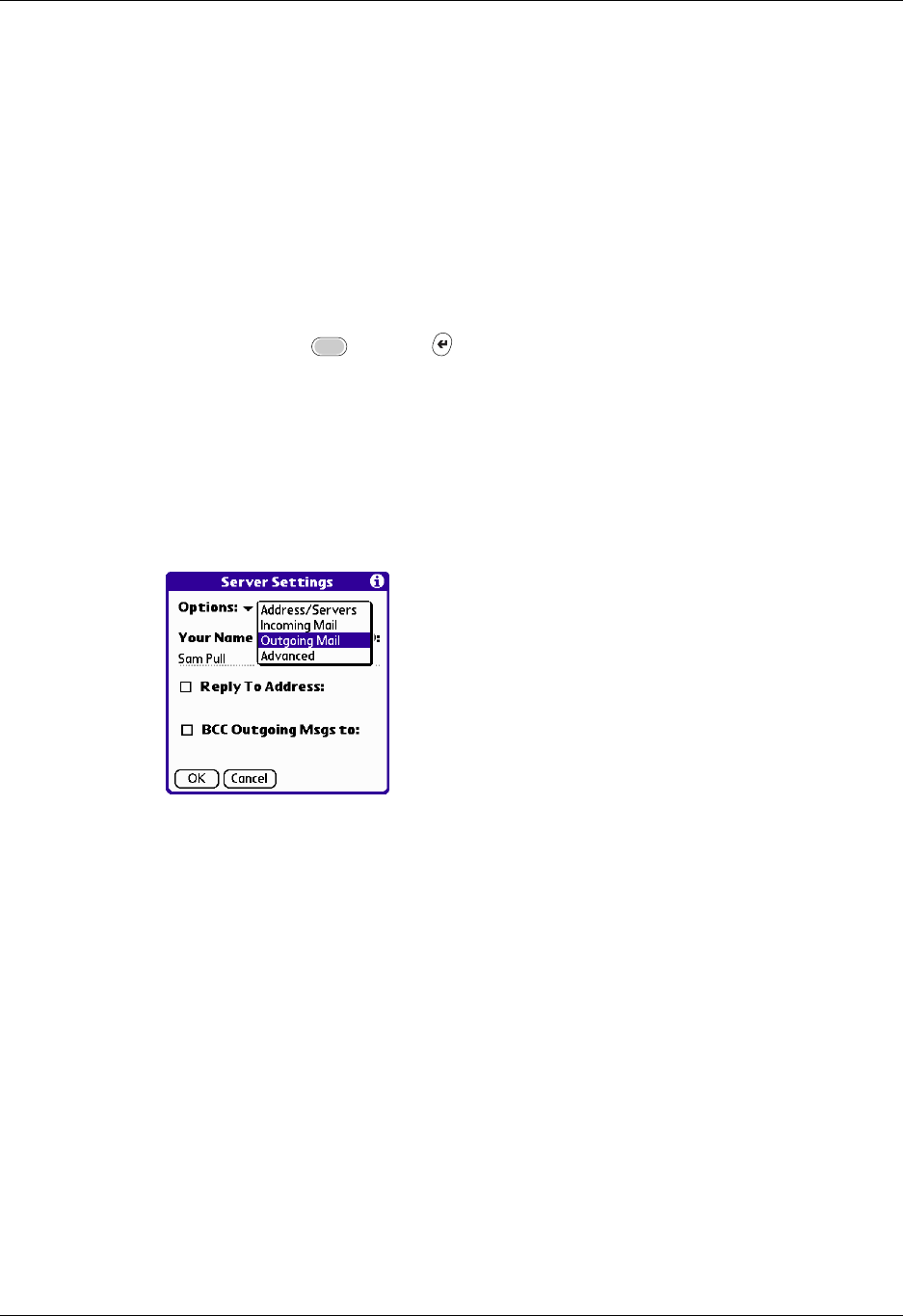
Going beyond the basics
239
4. Press Function + Enter , or tap OK.
If you are using the Palm VersaMail HotSync Conduit and have an IMAP
account, you must configure the outgoing mail settings to send mail.
To set outgoing mail server (SMTP) settings:
1. In the Server Settings screen, tap Details.
2. Tap the Options pick list and select Outgoing Mail.
3. Enter any of the following:
–Display Name: Enter the name you want to appear on your outgoing
messages, such as “Joe Smith.”
–Reply To Address: Enter the e-mail address that you want recipients to see
and reply to on your e-mail messages, only if it is different from the e-mail
address from which you are sending the message. For example, if you are
sending a message from me@yahoo.com but you want recipients to reply to
me@earthlink.net, enter the reply-to address here. Reply To Address makes
it look like the e-mail came from the address you entered.
–BCC: Select the BCC check box to send a blind copy of any e-mail message
you send to another e-mail address. The blind copy e-mail address is not
seen by the other recipients of the message. For example, if you want a copy
of all messages you send from your handheld to be sent to your desktop e-
mail account, enter that e-mail address.
Mailbox (IMAP
only) Defines the root mailbox on your IMAP server.
Deleted Mail
(IMAP only) Stores deleted e-mail in the folder you specify on the server.
This field is case sensitive, so spell the folder name exactly as
it is on the server. For example, if your Deleted Mail folder is
called Trash on the server, you must enter Trash in this space.
Sent Mail (IMAP
only) Shows the name of your Sent Mail folder on the server. This
field is case sensitive, and the folder name should be spelled
exactly as it is on the server.
Palm, Inc. Confidential
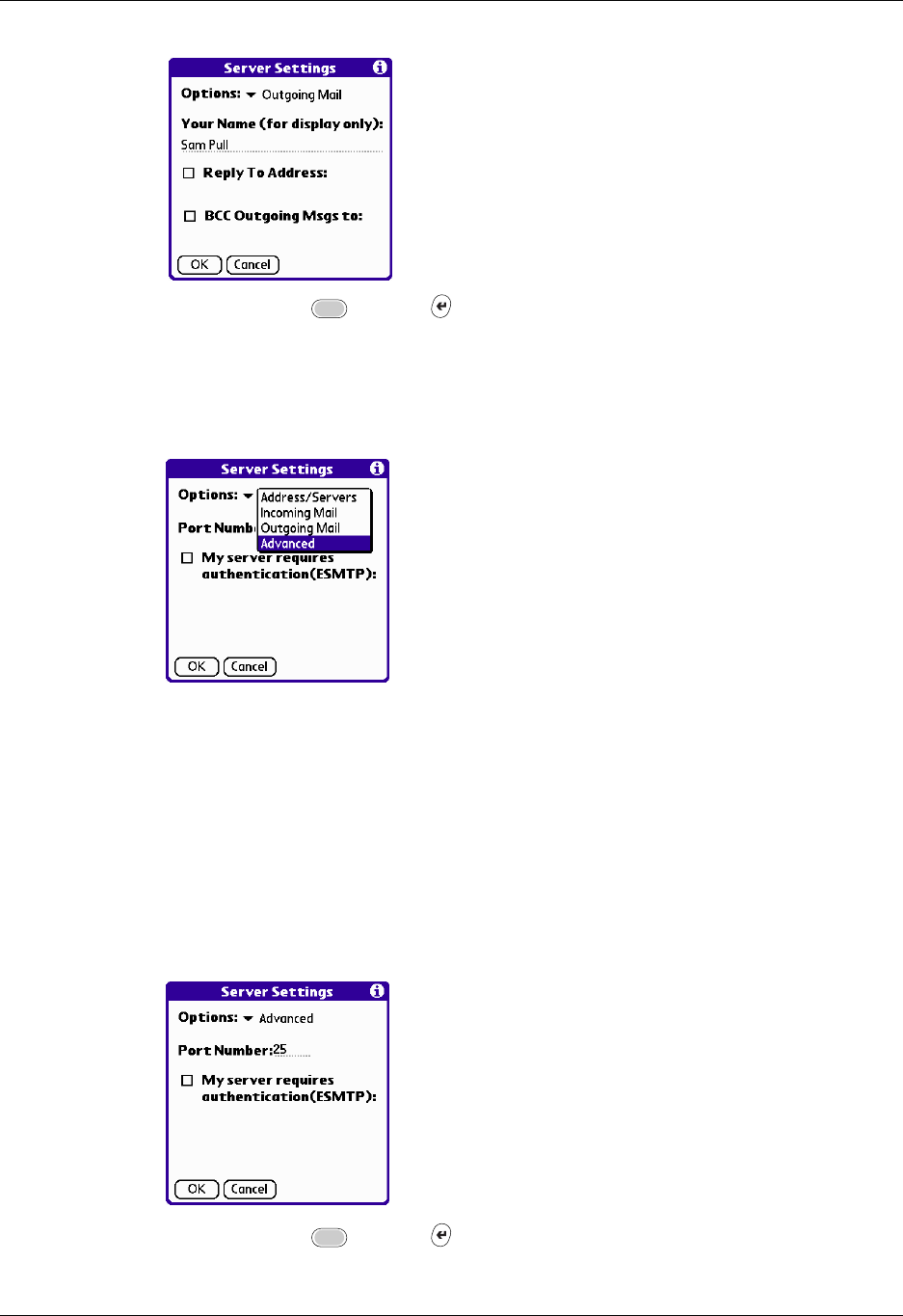
Chapter 17 Using Palm™ VersaMail™ Personal E-mail Software
240
4. Press Function + Enter , or tap OK.
To set additional outgoing mail options:
1. In the Server Settings screen, tap Details.
2. Tap the Options pick list and select Advanced Outgoing.
3. Set additional options for outgoing e-mail:
4. Press Function + Enter twice, or tap OK twice.
Port Number The default is 25, the port number most SMTP servers use. If
you are not sure about the correct port number, check with
your mail server administrator.
My server requires
authentication
(ESMTP)
Select this option if the outgoing server (SMTP) requires
authentication. Check with your system administrator
before selecting this option. See “Adding ESMTP to an
account” later in this chapter.
Palm, Inc. Confidential
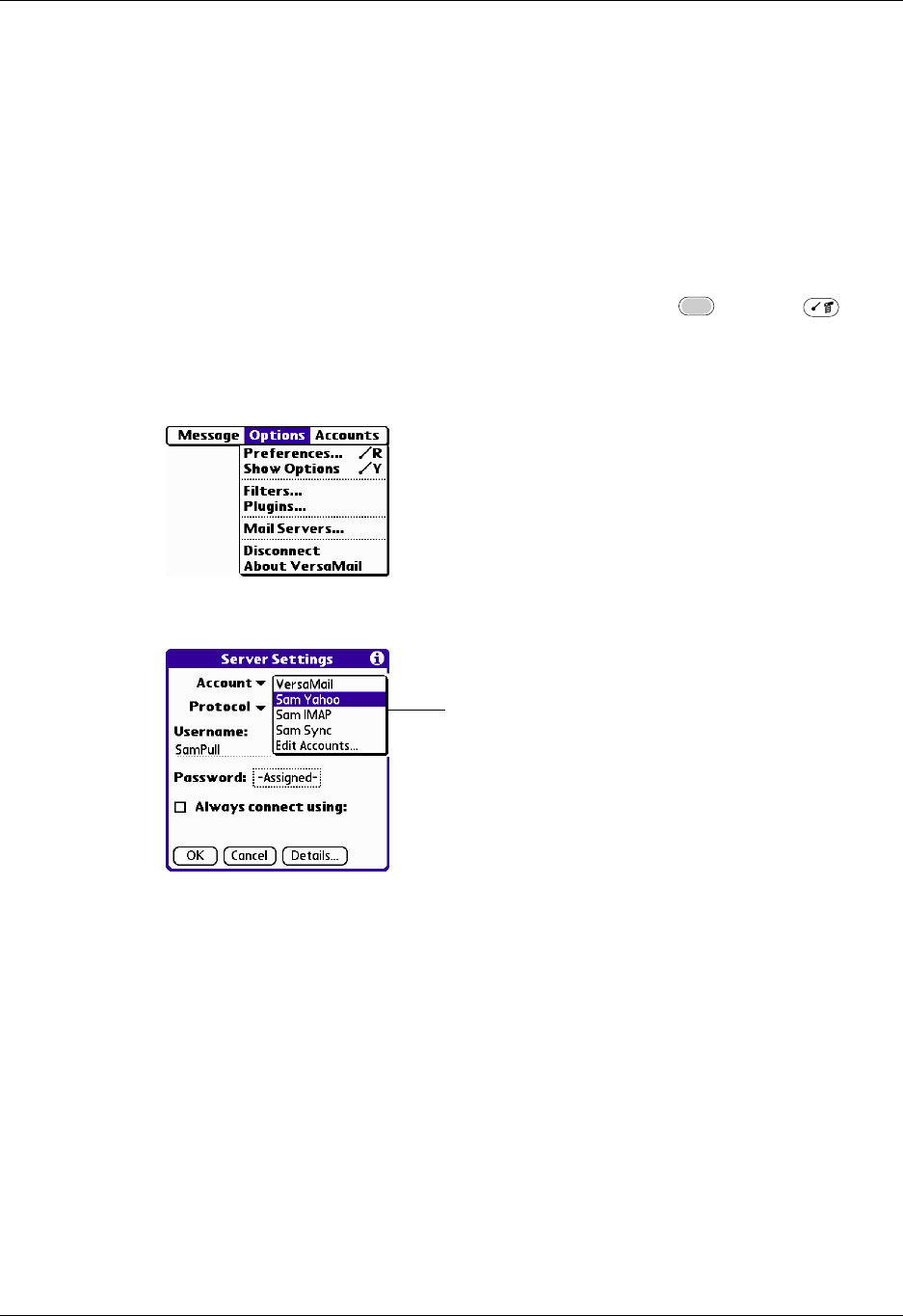
Going beyond the basics
241
Adding APOP to an account
To encrypt your username and password when traveling over the network, some
services require APOP to work properly, while others do not work properly if
APOP is used. If you aren’t sure if your ISP or web e-mail provider supports
APOP, check with your e-mail provider.
NOTE APOP works only with accounts that use the POP protocol.
To edit an account and add APOP:
1. In your Inbox or another folder screen, press Function + Menu .
2. Select Options.
3. Select Mail Servers.
4. Tap the Account pick list and select Edit Accounts.
5. Tap the name of the account you want to change, and then tap OK.
6. In the Server Settings screen, tap Details.
All e-mail accounts
appear in the list
Palm, Inc. Confidential
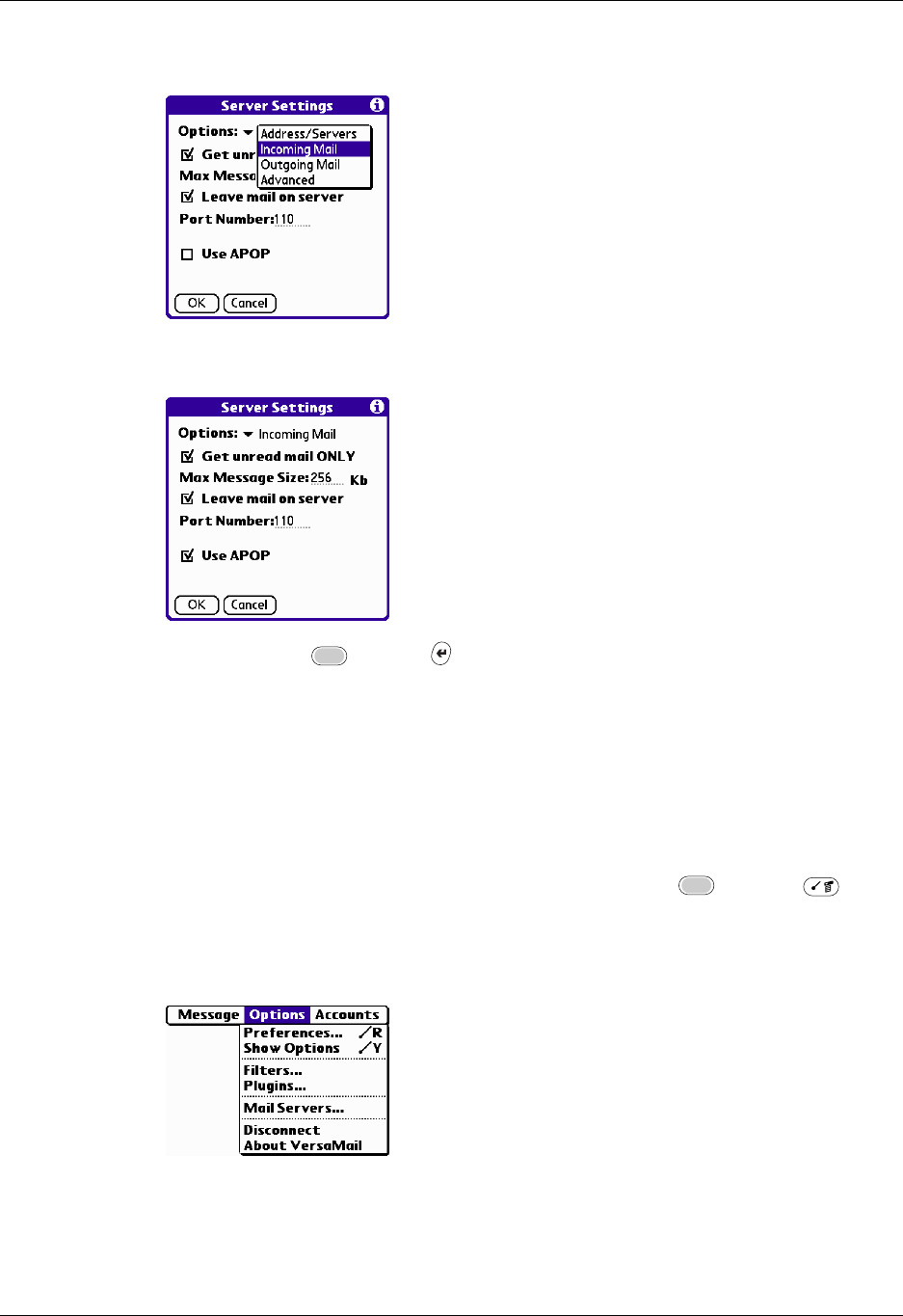
Chapter 17 Using Palm™ VersaMail™ Personal E-mail Software
242
7. Tap the Options pick list and select Incoming Mail.
8. Select the Use APOP check box.
9. Press Function + Enter , or tap OK.
Adding ESMTP to an account
Some services require ESMTP authentication to validate your username and
password on a given SMTP server. If you aren’t sure if your ISP or web e-mail
provider supports ESMTP, check with your e-mail provider.
To edit an account and add ESMTP:
1. In your Inbox or another folder screen, press Function + Menu .
2. Select Options.
3. Select Mail Servers.
Palm, Inc. Confidential
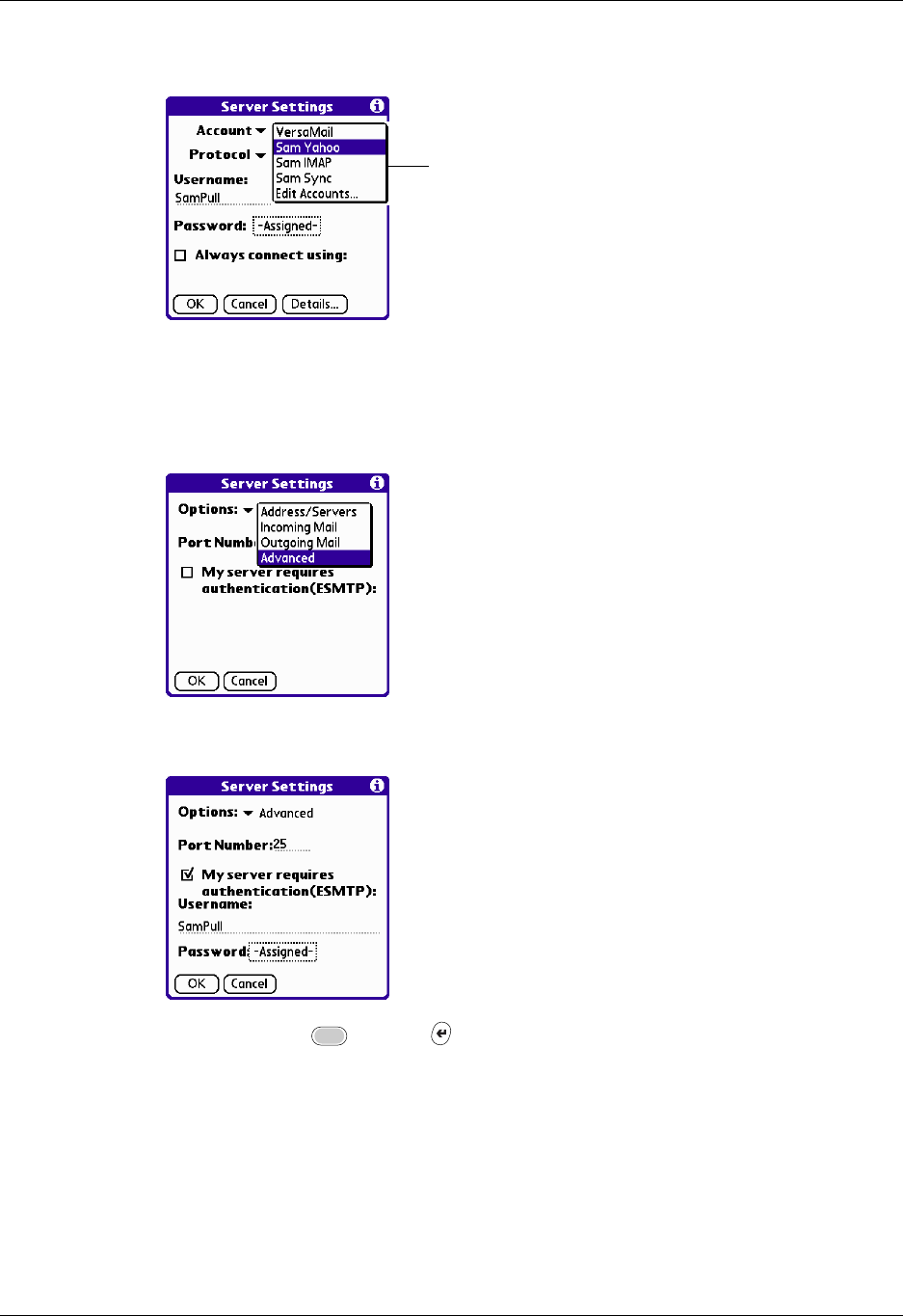
Going beyond the basics
243
4. Tap the Account pick list and select Edit Accounts.
5. Tap the name of the account you want to change, and then tap OK.
6. In the Server Settings screen, tap Details.
7. Tap the Options pick list and select Advanced Outgoing.
8. Select the My server requires authentication (ESMTP) check box.
9. Press Function + Enter , or tap OK.
All e-mail accounts
appear in the list
Palm, Inc. Confidential

Chapter 17 Using Palm™ VersaMail™ Personal E-mail Software
244
Copying text from an e-mail message for use in other applications
You can copy any text from an e-mail message, either from one you have
composed or have read or from an attachment you have downloaded and opened
(such as a Word doc), for use elsewhere in the VersaMail application or in another
application. Text you can select and copy includes:
■A name
■An e-mail address
■Body text of an e-mail message or a downloaded attachment
To copy and paste text from an e-mail message:
1. Select the text by dragging the stylus over it.
2. Press Command + C.
3. To paste the text elsewhere in the VersaMail application or in another
application, go to the new location and press Command + V.
TIP You can also tap commands for copying and pasting in the edit menu (press
Function + Menu , and then select Edit) in many handheld applications.
See “Performing common tasks” in Chapter 4 for more information on copying
and pasting.
Using the command bar
The command bar provides shortcuts for performing numerous tasks. The options
presented on the command bar may change, depending on which screen is
displayed in the application. For example, if you are viewing a message in the
Inbox, the command bar gives you the option of quickly moving the message to
another folder. See “Moving e-mail between folders” earlier in this chapter.
To access the command bar on your Tungsten W handheld:
■Press Command on the keyboard.
For each type of screen, the command bar offers various options.
View Options
List (Inbox, Outbox, and so
on showing list of
messages
Select all messages.
Deselect all messages.
Change display font (toggles between large and
small font).
Delete messages from the handheld; icon appears
only if you have previously selected all messages.
Palm, Inc. Confidential
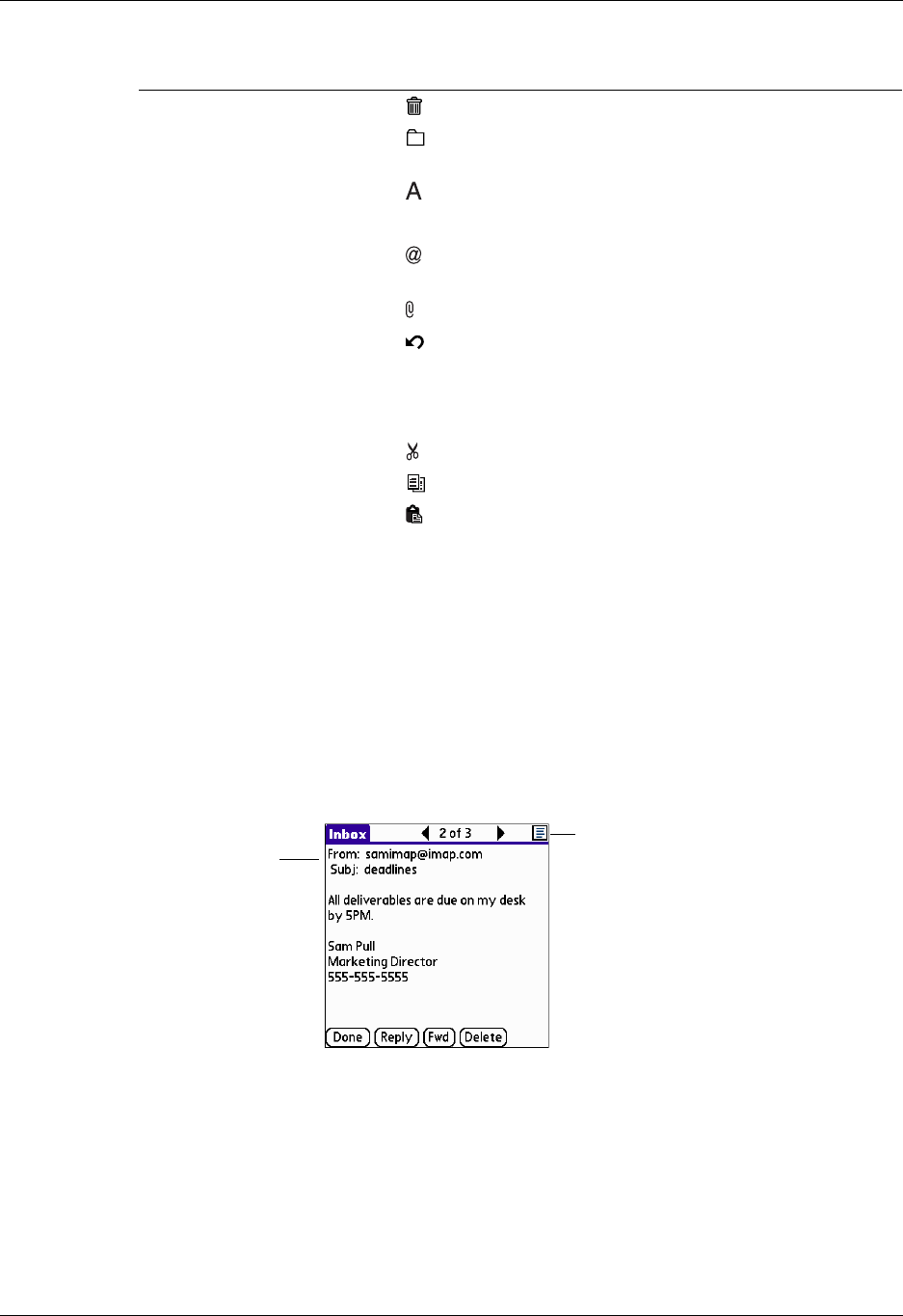
Going beyond the basics
245
See “Using menu commands” in Chapter 3 for more information on the command
bar.
E-mail header details
When viewing a message in any folder, you can change the view of the message
header. The e-mail header options as follows:
■Short header: Shows sender’s name or address (From field) and subject line
(Subj field).
■Full header: Shows the following:
– Sender’s name or e-mail address (From field)
– Subject line (Subj field)
– Date message was composed, sent, or received (Date field)
Reading a message Delete message from the handheld.
Move message to a different folder; select folder
from pick list.
Change display font (toggles between large and
small font).
Composing a message Insert the @ symbol into a recipient’s e-mail
address.
Add attachment.
Undoes last action; icon appears in command bar
only if you have previously performed one of the
actions above or any of the cut/copy/paste
functions described below.
Reading or composing a
message
Cuts selected text.
Copies selected text.
Pastes selected text.
View Options
Tap header icon to switch to full
header
Short header
shows sender
name and
message subject
only
Palm, Inc. Confidential
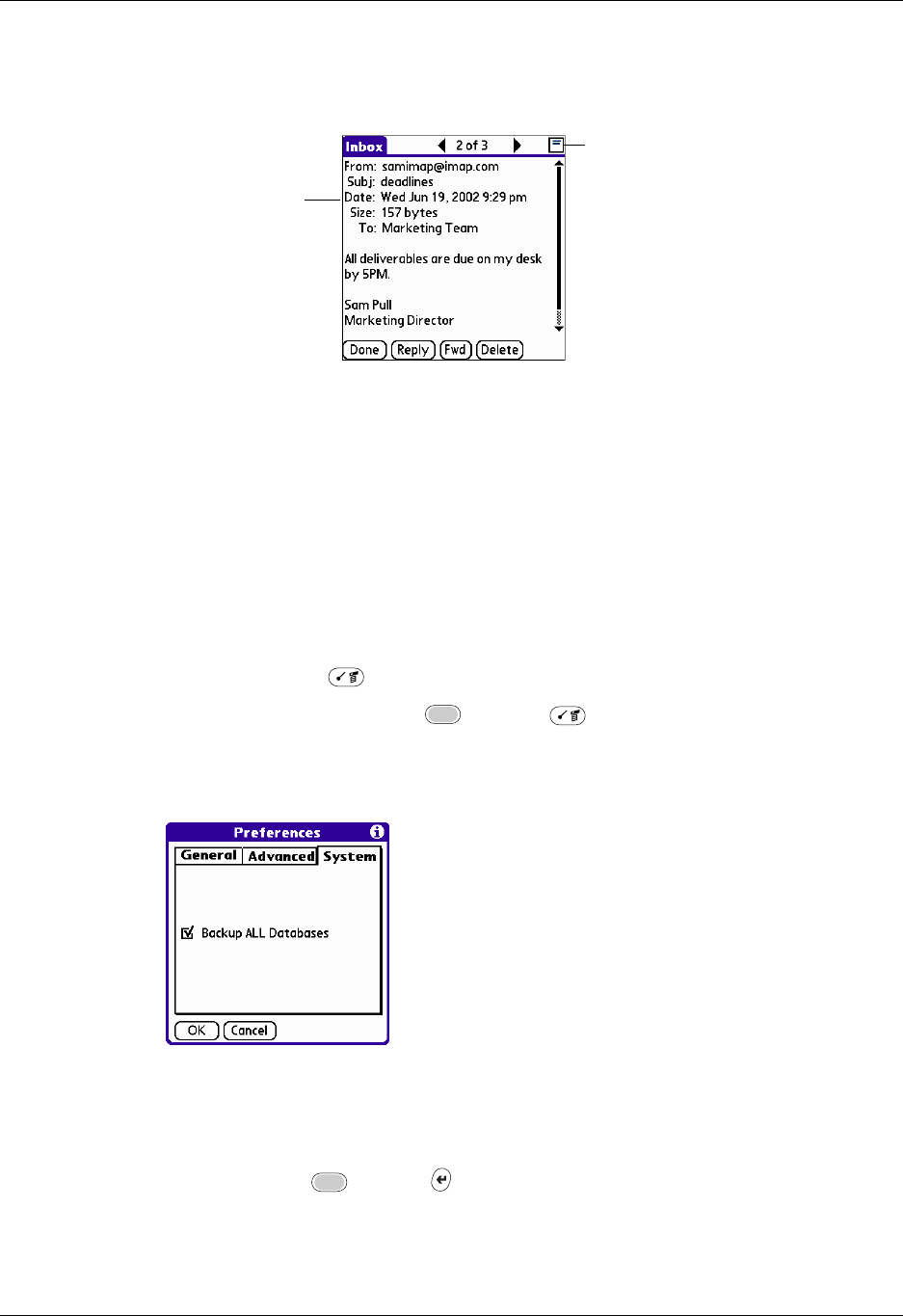
Chapter 17 Using Palm™ VersaMail™ Personal E-mail Software
246
– Size of message including any attachments (Size field)
– Recipient’s name or e-mail address (To field)
To switch between short header and full header view, tap the header icon in the
upper-right corner of the message screen.
Backing up mail databases
In most cases your e-mail is on your server, so you do not need to back up your
e-mail database from your handheld. If you want to make sure you have a current
copy of all your e-mail, you can back up all the e-mail databases from the
handheld.
To back up the e-mail database:
1. Press Command + R.
Alternately, press Function + Menu , select Options, and then select
Preferences.
2. Tap System.
3. Tap Backup ALL Databases to select it.
NOTE If you don’t select this option, HotSync operations are faster.
4. Press Function + Enter , or tap OK.
Tap header icon to switch to
short header
Full header
shows sender,
subject, date,
size, and
recipient
information
Palm, Inc. Confidential

Going beyond the basics
247
Wireless IMAP folder synchronization
If you create an IMAP folder in an account on your handheld that matches a folder
on the mail server, you can wirelessly synchronize e-mail messages that you move
into or out of the IMAP folder, or delete in the folder.
When you synchronize a folder, any e-mail messages in the selected folder on the
mail server will be downloaded to the same folder on your handheld. Any
messages moved out of the selected folder on your handheld or deleted on your
handheld will be moved or deleted in the folder on the mail server.
Depending on how you have set up IMAP folders on your handheld and/or the
mail server, you may have to perform some steps before you can wirelessly
synchronize e-mail messages between your handheld and the server, as follows:
■If you need to create a folder on both your handheld and the server, see
“Creating and editing mail folders” earlier in this chapter. Be sure to select the
Also create on server check box as described in that section, After creating the
folders, continue with the following procedures for synchronizing IMAP
folders.
■If there is a folder on the mail server but need to create it on your handheld. see
“Creating and editing mail folders” earlier in this chapter. You do not need to
select the Also create on server check box as described in that section. After
creating the folder, continue with the following procedures for synchronizing
IMAP folders below.
■If you have a folder on your handheld that matches a folder on the mail server,
continue with the following procedures for synchronizing IMAP folders.
You can synchronize either a single pair of handheld/mail server folders, or
multiple pairs of folders.
NOTE You can synchronize folders whose names are up to 16 characters in length.
You can synchronize up to 11 custom folders you create, in addition to the default
folders Inbox, Outbox, Drafts, Sent, and Trash.
To wirelessly synchronize a single pair of handheld/mail server IMAP folders:
1. From within an IMAP e-mail account, tap the folders pick list in the upper-right
corner of the screen and select the folder you want to synchronize.
2. Tap Get Mail.
Palm, Inc. Confidential

Chapter 17 Using Palm™ VersaMail™ Personal E-mail Software
248
To synchronize multiple pairs of IMAP folders:
1. In your Inbox or another folder screen of an IMAP e-mail account, press
Function + Menu .
2. Select Options.
3. Press Command + L (alternately, select Sync IMAP Folders).
4. Select the folders you want to synchronize from the pick list. A connection is
made to your network provider to update the server with changes from your
handheld, and to have your handheld updated with changes from the server.
Accessing corporate e-mail
Many corporate e-mail servers—including Microsoft Exchange and Lotus Domino
servers—support direct IMAP access. If you are accessing your e-mail using the
VersaMail application and an 802.11 network behind your company’s firewall, you
may be able to directly access your business e-mail. If your company requires extra
security or you are accessing your e-mail through either a dial-up connection or a
LAN outside of your company’s firewall, you will need to use a Virtual Private
Network (VPN) client before you can access your business e-mail. Check with your
company’s network administrator for information about VPN access, your
business e-mail username and password, and IMAP and SMTP settings.
Five-way navigation in the VersaMail application
The following table summarizes the controls for the five-way navigator on your
handheld that are specific to the VersaMail application. See “Using the navigator”
in Chapter 3 for general navigator information.
View Selection Navigation Function
Main List
(Inbox or
other folder
list)
No message
selected
Up/Down Scrolls between messages in list.
Select Highlights the first message in the
list.
Right No function.
Palm, Inc. Confidential

Going beyond the basics
249
When you return from viewing a message to the list view (Inbox or other folder),
the message you were viewing may or may not be selected in the list, according on
the following:
■If you pressed Select to view the message, the message will be highlighted on
the list on when you return to the list view
■If you used the stylus or pressed Right or Left to view the message, the message
will not be highlighted when you return to the list view. If you press Select, the
first message in the list will be selected.
Left No function.
Message
selected
Select Opens messages for viewing.
Right Displays context menu that normally
appears when clicking on the e-mail
icon for each message.
Left Returns you to the “no message
selected” options.
Compose
New Message
N/A Up/Down In To, cc, bcc, and Subject fields: Tabs
to the next/previous field.
In message body text: Scrolls the text
viewed on the text list.
Select No function.
Right In To, cc, bcc, and Subject fields:
Moves to the next character.
In message body text: No function.
Left In To, cc, bcc, and Subject fields:
Moves to previous character.
In message body text: No function.
Read
Message
N/A Up/Down Scrolls the message text.
Select Returns you to list view.
Right Displays the next message. If you are
is viewing the last message, returns
you to the folder list view.
Left Displays the previous message. If
you are viewing the first message in
the folder, returns you to the folder
list view.
View Selection Navigation Function
Palm, Inc. Confidential

Chapter 17 Using Palm™ VersaMail™ Personal E-mail Software
250
The following sample procedure shows how to use the navigator to read and
delete a message.
To read and delete a message:
1. Press Up or Down on the navigator to scroll to the message you want to read.
2. Press Select to select the message, and then press Select again to open the
message.
3. After reading the message, press Select to close the message.
4. (Optional) The cursor should remain on the selected message. If not, press Up
or Down to scroll to the message, and press Select to select the message.
5. Press Right to open the pop-up menu.
6. Press Down to scroll to Delete Message.
7. Press Select to delete the message.
8. Press Select to confirm that you want to delete the message.
Keyboard shortcuts in the VersaMail application
The following tables summarizes the keyboard shortcuts specific to the VersaMail
application. See “Using ShortCuts” in Chapter 3 for general keyboard shortcut
information.
To use a keyboard shortcut:
1. Press Command .
2. Press the letter of the shortcut.
ShortCut Feature
A Add Attachment
CCopy
DDelete
EEmpty Trash
FForward Message
H Mark Read
I Mark Unread
K Keyboard
L Address Lookup
MGet Message
Palm, Inc. Confidential

Going beyond the basics
251
N Create New Message
O Reply to Message
PPaste
Q Go to Bottom
R Preferences ...
S Select All
TGo to Top
U Undo
VMove To …
W Save to Draft
XCut
YSend
Z Deselect All
Press & hold Mail Get & Send
ShortCut Feature
Palm, Inc. Confidential

Chapter 17 Using Palm™ VersaMail™ Personal E-mail Software
252
Palm, Inc. Confidential

253
CHAPTER 18
Using Palm™ WAP Browser
Palm™ WAP Browser enables you to quickly and easily browse the Internet
by using specially formatted WAP (Wireless Application Protocol) sites.
Use Palm WAP Browser to do the following:
■Access specially formatted WAP (Wireless Application Protocol) sites.
■Sign up with a provider to receive Push messages automatically to inform you
of important events, such as changes in stock prices.
■Bookmark special WAP sites so that you can easily return to them.
■Make confidential transactions using encrypted keys.
■Store and manage certificates.
IMPORTANT Whenever you use the wireless features of your handheld, please
observe the guidelines or prohibitions on the use of wireless devices in your current
location. For example, when you are on an airplane, do not turn on your radio at
times when government or airline regulations prohibit the use of cellular phones.
You can, of course, use all other applications of your handheld in accordance with
airline regulations for electronic devices.
Opening Palm WAP Browser
Some wireless service providers have set the Wireless button to open Palm
WAP Browser rather than Palm Web Browser. If your handheld is set to open Palm
WAP Browser from the Wireless button, Palm WAP Browser opens the wireless
service provider’s launch page.
To open Palm WAP Browser from the Applications Launcher:
1. Press Home .
2. Tap the WAP icon .
A Welcome screen appears, indicating that you have successfully opened Palm
WAP Browser.
Palm, Inc. Confidential
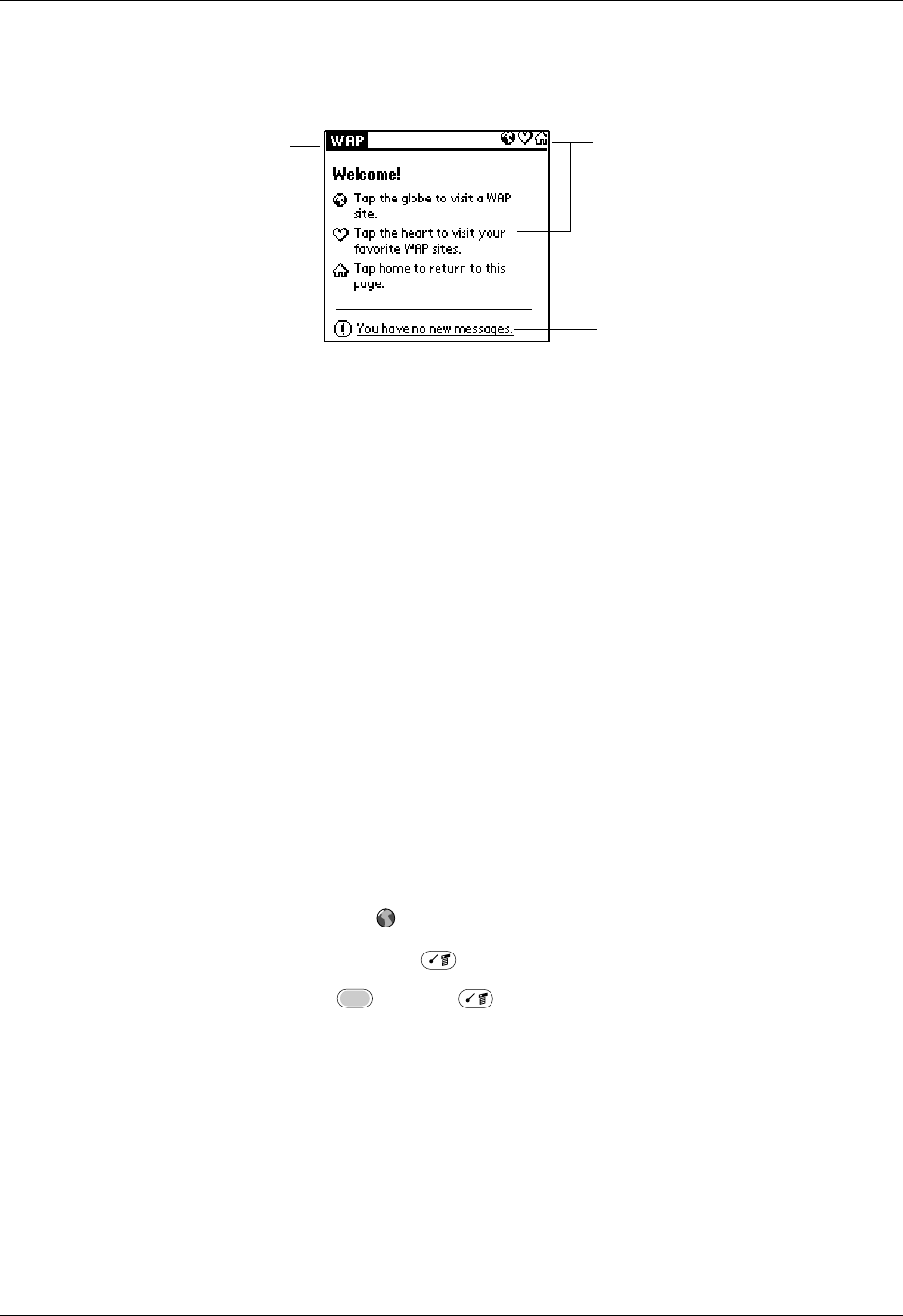
Chapter 18 Using Palm™ WAP Browser
254
NOTE The appearance of the Welcome screen may differ depending on the
wireless service provider you are using.
Opening a WAP site
Palm WAP Browser allows you to open WAP sites on the Internet. WAP sites are
formatted using WML (Wireless Markup Language). These WAP site addresses
(URLs) usually begin with wap–for example, wap.palm.com. Some WML sites also
use www.
NOTE Palm WAP Browser does not open the same web sites as a standard web
browser. Standard web sites are formatted using HTML (Hypertext Markup
Language), and the URLs usually begin with www–for example, www.palm.com.
To open a WAP site, do one of the following:
■Enter a URL.
■Select a URL from the history list.
■Select a bookmark (see “Using bookmarks” later in this chapter).
To open a WAP site by entering a URL:
1. Open the Open URL dialog box by doing one of the following:
– Tap the Globe icon in the upper-right corner.
– Press Command Stroke + O.
– Press Function + Menu , and then select Open URL on the Go menu.
2. Enter the URL.
Indicates status of Push
Inbox. Tap to go to Push
Inbox.
Tap to access
menu items.
Tap icons to access
functions.
Palm, Inc. Confidential
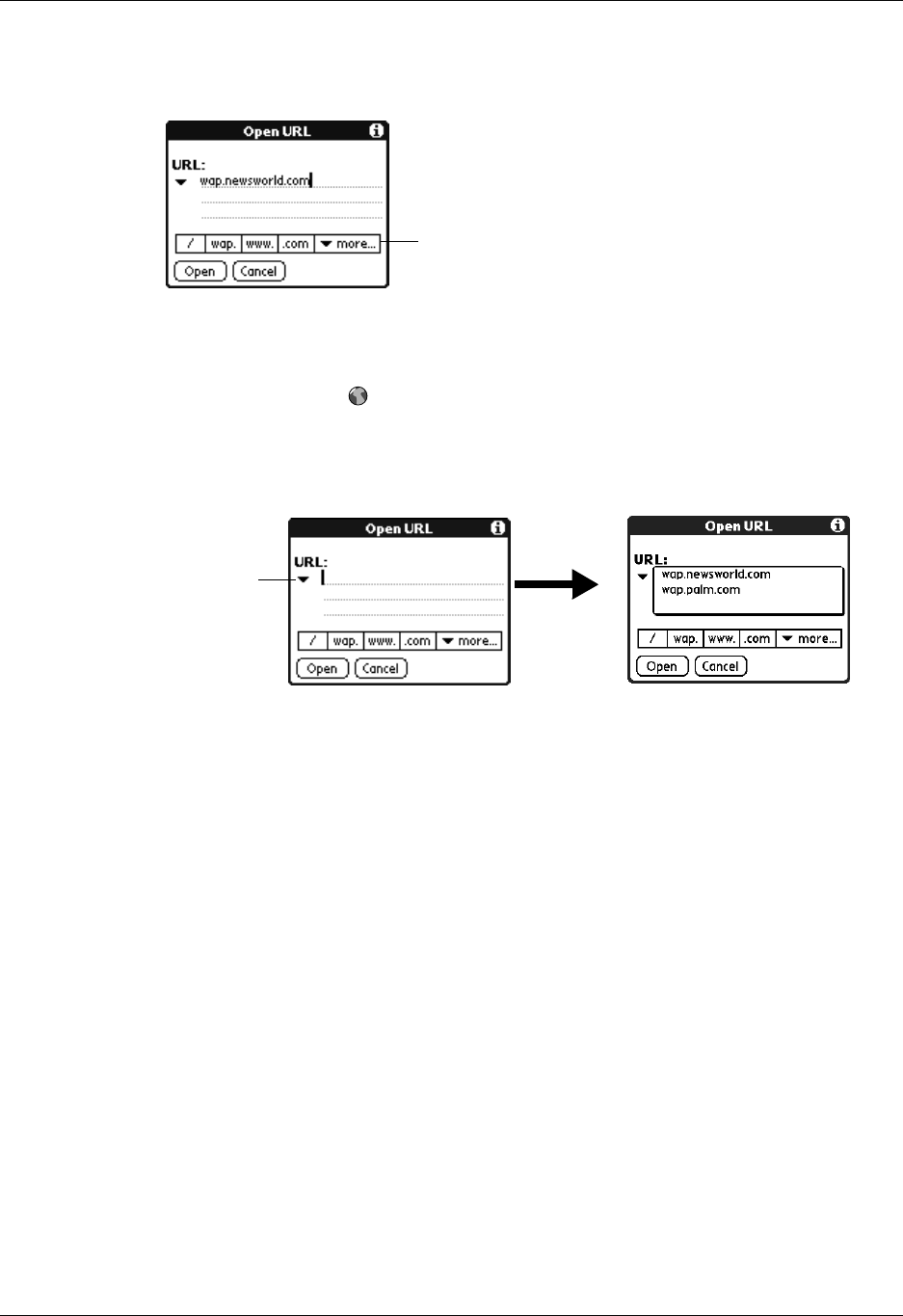
Browsing a WAP site
255
Enter characters using the keyboard, or by tapping an item to insert common
URL elements.
3. Tap Open.
To open a WAP site from the history list:
1. Tap the Globe icon .
2. Tap the pick list arrow.
The most recently visited WAP site URLs are listed.
3. Select a URL from the history pick list and tap Open.
Browsing a WAP site
Browsing a WAP site using Palm WAP Browser is similar to using a standard
Internet browser. The browsing area displays the WAP site with text and
underlined hyperlinks that can be accessed by tapping the link. The title bar
displays information such as the name of the WAP site and navigation icons.
When a WAP page is being downloaded, the title bar displays the following:
■Status
Connecting: Indicates the handheld is connecting to the WAP gateway.
Sending: Indicates the Palm WAP Browser is sending a request to a WAP site to
download a page.
Receiving: Indicates the Palm WAP Browser is receiving content from the WAP
gateway.
■Stop icon: Tapping the Stop icon halts the download, and only areas of the page
that were downloaded are displayed.
Tap item to insert common URL elements
Tap pick list
arrow
Palm, Inc. Confidential
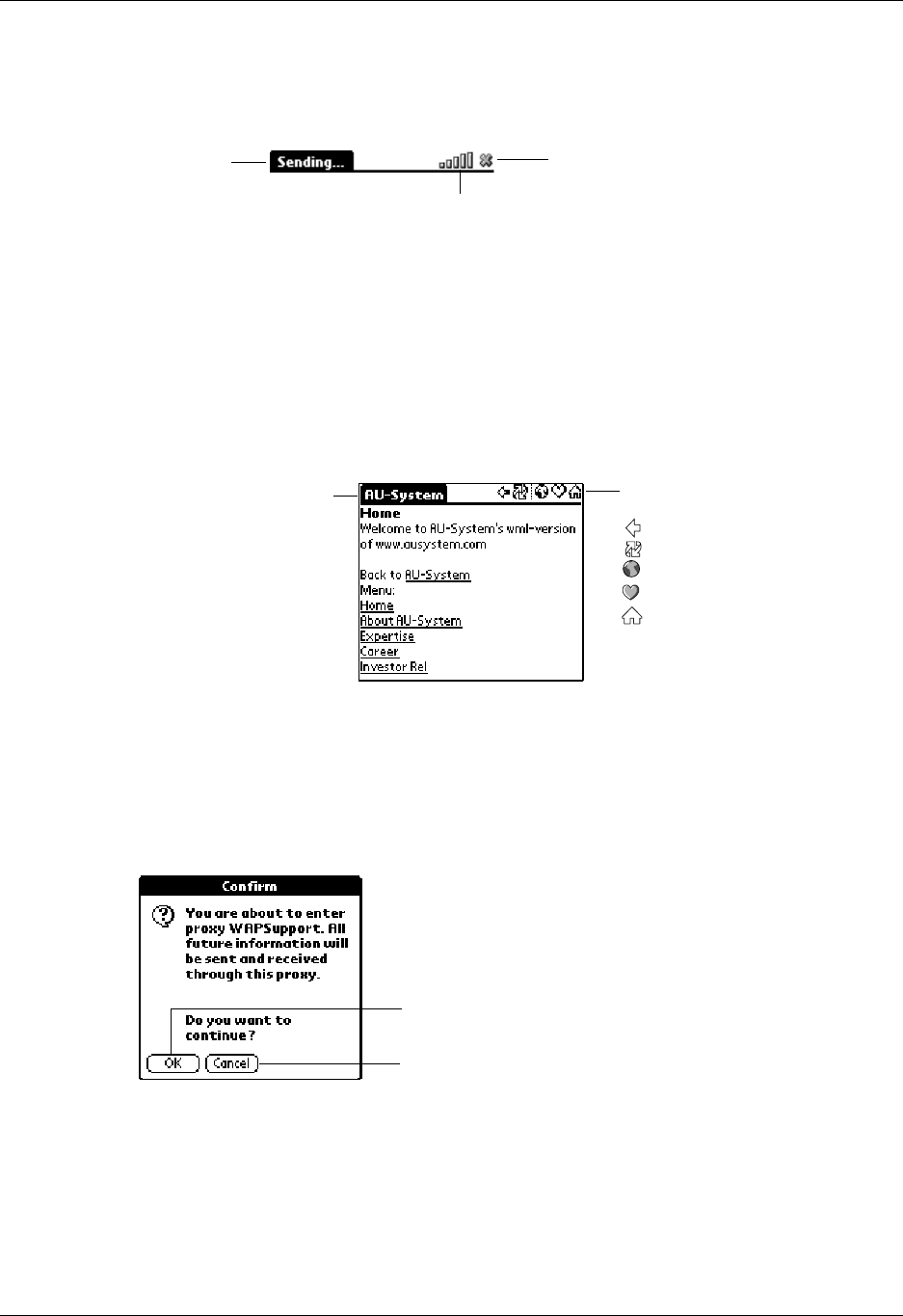
Chapter 18 Using Palm™ WAP Browser
256
■Signal strength indicator: Shows the signal strength of the connection. If the
signal strength indicator shows only one or two bars, the download could take
longer or fail. Move to an area where you have a strong signal.
When the WAP site is fully downloaded on the handheld, the title bar changes to
display the name of the WAP site and the following navigation icons:
■Back: Returns to the previous page.
■Reload: Downloads current page from the source. If you are using cache
memory, the current page that is saved in cache memory is not used.
■Open URL, Bookmarks, and Home: Provide the same function as on the
Welcome screen (see “Opening Palm WAP Browser” earlier in this chapter).
Browsing secure WAP sites
When you access certain secure WAP sites, such as a bank, you are temporarily
transferred to a secure gateway. Whenever you are transferred to a secure
gateway, you are informed of the change and asked for permission.
Once you have finished with the secure site, the Palm WAP Browser will
automatically changes back to the default WAP gateway.
Status
Signal strength indicator
Tap Stop icon to halt download
Title indicates name
of WAP site.
Navigation icons:
Back
Reload
Open URL
Bookmarks
Home
Tap OK to change to another gateway
Tap Cancel to deny permission to change to
another gateway
Palm, Inc. Confidential
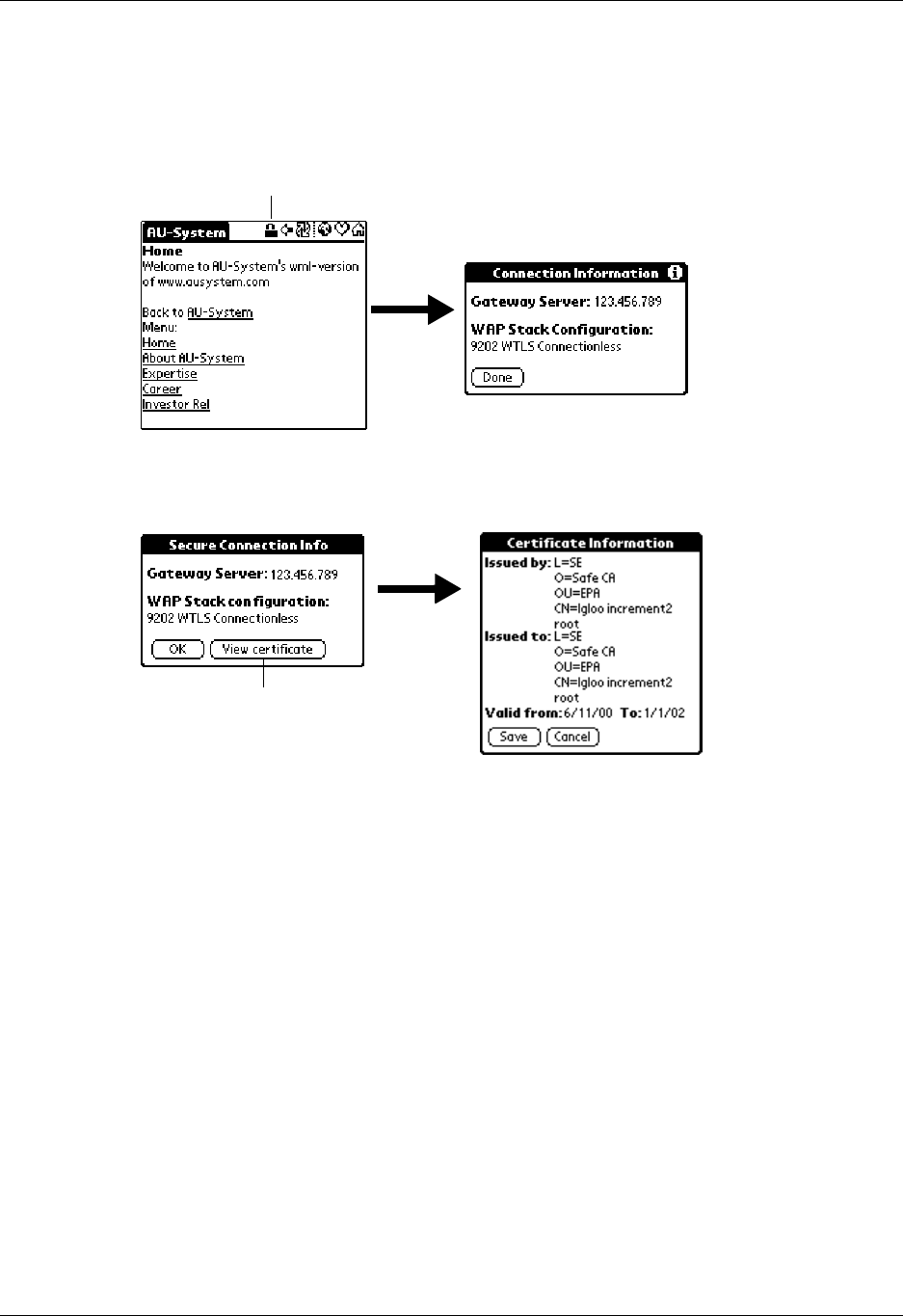
Using bookmarks
257
If the Palm WAP Browser is connected to a gateway using the optional security
layer WTLS, a small padlock is displayed in the title area. Tapping the Padlock icon
opens the Connection Information dialog box describing the WAP gateway
address and WAP stack configuration.
If you have a secure connection using a WAP gateway server certificate, tapping
the View certificate button displays certificate information.
Using bookmarks
Bookmarks allow you to manage a list of your favorite WAP sites. You can easily
access your bookmarks by tapping the Bookmark icon in the title bar.
Tap Padlock icon
Tap View certificate
Palm, Inc. Confidential
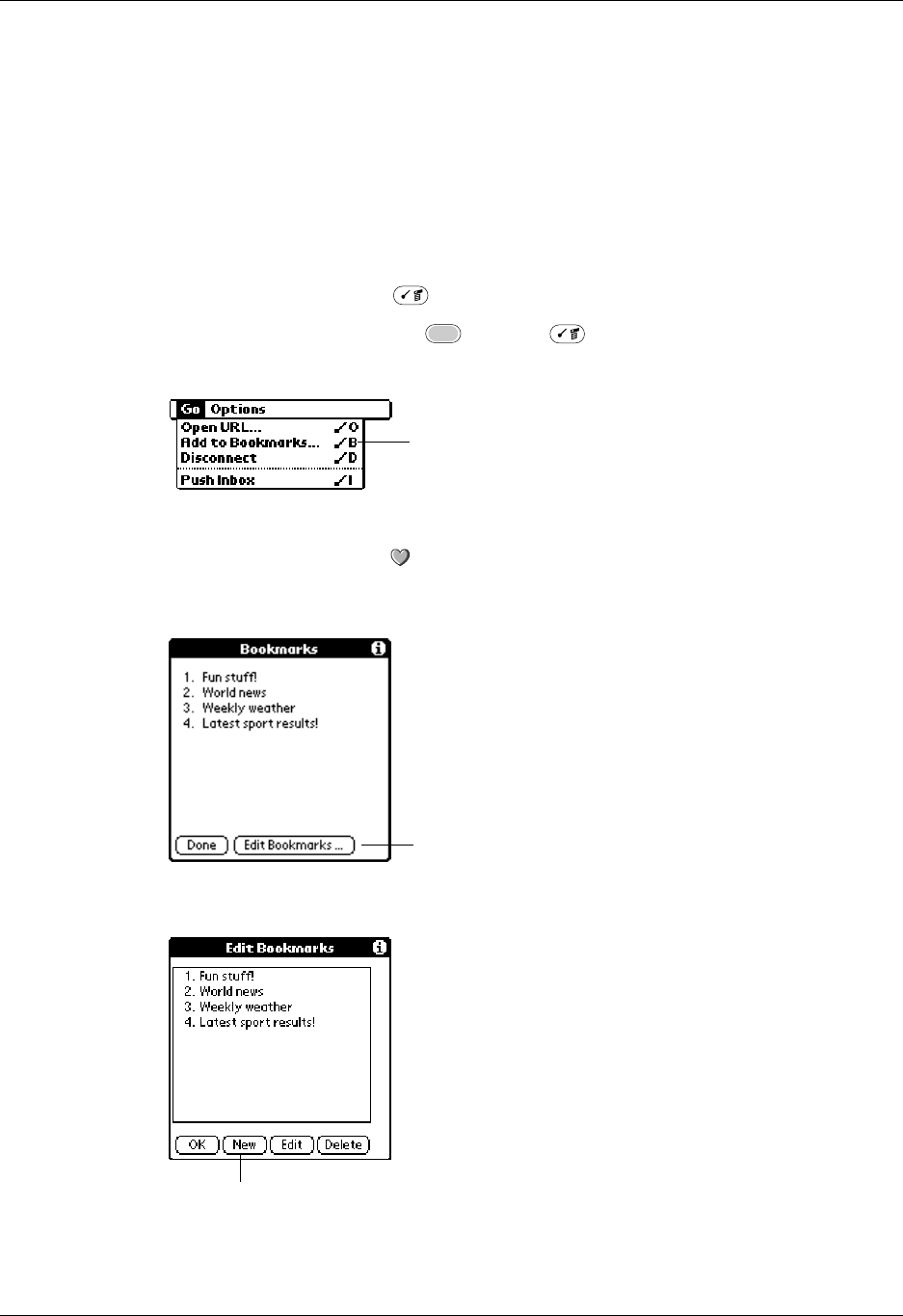
Chapter 18 Using Palm™ WAP Browser
258
Adding a bookmark
You can add a WAP site to the Bookmarks list in two ways:
■Add the current WAP page using the Go menu.
■Enter the information in the Edit Bookmarks dialog box.
To bookmark the current WAP page:
1. Open the WAP site.
2. Press Command Stroke + B.
Alternately, press Function + Menu , and then select Add to
Bookmarks on the Go Menu.
To enter a bookmark from the Edit Bookmarks dialog box:
1. Tap the Bookmark icon .
2. Tap Edit Bookmarks.
3. Tap New.
Tap to add the current
WAP page to Bookmarks
Tap Edit Bookmarks
Ta p N e w
Palm, Inc. Confidential
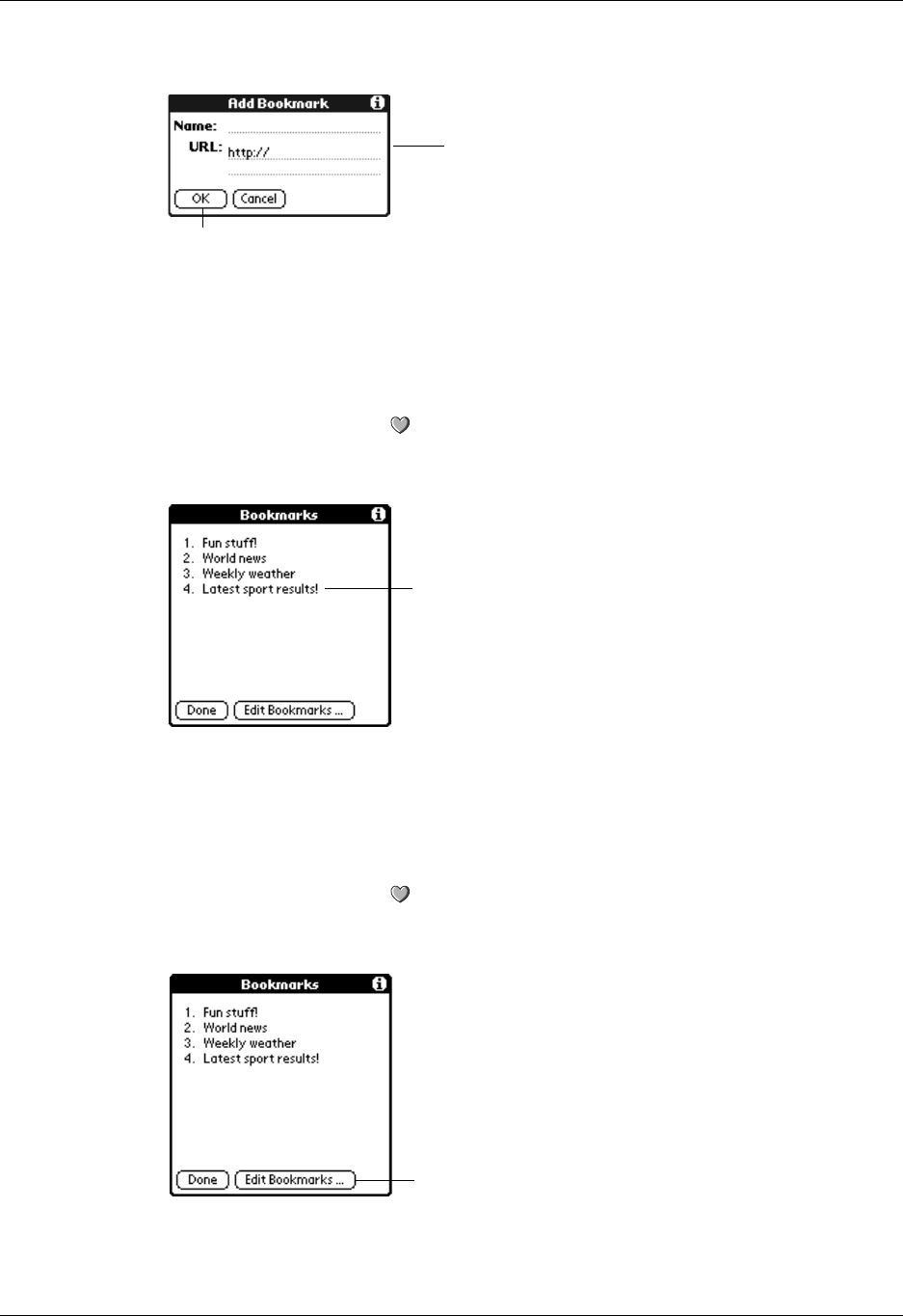
Using bookmarks
259
4. Enter the bookmark name and URL, and then tap Done.
Visiting a bookmarked WAP site
By tapping a bookmark on the Bookmarks list, you can quickly open the WAP site.
To open a WAP site from the Bookmarks dialog box:
1. Tap the Bookmark icon .
2. Tap a bookmark to begin downloading the WAP page.
Editing a bookmark
You can edit an existing bookmark using the Edit Bookmarks dialog box.
To edit a bookmark:
1. Tap the Bookmark icon .
2. Tap Edit Bookmarks.
Tap Done
Enter Bookmark
name and URL
Tap a bookmark
Tap Edit Bookmarks
Palm, Inc. Confidential
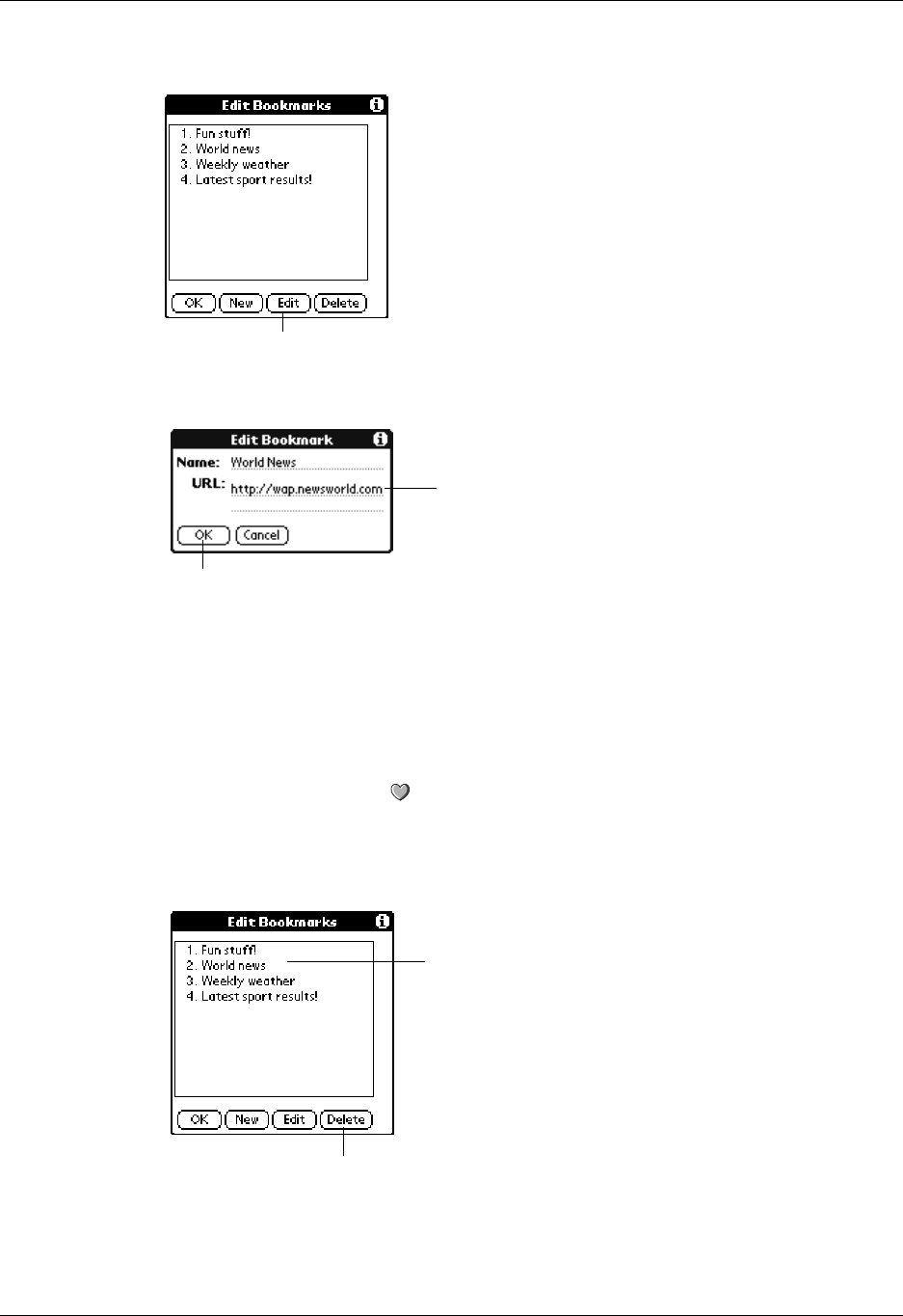
Chapter 18 Using Palm™ WAP Browser
260
3. Select a bookmark, and then tap Edit.
4. Edit the bookmark name and URL, and then tap OK.
Deleting a bookmark
You can delete sites from your bookmarks list using the Edit Bookmarks dialog
box.
To delete a bookmark:
1. Tap the Bookmark icon .
2. Tap Edit Bookmarks.
3. Tap the bookmark you want to delete.
4. Tap Delete.
5. In the Confirmation dialog box, tap OK.
Tap Edit
Edit the bookmark
name and URL
Ta p O K
Tap bookmark
Ta p De l e t e
Palm, Inc. Confidential
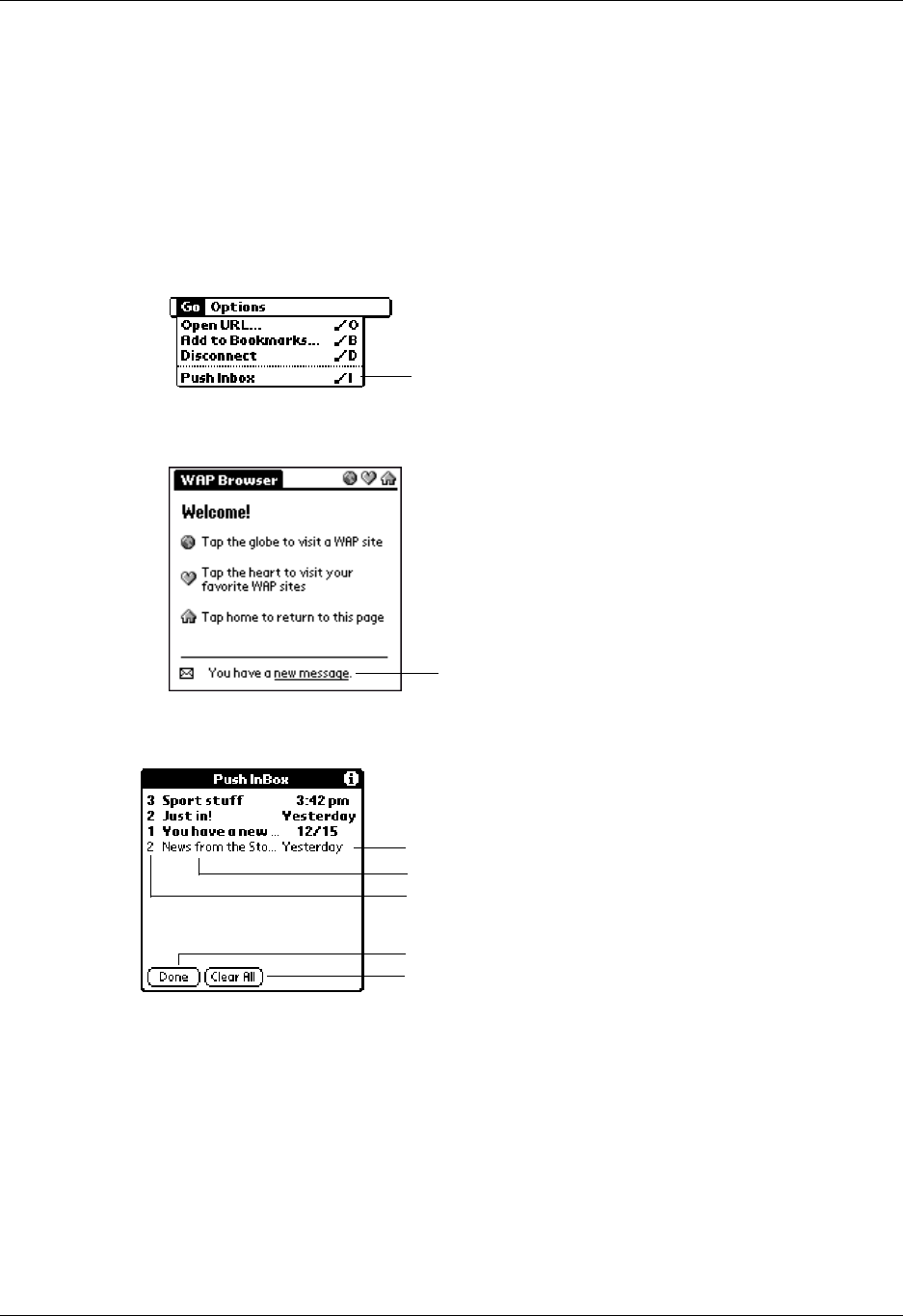
Using your Push Inbox
261
Using your Push Inbox
The Push Inbox lists all WAP Push messages received or stored by the handheld.
Push messages are sent from services that you sign up for–for example,
notifications of new e-mails, changes in stock prices, and so on. The service must
support WAP Push.
You can open the Push Inbox in the following two ways:
■Tap Push Inbox from the Go menu.
■Tap the new message line on the Welcome screen.
Unread messages are displayed in bold font.
The Push Inbox list has the following three columns:
■Priority of the message
–1 - High
–2 - Medium
–3 - Low
■Extract from the message
Tap to go to Push Inbox
Tap to go to Push Inbox
Time of arrival
Extract from the messages
Priority of the message
Tap Done to close the Push Inbox
Tap Clear All to delete all messages
Palm, Inc. Confidential
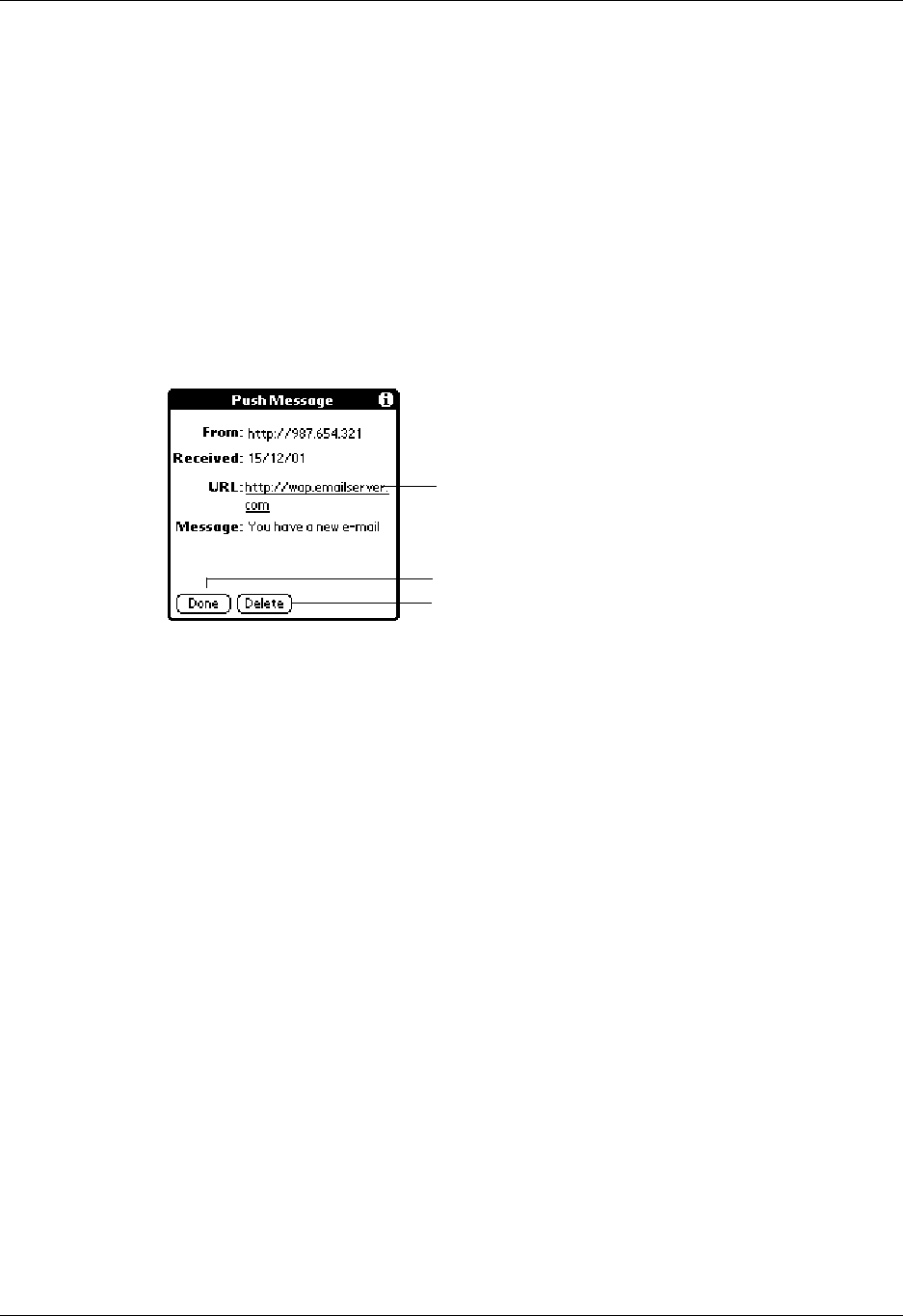
Chapter 18 Using Palm™ WAP Browser
262
■Time of arrival: The time of arrival is set differently depending on when the
message was received. If it was received today, the time of arrival is shown. If
received yesterday, the text Yesterday is displayed. If received earlier than
yesterday, the date of arrival is displayed.
Tapping a message opens the Push Message dialog box, showing all available
information about the message. This dialog box displays the following:
■From: Where the message came from
■Received: Date and time the message was received
■URL: The URL associated with the message
■Message: The content of the message
Using advanced features
Palm WAP Browser has many advanced features that allow you to modify
performance and set security features. These options affect the performance of
your browser and should be set by knowledgeable users. You may want to consult
with technical support from your wireless service provider before changing some
of these options.
Changing gateways
When you connect to the Internet, you normally connect through the default WAP
gateway. Gateways are servers used to access WAP sites.
NOTE Generally, the gateway is automatically set by your wireless service provider
and it may be hidden or locked. Changing this setting can disable your Palm WAP
Browser’s ability to access sites, so please exercise caution if you alter this setting.
Tap address to open WAP site
Tap Done to close and save message
Tap Delete to delete message
Palm, Inc. Confidential
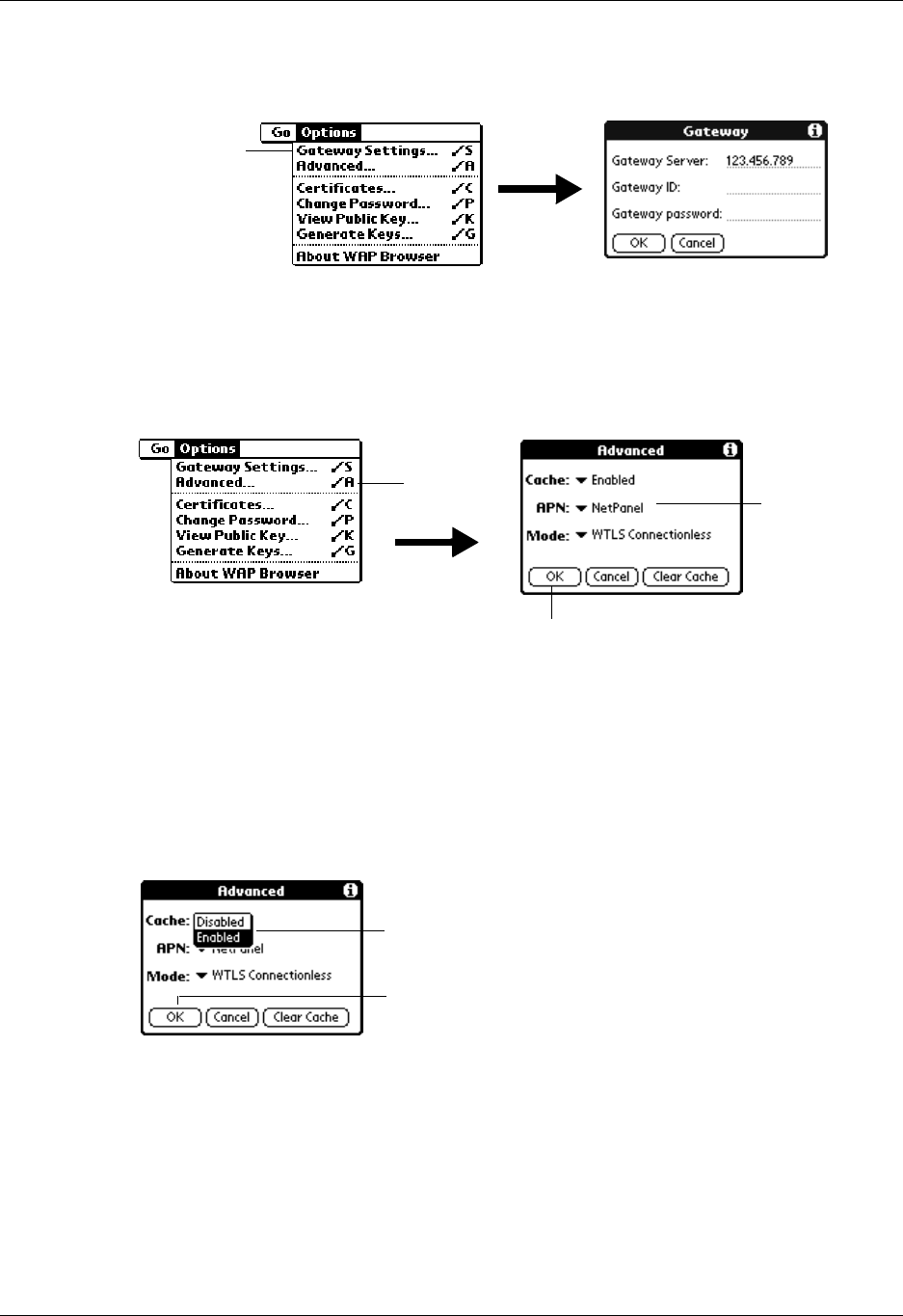
Setting advanced options
263
You can check or change the gateway settings from the Gateway dialog box. To
access the Gateway dialog box, tap Gateway Settings on the Options menu.
Setting advanced options
The Advanced dialog box allows you to enable or disable the cache functions,
select an access point name, and select a mode.
Using cache memory
The Cache pick list on the Advanced dialog box allows you to enable or disable the
cache memory. The default setting is cache memory enabled. Cache memory stores
and displays a previously loaded WAP page rather than reloading the page each
time. This enables you to save time in viewing pages, but you might view an older
saved page rather than an updated one.
Ta p Ga t e wa y
Settings
Ta p
Advanced Ta p a rr o w
to make a
selection
Tap OK to implement change
Tap the Cache arrow and select Enabled or
Disabled
Tap OK to accept change
Palm, Inc. Confidential
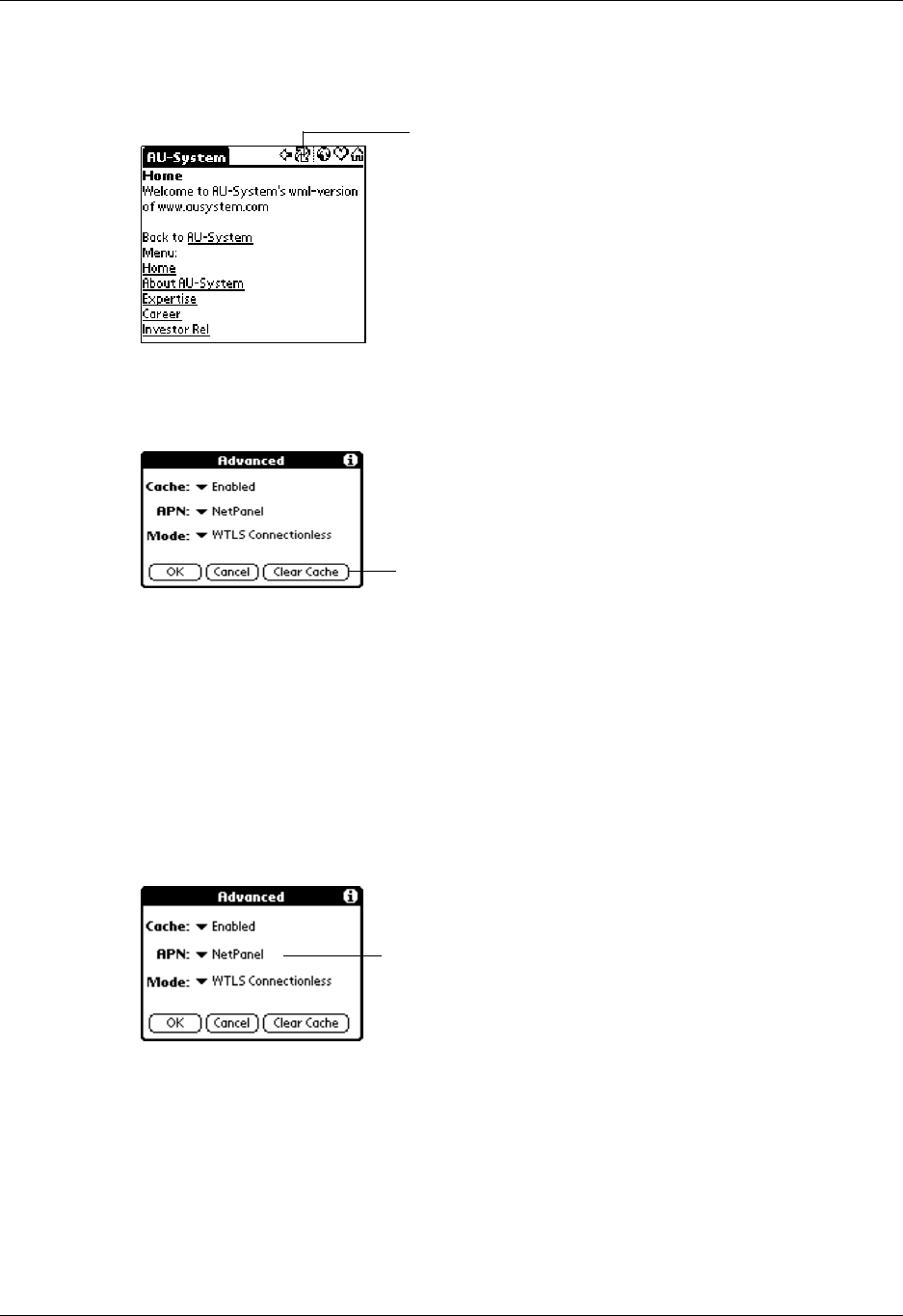
Chapter 18 Using Palm™ WAP Browser
264
When viewing a page, you can update the current page by tapping the Reload icon.
A new page is downloaded from the WAP site.
You can also clear cache memory so that all stored pages are deleted by tapping
the Clear Cache button on the Advanced dialog box.
Selecting an Access Point Name
The APN pick list on the Advanced dialog box allows you to select an Access Point
Name (APN) from a preset number of alternatives. The selections available in the
APN list are dependent on your wireless service provider. The APN may be preset
or configured automatically by your wireless service provider.
NOTE Changing the APN can disrupt your access to the Internet. Contact your
wireless service provider for more information.
Tap the Reload icon to
download a new current page
Tap Clear Cache to clear all pages
stored in cache memory
Tap APN arrow to set APN
Palm, Inc. Confidential

Setting advanced options
265
Selecting Mode
NOTE Changing the mode can disrupt your access to the Internet. The mode should
not be changed unless you receive specific instructions from your wireless service
provider.
The Mode pick list on the Advanced dialog box allows you to set the WAP stack
configuration. There are two standard modes and two secure modes:
Standard modes
■Connectionless (CL-WSP: Connectionless - Wireless Session Protocol)
■Connection Oriented (CO-WSP: Connection Oriented - Wireless Session
Protocol)
Secure modes
■WTLS Connectionless (CL-WTLS-WSP: Connectionless - Wireless Transport
Layer Security - Wireless Session Protocol)
■WTLS Conn. Oriented (CO-WTLS-WSP: Connection Oriented - Wireless
Transport Layer Security - Wireless Session Protocol)
Each mode has a port number associated with it:
■Connectionless - 9200
■Connection Oriented - 9201
■WTLS Connectionless - 9202
■WTLS Conn. Oriented - 9203
Once the WAP stack configuration for a WAP gateway is set, this parameter
should not be changed unless you want to use another WAP gateway (see “Using
the security features” earlier in this chapter).
Tap Mode arrow and select mode
Tap OK to accept change
Palm, Inc. Confidential

Chapter 18 Using Palm™ WAP Browser
266
Using the security features
The Palm WAP Browser uses the Public Key Infrastructure (PKI) method to
exchange secure messages between you and another party. PKI is based on the use
of a password key pair and a signature key pair. Each key pair has one public key
and one signed key. The public key can be available to anyone, but you must store
the signed key securely. All security of a PKI solution is based on the integrity of
the signed key.
The public key is exchanged between you and another party using a certificate
created and signed by a trusted Certificate Authority (CA). (The process of creating
certificates and using a CA is beyond the scope of this chapter.) You can use the
same key pair for several certificates.
All certificates are stored in the WAP Identity Module (WIM). The WIM is a
storage area designed to store certificates, your private keys, and secure session
data used to establish a secure connection. Usually the WIM is a smart card. Palm
WAP Browser uses a software WIM that has the same functionality.
Palm WAP Browser uses the following two protective passwords:
■Password: Protects the password key pair. This password also protects the WIM
and must be entered every time you access any content in the WIM.
■Signature: Protects the signature key pair. This signature is used only when you
are asked to verify that you accept something asked for by another, such as a
bank transfer.
Palm WAP Browser allows you to create multiple password and signature key
pairs. Each type of key pair is protected by a password or signature that you create.
You have only one password and one signature even if you have multiple key
pairs. You can change the password and signature at any time.
Creating password and signature key pairs
To protect your transactions, you need to create a password key pair. If you are
signing documents, you will also need to create a signature key pair.
IMPORTANT Key generation can take up to an hour. During this time, your handheld
appears to be completely frozen and you are not able to use your handheld.
You can create a password and signature key pair by opening the Generate Keys
dialog box from the Options menu. You select which kind of key pair you want to
generate: password or signature.
If this is the first time that you have generated the selected type of key pair, you
must enter a password or signature to protect access to and usage of the keys. If
you have already generated this type of key pair, you must enter the
corresponding password or signature to continue the key generation.
Palm, Inc. Confidential
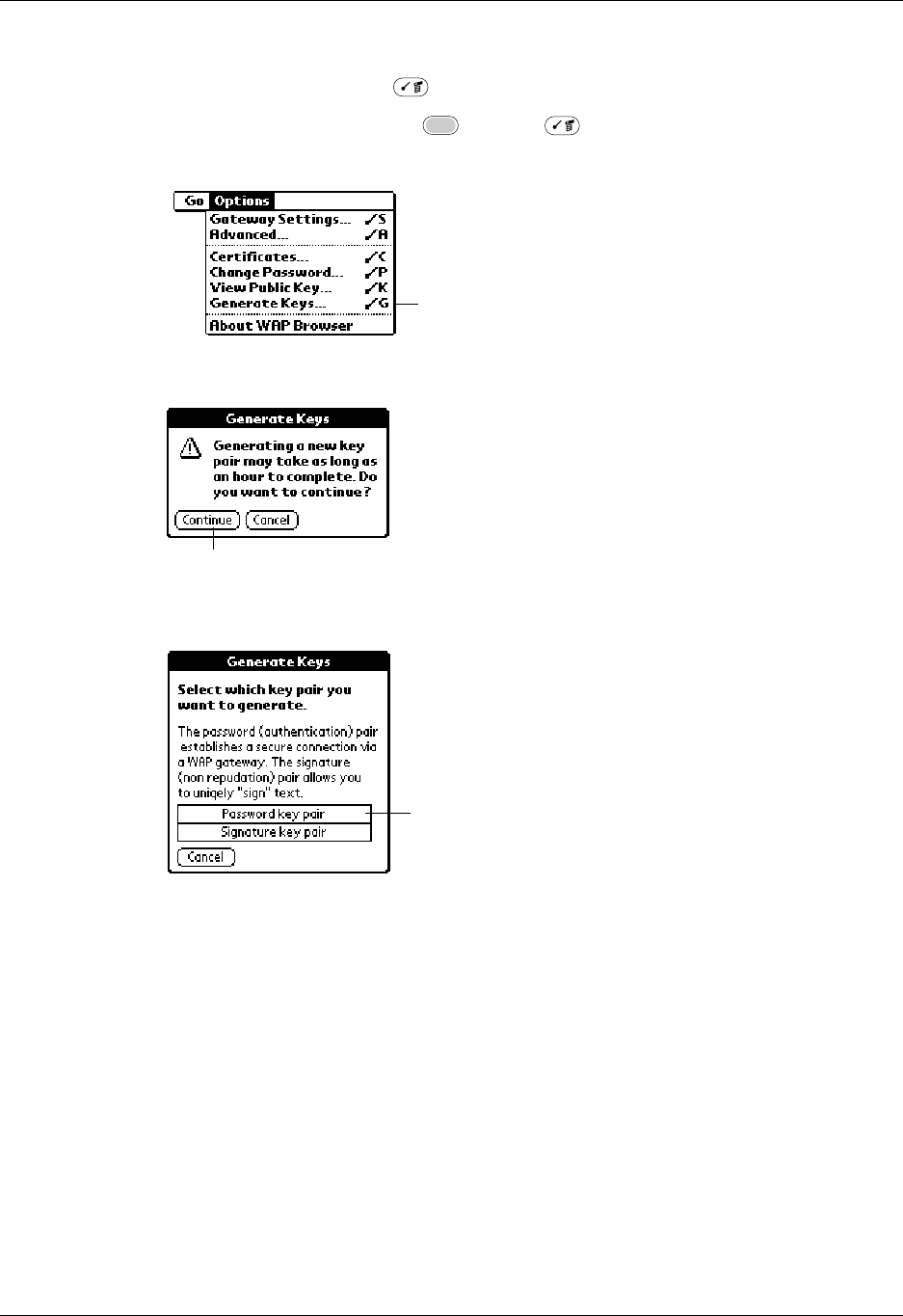
Using the security features
267
To create a password key pair:
1. Press Command Stroke + G.
Alternately, press Function + Menu , and then select Generate Keys on
the Options menu.
2. Tap Co ntinue.
3. Tap Password key pair.
4. Enter your password twice and tap OK.
Tap Generate Keys
Tap Continue
Tap Password key pair
Palm, Inc. Confidential
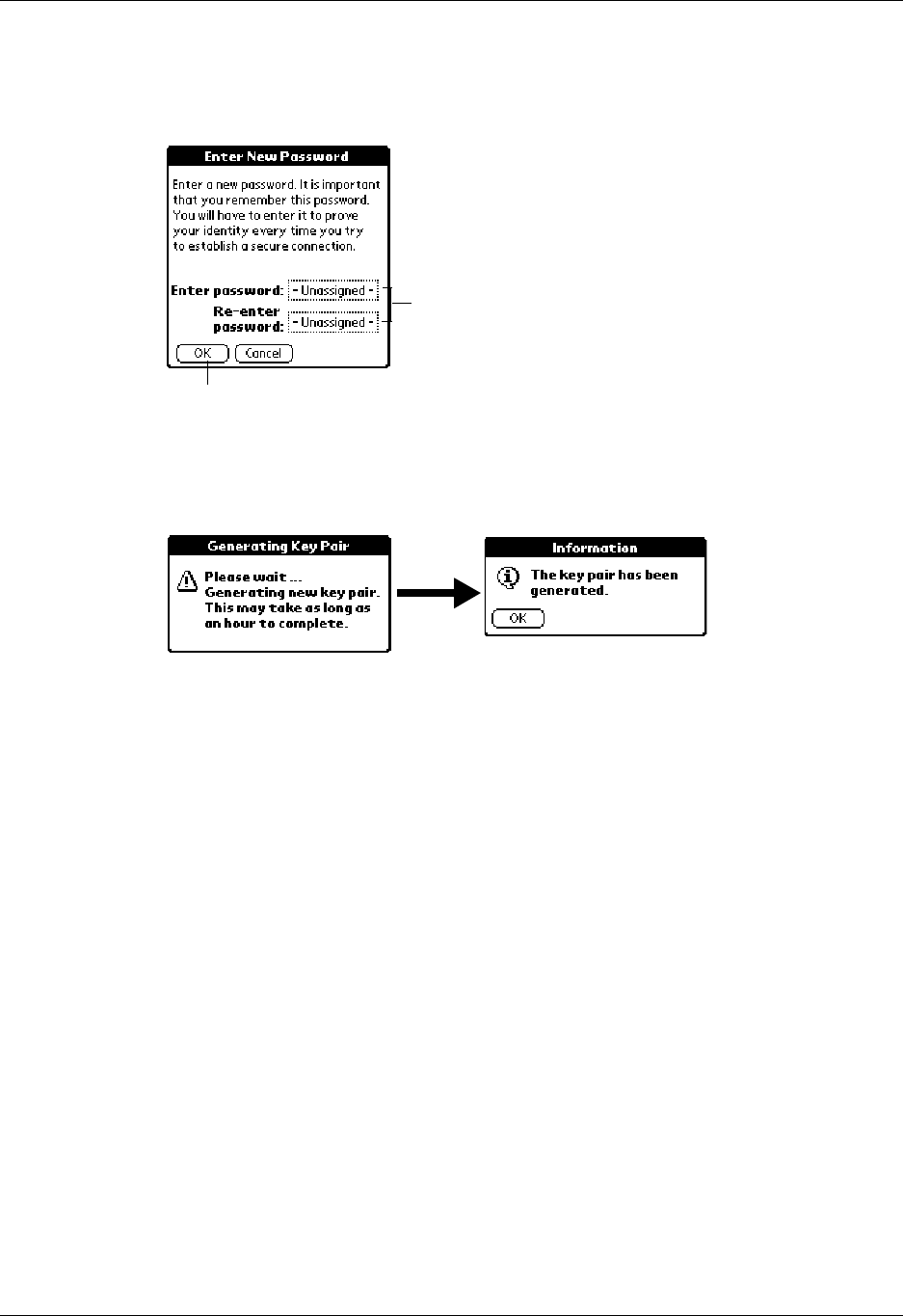
Chapter 18 Using Palm™ WAP Browser
268
If you have already created a password key pair, enter the password you have
already created. You can use any characters to set the password or signature–
for example, small and capital letters, numbers, or symbols.
A Generating Key Pair dialog box appears, informing you that it may take an
hour to generate the key pair. When the key pair has been generated, a
confirmation dialog box appears.
5. Tap OK .
NOTE Generating a password key pair and generating a signature key pair are
similar. To generate a signature key pair, follow the steps for creating a password key
pair, and select Signature key pair in step 4.
Changing your password or signature
Maintaining a secure password and signature is critical for the security of your
transactions. You can change your password or signature regularly to maintain
security.
Enter password twice
Ta p O K
Palm, Inc. Confidential
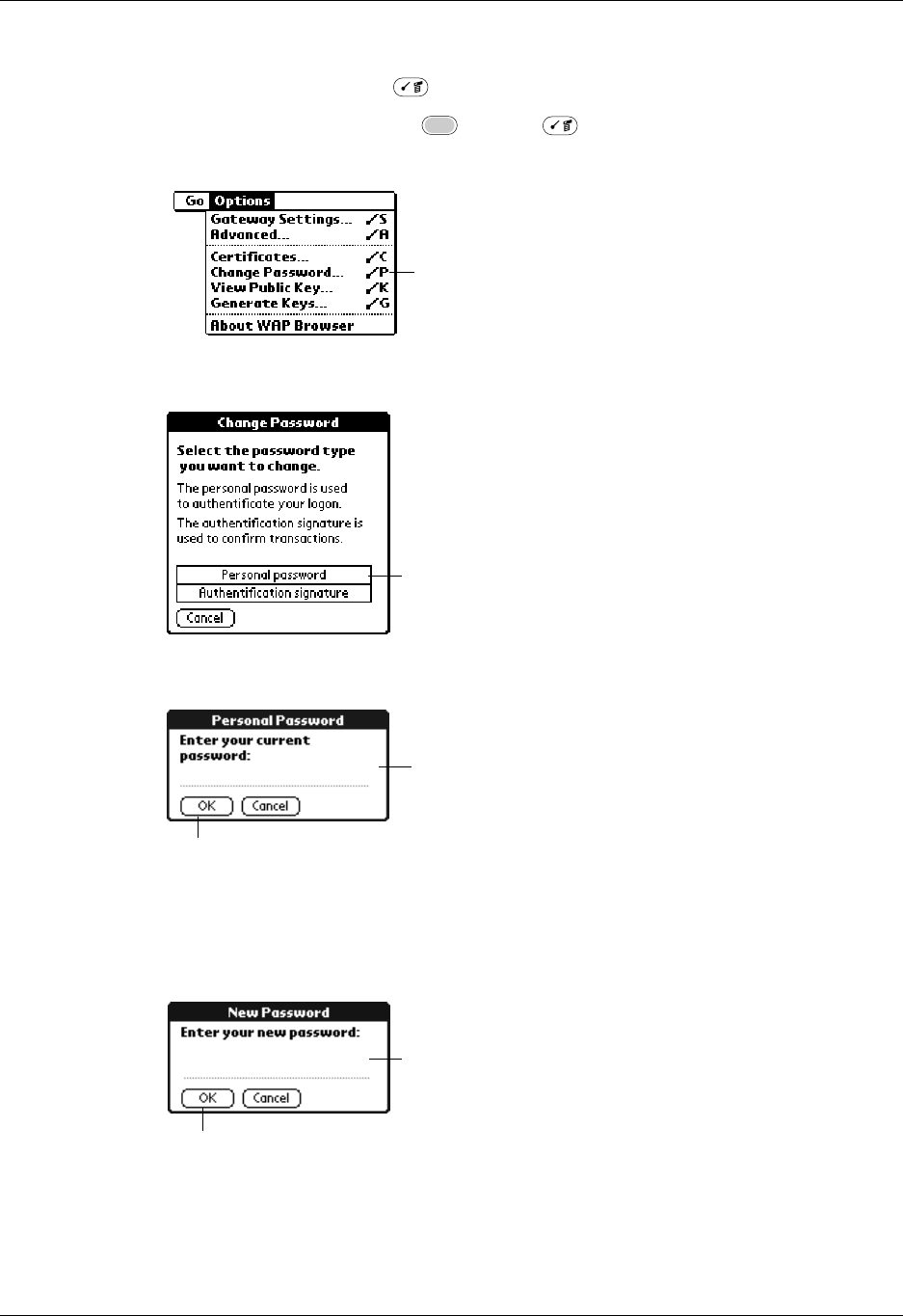
Using the security features
269
To change your password:
1. Press Command Stroke + P.
Alternately, press Function + Menu , and then select Change Password
on the Options menu.
2. Tap Personal password.
3. Enter your current password, and then tap OK.
4. Enter the new password, and then tap OK.
You can use any characters to set the password or signature–for example, small
and capital letters, numbers, or symbols.
Tap Change Password
Tap Personal password
Ta p O K
Enter your current
password
Enter your new
password
Ta p O K
Palm, Inc. Confidential
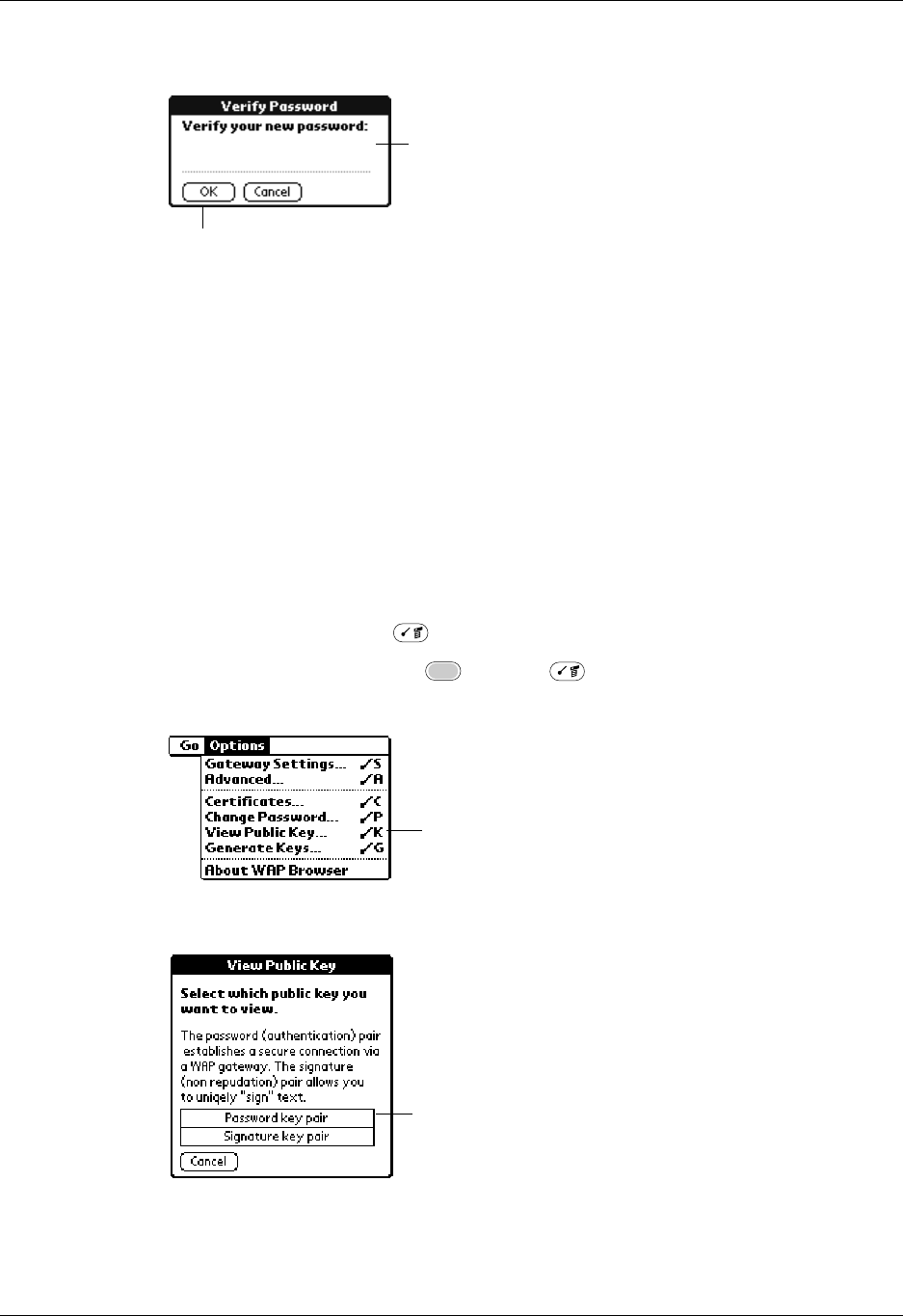
Chapter 18 Using Palm™ WAP Browser
270
5. Verify the new password by entering the password again, and then tap OK.
6. In the Information dialog box, tap OK.
NOTE Changing a password and changing a signature are similar. To change your
signature, follow the steps for changing your password, and select Authentification
signature in step 3.
Viewing the public key and the signed key
Once you create a keyed pair, you can view the public key and signed the key by
opening the View Public Key dialog box from the Options menu. This information
is useful if you need to send a copy of the public key to your CA. The displayed
keys are Base64 coded.
To view your public key and signed key:
1. Press Command Stroke + K.
Alternately, press Function + Menu , and then select View Public Key
on the Options menu.
2. Tap Password key pair.
Enter your new
password
Ta p OK
Tap View Public Key
Tap Password key pair to
view Password public key
Palm, Inc. Confidential
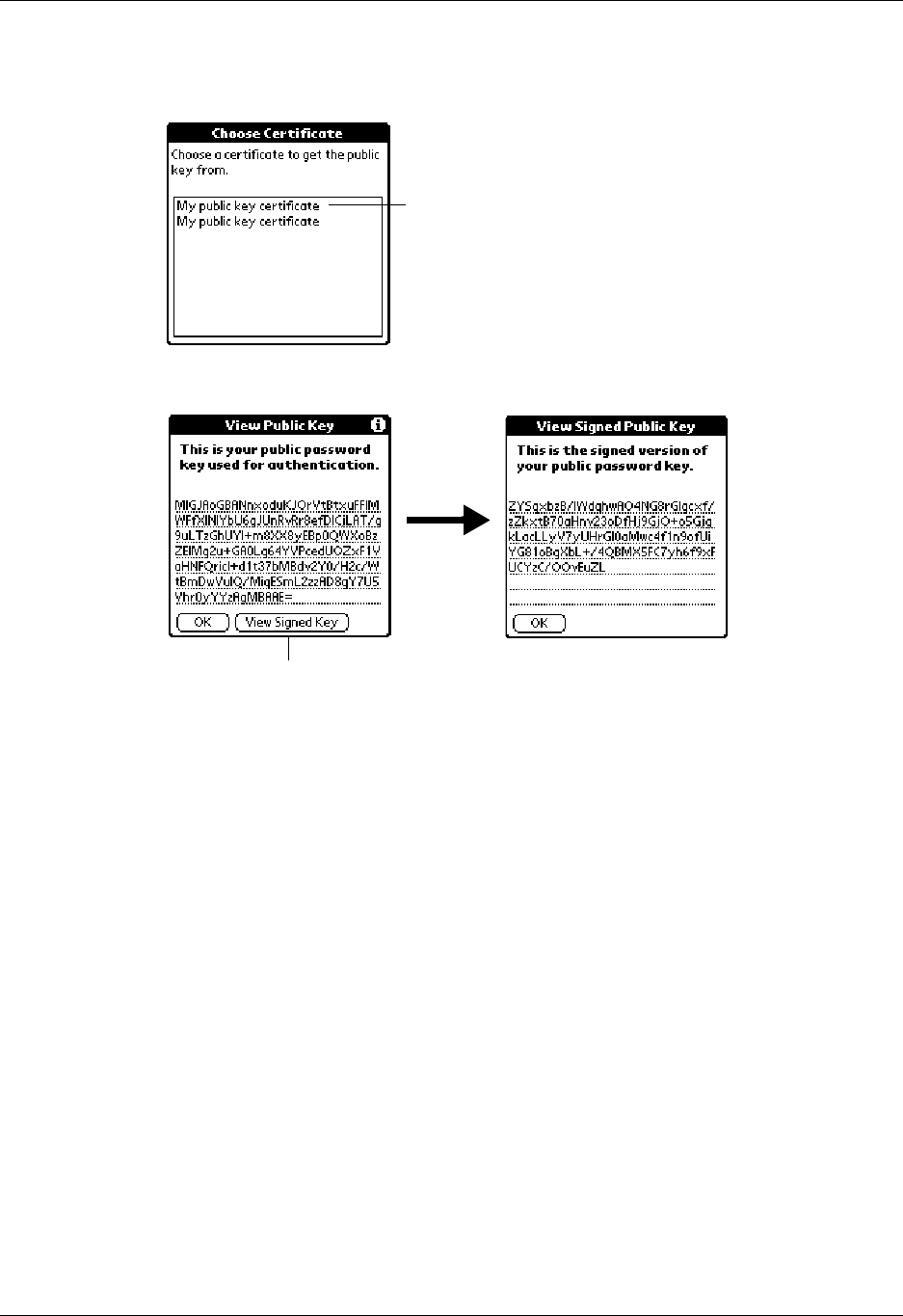
Using the security features
271
3. If you have several key pairs, a list of certificates is displayed and you can tap
the appropriate certificate.
4. Tap View Signed Key to view the signed public key.
5. Tap OK .
NOTE Viewing a password and changing a signature key pair are similar. To view
your signature public key, follow the steps for viewing your password public key, and
select Signature key pair in step 2.
Storing certificates
Palm WAP Browser supports both CA or root certificates and user/server
certificates. Certificates are stored securely in the WIM, where you can view or
delete them.
You can download a certificate from a WAP page by tapping the link to the
certificate. Once the CA has approved your request for a certificate, the certificate
is available for downloading.
Tap certificate
Tap View Signed Key
Palm, Inc. Confidential
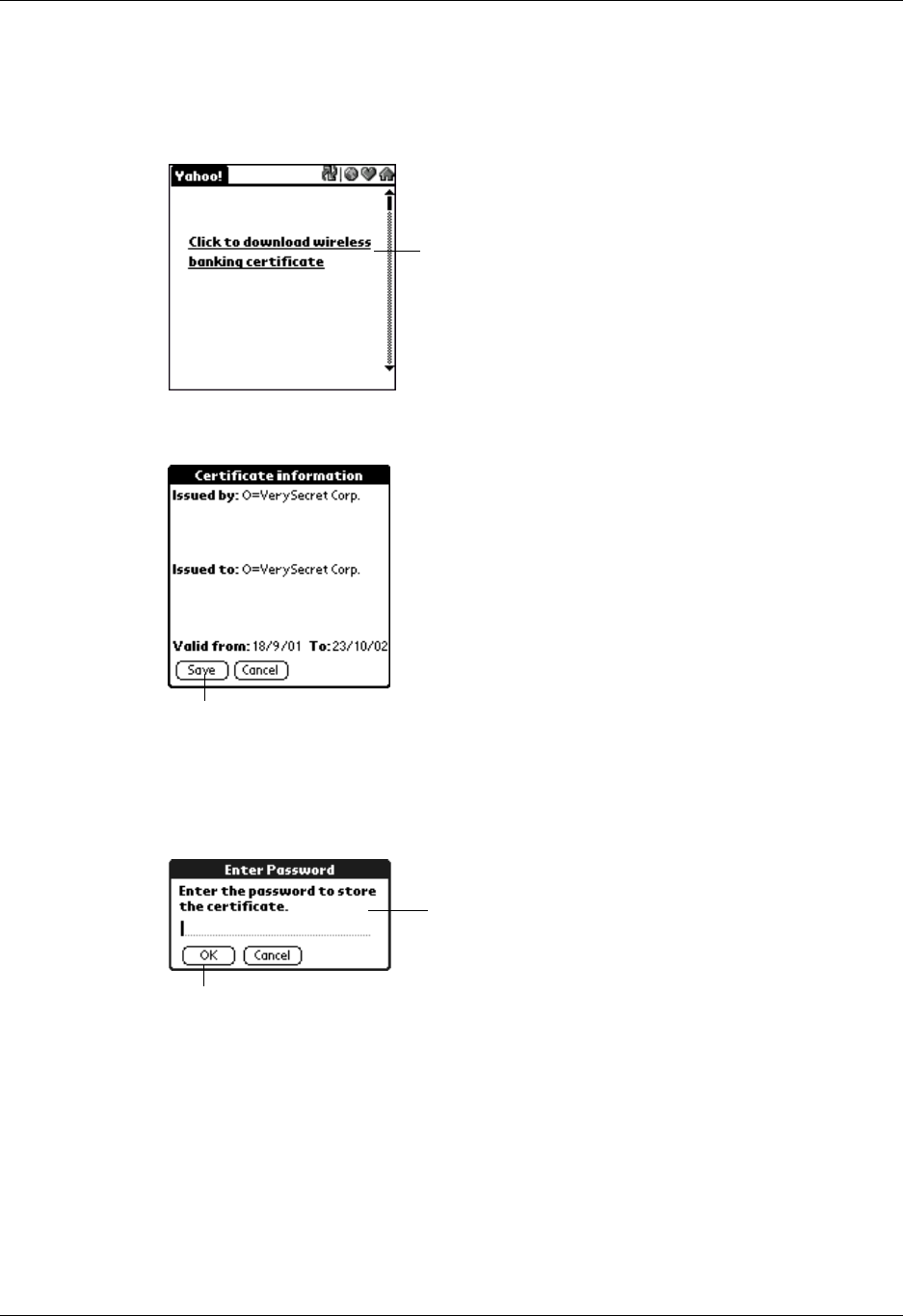
Chapter 18 Using Palm™ WAP Browser
272
To store a certificate:
1. Tap the certificate download link.
The certificate download link varies depending on the WAP site.
2. Tap Save .
3. Enter your password and tap OK.
Your password is the same password that was set when you generated your
Password key pair.
4. If you are storing a user certificate, you can enter a friendly name and tap OK.
Tap link
Ta p S a v e
Enter your
password
Ta p OK
Palm, Inc. Confidential
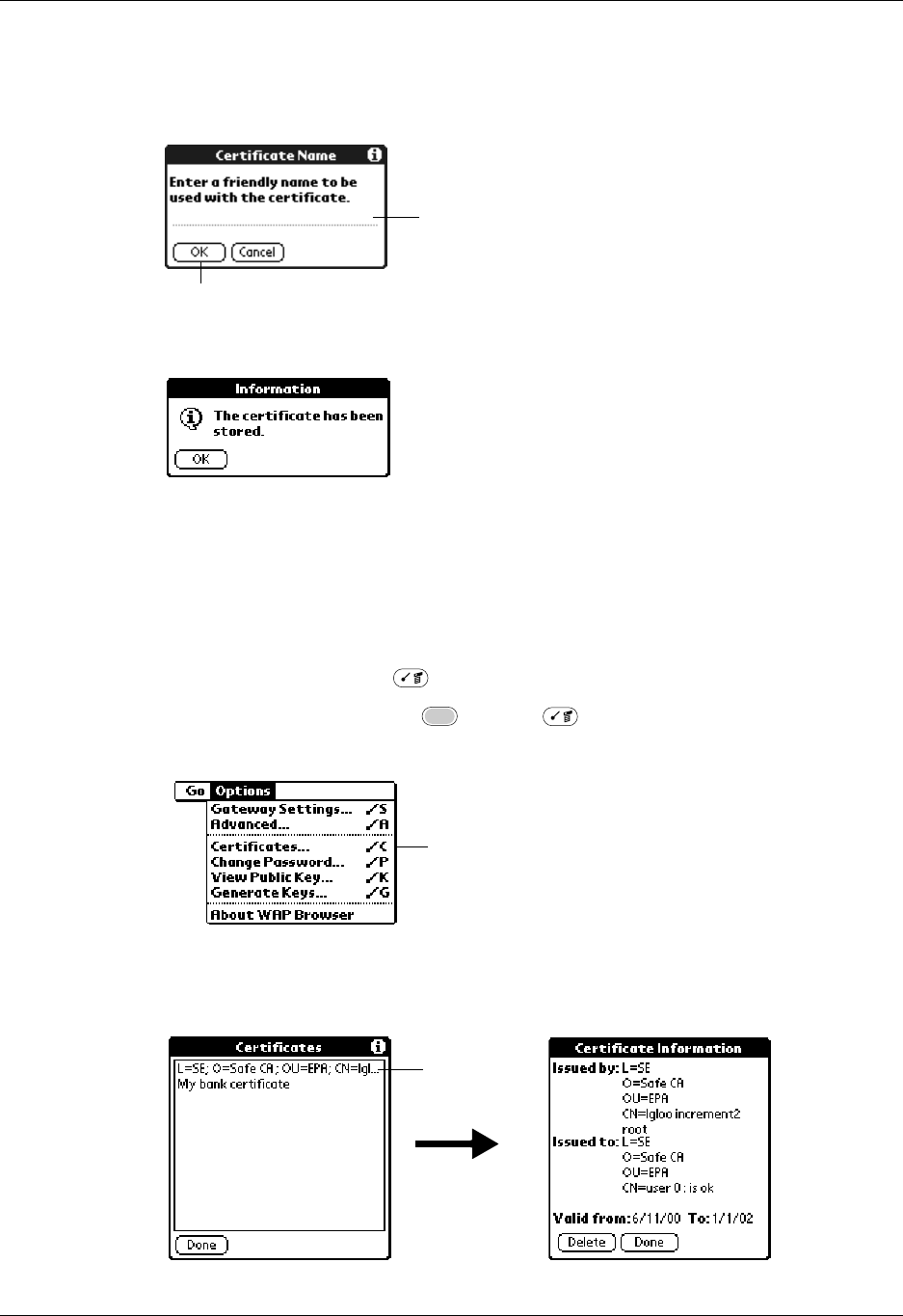
Using the security features
273
The name is used for the certificate list when you are viewing your certificates.
Make the name clear so that you can recognize the certificate. The friendly name
is optional.
5. Tap OK .
Viewing certificates
You can view your stored certificates by opening the Certificates dialog box from
the Options menu.
To view your stored certificates:
1. Press Command Stroke + C.
Alternately, press Function + Menu , and then select Certificates on the
Options menu.
2. Tap the certificate name.
You can delete the certificate by tapping Delete.
Enter an easily recognizable
name for user certificate
Ta p OK
Tap Certificates
Tap on a
certificate
Palm, Inc. Confidential
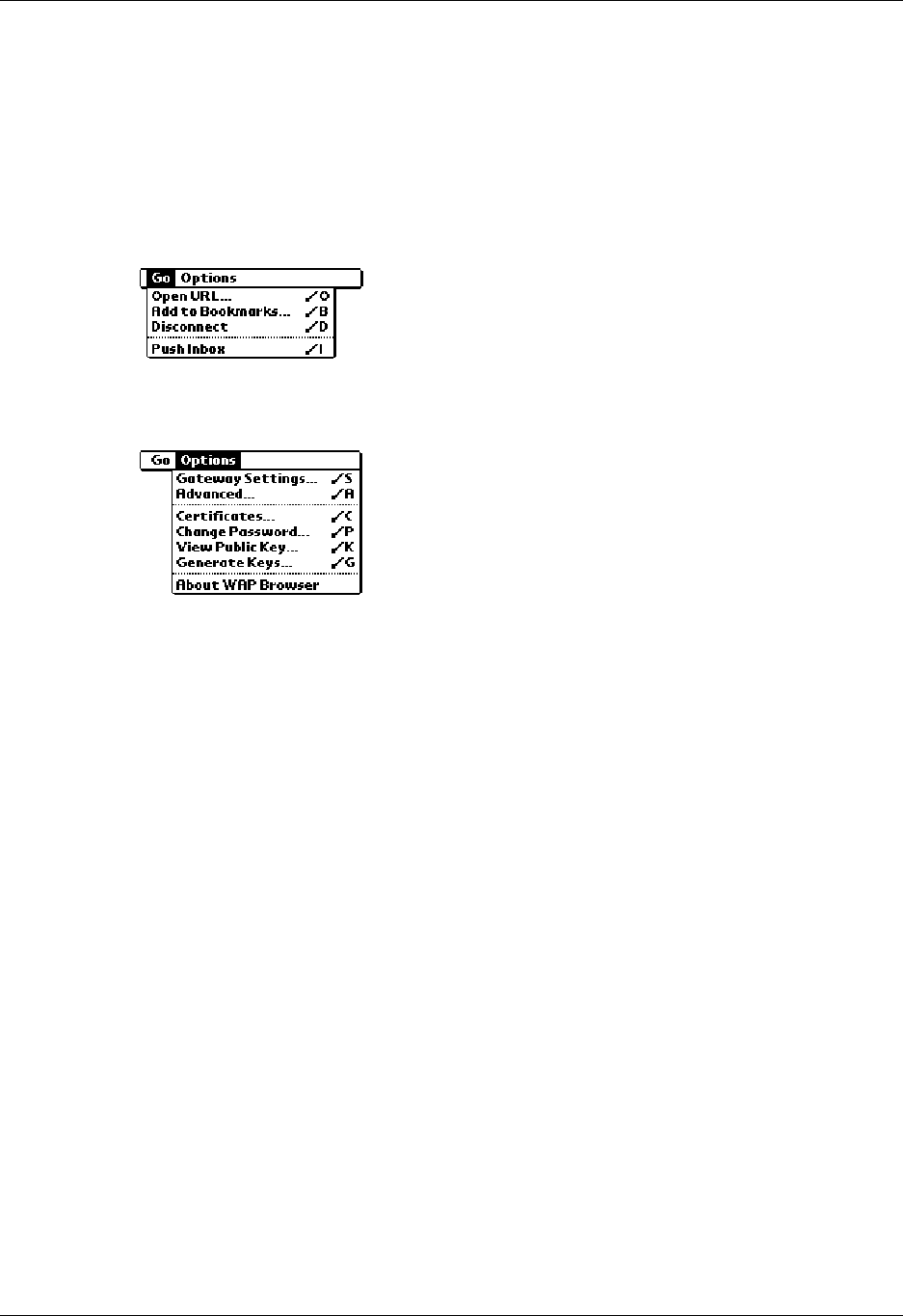
Chapter 18 Using Palm™ WAP Browser
274
Using Palm WAP Browser menus
Palm WAP Browser menus are shown here for your reference, and the Palm WAP
Browser features that is not explained elsewhere in this book is described here.
See “Using menus” in Chapter 4 for information about choosing menu commands.
Go menu
Options menu
About WAP
Browser Shows version information for Palm WAP Browser.
Palm, Inc. Confidential
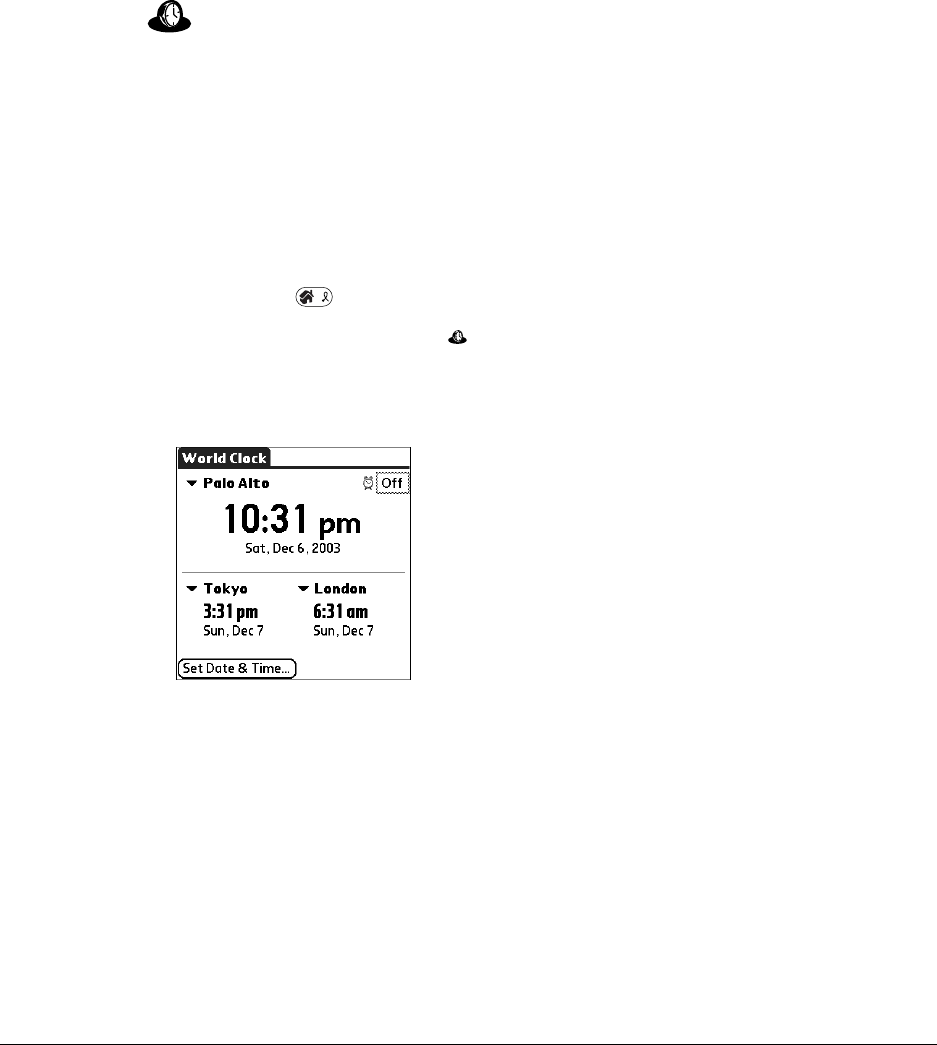
275
CHAPTER 19
Using World Clock
World Clock enables you to view the current time and date in multiple
locations and to set an alarm. Use World Clock to do the following:
■View the current time and date in three locations.
■Open a preferences screen where you can set the time and date for all the
applications on your handheld.
■Set an alarm.
■Set Daylight Saving options.
To open World Clock and view the time:
1. Press Home .
2. Select the World Clock icon .
TIP Select on the navigator, and then tap Go to Clock.
Setting the primary location
You can use World Clock to select the Location and Date & Time for the primary
location. Keep in mind that the primary Location settings are system date and time
and that these settings are used by all the applications on your handheld. The
primary Location settings also appear in the Date & Time Preferences screen.
Similarly, if you change the settings in the Date & Time Preferences screen, those
settings become your system date and time and also appear under the primary
Location in World Clock. The primary Location settings also serve as a point of
reference for the secondary locations.
Palm, Inc. Confidential
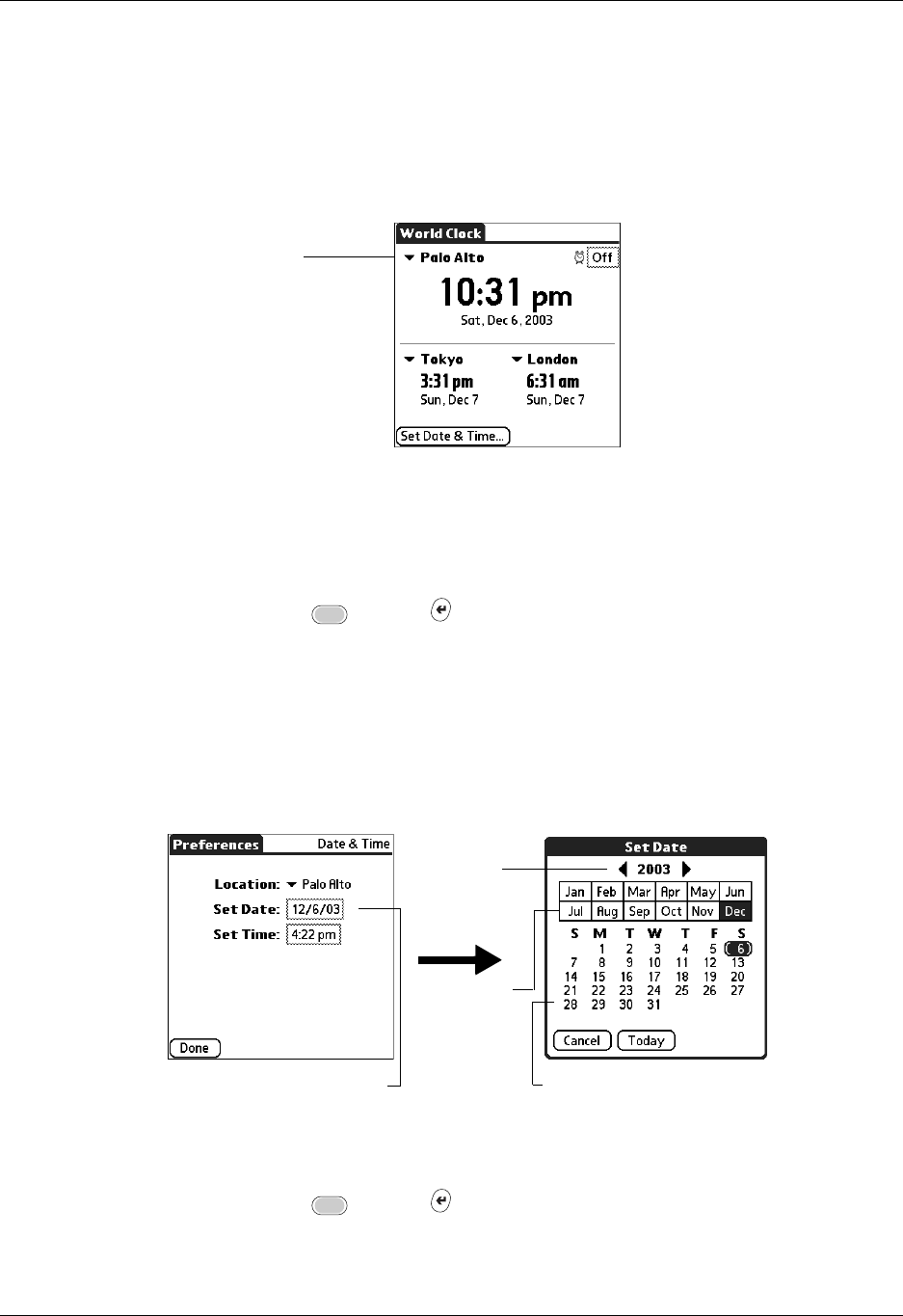
Chapter 19 Using World Clock
276
The following procedures show you how to set the Location and Date & Time from
within World Clock. See “Date and Time preferences” in Chapter 21 for details on
setting these preferences.
To set the Location:
1. Tap the primary location pick list.
2. Tap the location you want to use as the primary location.
The location you select is typically a large city in the same time zone as the one
where you live. If an appropriate choice does not appear in the list, see “Adding
a location” later in this chapter to create a new location.
3. Press Function + Enter , or tap OK.
To set the date:
1. Tap Set Date & Time.
2. Tap the Set Date box.
3. Tap the arrows or press Right and Left on the navigator to select the current
year.
4. Tap the current month.
5. Tap the current date.
6. Press Function + Enter , or tap Done.
Primary location
pick list
Tap to set date
Ta p
arrows
to
select
year
Tap to
select
month
Tap to select date
Palm, Inc. Confidential
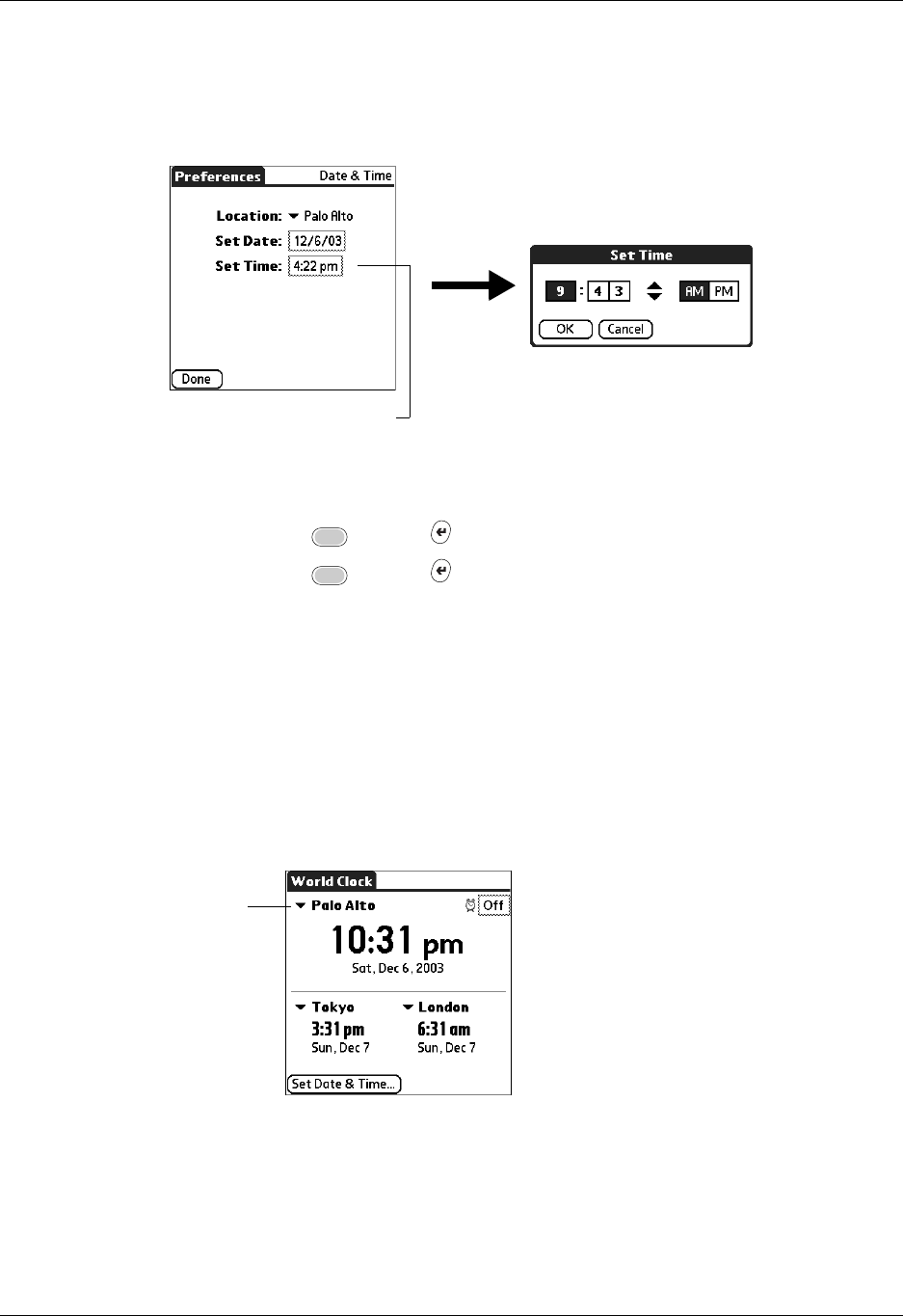
Setting the primary location
277
To set the time:
1. Tap Set Date & Time.
2. Tap the Set Time box.
3. Tap the up or down arrows to change the hour.
4. Tap each number of the minute, and then tap the arrows to change them.
5. Press Function + Enter , or tap OK.
6. Press Function + Enter , or tap Done.
Choosing a different primary location
If you travel to another location and you want alerts to appear based on local time,
you need to change the primary location to update the system time. You may,
however, prefer to use the secondary locations to view the local date and time, and
leave the primary location set to your home location.
To change the primary location:
1. Tap the pick list next to the current primary location.
2. Select the location you want to use as the new primary location.
If the new location is in another time zone, World Clock automatically updates the
date and time in all the applications on your handheld.
Tap to set time
Primary
location
pick list
Palm, Inc. Confidential
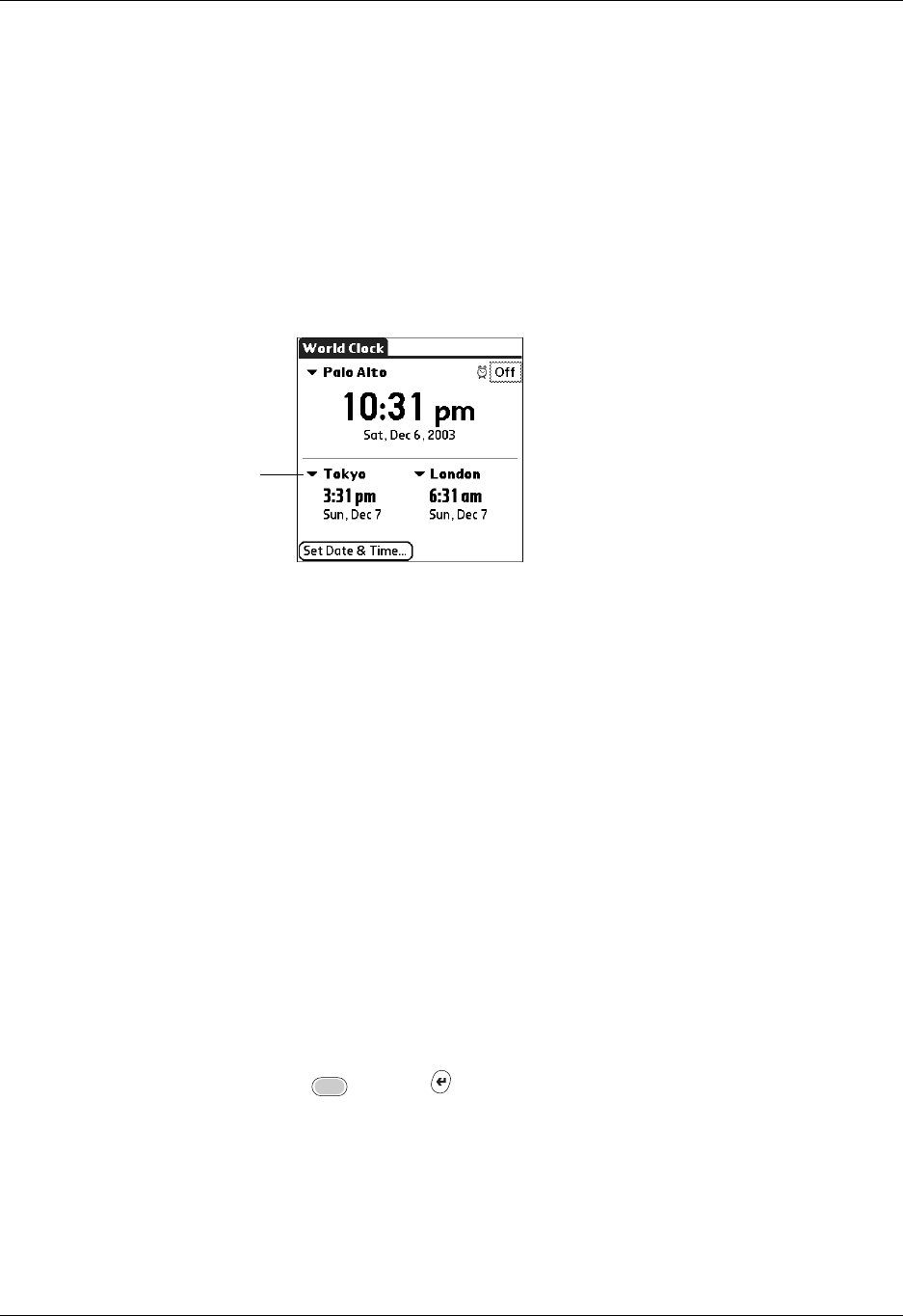
Chapter 19 Using World Clock
278
Setting the secondary locations
The secondary locations display the date and time in two locations other than the
primary location. You can use the secondary locations to view the time in places to
which you travel or you need to contact people.
The date and time in the secondary locations are based on the Date & Time in the
primary location.
To select the secondary Locations:
1. Tap the pick list next to the secondary location.
2. Select the location you want to use as the new secondary location.
If an appropriate location does not appear in the list, see the next section “Adding
a location” to create a new location.
Adding a location
If an appropriate location does not appear in the Location pick list, you can add a
new location to the list, and if necessary adjust the time zone and Daylight Saving
settings. If you activate the Daylight Saving options, the time change automatically
occurs at 1:00 AM on the selected start and end dates.
To add a location:
1. Tap the Location pick list.
2. Select Edit List.
3. Tap Add.
4. Select a location that is in the same time zone as the city you want to add.
5. Press Function + Enter , or tap OK.
6. (Optional) Tap the Name field and modify the Location name.
Secondary
location
pick list
Palm, Inc. Confidential
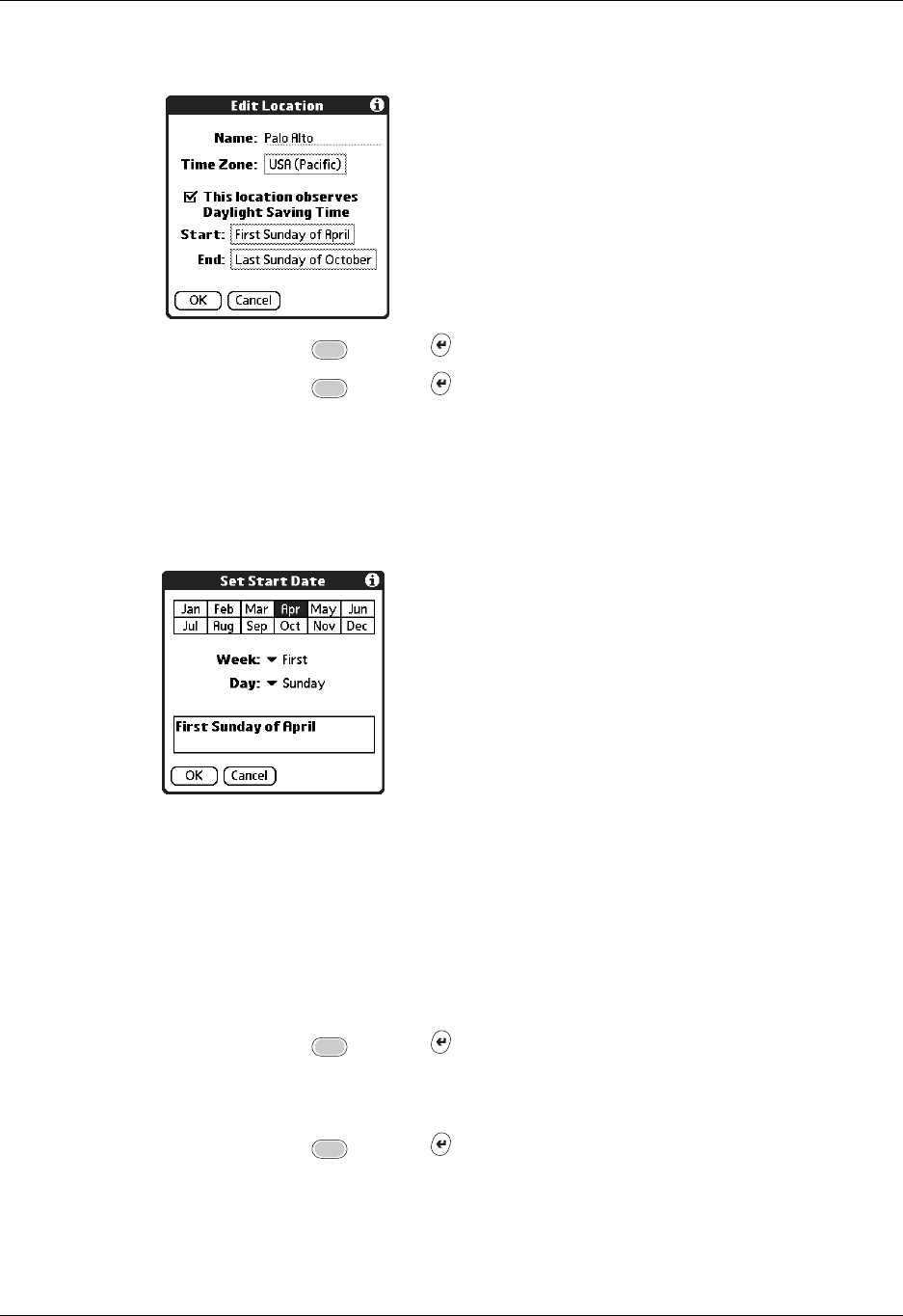
Adding a location
279
7. (Optional) Tap the Time Zone box and select a time zone.
8. Press Function + Enter , or tap OK.
9. Press Function + Enter , or tap Done.
To set Daylight Saving options:
1. From the Edit Location dialog box, tap the This location observes Daylight
Saving Time check box to select it.
2. Tap the Start box.
3. Tap the month when daylight saving begins.
4. Tap the Week pick list.
5. Select the week when daylight saving begins within the selected month.
6. Tap the Day pick list.
7. Select the day of the week when daylight saving begins within the selected
week.
8. Press Function + Enter , or tap OK.
9. Tap the End box and repeat steps 3 through 8 to select when daylight saving
ends.
10. Press Function + Enter , or tap OK.
Palm, Inc. Confidential

Chapter 19 Using World Clock
280
Modifying a Location
If you add a location and later realize you did not use the correct settings, you can
modify the location.
To modify a Location:
1. Tap a Location pick list.
2. Select Edit List.
3. Select the location you want to modify.
4. Tap Edit.
5. Adjust the settings. See “Adding a location” earlier in this chapter for details.
6. Press Function + Enter , or tap OK.
7. Press Function + Enter , or tap Done.
Removing a location
If you no longer need a location that appears on the Location list, you can remove
it from the list. You cannot remove a location that is currently assigned to the
primary location.
To remove a Location:
1. Tap a Location pick list.
2. Select Edit List.
3. Select the location you want to remove.
4. Tap Remo ve .
5. Press Function + Enter , or tap OK to confirm deletion.
6. Press Function + Enter , or tap Done.
Palm, Inc. Confidential
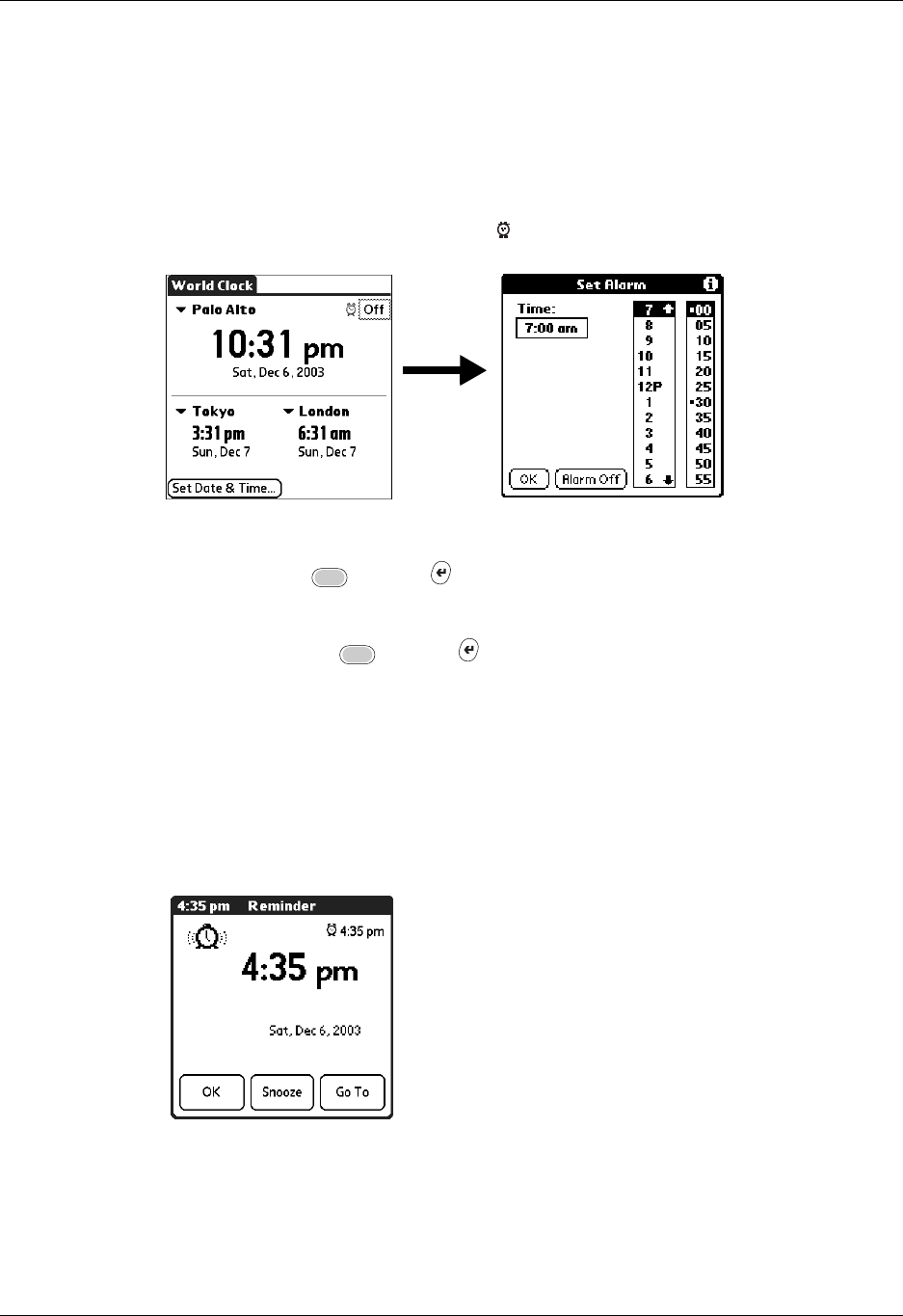
Setting an alarm
281
Setting an alarm
In addition to setting and displaying the Date & Time, World Clock also provides
a convenient travel alarm feature. You can set an alarm to sound during the next
24-hour period.
To set an alarm:
1. Tap the box next to the Alarm icon to open the Set Alarm dialog box.
2. Tap the time columns to set the hour and minute.
3. Press Function + Enter , or tap OK.
4. When the alarm reminder message appears, do one of the following:
– Press Function + Enter , or tap OK to permanently dismiss the
reminder and return to the current screen.
– Tap Snooze to dismiss the reminder and return to the current screen. An
attention indicator blinks in the upper-left corner of the screen to remind you
of the pending alarm, and the reminder message appears again in five
minutes. When the reminder message reappears, the current time is
displayed in the Reminder bar and the alarm time appears on the screen.
5. Tap Go To to open World Clock.
Palm, Inc. Confidential

Chapter 19 Using World Clock
282
Using World Clock menus
World Clock menus are shown here for your reference, and World Clock features
that are not explained elsewhere in this book are described here.
See “Using menus” in Chapter 4 for information about choosing menu commands.
Options menu
Display Options Opens a dialog box where you can choose which information
appears on the World Clock screen.
Show Multiple Locations. Activates the secondary location
displays. When it is selected, the secondary locations appear
below the primary location.
Show Date. Activates the date display. When it is selected, the
date appears below the time for each location.
Alarm
Preferences
Sound. Sets the sound of the alarm. The choices are Alarm,
Bumble Bee, Reveille, Sonata, Wake Up, and Warbler.
Volume. Defines how loud the alarm sounds. The choices are
Low, Medium, and High.
About World
Clock Shows version information for World Clock.
Palm, Inc. Confidential
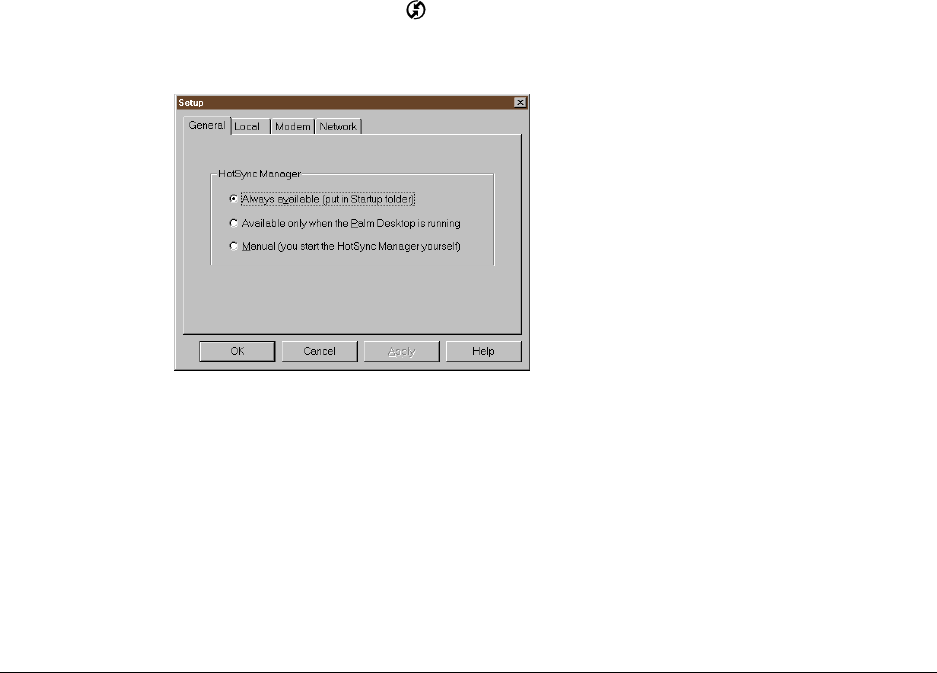
283
CHAPTER 20
Performing HotSync® Operations
HotSync® technology enables you to synchronize data between one or more
Palm OS® handhelds and Palm™ Desktop software or another PIM such as
Microsoft Outlook. To synchronize data, you must connect your handheld and
Palm Desktop software. You can synchronize your data either directly or
indirectly. Direct methods include placing your handheld in the cradle/cable
attached to your computer, or using infrared communications. An indirect method
is using a modem or network HotSync technology.
Selecting HotSync setup options
You can choose when you want HotSync Manager to run. If necessary, you can
adjust the local and modem HotSync settings as well.
To set the HotSync options on a Windows computer:
1. Click the HotSync icon ™ in the Windows system tray.
2. Select Setup.
3. Click the General tab and select one of the following options:
Always available Adds HotSync Manager to the Startup folder and
constantly monitors the communication port for
synchronization requests from your handheld. With this
option, the HotSync Manager synchronizes data even when
Palm Desktop software is not running.
Palm, Inc. Confidential
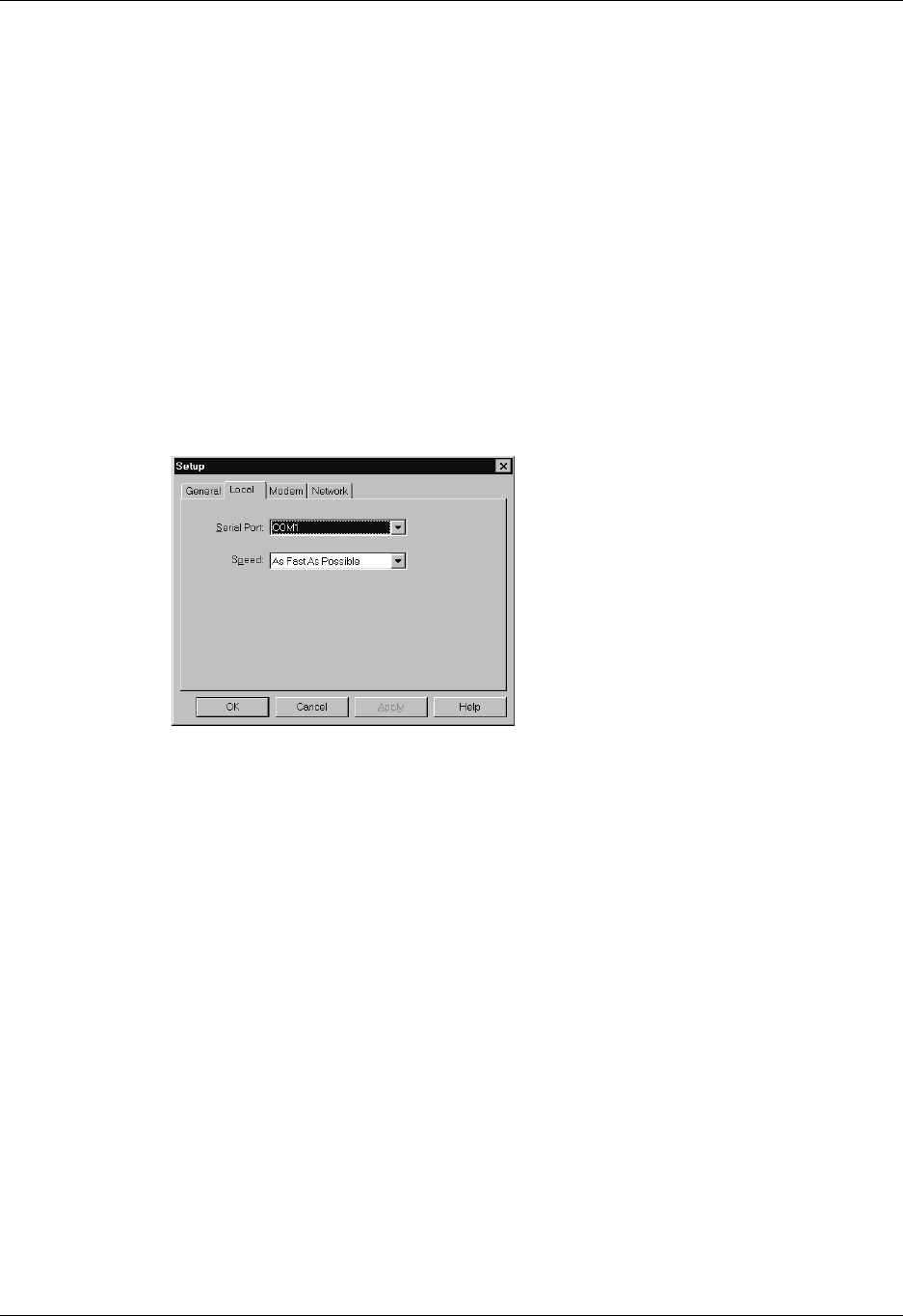
Chapter 20 Performing HotSync® Operations
284
If you’re not sure which option to use, keep the default setting: Always
available.
4. If you are using a serial cradle/cable, click the Local tab to display the settings
for the connection between your computer and the handheld cradle/cable, and
adjust the following options as needed.
If you are using the USB cradle/cable, you do not need to use the settings on the
Local tab for a direct HotSync operation.
5. Click the Modem tab to display the modem settings and adjust the options as
needed. See “Conducting HotSync operations using an attached modem” later
in this chapter for more information.
6. If you are attached to a network, click the Network tab to display the network
settings and adjust the options as needed. For more information, see
“Conducting network HotSync operations” later in this chapter.
7. Click OK.
Available only
when Palm
Desktop software
is running
Starts HotSync Manager and monitors requests
automatically when you open Palm Desktop software.
Manual Monitors requests only when you select HotSync Manager
from the Start menu.
Serial Port Identifies the port that HotSync Manager uses to
communicate with the cradle/cable. You can change the port
selection.
Your handheld cannot share this port with an internal
modem or other device.
Speed Determines the speed at which data is transferred between
your handheld and Palm Desktop software. Try the As Fast
As Possible rate first, and adjust downward if you experience
problems. This setting allows Palm Desktop software and
your handheld to find and use the fastest speed.
Palm, Inc. Confidential

Customizing HotSync application settings
285
To set the HotSync options on a Mac:
1. Double-click the HotSync Manager icon in the Palm folder.
2. Click the HotSync Controls tab and select any of the following options.
3. Close the HotSync Software Setup window.
Customizing HotSync application settings
For each application, you can define a set of options that determines how records
are handled during synchronization. These options are called a conduit. By default,
a HotSync operation synchronizes all files between the handheld and Palm
Desktop software.
In general, you should leave the settings to synchronize all files. The only reason
you might want to change these settings is to overwrite data on either your
handheld or Palm Desktop software, or to avoid synchronizing a particular type of
file because you don’t use it.
In addition to the conduits for Date Book, Address Book, To Do List, Memo Pad,
and Note Pad, Palm Desktop software includes System and Install conduits, as
well as conduits for the VersaMailTM application. The System conduit backs up the
system information stored on your handheld, including ShortCuts. The Install
conduit installs add-on applications on your handheld. The conduit for the
VersaMail application enables you to select e-mail accounts to synchronize. The
VersaMail application is optional and is not installed on all handhelds.
HotSync Enabled/
Disabled Activates the HotSync software and prepares your computer
to synchronize with your handheld. By default, the transport
monitor is enabled whenever you start your computer.
Enable HotSync
software at
system startup
Activates the transport monitor automatically each time you
start your computer. If this option is not selected, you must
open HotSync Manager and select the Enabled option before
you can perform a HotSync operation.
Show more detail
in HotSync Log Includes more troubleshooting information in the log that is
generated when you perform a HotSync operation.
Palm, Inc. Confidential
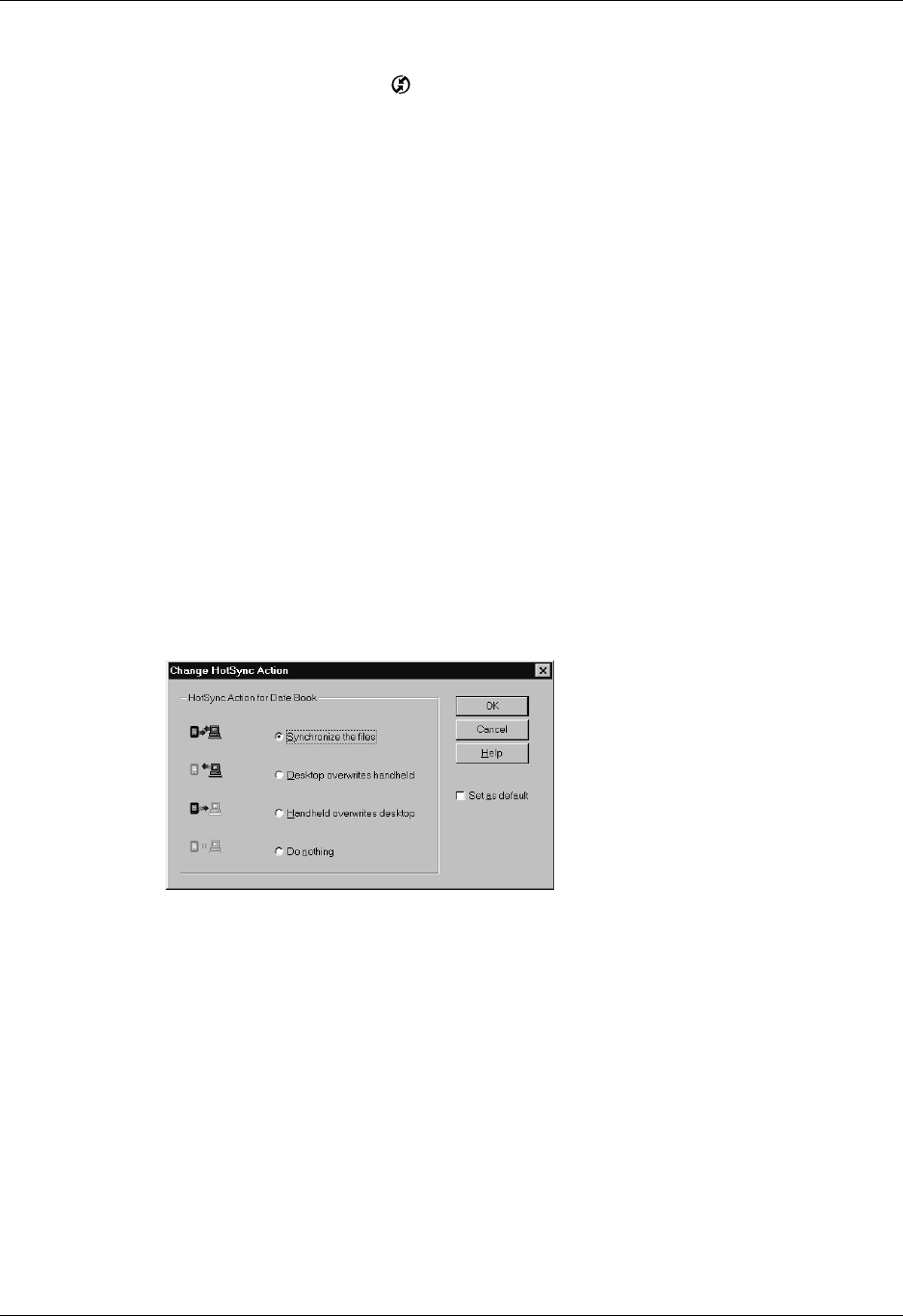
Chapter 20 Performing HotSync® Operations
286
To customize HotSync application settings on a Windows computer:
1. Click the HotSync icon in the Windows system tray (lower-right corner of
the taskbar).
You can also click the HotSync command on the Palm Desktop software menu
bar.
2. From the HotSync Manager menu, choose Custom.
3. Select the appropriate username from the list.
4. Select an application in the Conduit list.
5. Click Change, and do one of the following:
VersaMail: Set synchronization options. Click Configure Accounts to change
e-mail account settings. The VersaMail application is optional and is not
installed on all handhelds.
Other applications: For each application, click the direction in which you want
to write data, or click Do Nothing to skip data transfer for an application.
Changing the HotSync setting from the default affects only the next HotSync
operation. Thereafter, the HotSync Actions revert to their default settings. To
use a new setting on an ongoing basis, select the Set as default box. Thereafter,
whatever you selected as the default setting is used when you click the Default
button in the Custom dialog box.
6. Click OK.
7. Click Done to activate your settings.
To customize HotSync application settings on a Mac computer:
1. Double-click the Palm Desktop icon in the Palm folder.
2. From the HotSync menu, choose Conduit Settings.
3. From the User pop-up menu, select the appropriate username.
4. Select an application in the Conduit list.
Palm, Inc. Confidential
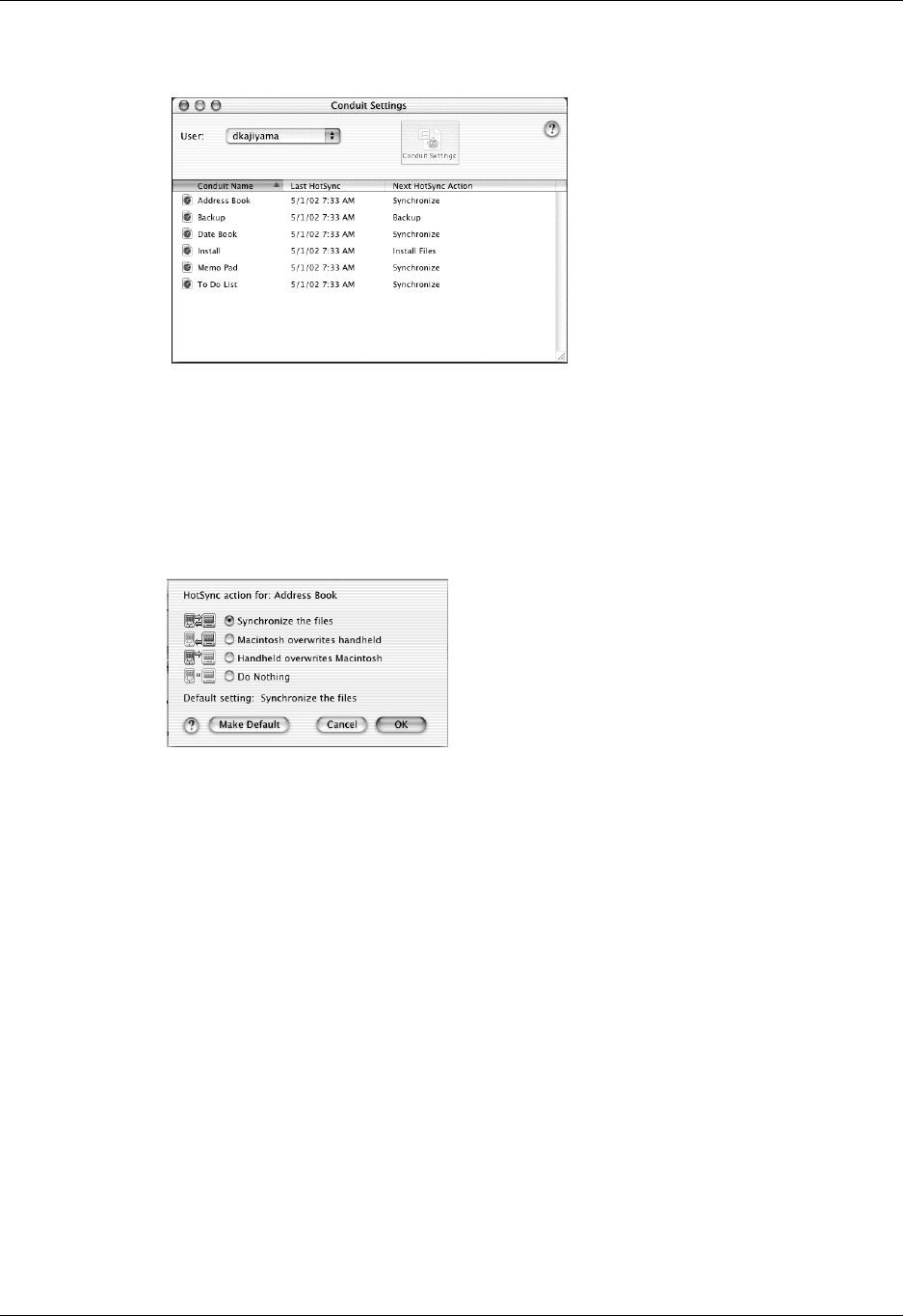
Performing cradle/cable HotSync operations
287
5. Click Conduit Settings.
6. For each application, click the direction in which you want to write data, or click
Do Nothing to skip data transfer for an application.
Changing the HotSync setting from the default affects only the next HotSync
operation. Thereafter, the HotSync Actions revert to their default settings. To
use a new setting on an ongoing basis, click Make Default. Thereafter, whatever
you selected as the default setting is used for HotSync operations.
7. Click OK.
8. Close the Conduit Settings window.
Performing cradle/cable HotSync operations
The simplest way to synchronize data is to perform a direct HotSync operation by
placing your handheld in the cradle/cable and pressing the HotSync button.
Performing a cradle/cable HotSync operation: Windows computer
The first time you synchronize your data, you need to enter user information on
Palm Desktop software. After you enter this information and synchronize, the
HotSync Manager recognizes your handheld and doesn’t ask for this information
again.
Palm, Inc. Confidential
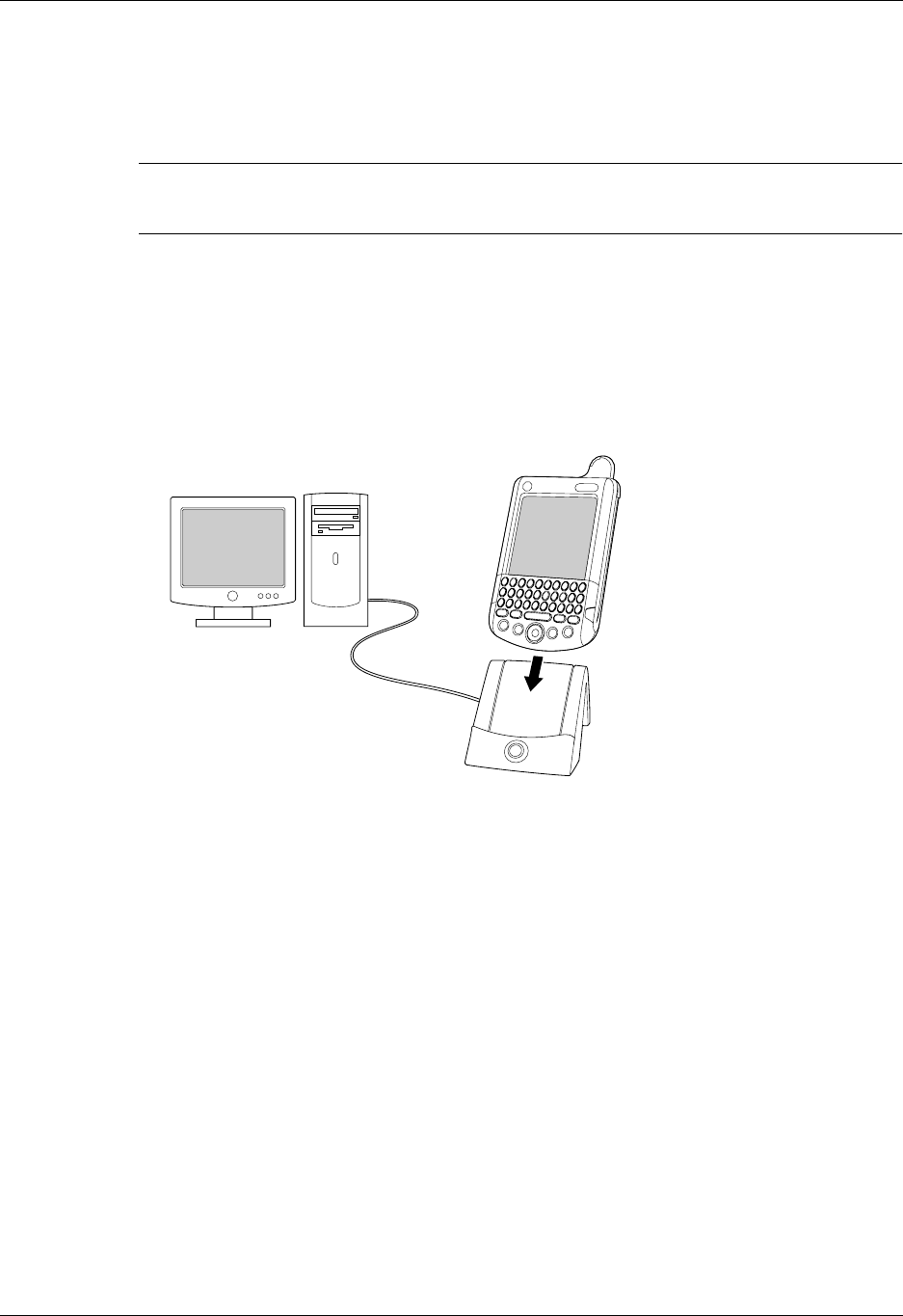
Chapter 20 Performing HotSync® Operations
288
If you are a system administrator preparing several handhelds for a group of users,
you may want to create a user profile. See “Using File Link” later in this chapter
before performing the following steps.
IMPORTANT You must perform your first HotSync operation with a local, direct
connection, or with infrared communication, rather than using a modem or network.
The following steps assume that you have already installed Palm Desktop
software. If you have not installed this software, see the Getting Started installation
guide for instructions.
To perform a local HotSync operation on a Windows computer:
1. Place your handheld in the cradle/cable.
2. If the HotSync Manager is not running, start it: On the Windows desktop, click
Start, and then choose Programs. Navigate to the Palm Desktop software
program group and choose HotSync Manager. Alternatively, you can start the
Palm Desktop software, which automatically opens the HotSync Manager.
Palm, Inc. Confidential
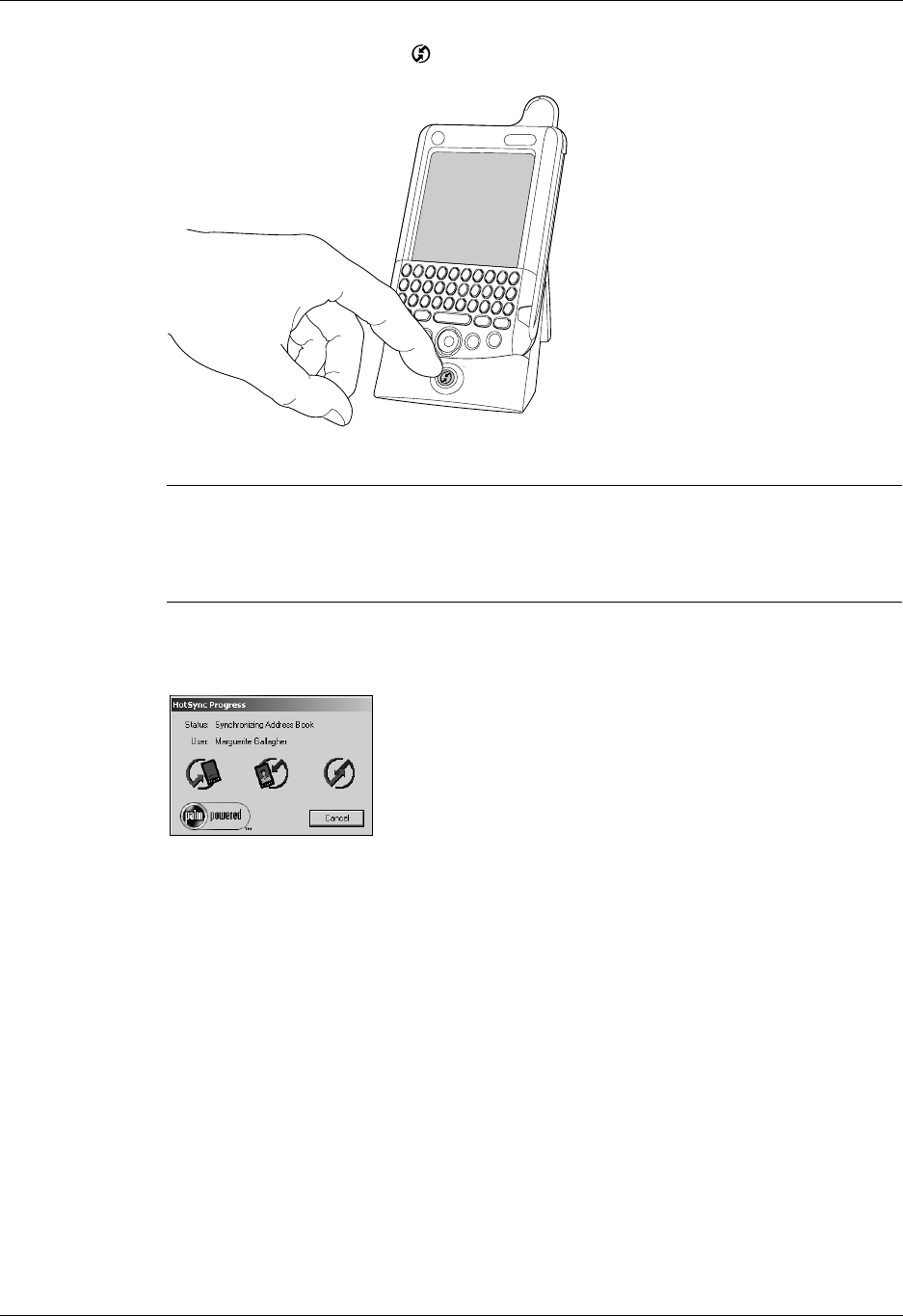
Performing cradle/cable HotSync operations
289
3. Press the HotSync button on the cradle/cable.
IMPORTANT The first time you perform a HotSync operation, you must enter a
username in the New User dialog box and click OK. Every handheld should have
a unique name. To prevent loss of a user’s records, never try to synchronize more
than one handheld to the same username.
The HotSync Progress dialog box appears and synchronization begins.
4. Wait for a message on your handheld indicating that the process is complete.
After the HotSync process is complete, you can remove your handheld from the
cradle/cable. Gently tilt your handheld forward in the cradle, and then lift it up
to remove it.
Performing a direct HotSync operation: Mac computer
When you installed Palm Desktop software, you entered a username. This
username is the connection between your handheld and your computer.
The first time you perform a HotSync operation the Palm Desktop software does
the following:
■Adds a username to your handheld.
■Creates a folder for the username in the Users folder inside the Palm folder
inside the current Mac user’s Documents folder. For example, if you entered
Palm, Inc. Confidential

Chapter 20 Performing HotSync® Operations
290
Jane Garcia as your username, a folder called Jane Garcia is created in the Users
folder.
■Creates a file named User Data in your username folder.
Usernames appear in the User pop-up on the right side of the toolbar. You can
change users by selecting a new name in the pop-up menu.
Each subsequent time you perform a HotSync operation, HotSync Manager reads
the username from your handheld and synchronizes the data in the folder of the
same name.
Be sure you select the correct username from the User pop-up before entering data
on Palm Desktop or performing a HotSync operation.
If you are a system administrator preparing several handhelds for a group of users,
you may want to create a user profile. See “Creating a user profile” later in this
chapter before performing the following steps.
IMPORTANT You must perform your first HotSync operation with a local, direct
connection, or with infrared communication.
The following steps assume that you have already installed Palm Desktop
software. See the Getting Started installation guide if you have not installed this
software.
Palm, Inc. Confidential
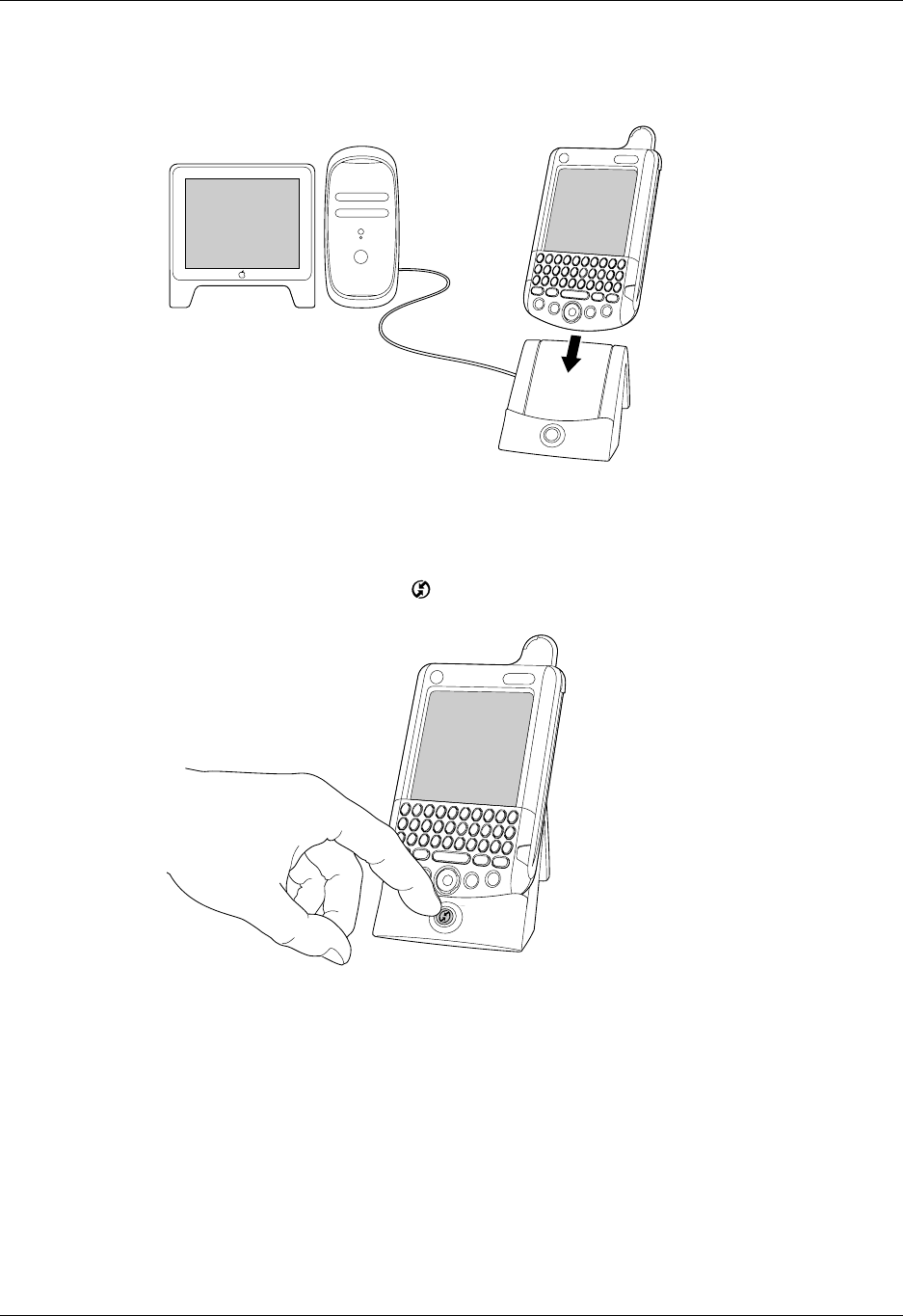
Performing cradle/cable HotSync operations
291
To perform a local HotSync operation on a Mac computer:
1. Place your handheld in the HotSync cradle/cable.
2. Make sure HotSync Manager is enabled: Double-click the HotSync Manager
icon in the Palm folder. Click the HotSync Controls tab and make sure the
Enabled option is selected.
3. Press the HotSync button on the cradle/cable.
The HotSync Progress dialog box appears, followed by the Select User dialog
box.
Palm, Inc. Confidential
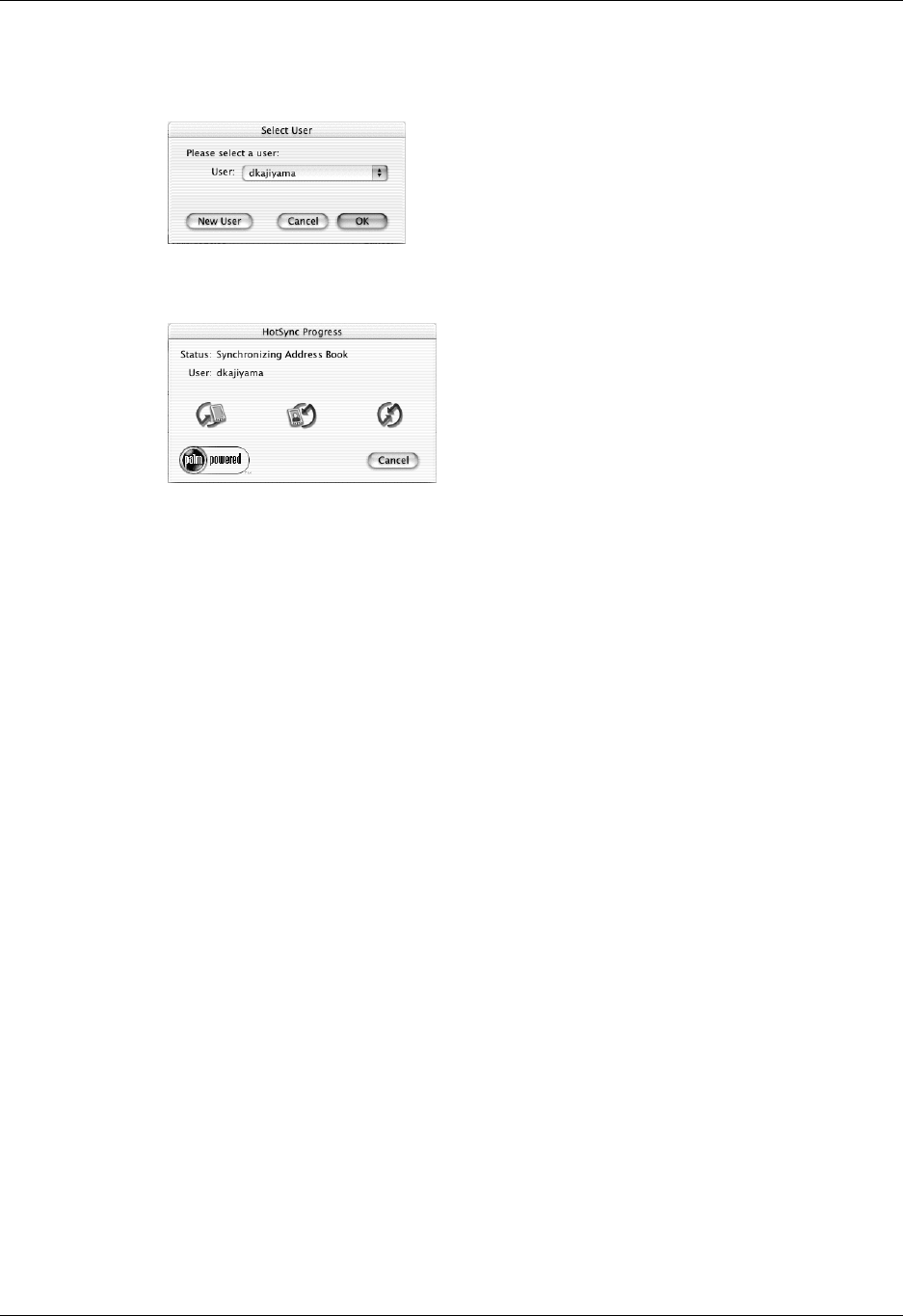
Chapter 20 Performing HotSync® Operations
292
4. In the Select User dialog box, select the username you entered when you
installed the Palm Desktop software, and click OK.
The HotSync Progress dialog box reappears, and synchronization begins.
5. Wait for a message on your handheld indicating that the process is complete.
After the HotSync process is complete, you can remove your handheld from the
cradle/cable. Gently tilt your handheld forward in the cradle, and then lift it up
to remove it.
Conducting IR HotSync operations
You can use the infrared (IR) port on your handheld to perform HotSync
operations. When you perform an IR HotSync operation, you don't need your
cradle/cable. However, you must have a computer that’s equipped with an IR port
and that supports the IrCOMM implementation of the Infrared Data Association
(IrDA) standards. This is especially useful if you travel with an infrared-enabled
laptop. You simply enable infrared communication on your laptop and handheld
and follow the steps in “Performing an IR HotSync operation” later in this section.
Preparing your computer for infrared communication
Before you can perform a HotSync operation using the IR port, the computer with
which you want to synchronize must fulfill these requirements:
■Your computer must support the IrCOMM implementation of the IrDA
standards.
■Your computer must have an enabled infrared port that’s built into the
computer, or an enabled infrared device attached to the computer.
■Some desktop computers may require an infrared device attached to a physical
COM port. Laptops are likely to have a built-in IR port, so no external device is
necessary.
Palm, Inc. Confidential
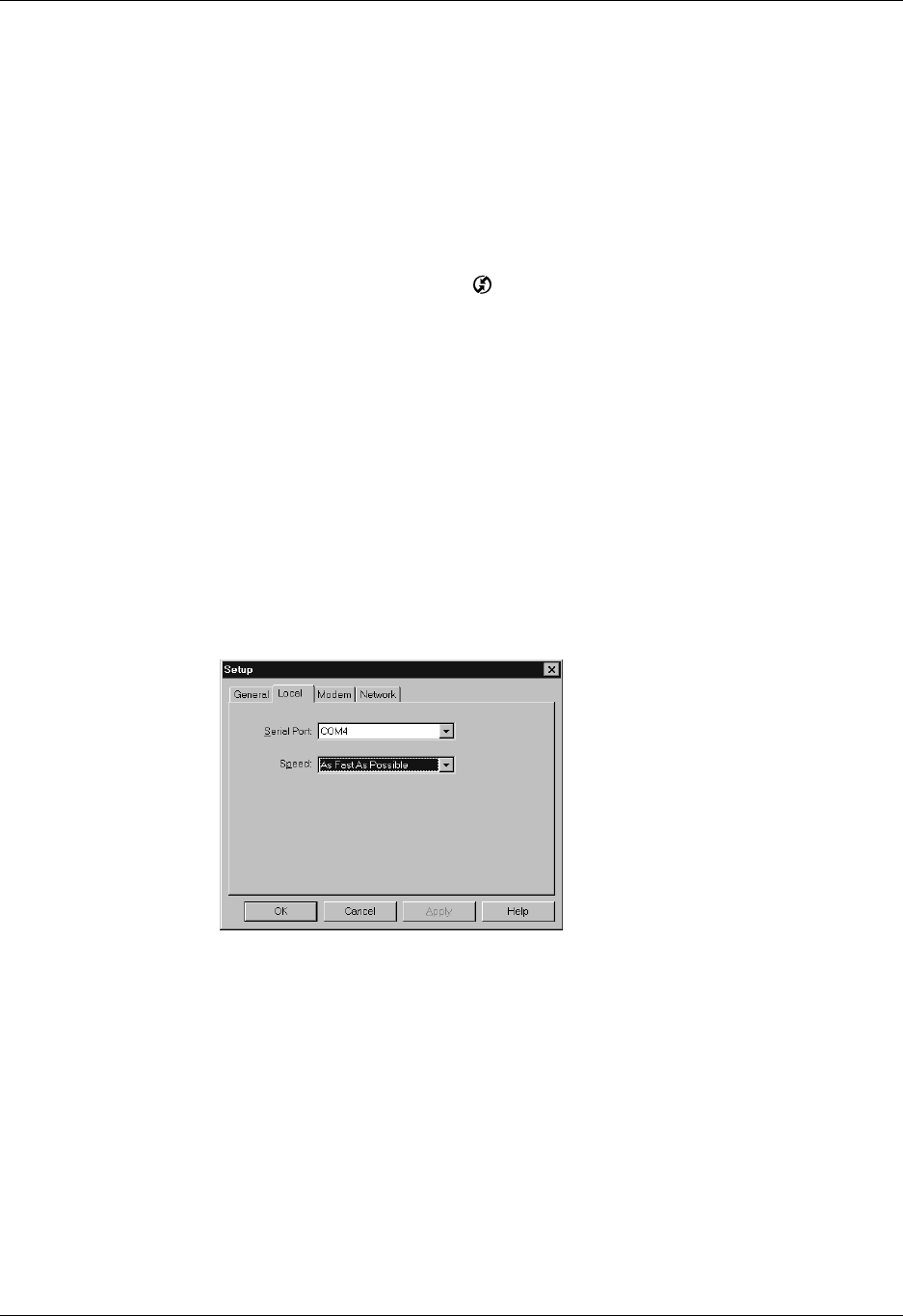
Conducting IR HotSync operations
293
■Your computer must have an installed infrared driver.
■If you have an external infrared device attached to your computer, a driver is
probably included with the device. Consult the documentation included with
the device for information on installing the required driver.
Check your computer’s documentation to learn if the computer supports infrared
communication.
To configure HotSync Manager for infrared communication on a Windows computer:
■Click the HotSync Manager icon in the Windows system tray, and make sure
that Infrared is checked.
– If you have an Infrared option on the HotSync Manager menu, and that
option is selected, skip to “Performing an IR HotSync operation.”
– If you do not have an Infrared option on the HotSync Manager menu,
complete the following steps:
a. Make sure that Local Serial is selected on the menu.
b. From the HotSync Manager menu, select Setup.
c. Click the Local tab.
d. In the Serial Port drop-down box, select the simulated port that your
computer uses for infrared communication.
See the documentation for your operating system for instructions on finding the
simulated port. This information is usually located in the Control Panel.
–Click OK.
NOTE If your cradle/cable is connected to a USB port, you can continue using it while
HotSync Manager is configured for infrared communication. If your cradle/cable is
connected to a serial port, you cannot use your HotSync cradle/cable again until you
reconfigure the HotSync Manager to communicate with the port defined for cradle/
cable synchronization.
Palm, Inc. Confidential
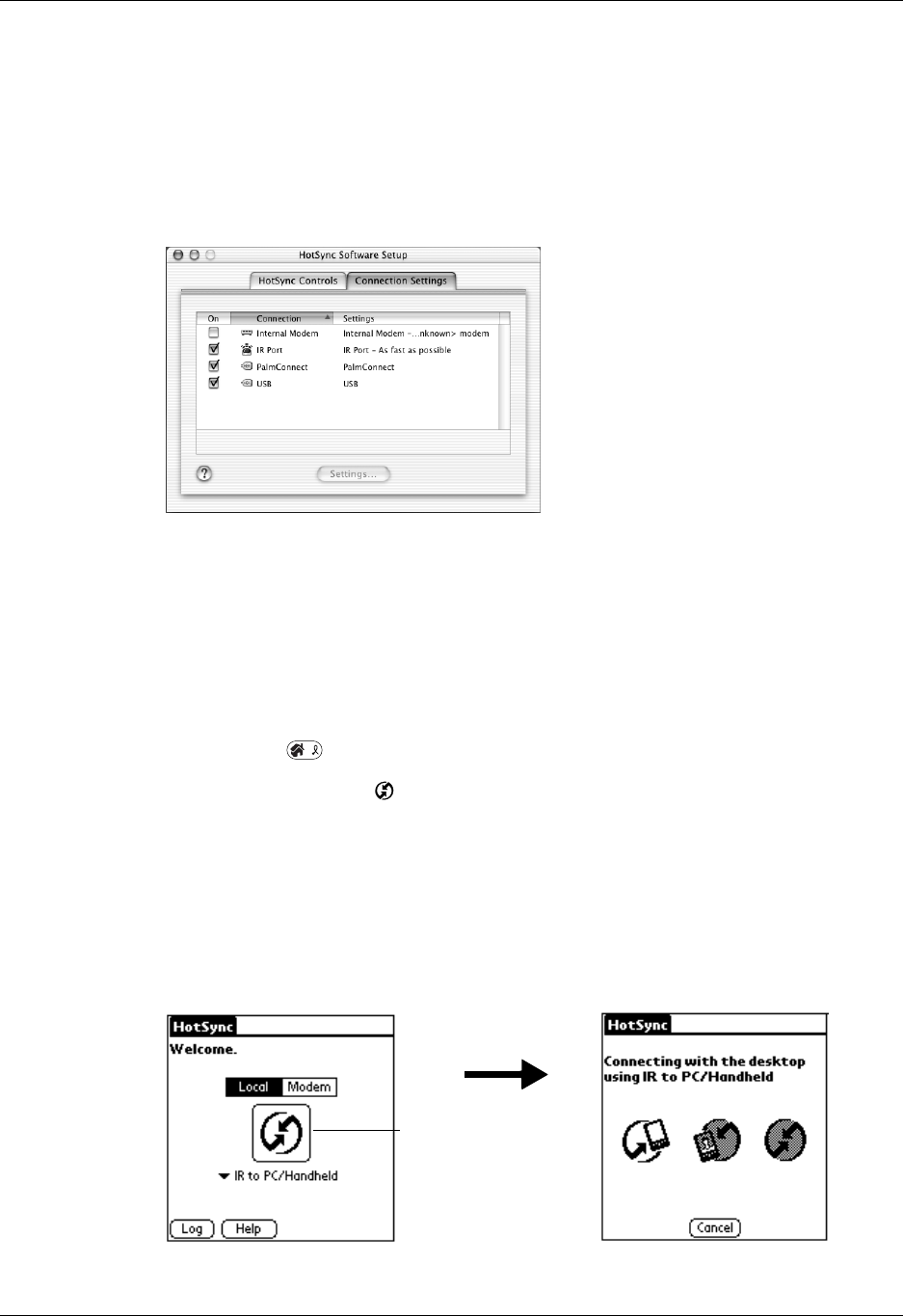
Chapter 20 Performing HotSync® Operations
294
To configure HotSync Manager for infrared communication on a Mac computer:
1. Double-click the HotSync Manager icon in the Palm folder.
2. In the HotSync Controls tab, select Enabled.
3. Click the Connection Settings tab.
4. Select the On check box next to IR Port.
5. Close the HotSync Software Setup window.
Performing an IR HotSync operation
After you complete the steps to prepare for performing an IR HotSync operation,
it’s easy to perform the actual operation.
To perform an IR HotSync operation:
1. Press Home .
2. Tap the HotSync icon .
3. Tap Lo ca l.
4. Tap the pick list below the HotSync icon and select IR to PC/Handheld.
5. Position the IR port of your handheld within a couple of inches of the infrared
port of your computer.
6. Tap the HotSync icon to start the IR HotSync operation.
Tap here to start IR
HotSync operation
Palm, Inc. Confidential

Conducting IR HotSync operations
295
Returning to cradle/cable HotSync operations
It’s easy to return to using the cradle/cable for HotSync operations.
If your cradle/cable is connected to a USB port, you can continue using it while
HotSync Manager is configured for infrared communication. Use the following
instructions to return to Local USB cradle/cable HotSync operations only when
necessary, such as when you have disconnected the cradle/cable from the USB
port.
To return to local USB cradle/cable HotSync operations on a Windows computer:
1. If necessary, connect the cradle/cable to the USB port of the computer you use
for HotSync operations.
2. Click the HotSync Manager icon in the Windows system tray, and select
Local USB if it is not already selected.
To return to local serial cradle/cable HotSync operations on a Windows computer:
1. If necessary, connect the cradle/cable to the port of the computer you use for
HotSync operations.
2. Click the HotSync Manager icon in the Windows system tray.
3. Choose Setup, and then click Local.
4. Select the COM port where your cradle/cable is connected.
5. Click OK.
To return to local serial cradle/cable HotSync operations on a Mac computer:
1. If necessary, connect the cradle/cable to a serial port on your computer.
2. Double-click the HotSync Manager icon in the Palm folder.
3. In the HotSync Controls tab, select Enabled.
4. Click the Connection Settings tab, and select the correct connection.
5. Close the HotSync Software Setup window.
The next time you want to perform a HotSync operation, just press the HotSync
button on the cradle/cable, as you always did before.
Palm, Inc. Confidential

Chapter 20 Performing HotSync® Operations
296
Conducting HotSync operations using an attached modem
You can use your attached modem to synchronize your handheld when you are
away from your computer.
IMPORTANT You cannot perform a wireless HotSync operation using your
handheld’s mobile radio.
The first HotSync operation must be performed using a local, direct connection, or
with infrared communication. After that, you can perform a HotSync operation using
an attached modem.
To perform a HotSync operation using your attached modem you need the
following:
■A modem connected to your computer.
■Palm Desktop software configured for use with the modem.
■A modem connected to your handheld.
■A configuration for the kind of modem connection you want to make.
See “Connection preferences” in Chapter 21 for more information.
Preparing your computer for a modem HotSync operation
There are a few steps you must perform to prepare your computer for a modem
HotSync operation. Be sure to perform these steps before you leave your office so
that your computer is ready to receive a call from your handheld.
To prepare your Windows computer for a modem HotSync operation:
1. Confirm that the computer modem is connected and turned on, and that no
communications applications, such as fax or telephony software, are running
on a COM port.
Make sure the computer is disconnected from all online services, such as
America Online (AOL). This helps to avoid conflicts with the COM port.
2. Start HotSync Manager if it is not already running, and from the HotSync
Manager menu, select Modem.
Palm, Inc. Confidential

Conducting HotSync operations using an attached modem
297
3. Adjust the following options as needed.
4. Click OK.
To prepare a Mac computer for a modem HotSync operation:
1. Confirm that the computer modem is connected and turned on, and that no
communications applications, such as fax or telephony software, or AppleTalk
networking are running on that serial port.
NOTE Make sure your computer is disconnected from all online services, such
as CompuServe and America Online (AOL). This helps to avoid conflicts with
the serial port. In addition, your computer must be on, and it should not be in
sleep mode when receiving a call from a remote handheld.
2. Double-click the HotSync Manager icon in the Palm folder.
3. Click the HotSync Controls tab and enable the Transport Monitor, if it is not
already enabled.
4. Click the Connection Settings tab.
Serial Port Identifies the port for the modem. If you are unsure of the port
assignment, look at the Modem Properties in the Windows
Control Panel.
Speed Determines the speed at which data is transferred. Try the As
Fast As Possible rate first, and adjust downward if you
experience problems. This setting allows Palm Desktop
software and your handheld to find and use the fastest speed.
Modem Identifies the modem type or manufacturer. Refer to your
modem manual or faceplate for its type or settings. If you’re not
sure of your modem type or your modem doesn’t match any
that appear in the list, select Hayes Basic.
Setup String Identifies the setup string for your particular modem. Not all
modems require a setup string. Refer to your modem manual
and enter the setup string if recommended by the manufacturer.
Palm, Inc. Confidential

Chapter 20 Performing HotSync® Operations
298
5. Select the On check box of the modem connection you’re using, and then click
Settings.
6. In the Settings dialog box, select Modem as the connection type, if it is not
already selected. This step is not necessary for internal modems.
7. Adjust the following options as needed.
8. Click OK.
9. Close the HotSync Software Setup window.
Preparing your handheld for a modem HotSync operation
There are a few steps you must perform to prepare your handheld for a modem
HotSync operation.
To prepare your handheld for a modem HotSync operation:
1. Press Home .
2. Tap the HotSync icon .
3. Tap Modem.
Modem Identifies the type of modem connected to your computer. If
your modem does not appear on the list, use the Hayes Basic
setting, or select Custom to enter a command string. Refer to
the manual that came with your modem to find the
appropriate command string.
Modem
Speaker Activates the modem’s speaker. If you are having trouble
connecting, turn on this option to make sure that the modem
connected to your computer is responding to incoming calls.
Palm, Inc. Confidential
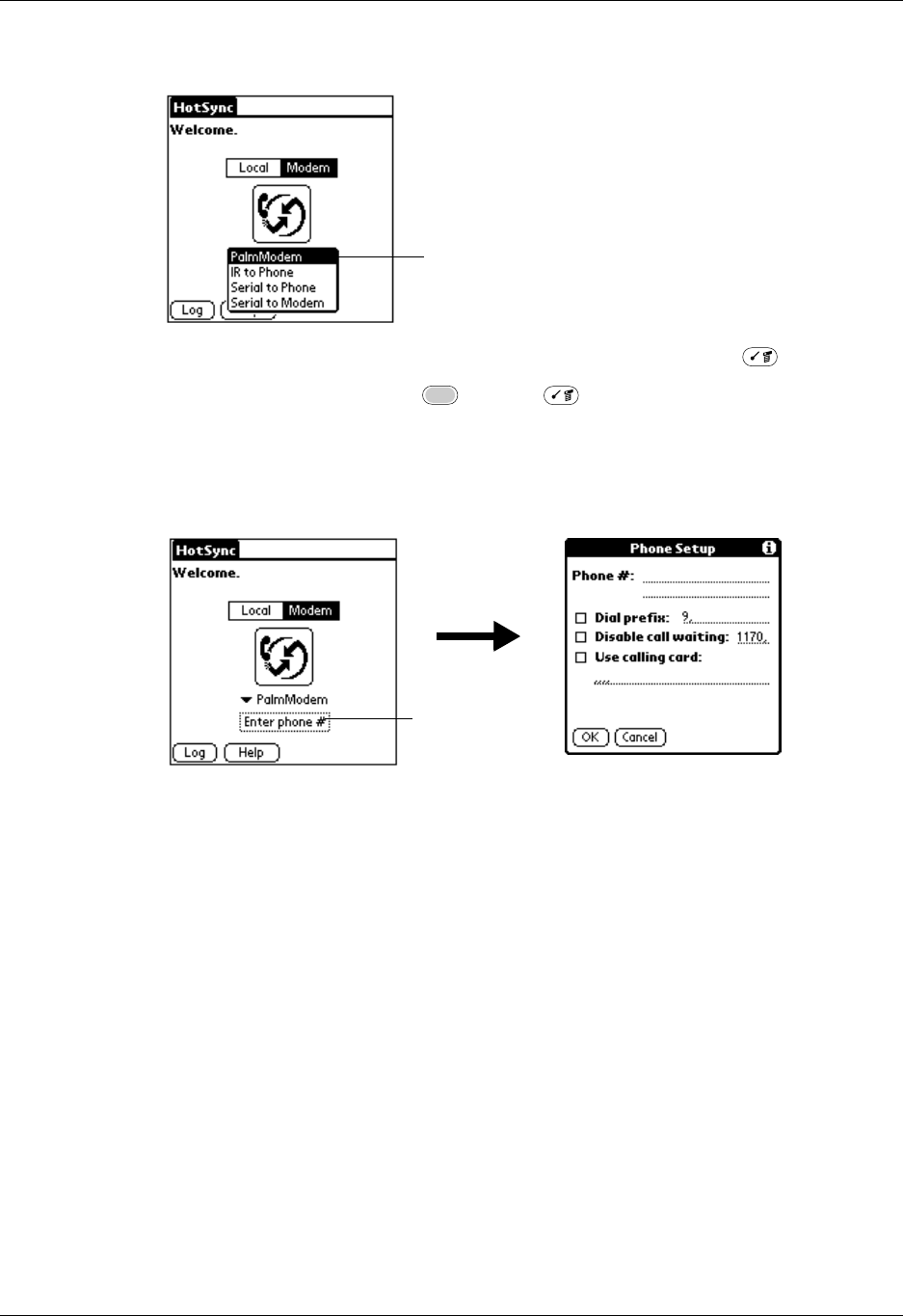
Conducting HotSync operations using an attached modem
299
4. Tap the pick list below the icon and select a modem configuration.
5. If you need to create a configuration, press Command Stroke + S.
Alternately, press Function + Menu , and then select Connection Setup
on the Options menu.
See “Connection preferences” in Chapter 21 for more information.
6. Tap the Enter phone # field.
If you plan to connect to your company’s dial-in server (network modem)
instead of connecting to a computer modem, see “Using File Link” later in this
chapter.
7. Enter the telephone number to access the modem connected to your computer.
8. If necessary, enter a dial prefix (such as “9”) to access an outside line, and then
tap the Dial Prefix check box to select it.
TIP You can enter a comma in the field to introduce a “pause” in the dialing
sequence. Each comma equals a two-second pause.
9. If the phone line you’re using for the handheld has call waiting, select the
Disable call waiting check box to avoid an interruption during the modem
HotSync operation.
10. If you want to use a calling card to place the call, select the check box and enter
the calling card number.
11. Ta p O K.
Select a modem
configuration
Ta p h e r e
Palm, Inc. Confidential
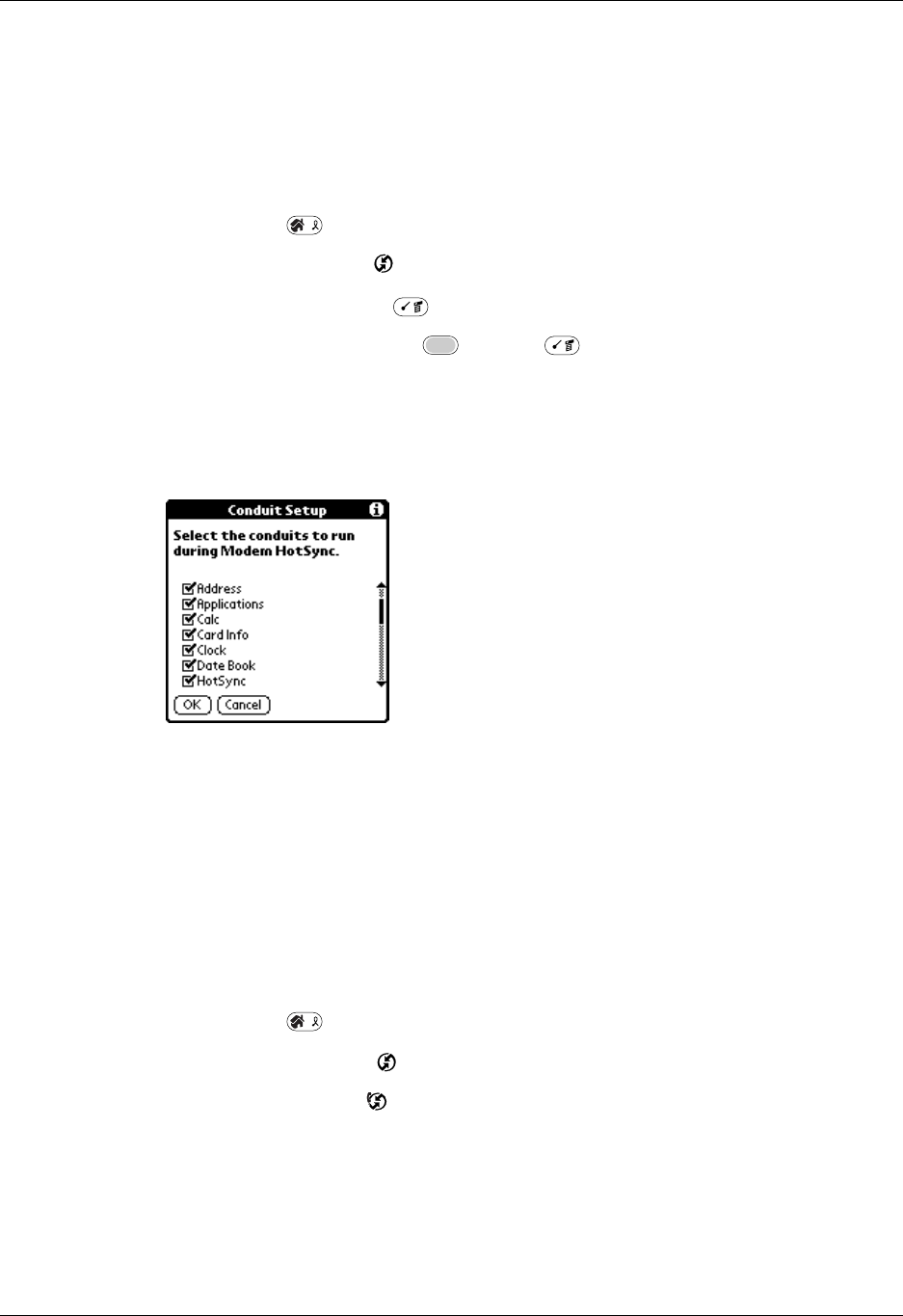
Chapter 20 Performing HotSync® Operations
300
Selecting the conduits for a modem HotSync operation
The Conduit Setup dialog box on your handheld enables you to define which files
and/or applications synchronize during a modem HotSync operation. You can use
these settings to minimize the time required to synchronize data with a modem.
To change the Conduit Setup for a modem HotSync operation:
1. Press Home .
2. Tap the HotSync icon .
3. Press Command Stroke + D.
Alternately, press Function + Menu , and then select Conduit Setup on
the Options Menu.
4. Tap the check boxes to deselect the files and applications that you do not want
to synchronize during a modem HotSync operation. The default setting is to
synchronize all files.
Applications that do not have a database (such as games) do not synchronize,
even if you select the item in the Conduit Setup dialog box.
5. Tap OK .
Performing a HotSync operation using an attached modem
After you prepare your computer and your handheld and select your Conduit
Setup options, you are ready to perform a modem HotSync operation.
To perform a modem HotSync operation:
1. Press Home .
2. Tap the HotSync icon .
3. Tap the Modem icon to dial the Palm Desktop modem and synchronize the
applications.
4. Wait for the HotSync operation to complete. If you have any problems
conducting a successful HotSync operation, see “HotSync problems” in
Appendix B.
Palm, Inc. Confidential

Conducting network HotSync operations
301
Conducting network HotSync operations
When you use the network HotSync technology, you can take advantage of the
LAN and WAN connectivity available in many office environments. Network
HotSync technology enables you to perform a HotSync operation by using
Bluetooth technology or an 802.11 accessory to make a wireless connection to a
network, by dialing in to a network, or by using a cradle/cable that is connected to
any computer on your LAN or WAN (provided that the computer connected to the
cradle/cable also has the network HotSync technology installed, your computer is
on, and the HotSync Manager is running).
NOTE Network HotSync technology is available only on Windows computers and
when dialing into the corporate network. Network HotSync is not available if the
desktop computer is located behind a firewall.
Connecting to your company’s dial-in server
A network HotSync operation requires the following (consult your system
administrator for assistance):
■Your computer has TCP/IP support installed.
■Both your company’s network system and its remote access server support
TCP/IP.
■You have a remote access account.
Everything you need for connecting to your company’s dial-in server (network
modem) is included with Palm Desktop software and handheld software. You
need to activate the feature, however, on both Palm Desktop software and your
handheld.
To prepare your computer for a network HotSync operation:
1. Click the HotSync Manager icon in the Windows system tray.
2. From the HotSync Manager menu, select Network.
3. From the HotSync Manager menu, select Setup.
Palm, Inc. Confidential
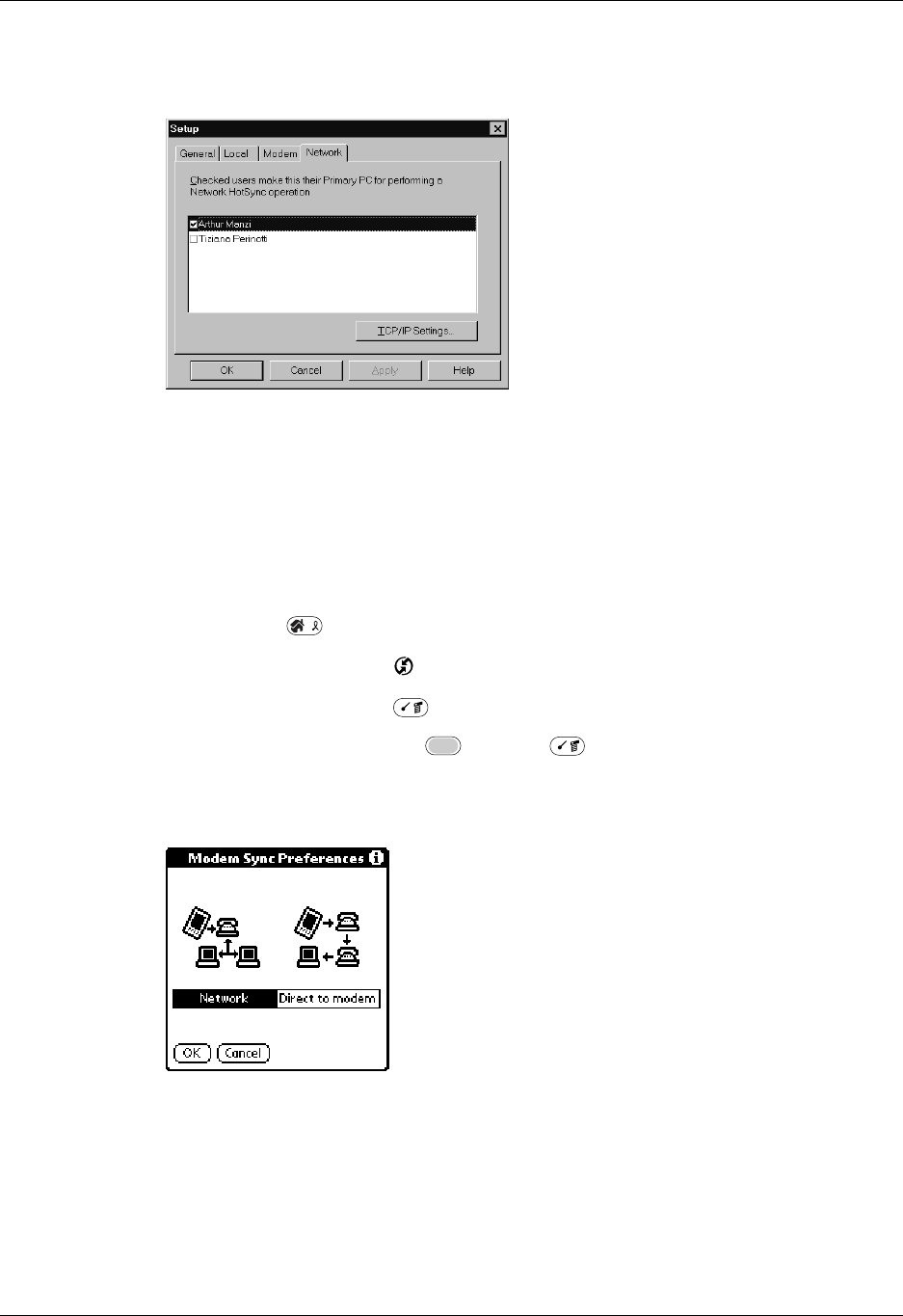
Chapter 20 Performing HotSync® Operations
302
4. Click the Network tab and make sure your user name has a checkmark next to
it. If the checkmark is not there, click the check box next to your user name.
5. Click OK.
6. Put your handheld in the cradle/cable, and perform a HotSync operation.
The HotSync operation records network information about your computer on
your handheld. With this information, your handheld can locate your computer
when you perform a HotSync operation over the network.
To prepare your handheld for a network HotSync operation:
1. Press Home .
2. Select the HotSync icon .
3. Press Command Stroke + O.
Alternately, press Function + Menu , and then select Modem Sync
Prefs on the Options Menu.
4. Tap Network.
5. Tap OK .
Palm, Inc. Confidential
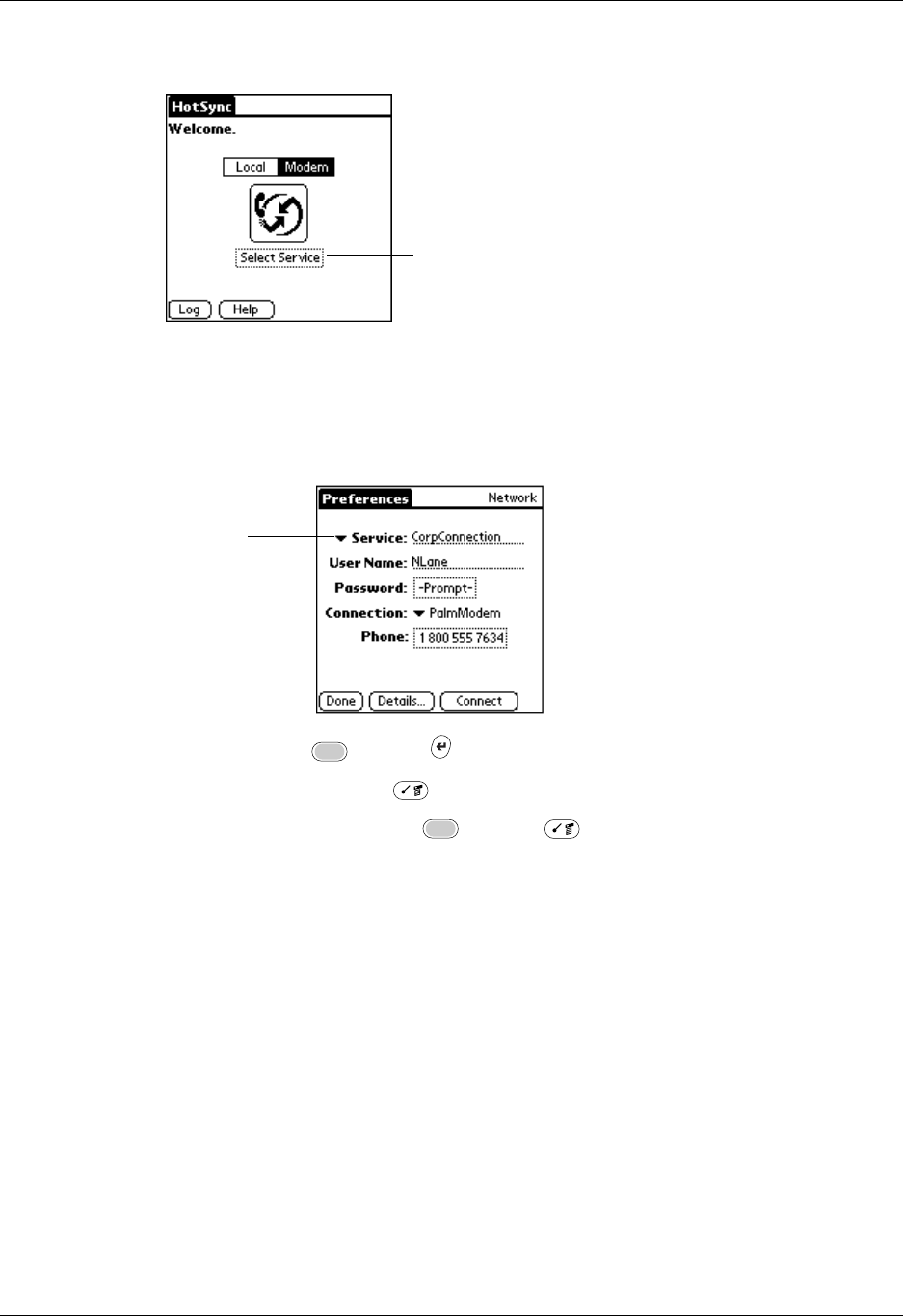
Conducting network HotSync operations
303
6. Tap Select Service.
NOTE See “Network preferences” in Chapter 21 for information on creating a
network connection.
7. Tap Service and select a service.
8. Press Function + Enter , or tap Done.
9. Press Command Stroke + D.
Alternately, press Function + Menu , and then select Conduit Setup on
the Options Menu.
For instructions on selecting conduits, see “Selecting the conduits for a modem
HotSync operation” earlier in this chapter.
Ta p h e r e
Ta p h e r e
Palm, Inc. Confidential
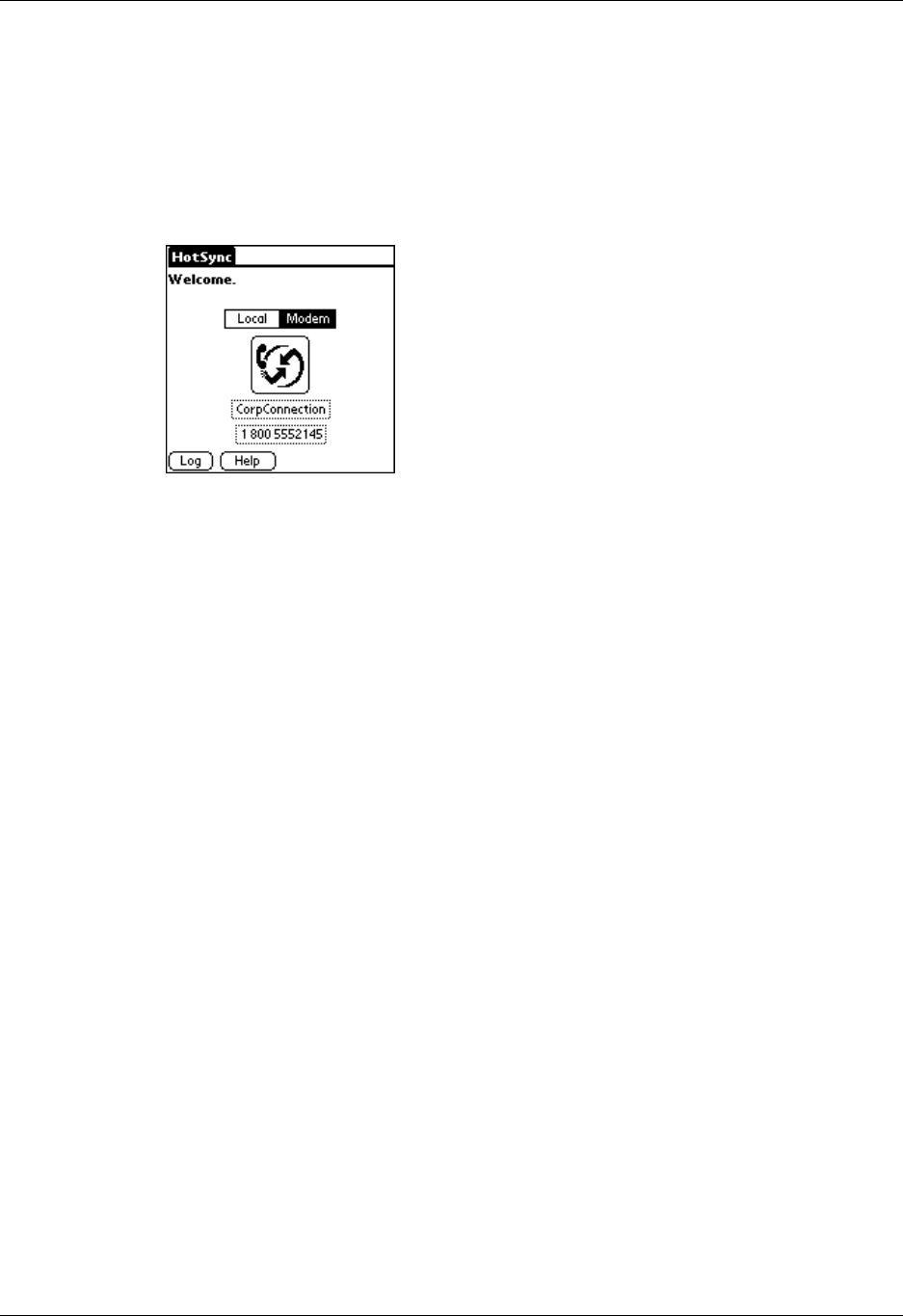
Chapter 20 Performing HotSync® Operations
304
Performing a network HotSync operation
After you prepare your computer and your handheld and select your Conduit
Setup options, you are ready to perform a network HotSync operation.
To perform a network HotSync operation:
■Tap the modem HotSync icon to begin the operation.
Using File Link
The File Link feature enables you to import Address Book and Memo Pad
information onto your handheld from a separate external file such as a company
phone list. HotSync Manager stores the data in a separate category on your Palm
Desktop software and on your handheld. You can configure the File Link feature
to check for changes to the external file when you perform a HotSync operation.
With File Link you can import data stored in any of the following formats:
■Comma-separated (*.csv)
■Memo Pad archive (*.mpa)
■Address Book archive (*.aba)
■Text (*.txt)
For information on how to set up a file link, see the Palm Desktop online Help.
NOTE The File Link feature is not available in Palm Desktop software for Mac.
Palm, Inc. Confidential

Creating a user profile
305
Creating a user profile
A user profile enables you to install the same set of data onto multiple Palm OS
handhelds before each handheld is individualized with a specific user name and
data file.
A handheld that is preconfigured with a user profile can be given to anyone
because the handheld is not yet identified by a unique user name. The handheld
acquires a unique user name when the new user performs his or her first local
HotSync operation.
For example, suppose a sales organization wants to distribute two dozen
handhelds that each have a common company phone list, a set of memos, and
several key applications. A user profile can be created to install the common data
before the handhelds are distributed to the employees who will use them. Then
when the employees perform their first HotSync operation, the common data
becomes part of their individual data file.
NOTE The handhelds that are synchronized with a user profile must be either new
ones that have never been synchronized or handhelds that have had their user names
and data removed by a hard reset.
To create a user profile on a Windows computer:
1. Open Palm Desktop software.
2. From the Tools menu, select Users.
3. Click Profiles.
4. Click New.
5. Enter a unique name for the profile and click OK.
6. Repeat steps 3 through 5 for each profile that you want to create, and then click
OK to return to Palm Desktop software.
Palm, Inc. Confidential
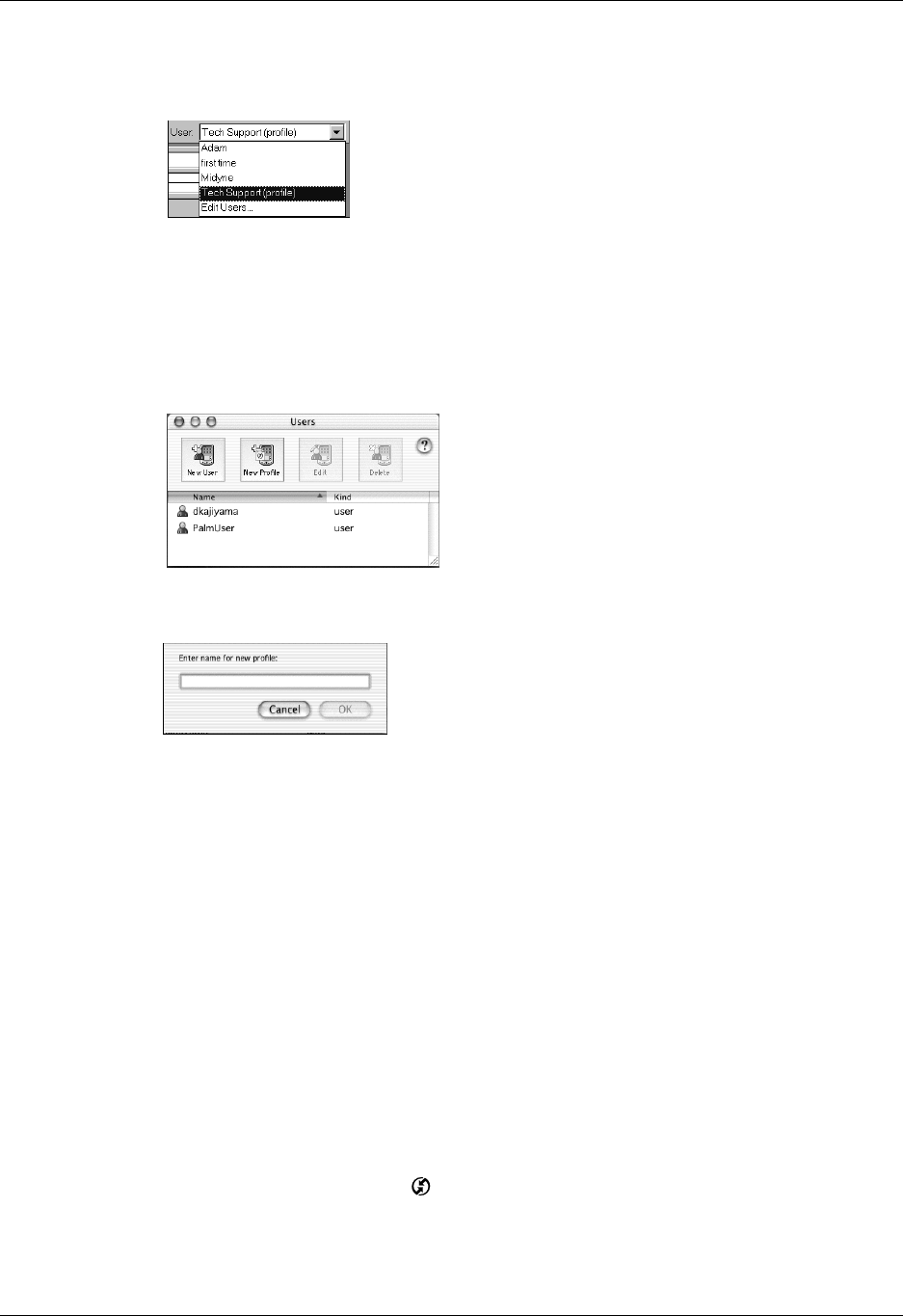
Chapter 20 Performing HotSync® Operations
306
7. Select the profile from the User list, and create the data for the profile (for
example, a company phone list).
To create a user profile on a Mac computer:
1. Open Palm Desktop software.
2. From the User pop-up menu, select Edit Users.
3. Click New Profile.
4. Enter a unique name for the profile and click OK.
5. Close the Users window.
6. From the User pop-up menu, select the new profile.
7. Create the data for the profile (such as a company phone list).
8. From the HotSync menu, select Conduit Settings.
9. Select the conduit settings for the profile. See “Customizing HotSync
application settings” earlier in this chapter for details.
Performing the first HotSync operation with a user profile
After you create a user profile, you are ready to transfer the information to the new
handheld during the first HotSync operation.
To use a profile for the first-time HotSync operation on a Windows computer:
1. Place the new handheld in the cradle/cable.
2. Press the HotSync button on the cradle/cable.
3. Click Profiles.
Palm, Inc. Confidential
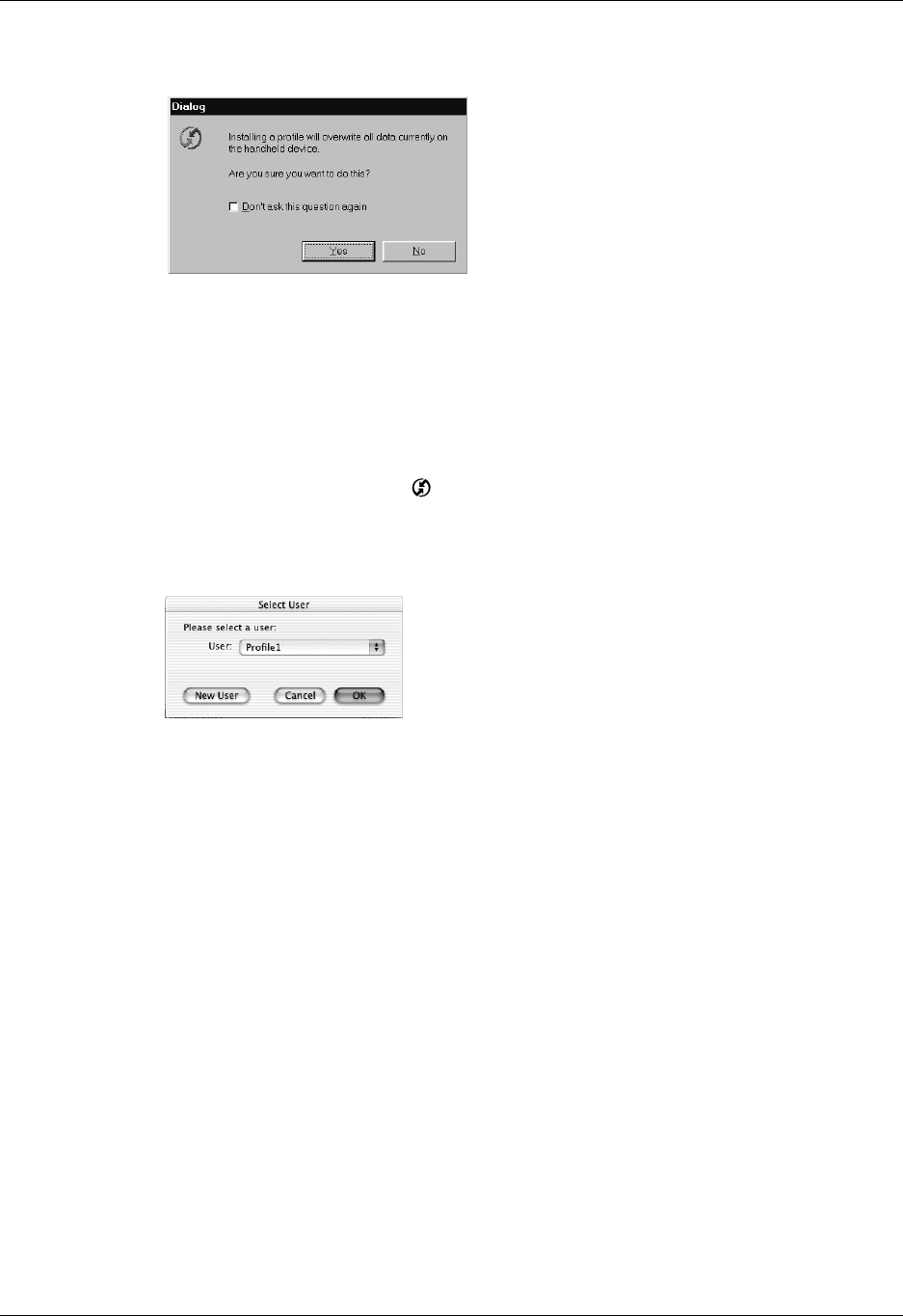
Creating a user profile
307
4. Select the profile you want to load on the handheld, and click OK.
5. Click Yes to transfer all the profile data to the handheld.
The next time you perform a HotSync operation, Palm Desktop software prompts
you to assign a username to the handheld.
To use a profile for the first-time HotSync operation on a Mac computer:
1. Connect the new handheld to the HotSync cradle/cable.
2. Press the HotSync button on the cradle/cable.
3. Select the profile you want to load on the handheld, and click OK to transfer all
the profile data to the handheld.
The next time you perform a HotSync operation, Palm Desktop software prompts
you to assign a username to the handheld.
Palm, Inc. Confidential

Chapter 20 Performing HotSync® Operations
308
Palm, Inc. Confidential

309
CHAPTER 21
Setting Preferences for Your Handheld
The Preferences screens enable you to customize the configuration options on your
handheld, including the following:
Buttons Reassign different applications to the buttons on the front panel
of your handheld, and the HotSync® button on the cradle.
Connection Configure cradle, modem, and infrared communication
settings.
Date and Time Set the date, time, time zone, and Daylight Saving switch.
Digitizer Calibrate the screen on your handheld.
Formats Set the country default and the formats for dates, times,
calendar, and numbers.
General Set these features: auto shutoff interval, Stay on in cradle,
sounds, vibrator, indicator light, and Beam Receive.
Keyboard Configure your keyboard functions.
Mobile The Mobile Panel allows you to configure many of the wireless
settings for the applications sharing configuration settings.
Network Configure your handheld for use with a network.
Owner Assign your name, phone number, and other owner
information to your handheld.
Security Set the security features for your handheld.
ShortCuts Define a list of abbreviations.
Palm, Inc. Confidential
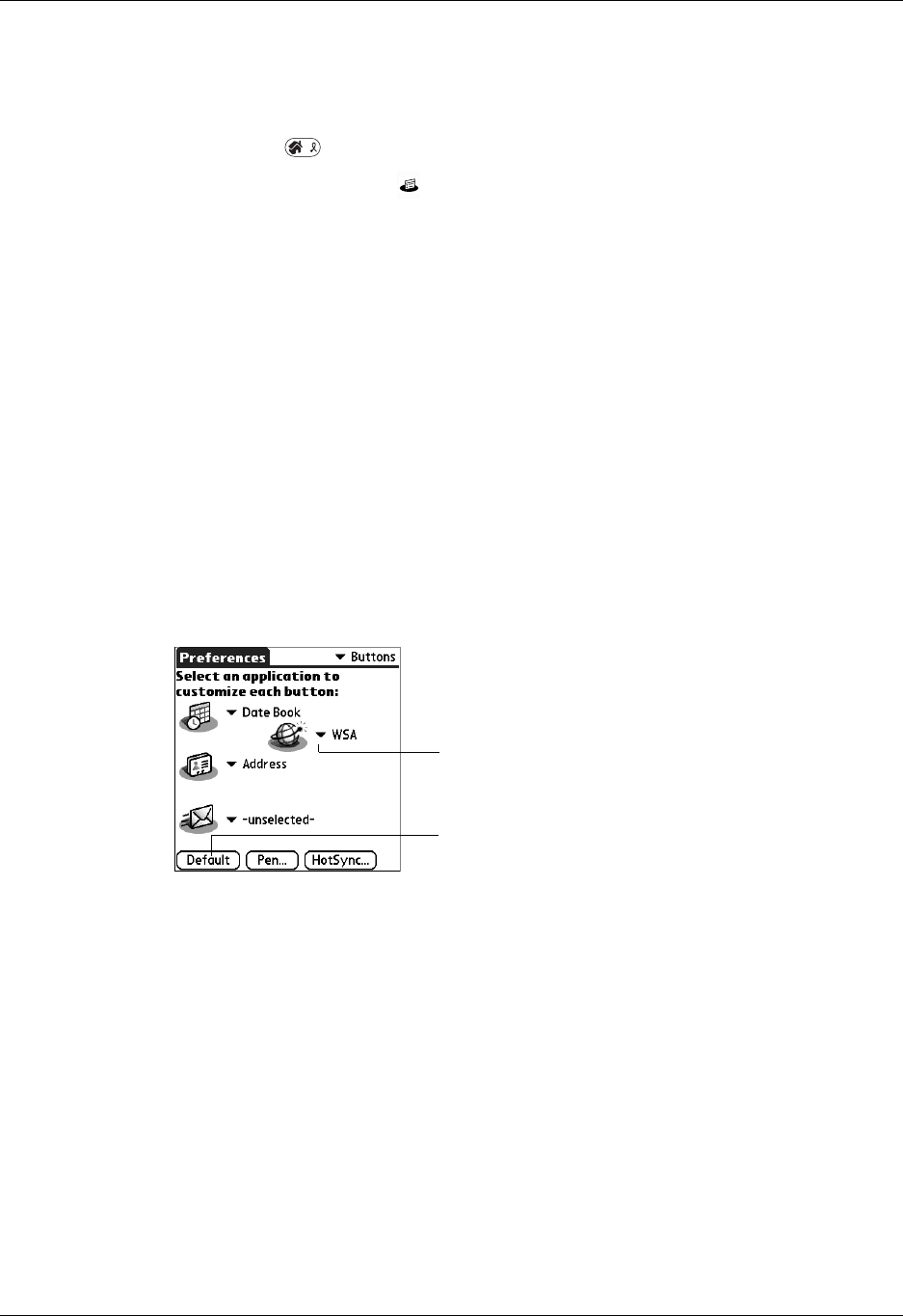
Chapter 21 Setting Preferences for Your Handheld
310
Viewing Preferences
To open the Preferences screens:
1. Press Home .
2. Tap the Preferences icon .
3. Tap the pick list in the upper-right corner of the screen.
4. Select the Preferences screen you want to view.
Buttons preferences
The Buttons Preferences screen enables you to associate different applications with
the buttons on the front of the handheld.
Any changes you make in the Buttons Preferences screen become effective
immediately; you do not have to change to a different screen or application.
If you assign a different application to a button, you can still access the original
application using the Applications Launcher.
To change the Buttons preferences:
1. Tap the pick list next to the button you want to reassign.
2. Select the application that you want to assign to the button.
Tap arrow to
show pick list
Tap Default to restore all of the
buttons to their factory settings
Palm, Inc. Confidential
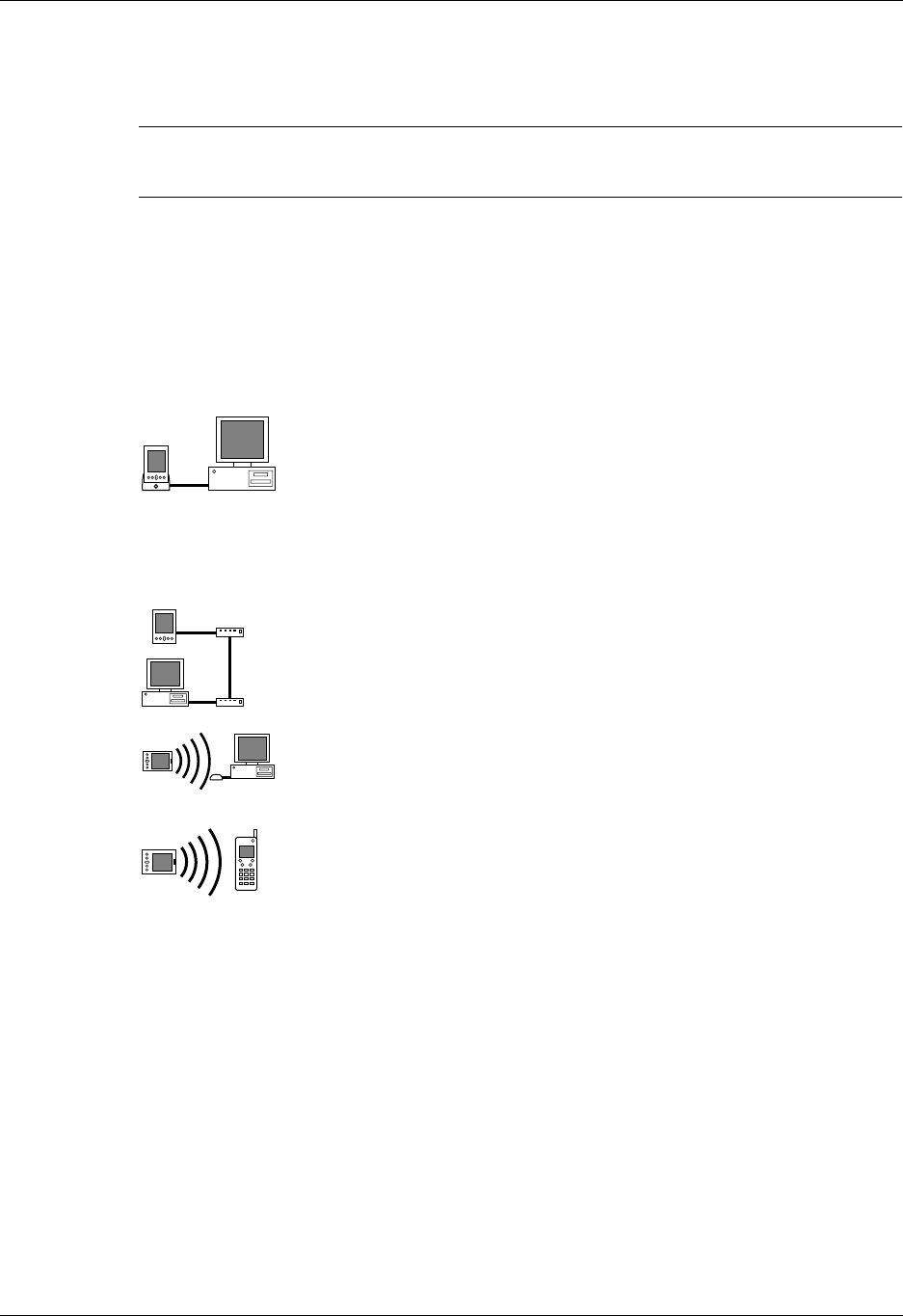
Connection preferences
311
Connection preferences
IMPORTANT The connections preferences may have been set by your wireless
service provider. Check with your provider before changing the preset settings.
The Connection Preferences screen enables you to define the settings used to
connect your handheld to other devices. The screen displays a list of available
configurations that are ready to be further defined; the list varies depending on the
kind of software you’ve added to your handheld.
You can also create custom configurations, which include the following:
PC via Cradle/Cable: A local HotSync connection; the direct
connection between your handheld and your desktop computer.
Your handheld is connected by its universal connector to the
cradle, and the cradle is attached by its cable to a USB port of
your desktop computer. (If you are using the optional serial
cradle, the cradle attaches by its cable to a serial [COM] port of
your computer.)
Modem via Universal Connector: A cable connection between
your handheld’s universal connector and a modem for dialing in
to a modem that is part of your computer or laptop.
PC via Infrared: A connection between the IR port of your
handheld and the infrared device of your computer or laptop.
Modem via Infrared: A connection between the IR port of your
handheld and a modem. The modem can be attached to or
within a mobile phone or some other device containing an IR
port. (Some IR phones contain modems.)
Palm, Inc. Confidential
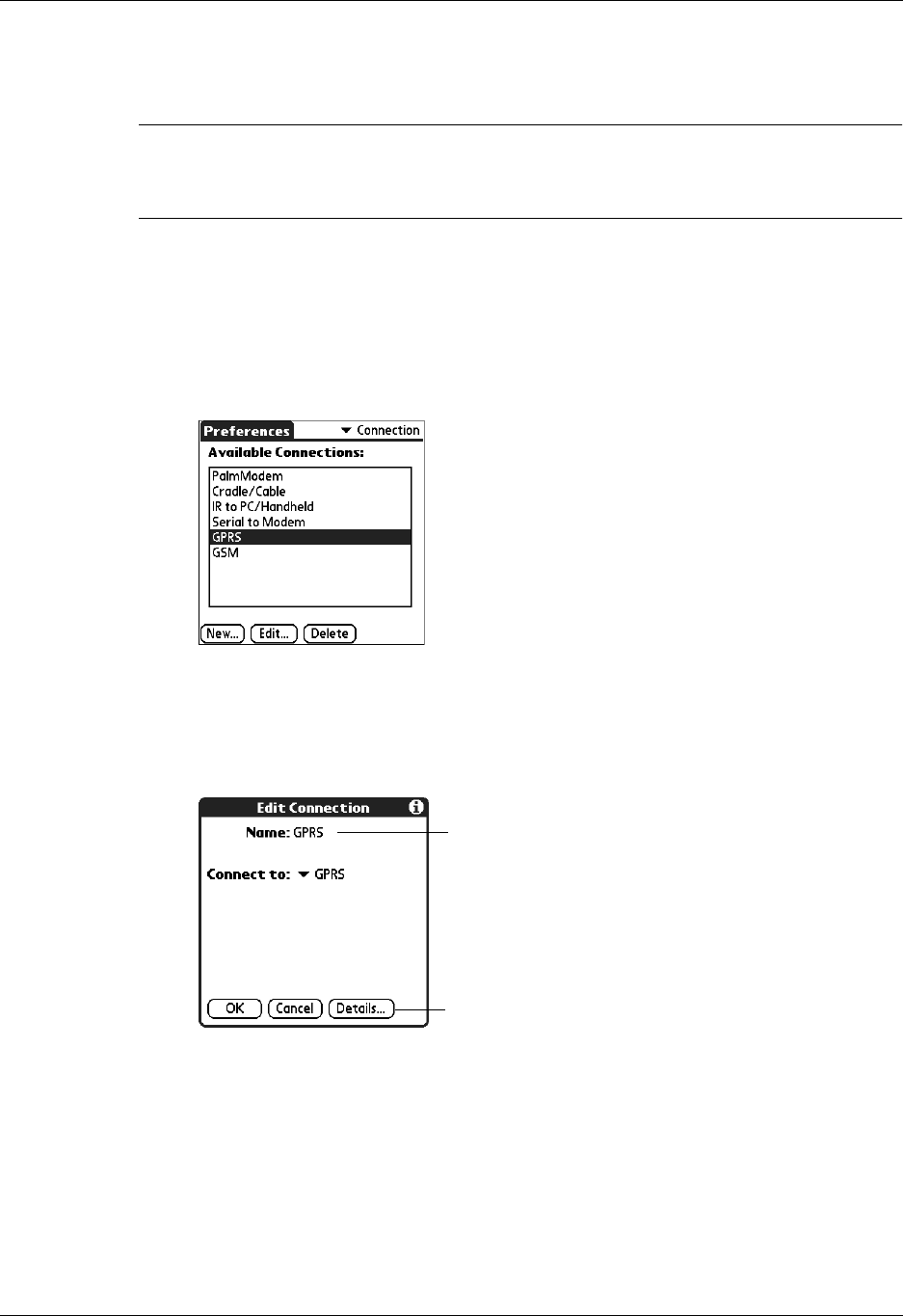
Chapter 21 Setting Preferences for Your Handheld
312
Creating and editing GPRS connections
IMPORTANT Your wireless service provider may have set your GPRS connection
settings. Different settings may affect your service. Contact your wireless service
provider before using different settings.
To add or edit a GPRS connection:
1. Do one of the following:
– To add: Tap New.
– To edit: Tap the GPRS connection and tap Edit.
2. Do one of the following:
– To add: Enter name and tap Details.
– To edit: Tap Details.
Tap Details
Enter name if new connection
Palm, Inc. Confidential

Connection preferences
313
3. Adjust settings.
Access Point
Name Opens a dialog box that allows you to change the address on the
GPRS network in which data is routed through to outside
networks–for example, a specific gateway to the Internet or a
specific WAP gateway.
Quality of
Service Opens up a dialog box that allows you to choose between using
the network default settings for quality service or customizing
individual settings.
NOTE The quality of service settings are only a request made to
the network. The network may or may not grant the level of quality
requested, depending on current network conditions and services
provided on an individual basis.
Header
Compression Sets whether the GPRS data headers are compressed or not.
Compressing before transmission aids in increasing
transmission speed.
Data
Compression Sets whether transmitted data is compressed or not compressed.
Compressing data aids in increasing transmission speed.
Palm, Inc. Confidential

Chapter 21 Setting Preferences for Your Handheld
314
4. Tap the box under Quality of Service and adjust settings.
5. Press Function + Enter , twice or tap OK twice.
Network
Default Sets the quality to what the GPRS network currently is
providing.
Custom Allows you to adjust the individual quality settings.
Precedence Changes the requested priority that your data receives in times
of network congestion. A higher priority results in privileged
handling of your data by the network.
Delay Sets the requested maximum time it takes for your data to travel
through the network. Best Effort sets all data to be handled in a
first in, first out manner.
Reliability Sets the requested level of acceptable data loss and timeliness of
data delivery that the network provides for data from the
device.
■Class 1 is for non-time, error-sensitive applications that
cannot cope with data loss.
■Class 2 is for non-time, error-sensitive applications that can
cope with infrequent data loss.
■Class 3 is for non-time, error-sensitive applications that can
cope with data loss and some interruption.
■Class 4 is for time and error-sensitive applications that can
cope with data loss.
■Class 5 is for time, non-error-sensitive applications that can
cope with data loss.
Peak Sets the maximum rate of data sent through the network per
second.
Mean Sets the requested maximum rate of data sent through the
network averaged over all of the data transmitted.
Palm, Inc. Confidential
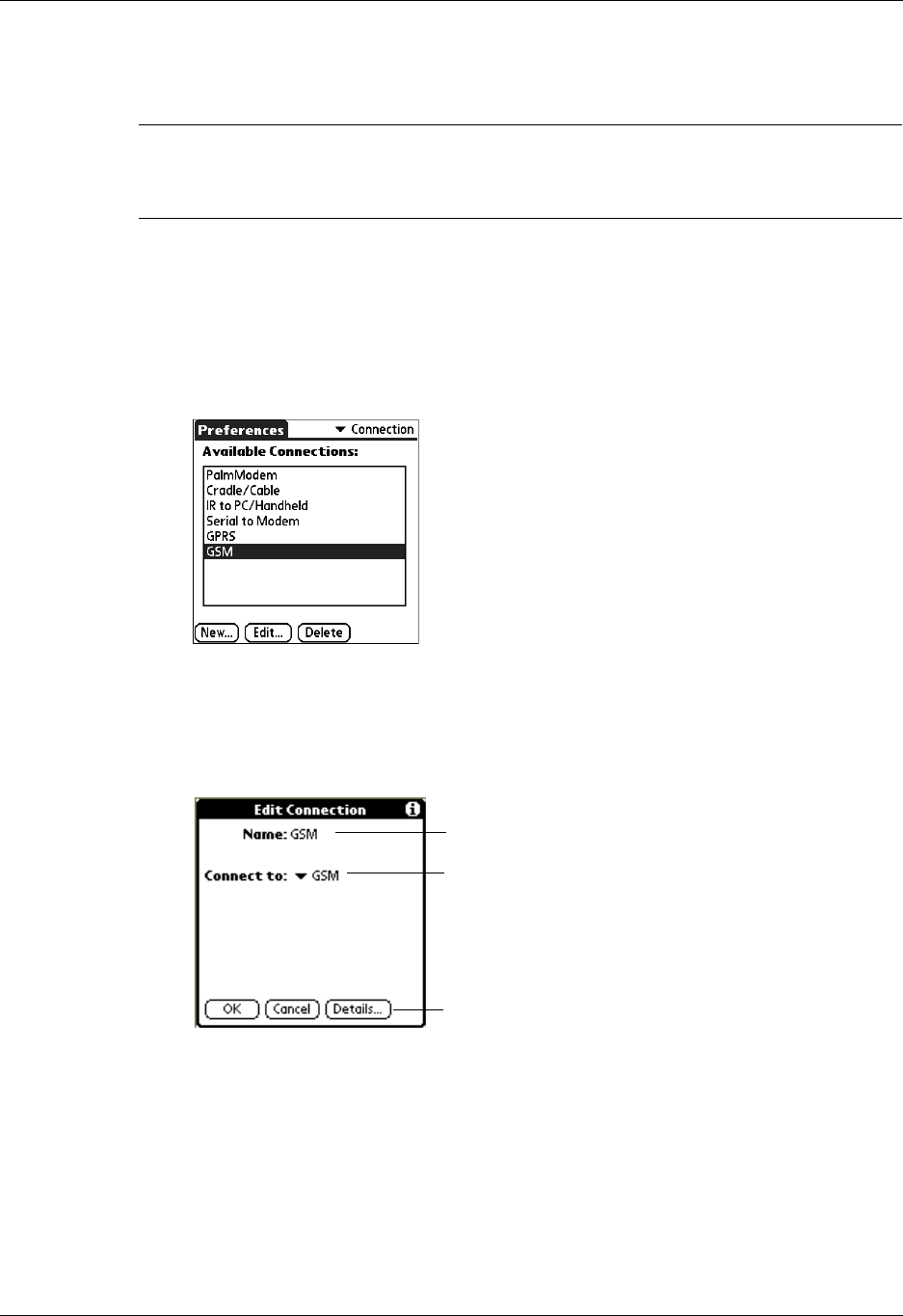
Connection preferences
315
Creating and editing GSM connections
IMPORTANT Your wireless service provider may have set your GSM connection
settings. Changing the settings may affect your service. Contact your wireless service
provider before making changes to the settings.
To create or edit a GSM connection:
1. Do one of the following:
– To add: Tap New.
– To edit: Tap the GSM connection and tap Edit.
2. Do one of the following:
– To add: Enter name and tap Details.
– To edit: Tap Details.
Tap Details
Enter name if new connection
Tap pick list and select GSM
Palm, Inc. Confidential
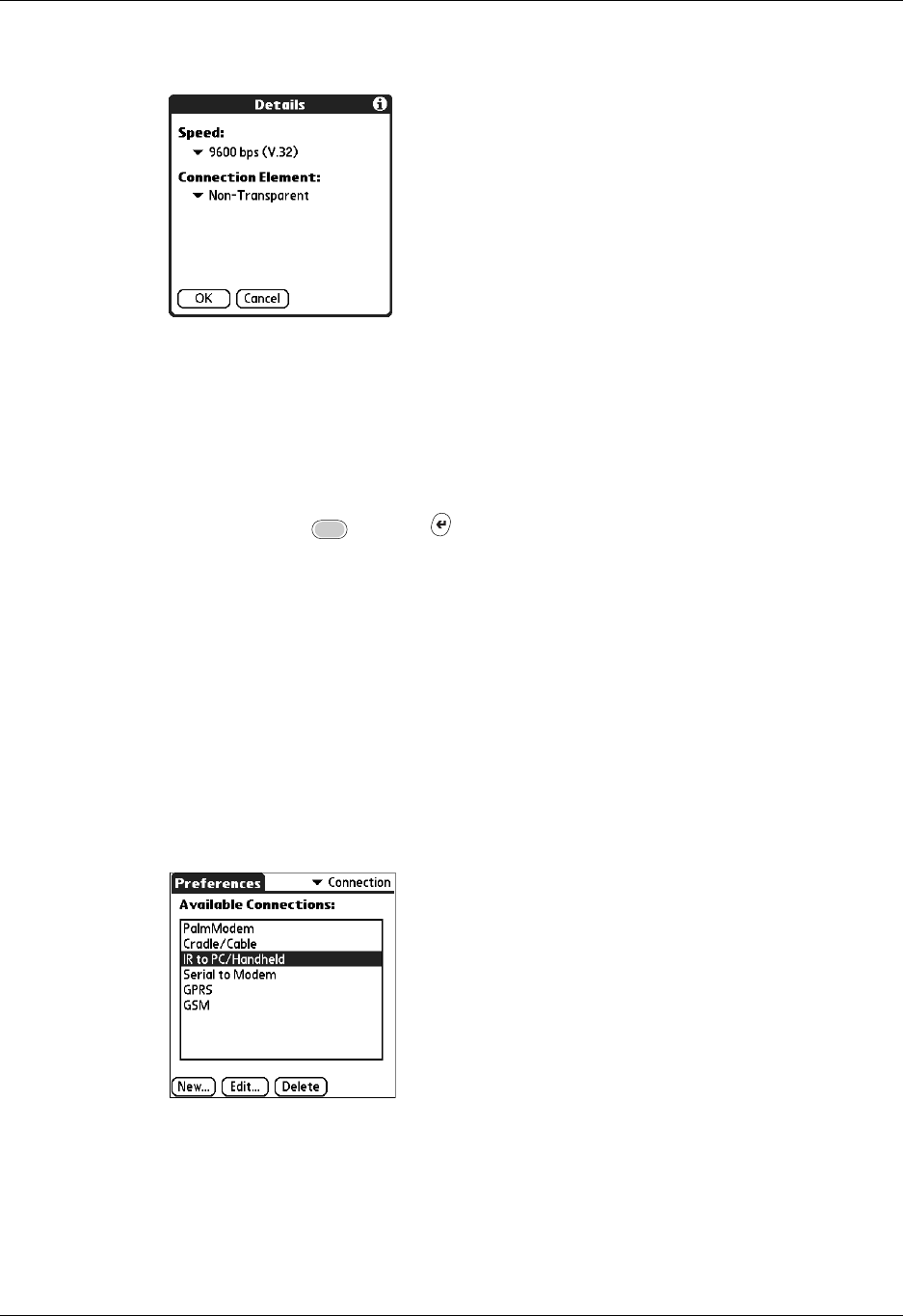
Chapter 21 Setting Preferences for Your Handheld
316
3. Tap the pick lists, select the settings, and then tap OK.
4. Press Function + Enter , or tap OK.
IR to PC connection
The following example shows you how to edit the IR to PC/Handheld connection
to adjust the communication speed; you can similarly edit other connections or
settings or create a custom connection. You can use the IR to PC/Handheld
connection to perform a remote IR HotSync operation. To accomplish the HotSync
operation, your handheld sends data through its IR port to an IR port in your
desktop computer, to synchronize with your Desktop application.
To edit the IR to PC/Handheld connection:
1. Tap the IR to PC/Handheld connection and tap Edit.
2. Tap De ta il s.
Speed Sets the modem rate and protocol used for the connection.
Autobauding automatically negotiates the best modem rate and
protocol at the beginning of the connection.
Connection
Element Sets the connection as Transparent or Non-Transparent.
Palm, Inc. Confidential
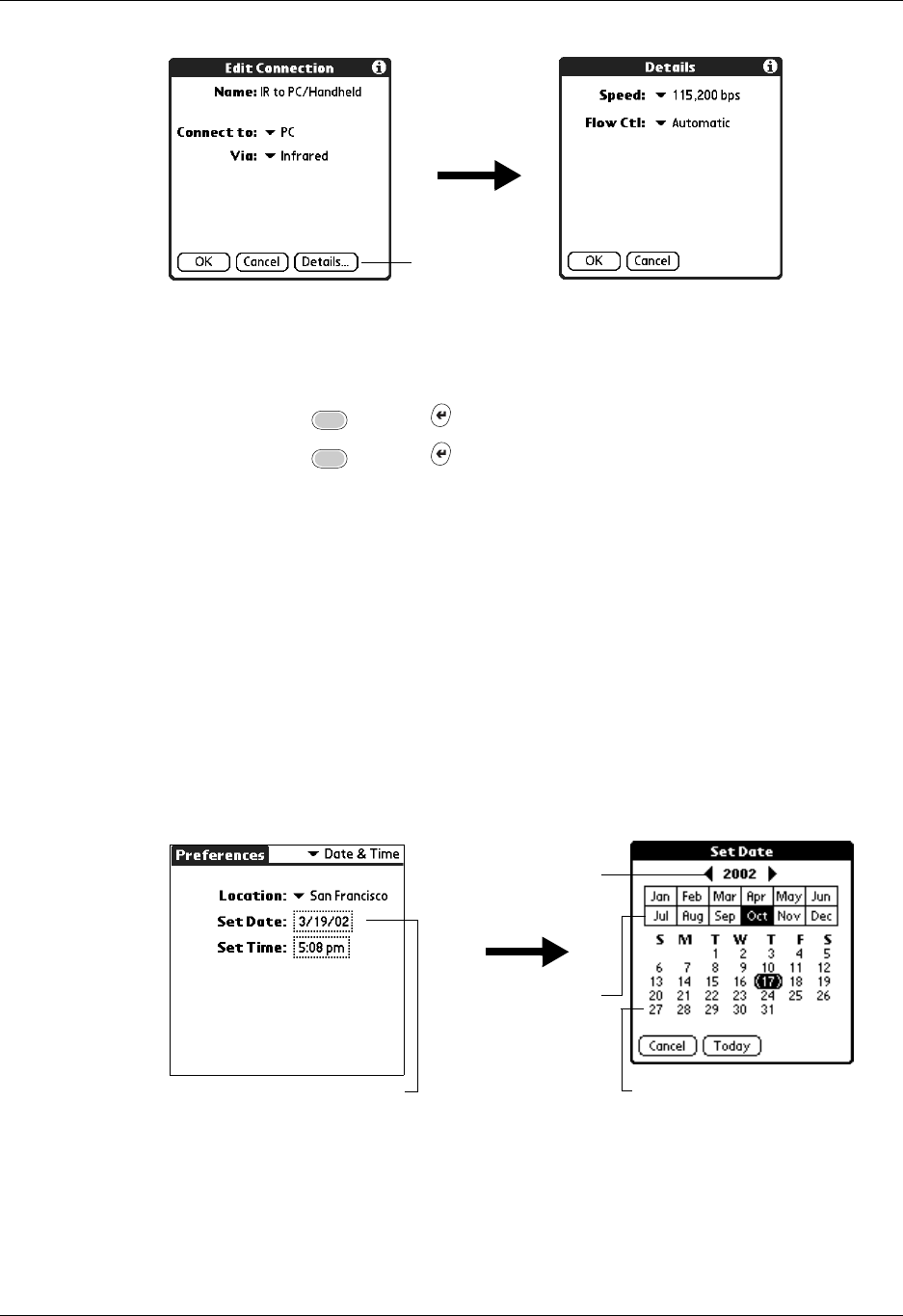
Date and Time preferences
317
3. Tap the Speed pick list and select the appropriate speed.
4. Enter the initialization string supplied by the documentation for the modem
attached to your mobile phone, if necessary.
5. Press Function + Enter , or tap OK.
6. Press Function + Enter , or tap OK again to save the configuration.
After you create the configuration, you need to set up the HotSync Manager of
your Desktop application and the HotSync application of your handheld to
perform a modem HotSync operation.
Date and Time preferences
The Date and Time Preferences screen enables you to set the date, time, time zone,
and Daylight Saving option on your handheld.
To set the date:
1. Tap the Set Date box.
2. Tap the arrows to select the current year.
3. Select a month.
4. Tap the current date.
Ta p
Details
Tap to set date
Tap arrows to
select year
Tap or use the
navigator to select
month
Tap to select date
Palm, Inc. Confidential
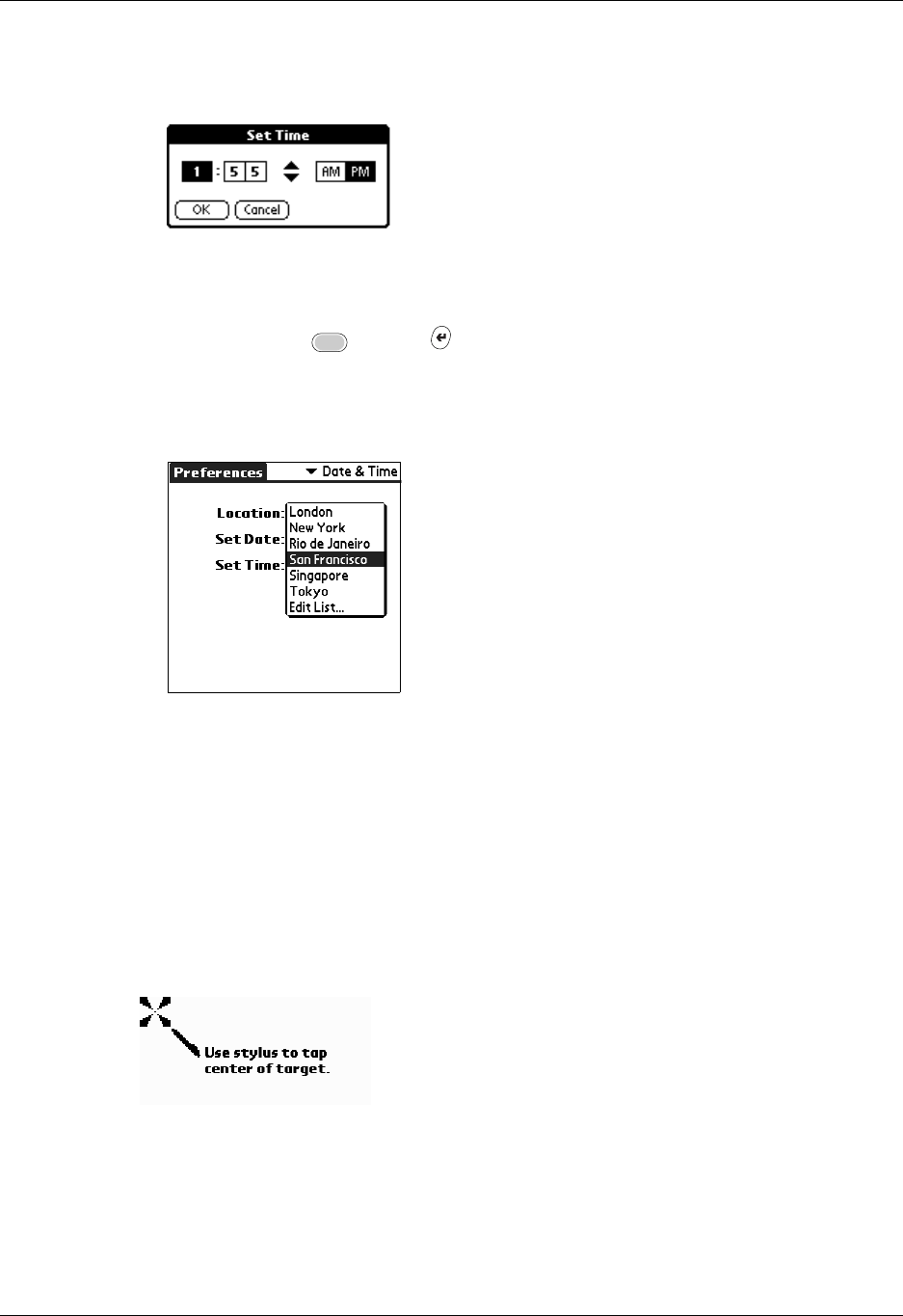
Chapter 21 Setting Preferences for Your Handheld
318
To set the time:
1. Tap the Set Time box.
2. Tap the up or down arrows to change the hour.
3. Tap each number of the minute, and then tap the arrows to change the numbers.
4. Press Function + Enter , or tap OK.
To set the time zone:
1. Tap the Location pick list.
2. Select a time zone.
When you travel, changing the time zone setting to a new time zone
automatically resets the date and time on your handheld, but it does not change
the time of appointments set in Date Book.
Digitizer preferences
The Digitizer Preferences screen opens the digitizer calibration screen. This is the
same screen that appears when you start your handheld for the first time.
You can recalibrate your screen after a hard reset, or if your digitizer drifts.
Palm, Inc. Confidential
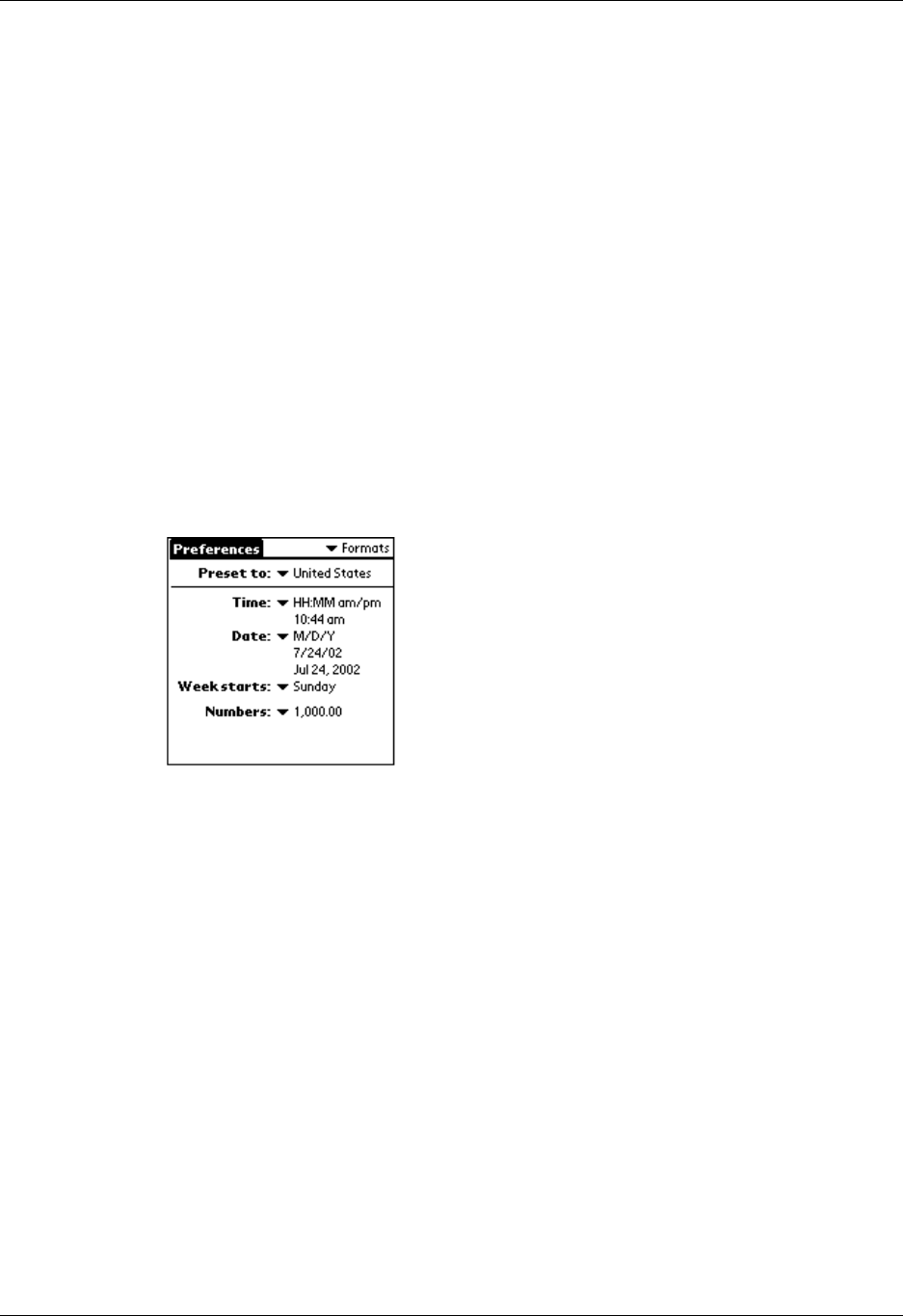
Formats preferences
319
Formats preferences
Use the Formats Preferences screen to set the country default and the display
format of the dates, times, and numbers on your handheld.
Country default
The country default sets date, time, week start day, and number conventions based
on geographic regions where you might use your handheld. For example, in the
United Kingdom, time often is expressed using a 24-hour clock. In the United
States, on the other hand, time is expressed using a 12-hour clock with an AM or
PM suffix.
All your handheld applications use the Country default settings. You can,
however, customize your own preferences as described in “Time, date, week start,
and numbers formats” later in this chapter.
To set the country default:
■Tap the Preset to pick list and select a country.
Time, date, week start, and numbers formats
The Time setting defines the format for the time of day. The time format that you
select appears in all applications on your handheld.
To select the time, date, week start, and numbers format:
1. Tap the Time pick list and select a format.
2. Tap the Date pick list and select a format.
3. Tap the Week starts pick list, and select whether you want the first day of the
week to be Sunday or Monday.
This setting controls the Day, Week, and Month views in Date Book and all
other aspects of your handheld that display a calendar.
4. Tap the Numbers pick list, and select formats for the decimal point and
thousands separator.
Palm, Inc. Confidential

Chapter 21 Setting Preferences for Your Handheld
320
General preferences
The General Preferences screen enables you to set the auto shutoff interval, alarm
options, sounds for your handheld, and the Beam Receive feature.
Auto-off delay
Your handheld has an automatic shutoff feature that activates after a period of
inactivity. This feature turns off the power and backlight but leaves the radio on.
This feature helps conserve battery power in case you forget to turn off your
handheld.
If you find that your handheld shuts itself off before you finish reviewing the
information on the screen, you should increase the time setting of the automatic
shutoff feature.
To set the Auto-off delay:
1. Tap the Auto-off After pick list.
2. Select the setting you want to use for the automatic shutoff feature: 30 seconds,
1 minute, 2 minutes, or 3 minutes.
Cradle settings
You can choose to leave your handheld on when it is in the cradle during a
HotSync operation, or when you are recharging the battery, so you can continue to
view your data.
To change the cradle setting:
■Tap the Stay on in Cradle check box to leave your handheld on when it is in the
cradle.
Palm, Inc. Confidential

General preferences
321
System, alarm, and game sounds
Your handheld uses a variety of sounds. The System, Alarm, and Game Sound
settings enable you to turn the sounds on or off, and to adjust the volume level.
To set the system and alarm sounds:
1. Tap the System Sound pick list and select the sound level.
IMPORTANT When you turn off the System Sounds, you also turn off the “chime”
tones associated with the HotSync operation.
2. Tap the Alarm Sound pick list and select the sound level.
3. Tap the Game Sound pick list and select the sound level.
The Game Sound setting works only with games that are programmed to
respond to this setting. Older games typically do not respond to this setting.
Alarm Vibrate and indicator light settings
You can set alarms in Date Book, Note Pad and World Clock to remind you of
important meetings or notes. When you enable the Alarm Vibrate and indicator
light settings, your handheld vibrates and the indicator light blinks to notify you
of alarms. This is useful whenever you want to turn the Alarm Sound off but still
be notified of alarms.
To set the Alarm Vibrate and indicator light settings:
1. Tap the Alarm Vibrate pick list and select On or Off.
2. Tap the Alarm LED pick list and select On or Off.
Beam Receive
You can choose to turn off the Beam Receive feature. This prohibits anyone from
beaming information to your handheld. It also results in a slight saving of battery
power.
To change the Beam Receive setting:
■Tap the Beam Receive pick list and select On or Off.
Palm, Inc. Confidential
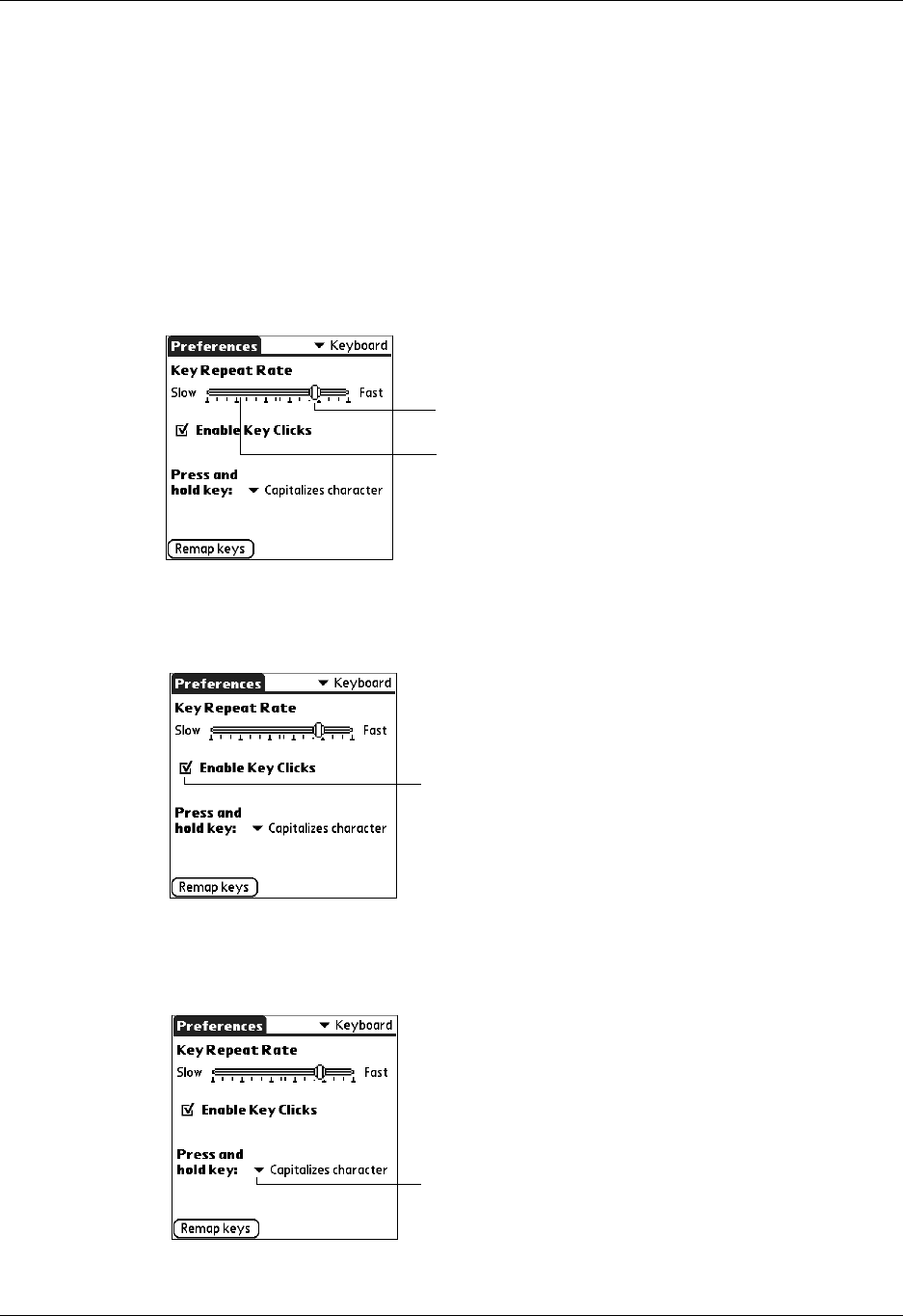
Chapter 21 Setting Preferences for Your Handheld
322
Keyboard Preferences
The Keyboard Preferences screen enables you to customize the keyboard. You can
set how each key responds when pressed or held. You can also remap the character
or function of the key.
Any changes you make in the Keyboard Preferences screen become effective
immediately; you do not have to change to a different screen or application.
To set the key repeat rate:
■Move the slider or tap the adjustment bar.
To set key clicking:
■Tap check box to enable or disable key clicking.
To set key press-and-hold functionality:
■Tap the Press and hold key pick list, and select the function.
Move the slider
Tap the adjustment bar
Tap check box
Tap pick list and select function
Palm, Inc. Confidential
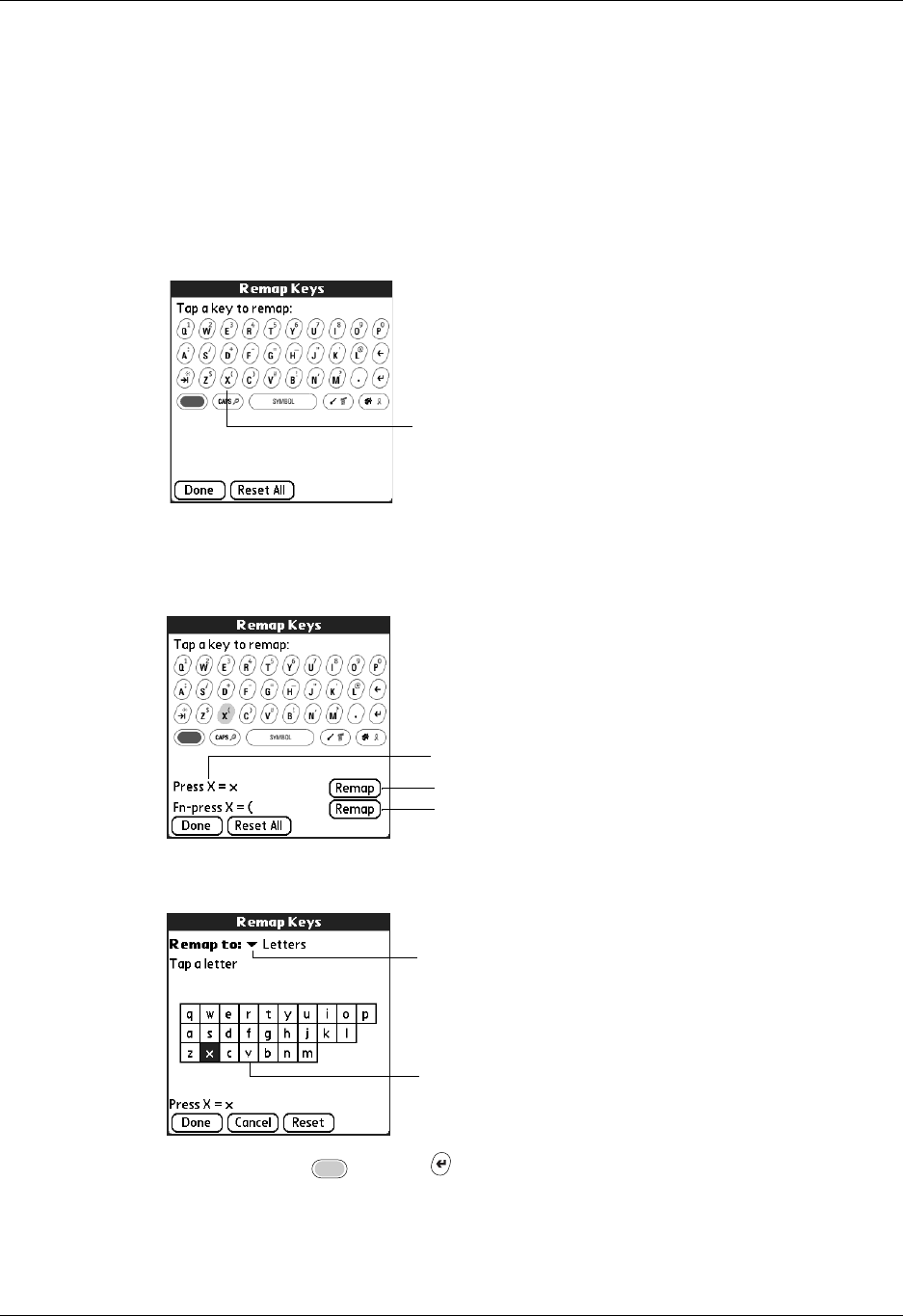
Keyboard Preferences
323
Remapping keys
Keys can be remapped from their default function to any of the keys or buttons
available on the handheld, including the Function keys.
To remap a key:
1. Tap Remap keys.
2. Tap a key.
3. Tap Remap.
You can chose to remap the key and the Function + key combination.
4. Tap Save .
5. Press Function + Enter , or tap Done.
Ta p a k e y
Mapping function
Tap to remap Function + key combination
Tap to remap key
Tap pick list and select keyboard
Tap character
Palm, Inc. Confidential
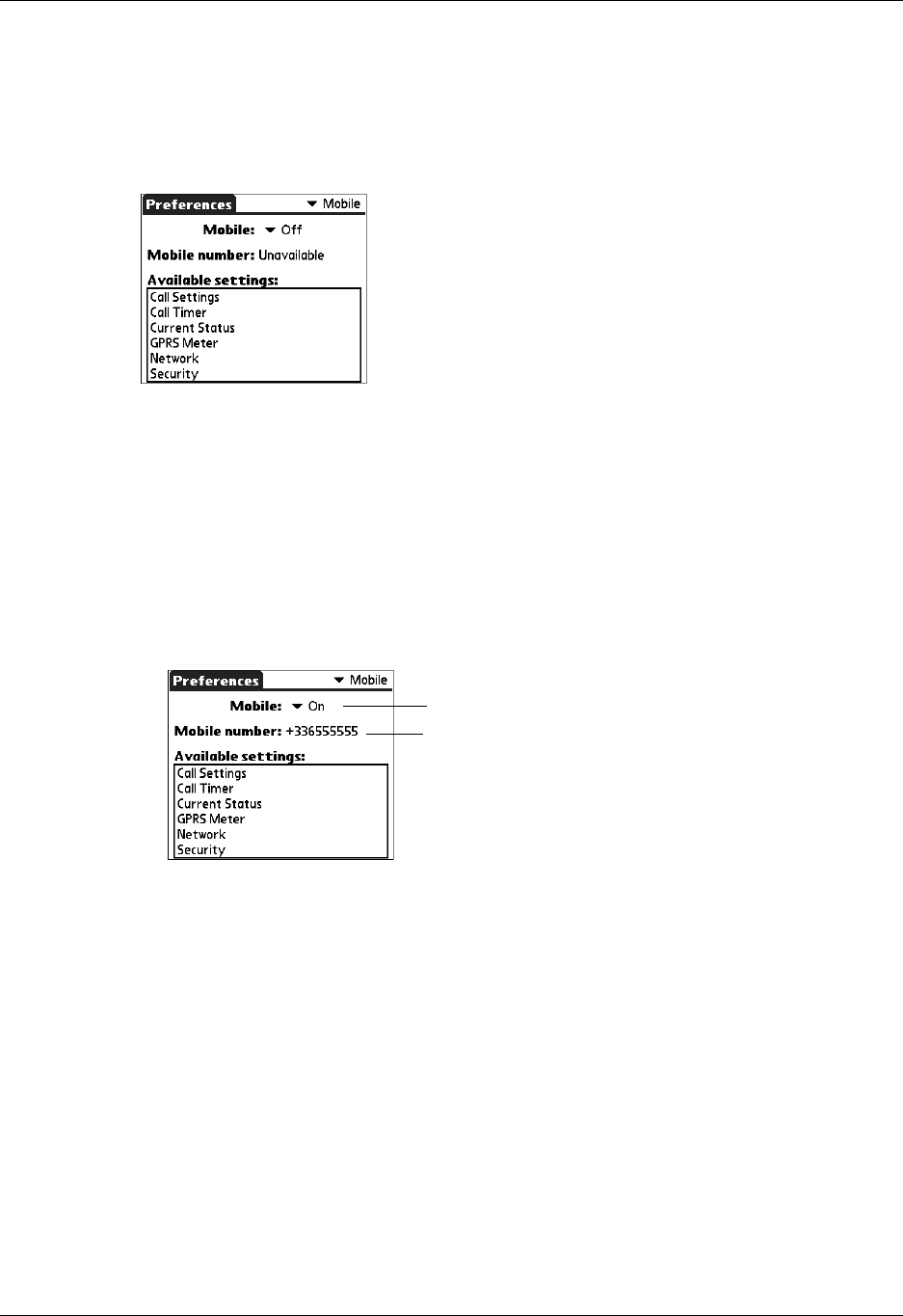
Chapter 21 Setting Preferences for Your Handheld
324
Mobile preferences
The Mobile Preferences screen allows you to view and configure many of the
wireless settings for the applications sharing configuration settings. You can also
turn the mobile radio on and off.
Turning the mobile radio on and off
When you open a wireless application, the radio dialog box automatically appears
if the mobile radio is turned off. You can also turn on the mobile radio from the
Mobile Preferences screen.
To turn the mobile radio on or off:
■Tap the Mobile pick list and select On or Off.
Enabling call waiting
NOTE Call waiting is a subscriber service that may be provided by your wireless
service provider. Contact your wireless service provider for information.
Call waiting lets you accept an incoming call when you have a currently active call.
You are notified of the incoming call by a sound and a dialog box.
Tap Mobile pick list to turn on and off mobile radio
Mobile number read from SIM card
Palm, Inc. Confidential
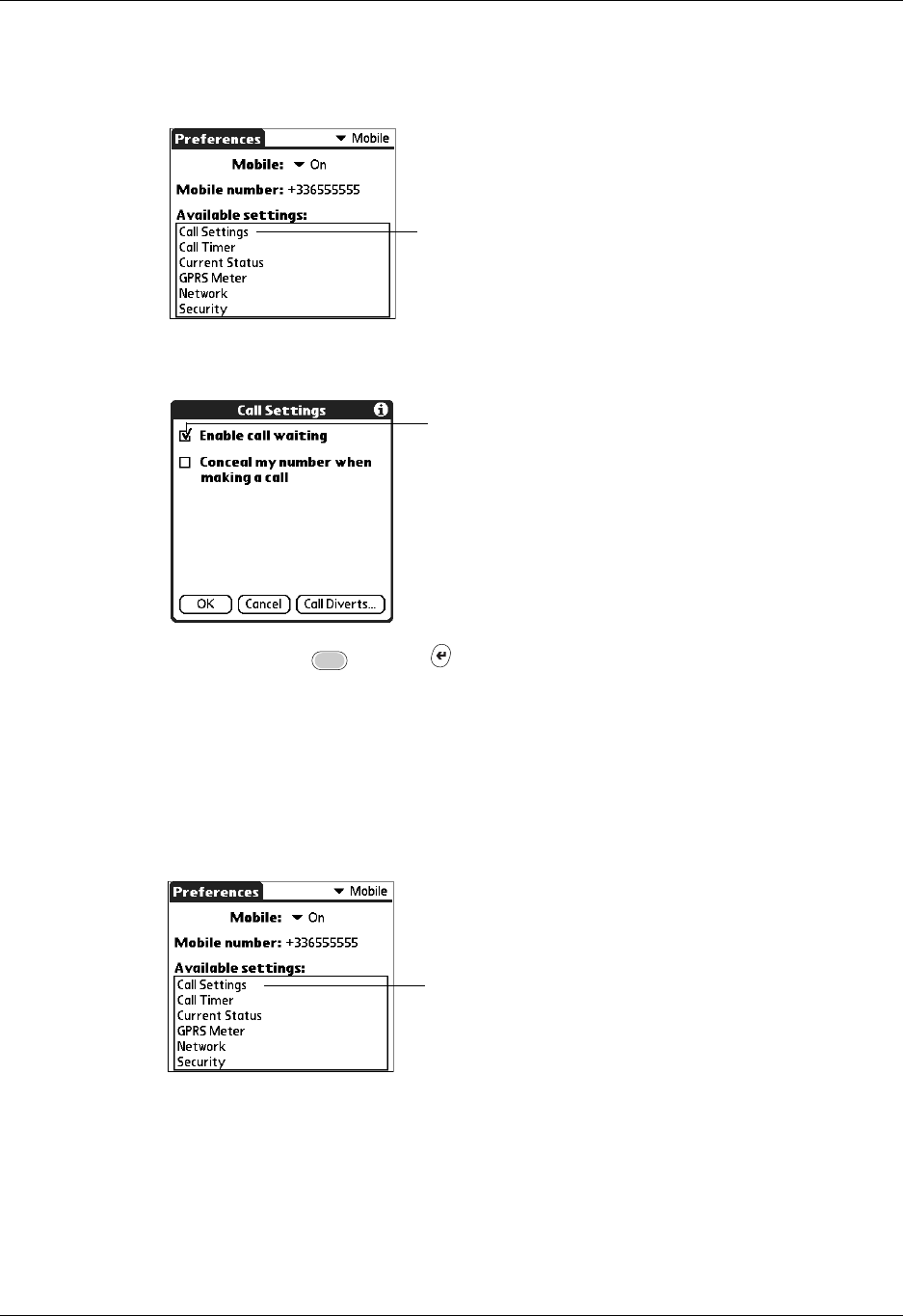
Mobile preferences
325
To enable or disable call waiting:
1. Tap Call Settings.
2. Tap the Enable call waiting check box to select or deselect it.
3. Press Function + Enter , or tap OK.
Concealing your number
You can conceal (block) or display your number when making a call.
To conceal or display your number:
1. Tap Call Settings.
2. Tap the Conceal my number when making a call check box.
Tap Call Settings
Ta p ch e ck b ox
Tap Call Settings
Palm, Inc. Confidential
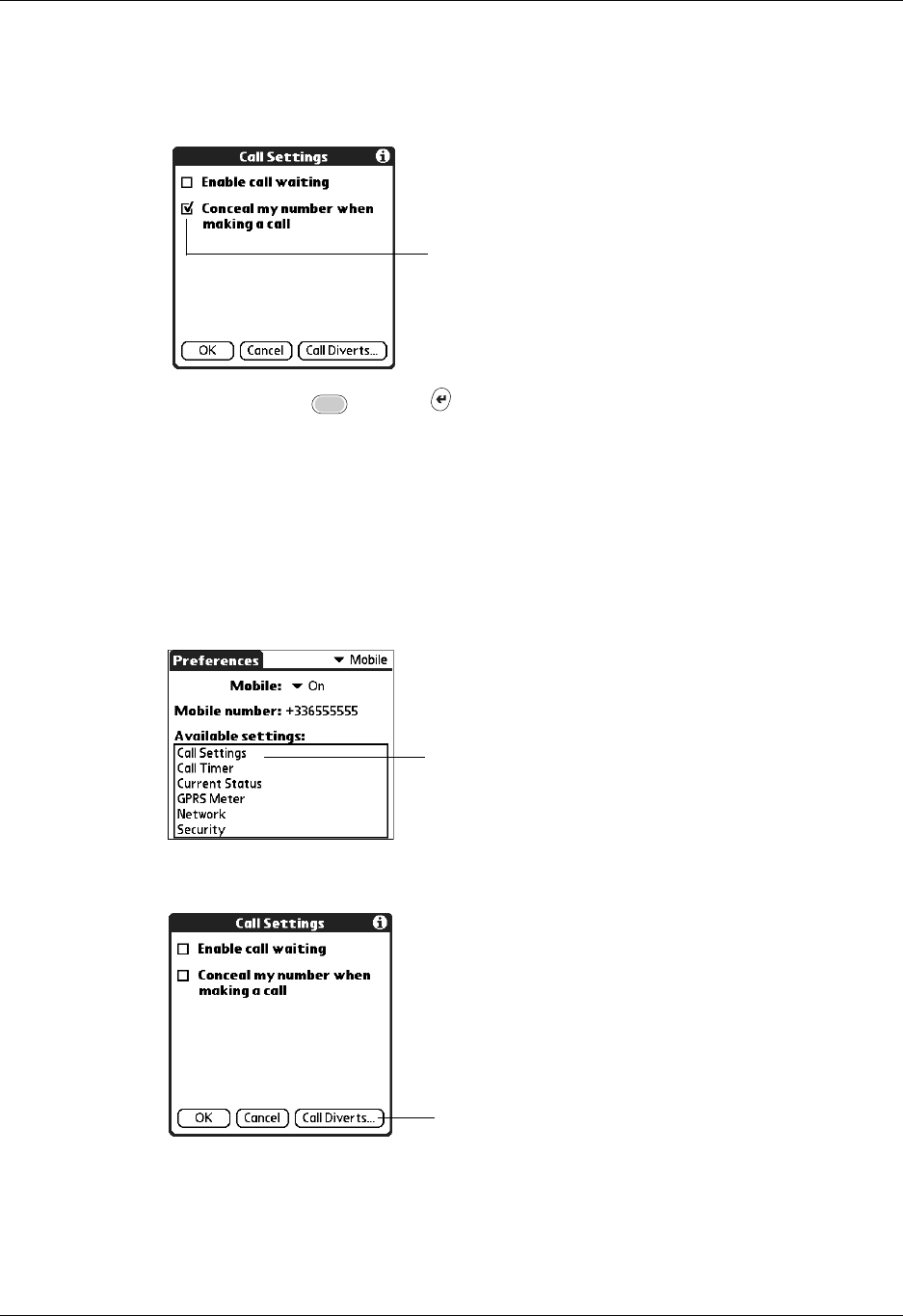
Chapter 21 Setting Preferences for Your Handheld
326
A checkmark appears, indicating that your number is concealed from the
recipient when you place a call. Leave the check box blank to display your
number to the recipient when you place a call.
3. Press Function + Enter , or tap OK.
Diverting your calls
You can divert (forward) your phone calls, e-mail messages, and faxes to different
numbers.
To divert your phone calls:
1. Tap Call Settings.
2. Tap Call Diverts.
Tap check box
Tap Call Settings
Tap Call Diverts
Palm, Inc. Confidential
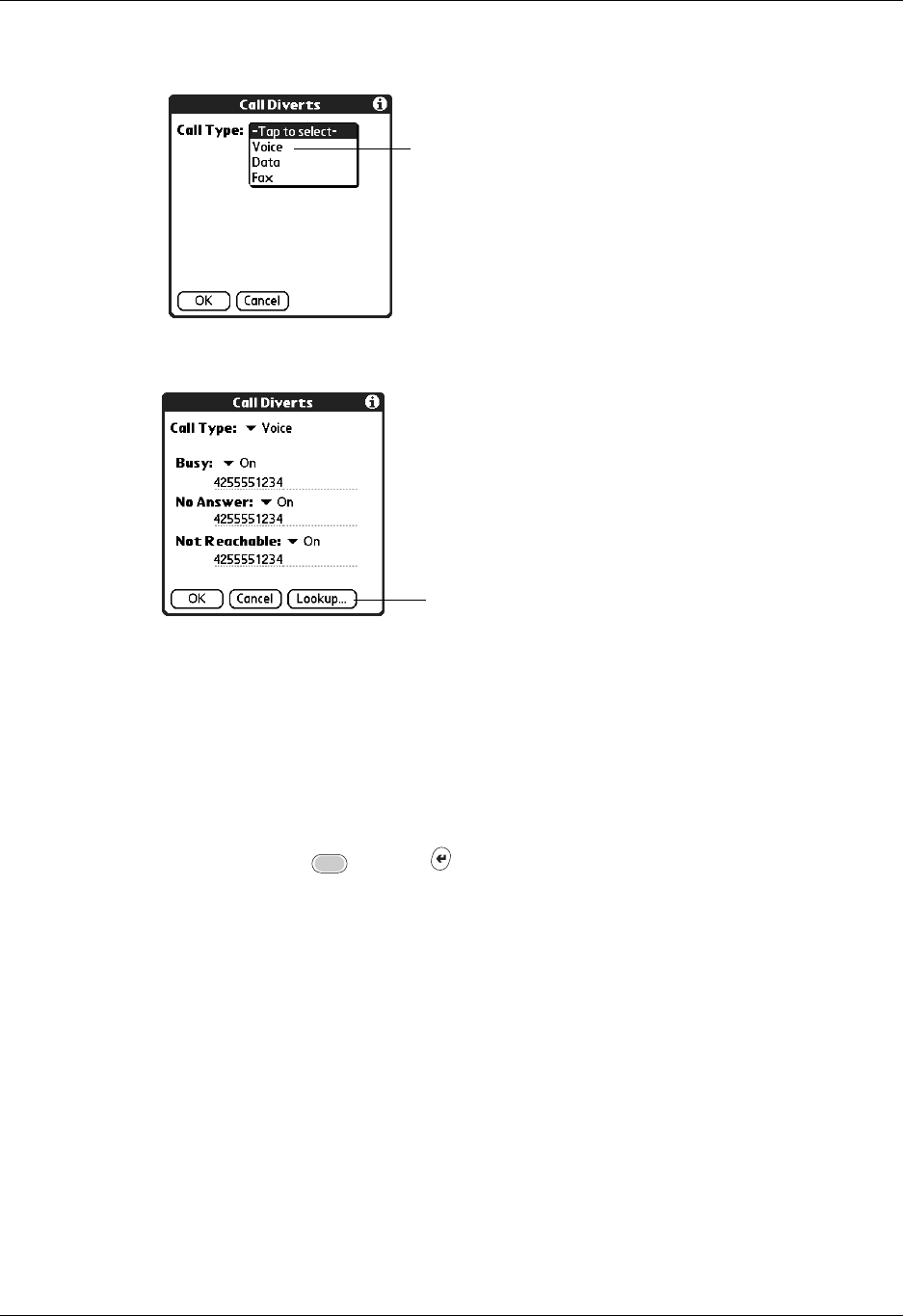
Mobile preferences
327
3. Tap the Call Type pick list and select Voice.
4. Tap a selection and select On.
5. Enter a phone number for the selection.
6. Press Function + Enter , or tap OK.
Busy If the line is busy, diverts call to phone number.
No Answer If the call is not answered, diverts call to phone number.
Not
Reachable If the mobile radio is out of range, diverts call to phone number.
Tap Voice
Tap Lookup to access your Address Book
Palm, Inc. Confidential
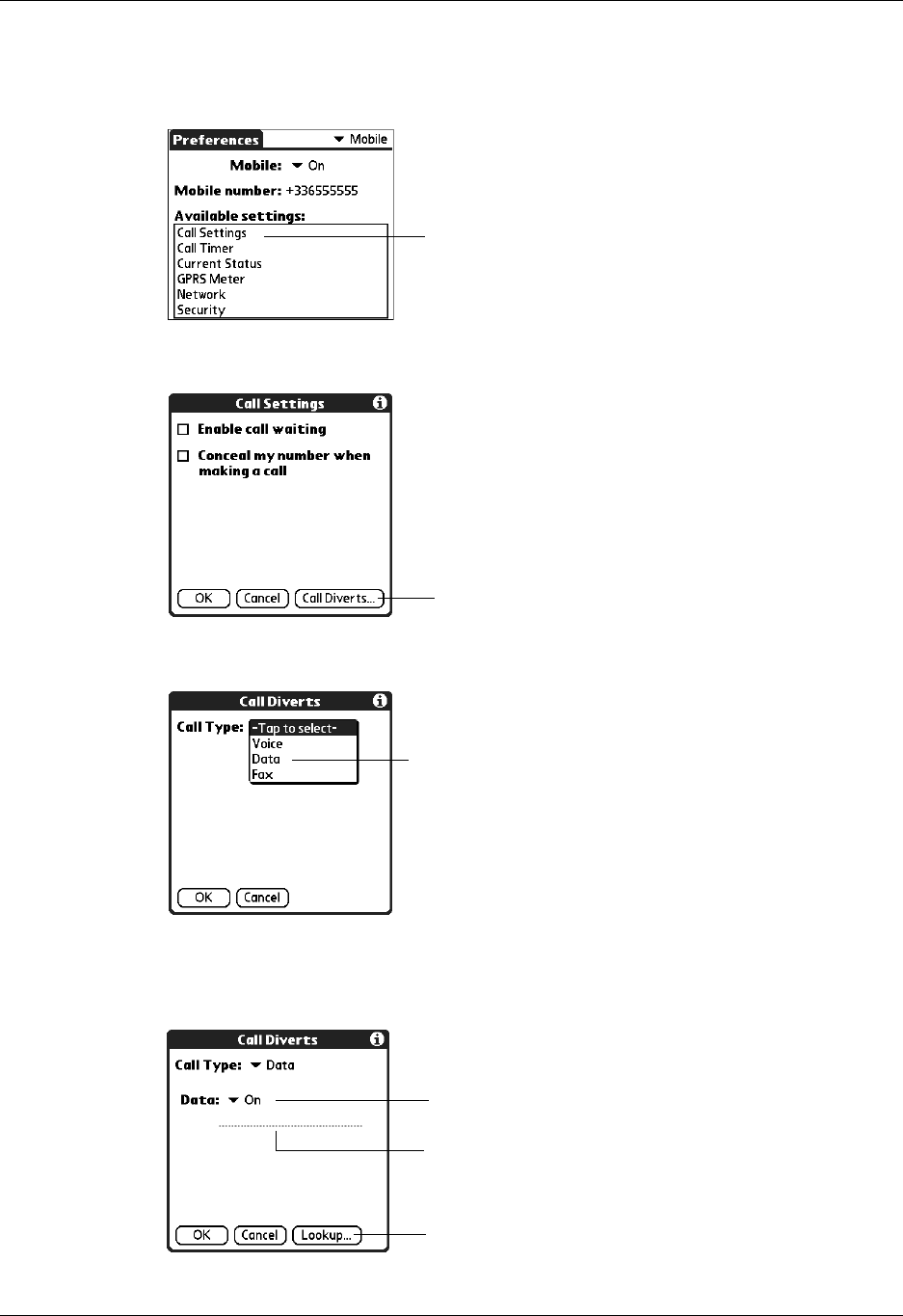
Chapter 21 Setting Preferences for Your Handheld
328
To divert your e-mail:
1. Tap Call Settings.
2. Tap Call Diverts.
3. Tap the Call Type pick list and select Data.
4. Tap the Data pick list and select On.
5. Enter the number.
Tap Call Settings
Tap Call Diverts
Ta p D a t a
Tap the Data pick list and select On
Tap Lookup to access your Address Book
Enter number
Palm, Inc. Confidential
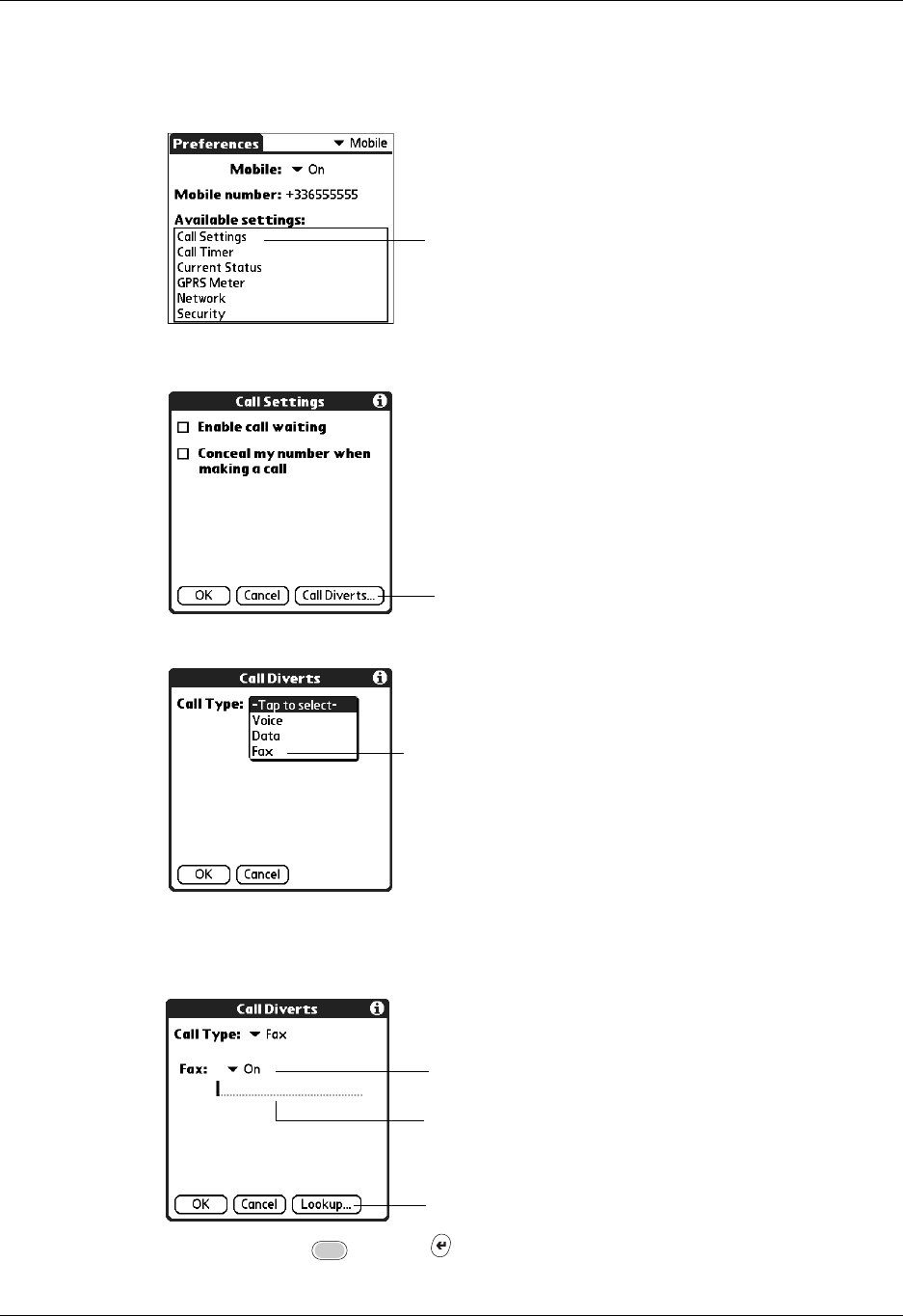
Mobile preferences
329
To divert your Fax messages:
1. Tap Call Settings.
2. Tap Call Diverts.
3. Tap the Call Type pick list and select Data.
4. Tap the Fax pick list and select On.
5. Enter the number.
6. Press Function + Enter , or tap OK.
Tap Call Settings
Tap Call Diverts
Ta p F a x
Tap the Data pick list and select On
Tap Lookup to access your Address Book
Enter the number
Palm, Inc. Confidential
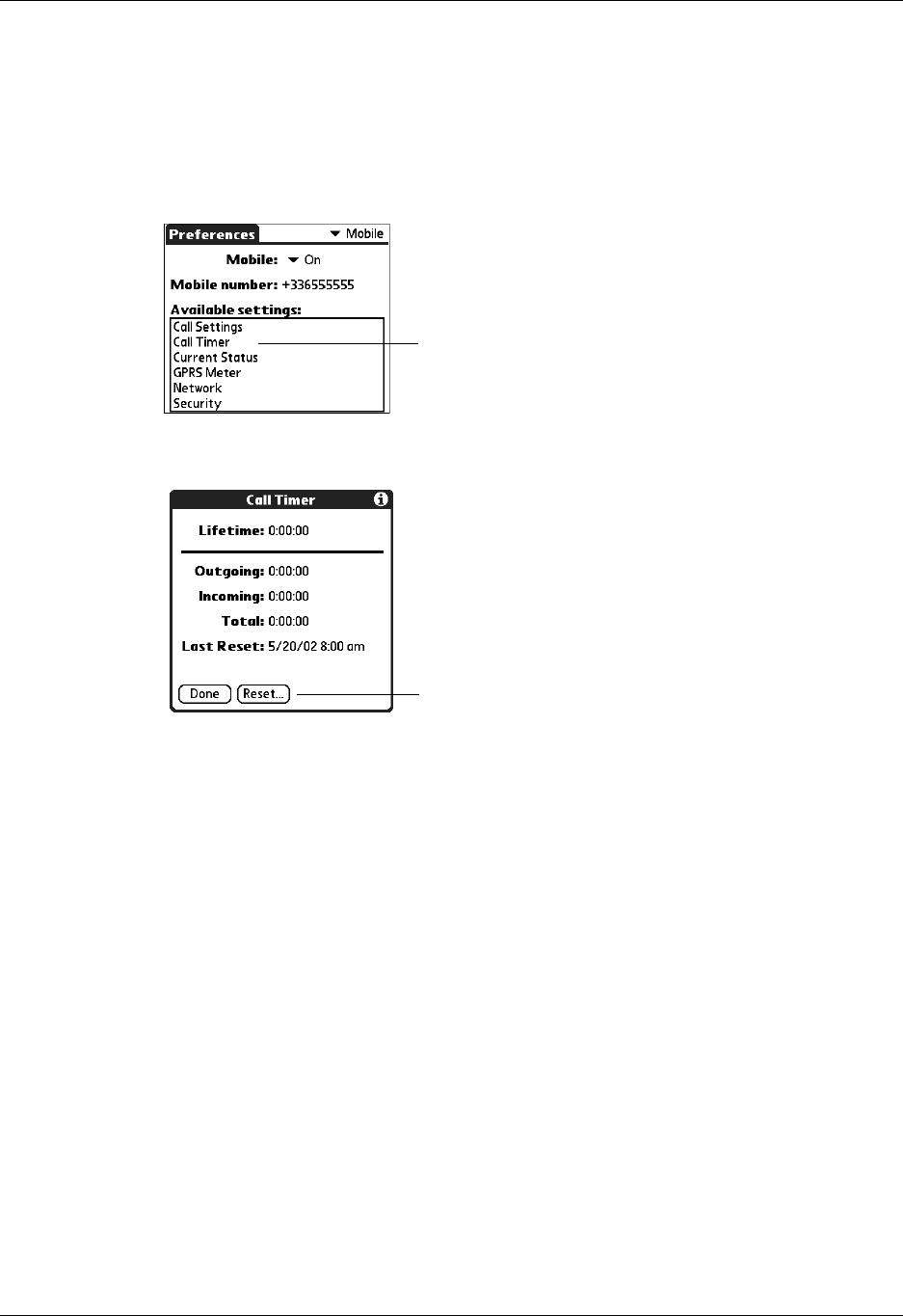
Chapter 21 Setting Preferences for Your Handheld
330
Tracking your phone time
You can track your phone usage using the Call Timer screen.
To check your phone call timer settings:
1. Tap Call Timer.
2. Check your phone usage statistics.
Check the following statistics:
Lifetime Total amount of time spent on calls for the life of your mobile (it
cannot be reset)
Outgoing Amount of time spent on outgoing calls since last reset
Incoming Amount of time spent on incoming calls since last reset
To t a l Total amount of time spent on outgoing and incoming calls since
last reset
Last Reset Date and time you last reset the call timer to zero
Tap Call Timer
Tap to reset call timer for outgoing and incoming
calls to zero
Palm, Inc. Confidential
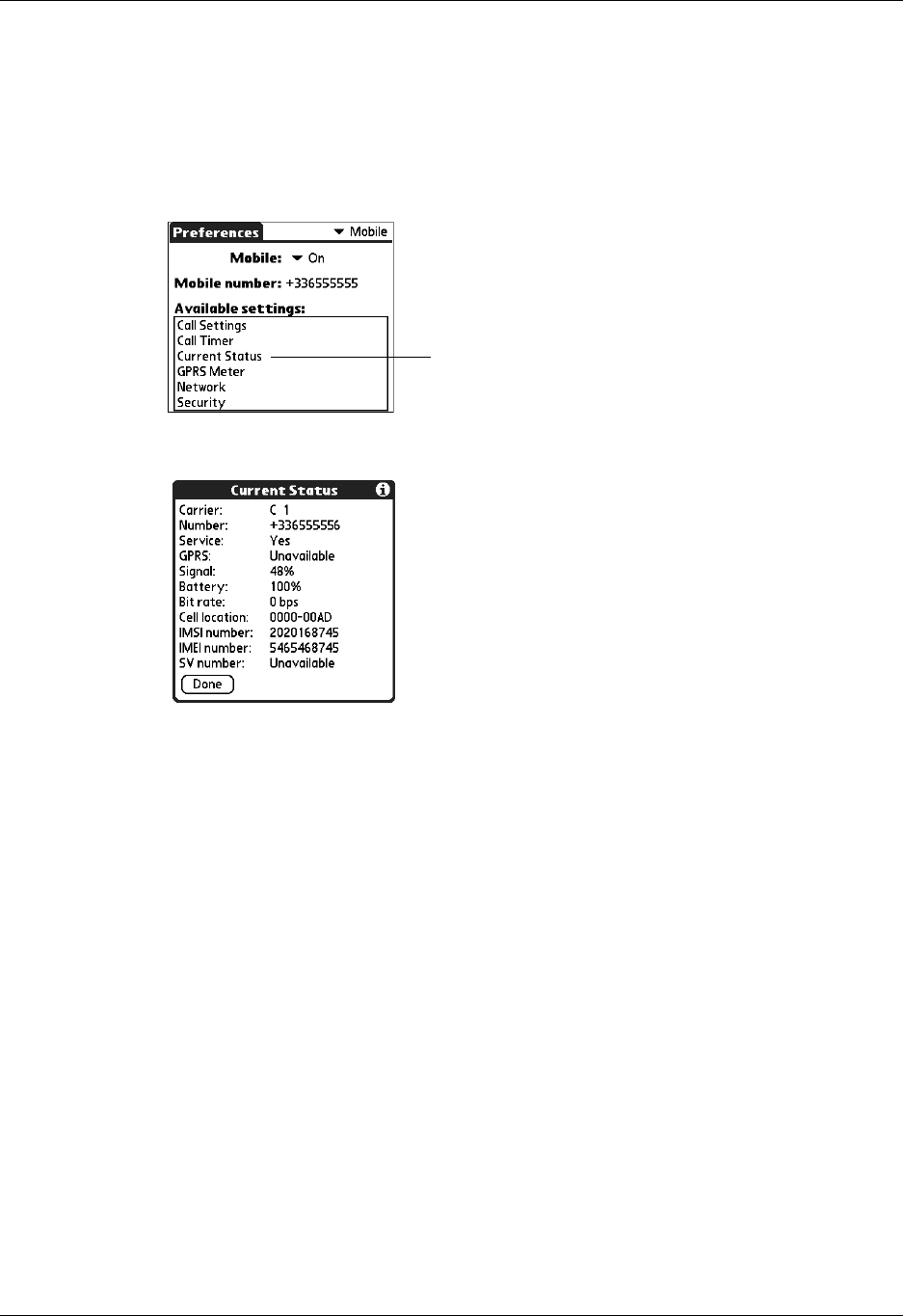
Mobile preferences
331
Checking your current status
You can check your current status related to your handheld and network access.
To check your current status statistics:
1. Tap Current Status.
2. Check your current status statistics.
Check the following statistics:
Carrier Name of your mobile carrier
Number Your mobile phone number
Service Indicates if voice service is available
GPRS Indicates the current status of your GPRS data service
Signal Percentage of signal strength
Battery Percentage of battery strength remaining
Bit rate Throughput rate measured in bits-per-second
Cell location Cell location and tower assigned to your mobile
IMSI number International Mobile Subscriber Identity assigned to your SIM card
IMEI number Your mobile International Mobile Equipment Identity number
SV number Your mobile Software Version number
Tap Current Status
Palm, Inc. Confidential
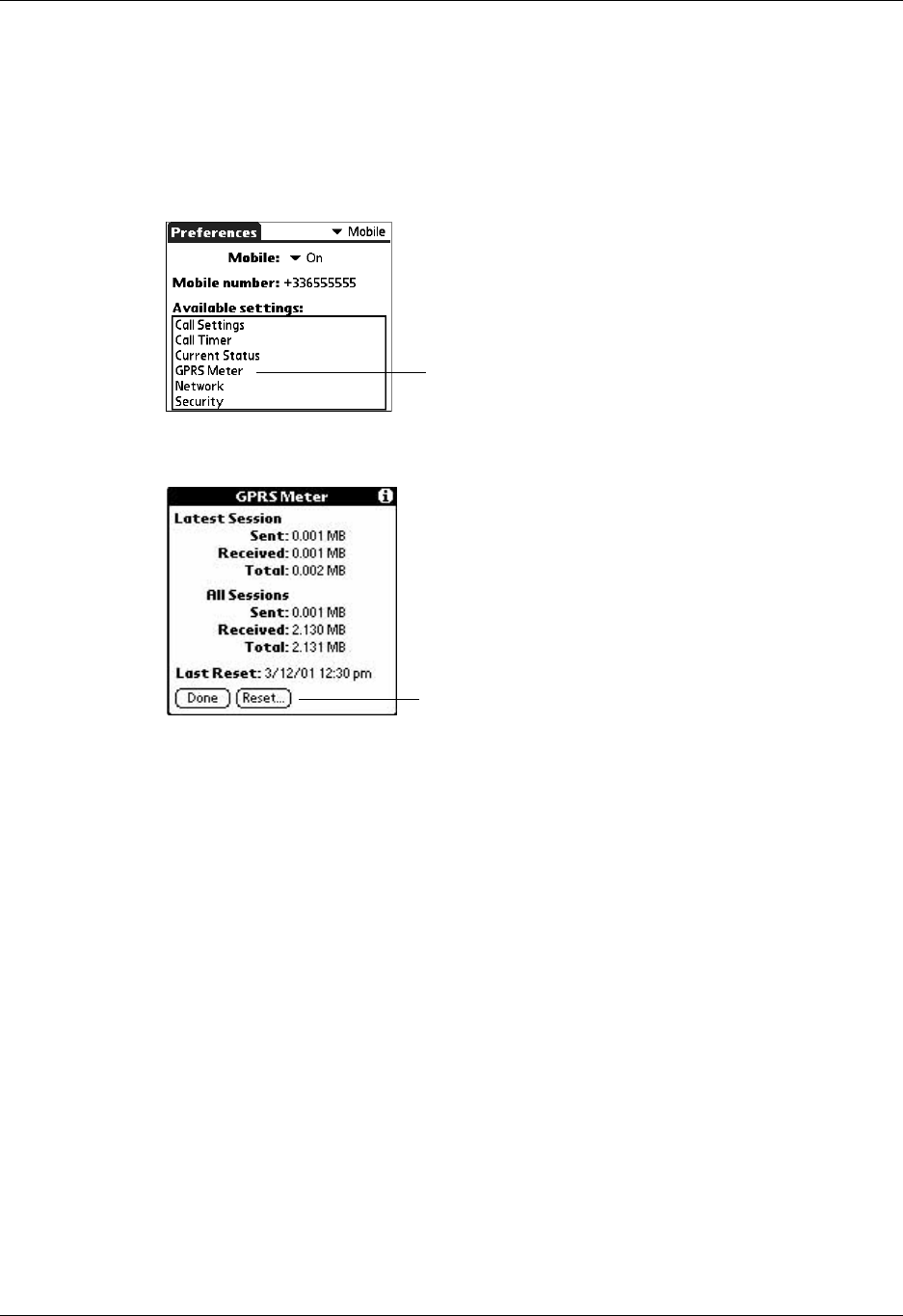
Chapter 21 Setting Preferences for Your Handheld
332
Checking your GPRS network usage
You can check your GPRS network usage.
To check your GPRS network usage:
1. Tap GPRS Meter.
2. Check your current GPRS statistics.
Check the following statistics:
Latest
Session Amount of information tracked (sent, received, and total)
during your latest or current session since last reset
All Sessions Amount of information tracked (sent, received, and total) on all
sessions since last reset
Last Reset Date and time of last reset
Tap GPRS Meter
Tap to reset meter
Palm, Inc. Confidential
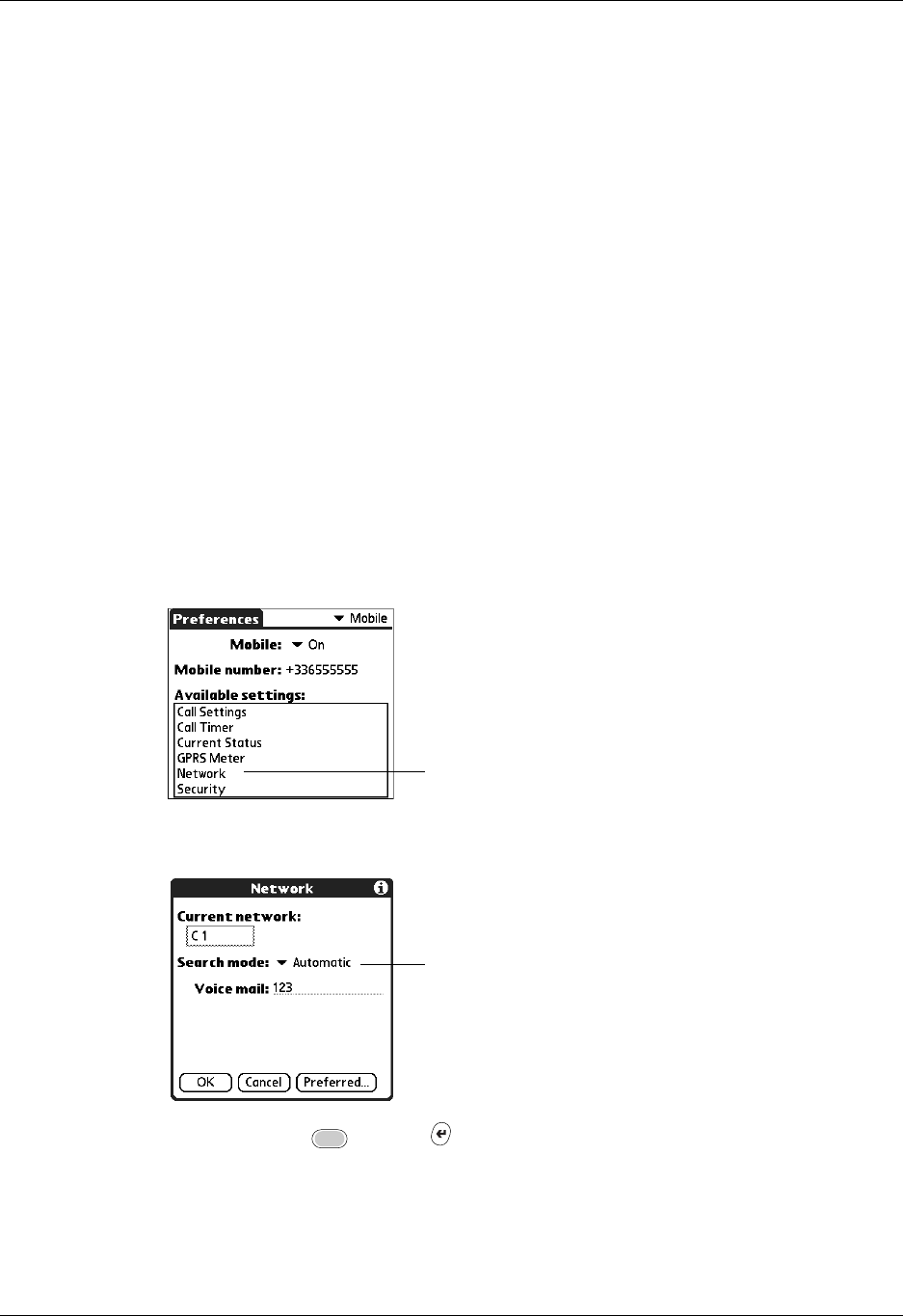
Mobile preferences
333
Setting your network selection search mode
The Search mode setting allows you to specify how the phone will register with a
network carrier during mobile radio power-on. The following two options are
available:
To set your network search mode:
1. Tap Network.
2. Tap the Search mode pick list and select Automatic or Manual.
3. Press Function + Enter , or tap OK.
Automatic The phone attempts to register with the home network during
mobile radio power-on. If the home network is not available, the
phone automatically attempts to register with the next available
network (if any). The phone attempts to register with each available
network until registration succeeds or registration with each
available network fails. The search order for network registration is
home network, preferred carriers, and other carriers, respectively.
Manual The phone attempts to register with the home network during
mobile radio power-on. If the home network is not available, a
dialog box listing all the available networks is displayed for your
selection.
Tap Network
Tap pick list to select network search mode
used during mobile radio power-on
Palm, Inc. Confidential
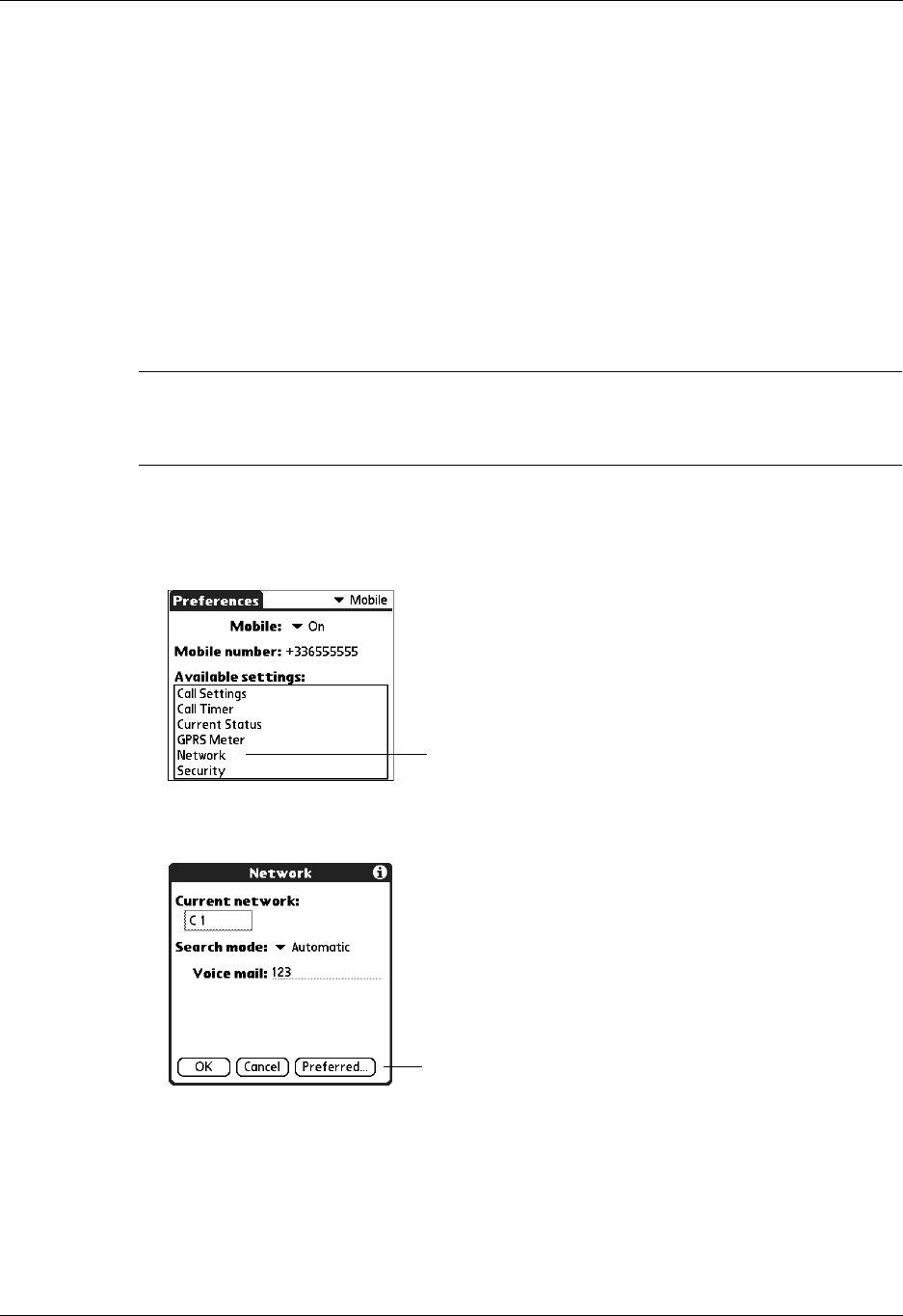
Chapter 21 Setting Preferences for Your Handheld
334
Viewing and editing your preferred networks list
If your home carrier is not available, your mobile registers with the next preferred
network on your preferred networks list. You can view and edit your preferred
networks. The networks are listed in order of priority, with the most preferred at
the top. You can sort the priority list.
You can also add and remove networks. The user can add networks to the
Preferred list by entering a new network ID or by selecting a network from the
Known or Available lists. Networks are excluded from the Known and Available
lists if they are already in the preferred list. This prevents duplicate networks from
being added to the preferred list. Only one network can be added at a time.
IMPORTANT Some wireless service providers restrict editing privileges for the
Preferred Networks list. If the list is restricted, you can read the list, but you are
unable to edit it.
To view the Preferred Networks list:
1. Tap Network.
2. Tap Preferred.
Tap Network
Ta p Pre f erre d
Palm, Inc. Confidential
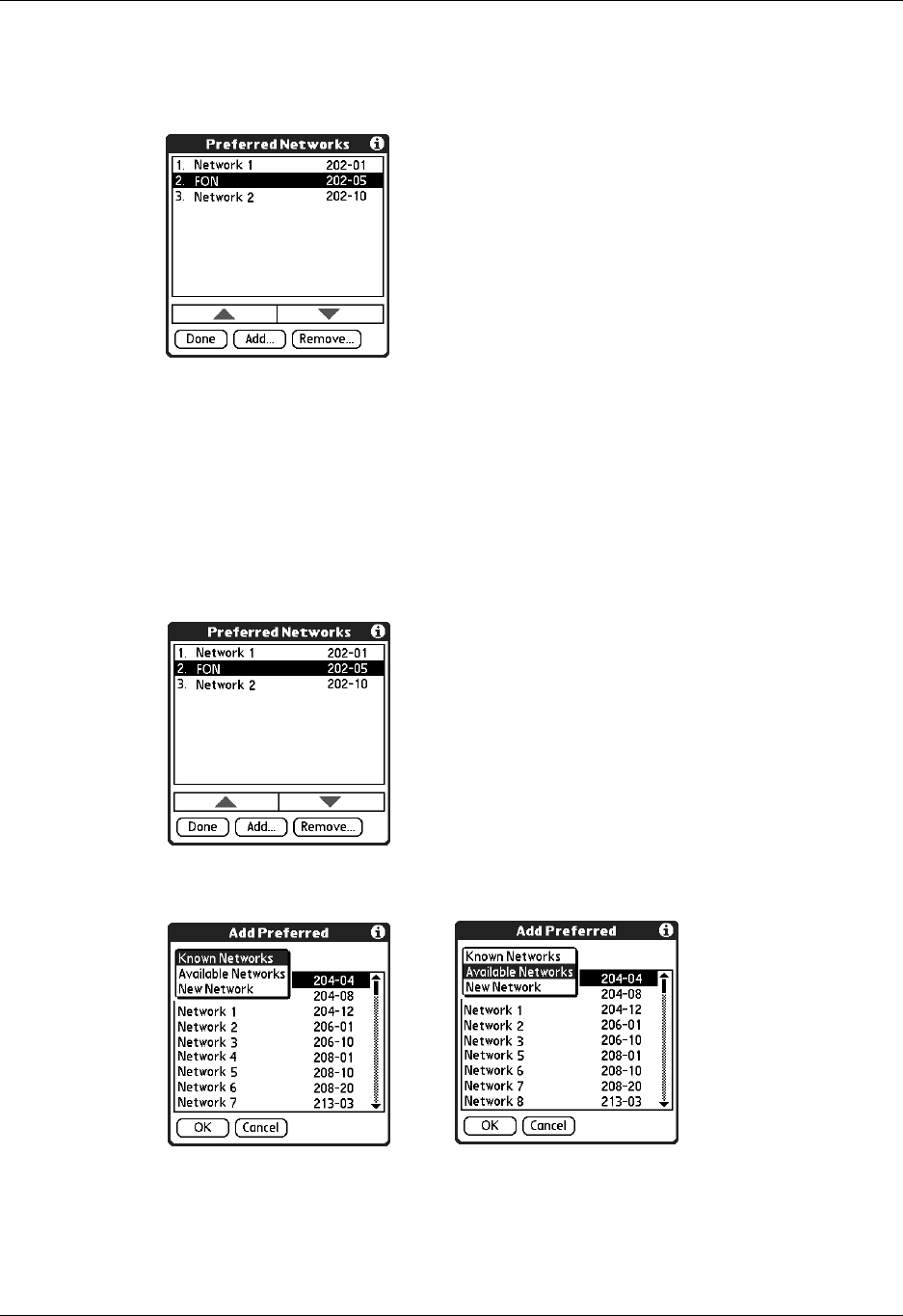
Mobile preferences
335
3. View the Preferred Networks list.
Networks are listed in order of priority, with the most preferred at the top.
To sort priority in the Preferred Networks list:
■Select a network and tap the up or down arrow buttons.
To remove a network:
■Select a network and tap Remove.
To add a network to the Preferred Networks list from your Known or Available Networks:
1. Tap Add.
2. Tap the upper-left pick list and select Known Networks or Available Networks.
Palm, Inc. Confidential
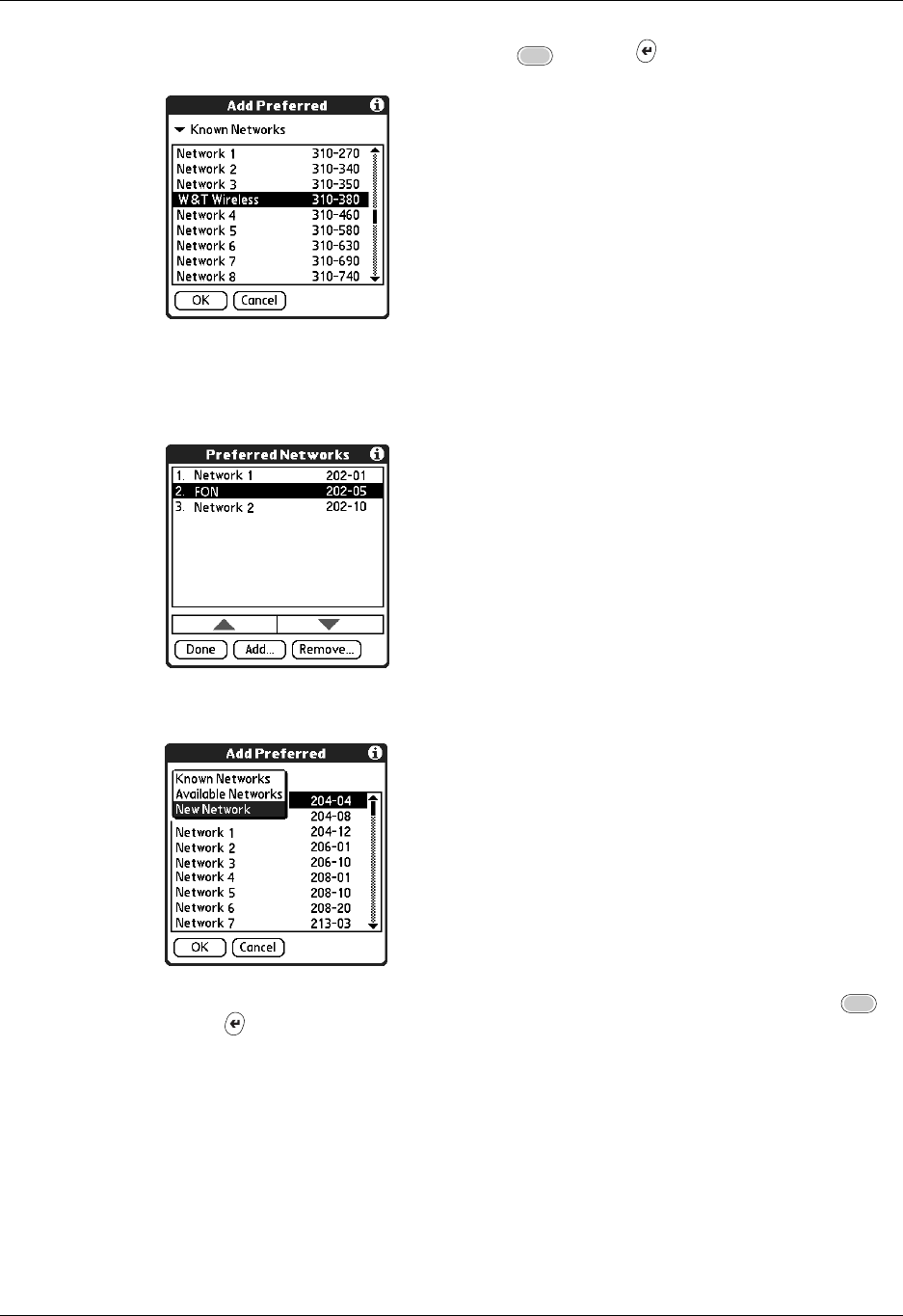
Chapter 21 Setting Preferences for Your Handheld
336
3. Select a network, and press Function + Enter , or tap OK.
To add a network to the Preferred Networks list by specifying a network ID:
1. Tap Add.
2. Tap the upper-left pick list and select New Network.
3. Enter the five- or six-digit network ID number, and then press Function +
Enter , or tap OK.
If you don’t know the ID, contact the new network (mobile carrier).
Palm, Inc. Confidential
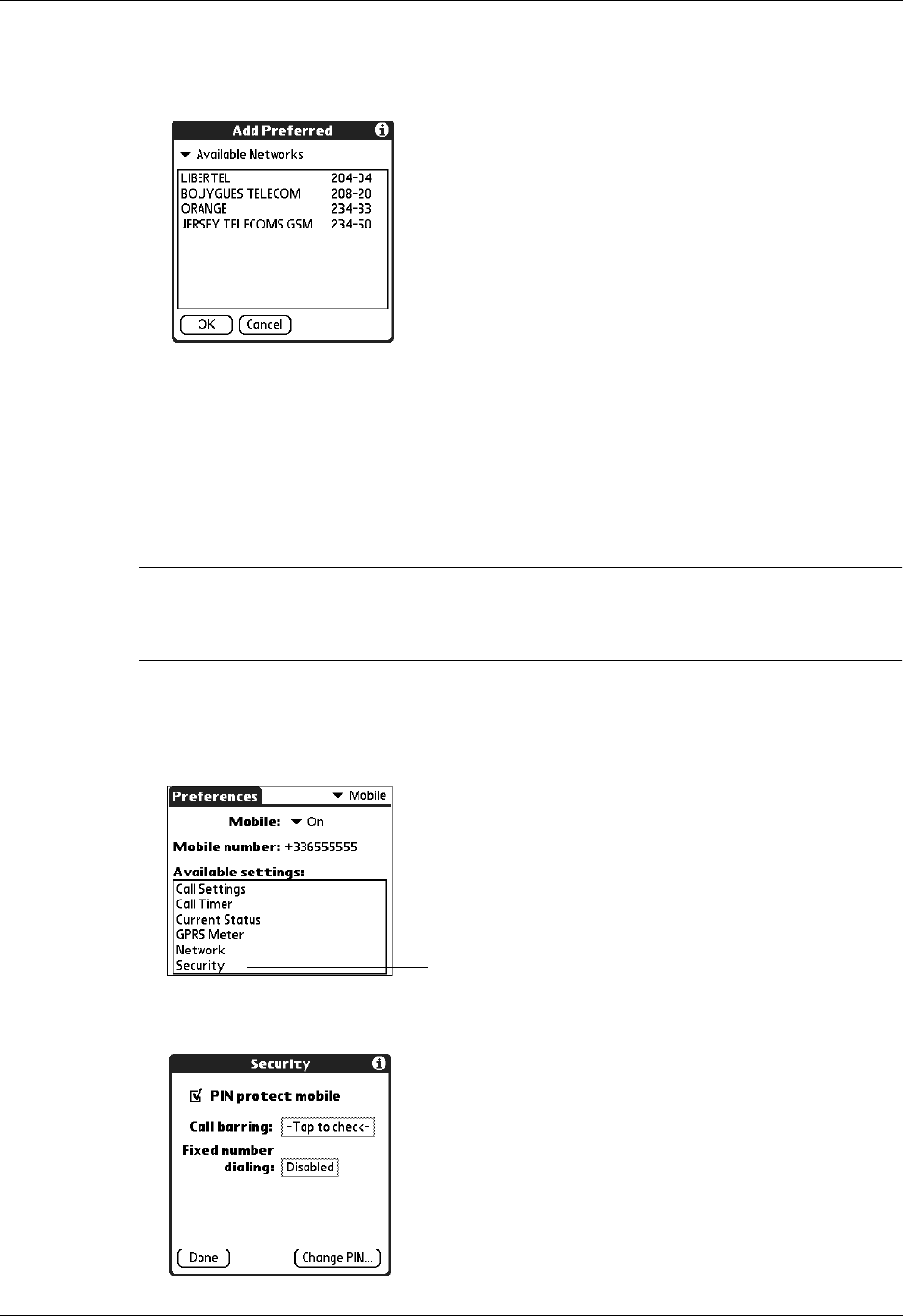
Mobile preferences
337
The added networks appear at the bottom of your Preferred Networks list,
where you can sort them.
Setting PIN for mobile power on
When the Security setting is enabled, the mobile requires the user to enter a valid
PIN code each time the mobile radio is powered on. The mobile is locked until a
valid PIN code is entered. Modification of this setting is PIN code protected. You
are prompted to enter a valid PIN code when a change to this setting is saved.
IMPORTANT If you enter the current PIN incorrectly three times, the SIM card is
locked. You must enter an eight-digit PIN Unlock Key to unlock your SIM. See
“Unlocking your SIM card” later in this chapter for more information.
To edit PIN protection:
1. Tap Security.
2. Tap the PIN protect mobile check box to select or deselect it.
Ta p S e c u r i t y
Palm, Inc. Confidential
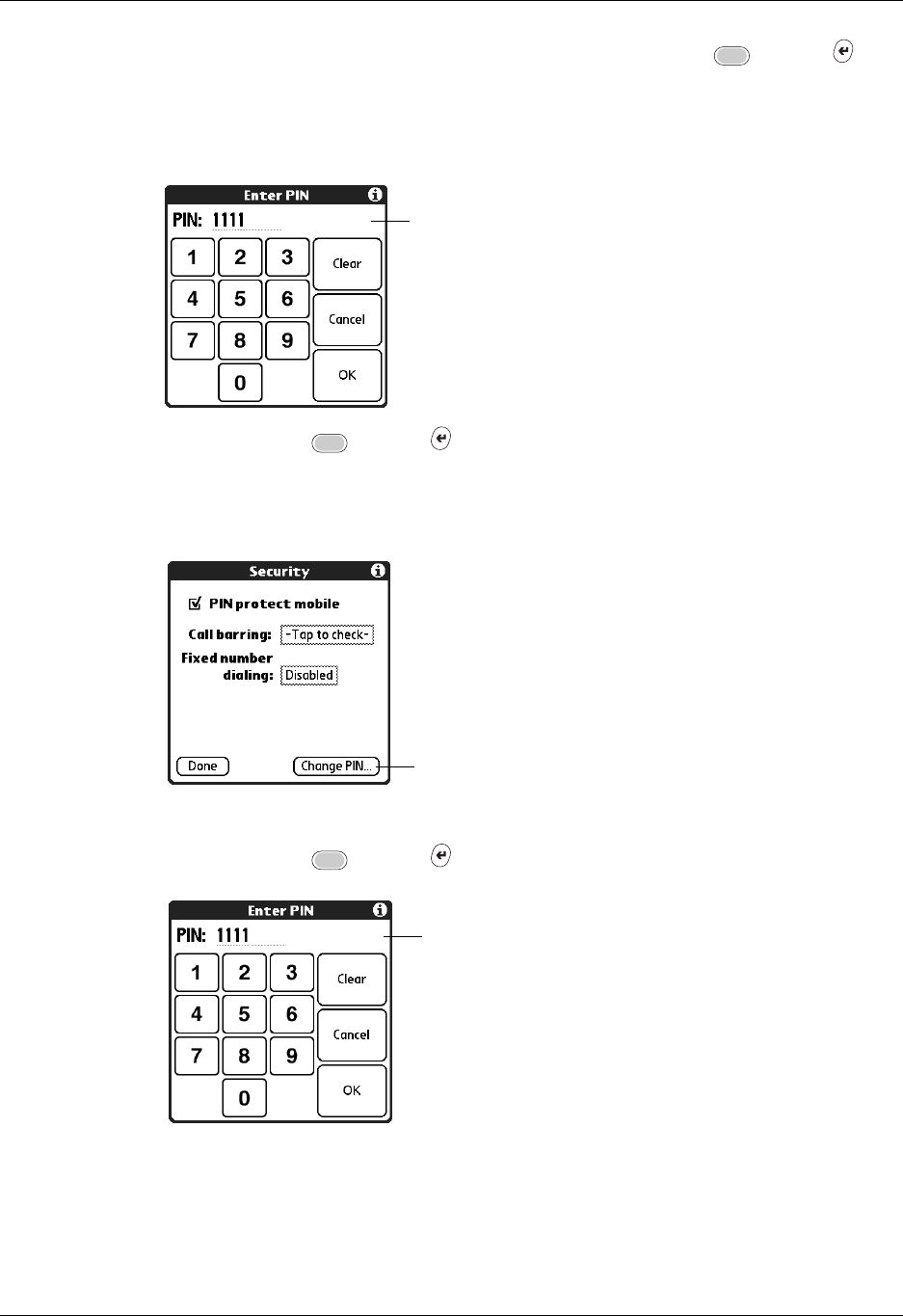
Chapter 21 Setting Preferences for Your Handheld
338
3. Enter a PIN number using the keypad and press Function + Enter , or
tap OK.
The minimum length is four characters, and the maximum length is eight
characters.
4. Press Function + Enter , or tap OK.
To change your PIN number:
1. Tap Change PIN.
2. Enter your current PIN number.
3. Press Function + Enter , or tap Done.
4. Enter a new PIN.
Enter PIN number
Tap Change PIN
Enter PIN number
Palm, Inc. Confidential
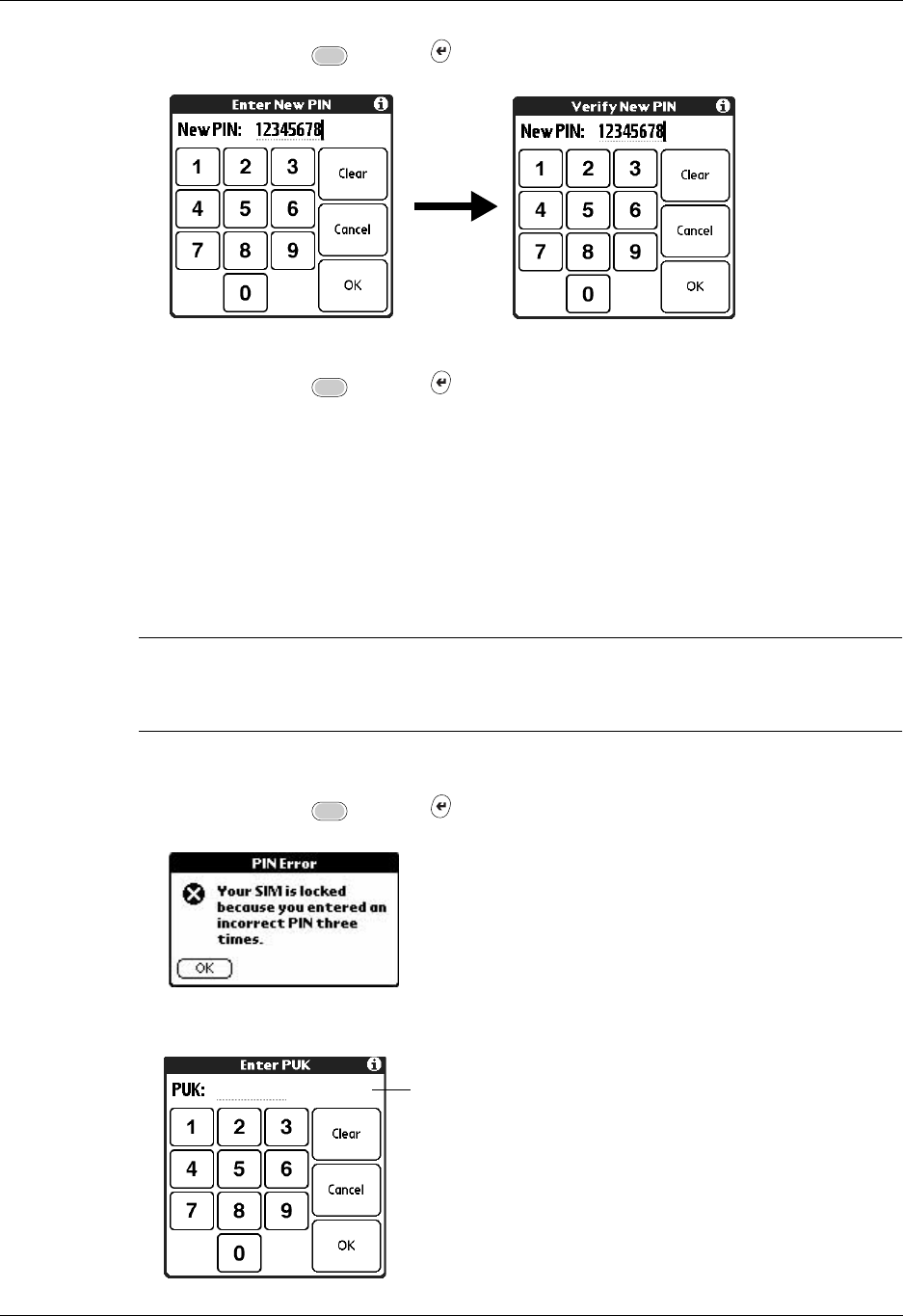
Mobile preferences
339
5. Press Function + Enter , or tap OK.
6. Enter your new PIN number again to verify.
7. Press Function + Enter , or tap OK.
Unlocking your SIM card
If you enter the current PIN incorrectly three times, the SIM card is locked. A SIM
locked alert displays. You must enter an eight-digit PIN Unlock Key (PUK) to
unlock your SIM. The PUK is provided by your wireless service provider. To find
your PUK, check the documentation that came with your wireless service or
contact your wireless service provider.
IMPORTANT If you enter your PUK incorrectly ten consecutive times, your SIM card
is permanently locked. A permanently locked SIM card is usable for emergency
dialing only. Contact your wireless service provider.
To unlock your SIM card:
1. Press Function + Enter , or tap OK.
2. Enter your PUK.
Enter PUK
Palm, Inc. Confidential
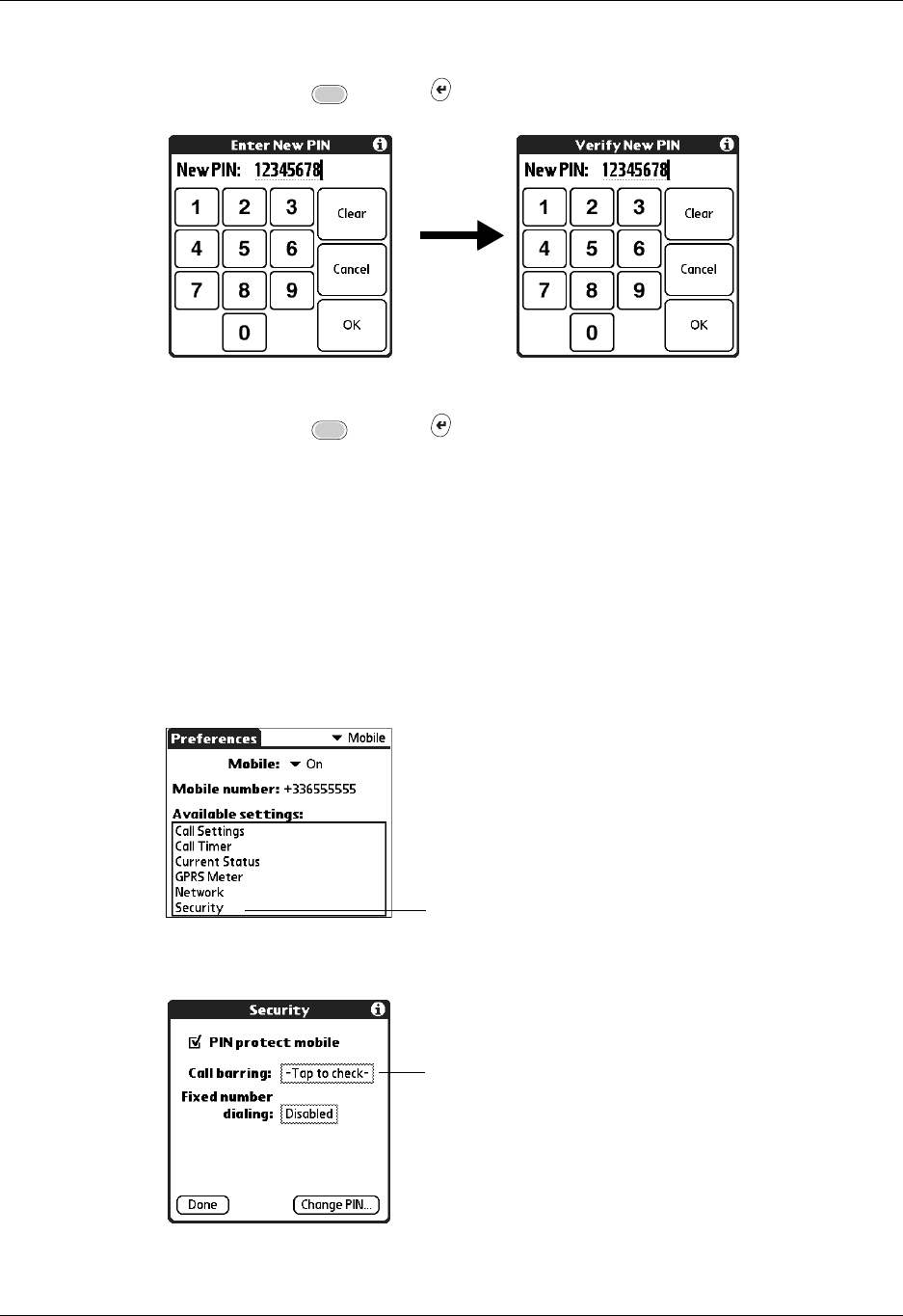
Chapter 21 Setting Preferences for Your Handheld
340
3. Enter a new PIN.
4. Press Function + Enter , or tap OK.
5. Enter the new PIN again to verify.
6. Press Function + Enter , or tap OK.
Setting call barring
Call barring is a supplementary service that allows you to bar or block different
classes of incoming and outgoing calls ranging from All calls to No barring. The
call barring settings are protected by the barring password. The barring password
is managed by and originally obtained from the wireless service provider.
To edit call barring settings:
1. Tap Security.
2. Tap the Call barring box.
Ta p Sec u r i t y
Tap box
Palm, Inc. Confidential
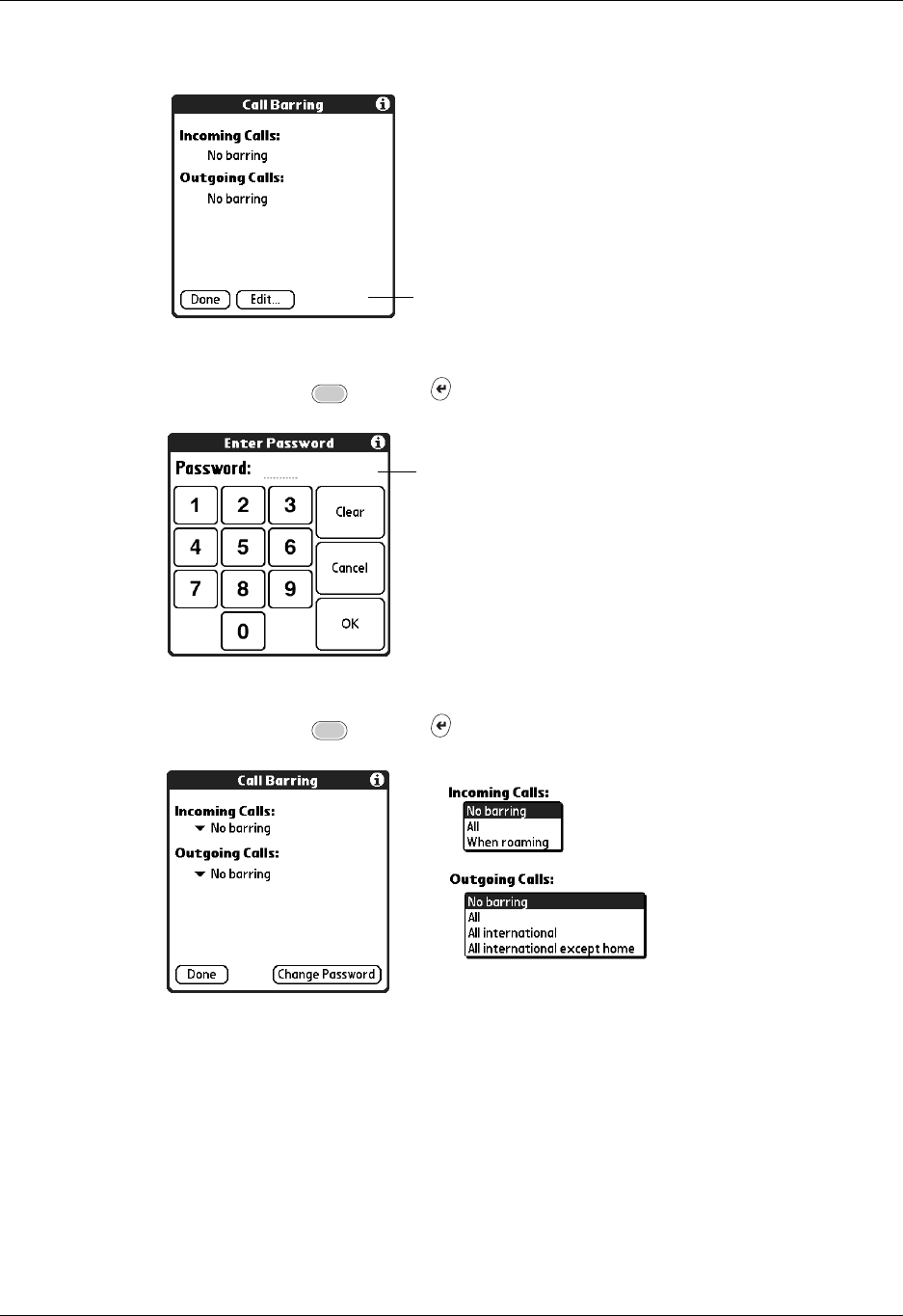
Mobile preferences
341
3. Tap Edit Settings.
4. Enter a call barring four-digit password using the keypad.
5. Press Function + Enter , or tap OK.
6. Tap the Incoming Calls or Outgoing Calls pick list to change settings.
7. Press Function + Enter , or tap OK.
Tap Edit Settings
Enter password
Palm, Inc. Confidential
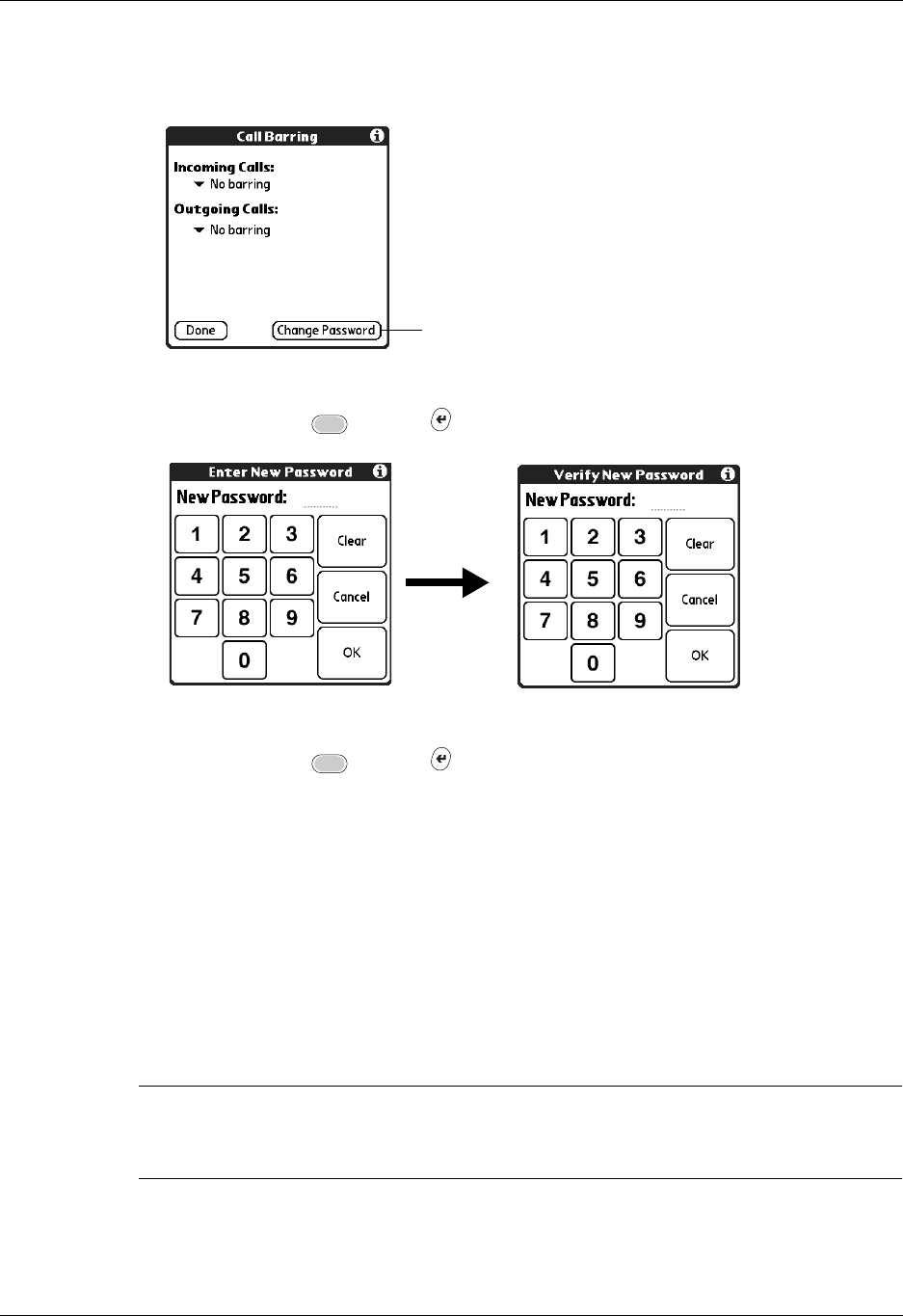
Chapter 21 Setting Preferences for Your Handheld
342
To change the call barring password:
1. Tap Change Password.
2. Enter a new four-digit password.
3. Press Function + Enter , or tap OK.
4. Enter the new password again to verify.
5. Press Function + Enter , or tap OK.
Setting Fixed Number Dialing (FND)
Fixed Number Dialing (FND) restricts the handheld so that only preprogrammed
phone numbers in the FND phone book can be dialed.
There are two modes to the FND screen: view and edit. When the user taps the
FND selector on the main Security screen, the FND view panel is displayed. You
can view or dial the numbers that are stored in the FND phone book. Tapping Edit
Settings and entering a valid PIN2 security code enables editing of the FND
settings.
IMPORTANT If you enter the PIN2 code incorrectly three consecutive times, access to
FND menus is blocked. You must obtain a PUK2 code from your wireless service
provider to unlock the services.
Tap Change Password
Palm, Inc. Confidential
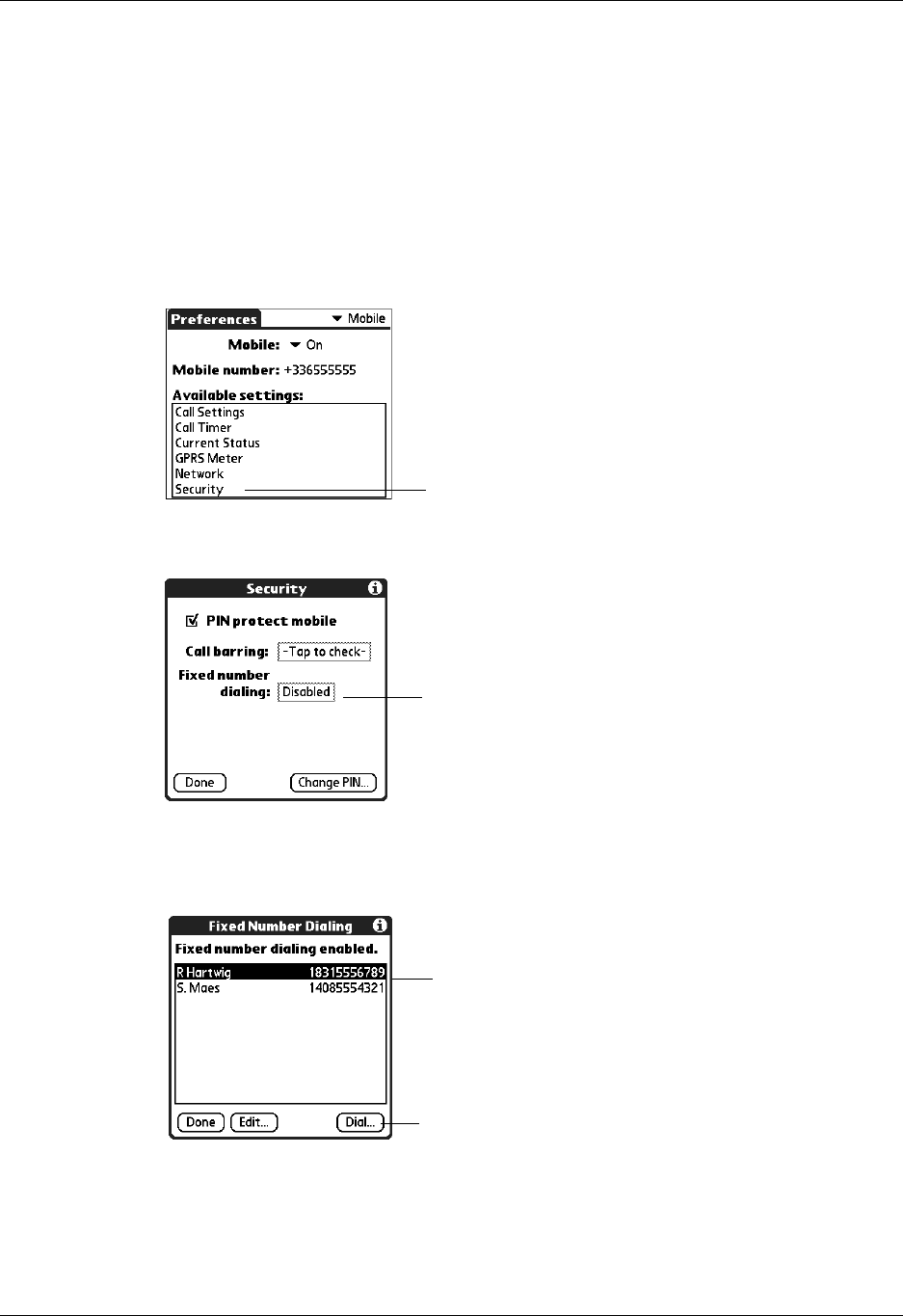
Mobile preferences
343
When FND is enabled:
■Dialing is estricted to numbers contained in the FND phone book, except for
emergency calls.
■You can extend an FND entry by adding digits to the dial string. This makes it
possible to restrict dialing to a specific country or area code.
To view or dial an FND entry:
1. Select Security.
2. Select the Fixed dialing box.
3. Select an entry and tap Dial.
You go to the PalmTM Mobile main screen and the number is dialed.
Ta p Sec u r i t y
Tap box
Select an entry
Ta p D i a l
Palm, Inc. Confidential
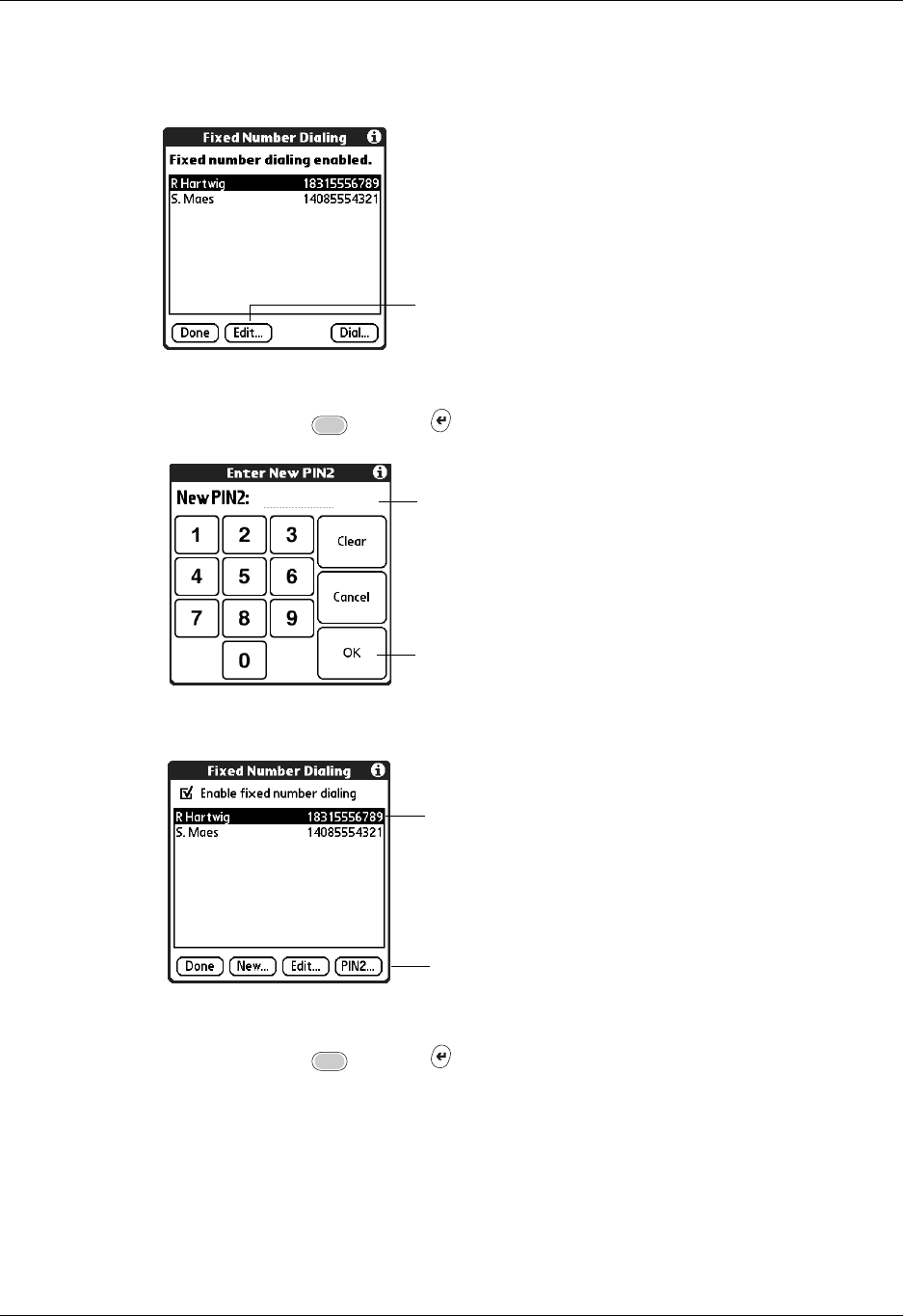
Chapter 21 Setting Preferences for Your Handheld
344
To add or edit an FND entry:
1. Select Edit.
2. Enter your PIN2 number.
3. Press Function + Enter , or tap Done.
4. Tap New, or select an entry and tap Edit.
5. Edit or add the entry.
6. Press Function + Enter , or tap OK.
Tap Edit
Enter PIN2 number
Ta p OK
Select an entry to edit
Tap New or Edit
Palm, Inc. Confidential
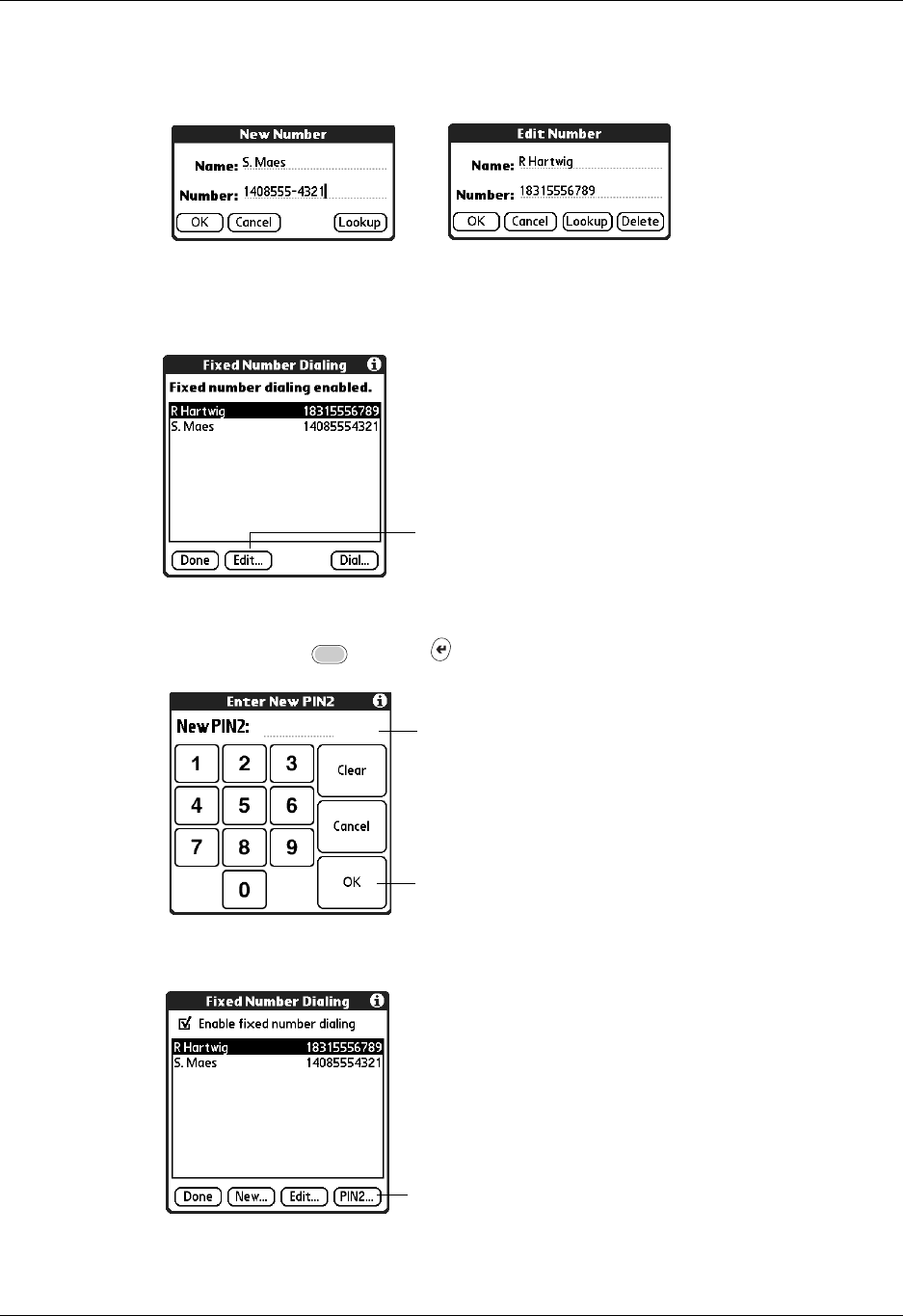
Mobile preferences
345
You can delete the entry by tapping Delete, or access your Address Book by
tapping Lookup.
To change the PIN2 number:
1. Select Edit.
2. Enter your PIN2 number.
3. Press Function + Enter , or tap OK.
4. Tap PIN2.
5. Enter the new PIN2 number.
Tap Edit
Enter PIN2 number
Ta p OK
Ta p P I N 2
Palm, Inc. Confidential
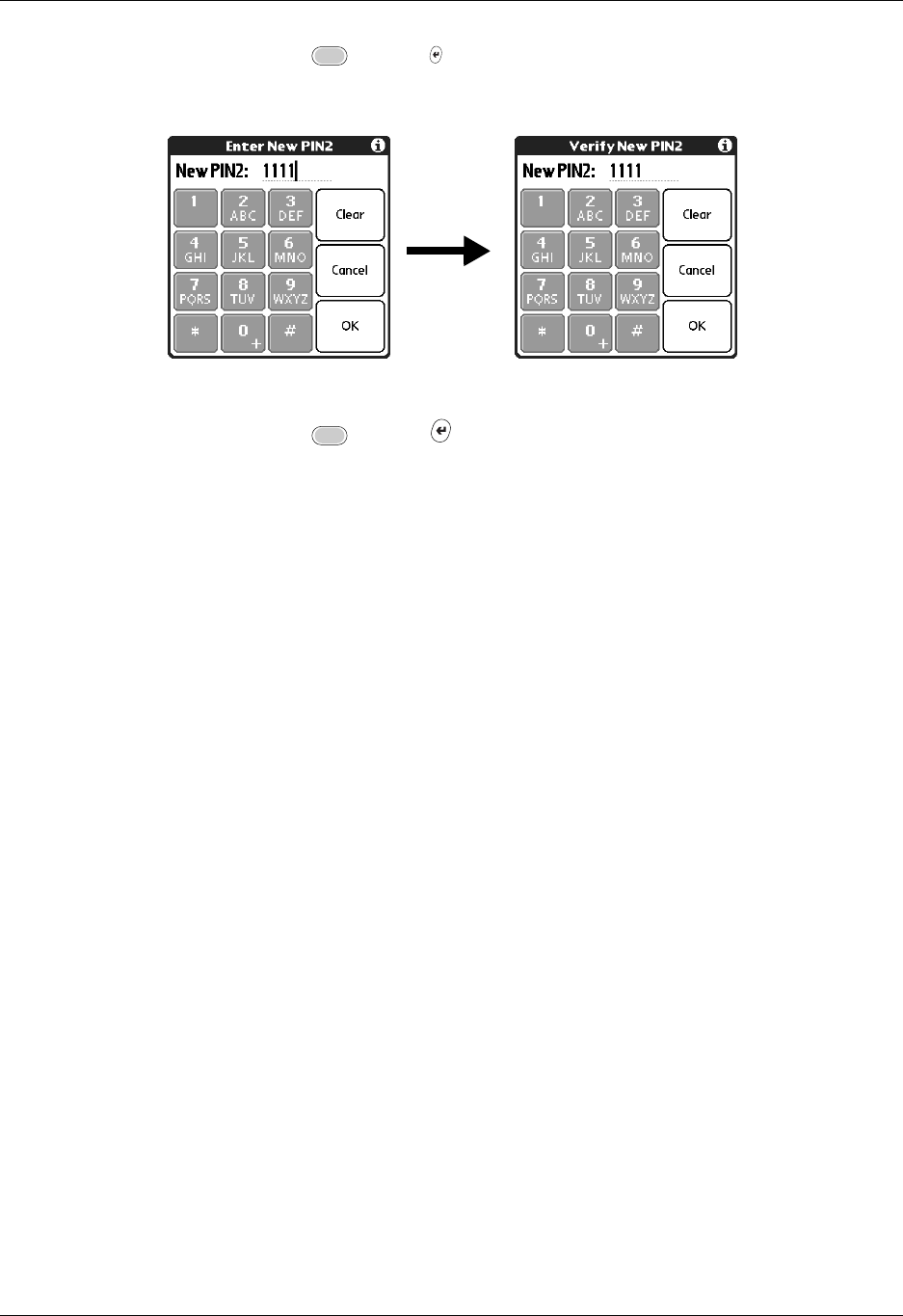
Chapter 21 Setting Preferences for Your Handheld
346
6. Press Function + Enter or tap OK.
The number must be between four and eight digits.
7. Enter the new PIN2 number again to verify.
8. Press Function + Enter , or tap OK.
Network preferences
Your handheld supports GPRS data connections and acts as a fully functional data
modem for circuit-switched connections over GSM.
Modem Accessory and TCP/IP software
Although your handheld is wirelessly enabled, you can also use TCP/IP software
that is included in the handheld operating system to connect with Internet Service
Providers (ISPs) or dial-in (remote access) servers.
To use TCP/IP, you must create a configuration in Connection Preferences and
then create Network Preferences settings.
The Connection Preferences screen enables you to define several ways that your
handheld can use a modem to communicate with remote devices. For example,
you can communicate with the wireless service provider server, or with your
computer if you are traveling. See “Connection preferences” earlier in this chapter
for a complete explanation of how to create modem configurations.
After you configure both the Connection and Network Preferences, you can
establish a PPP (Point-to-Point Protocol) connection with your wireless service
provider or dial-in server. You can do this either by using menu commands from
the Network Preferences screen or by using a third-party application.
NOTE TCP/IP provides the ability to connect to your wireless service provider or dial-
in server with applications that allow you to view the transmitted data. Visit the web
site www.palm.com/support/intl for information on third-party applications that take
advantage of TCP/IP.
Palm, Inc. Confidential
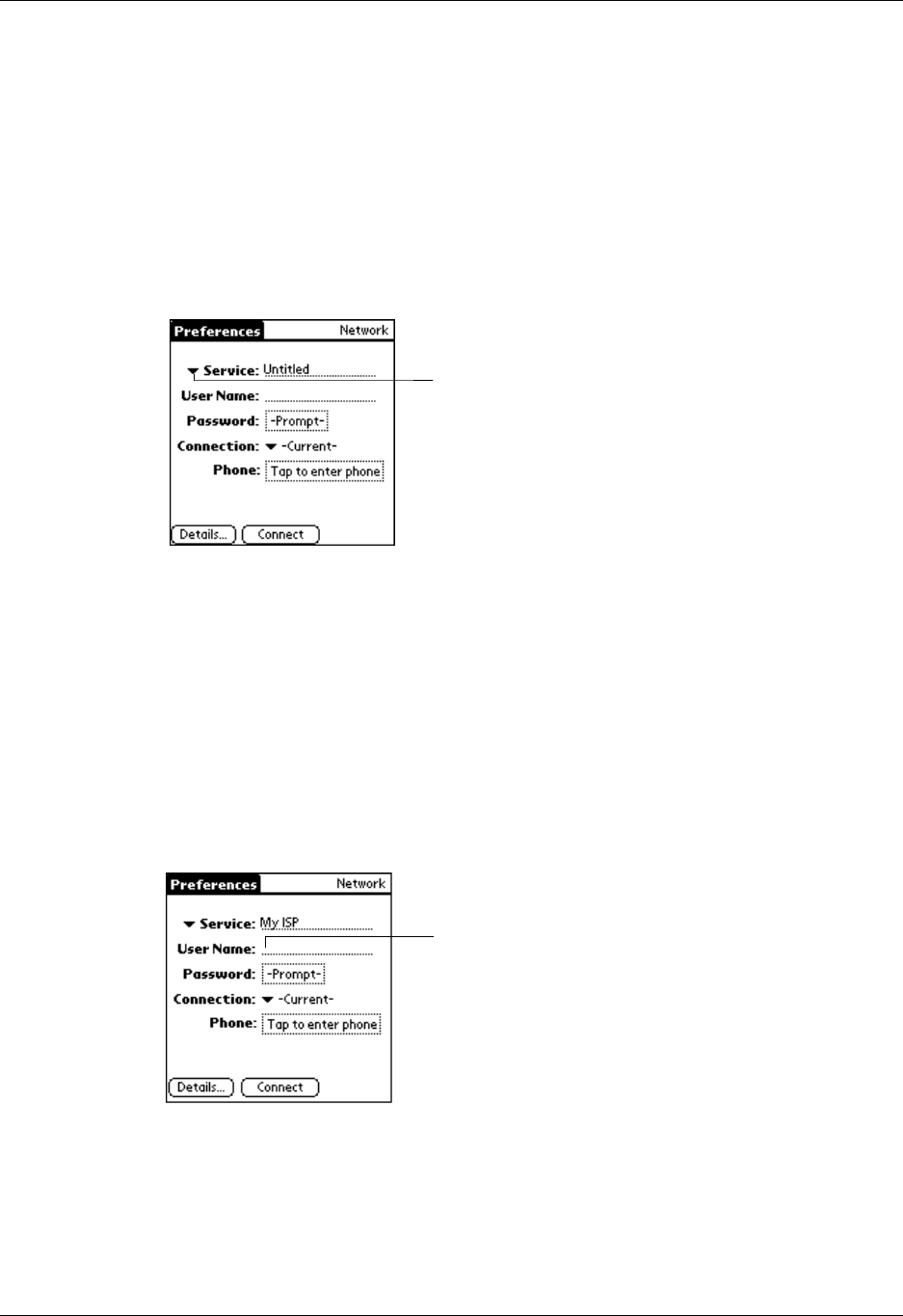
Network preferences
347
Selecting a service
Use the Service setting to select the service template for your wireless service
provider or a dial-in server. Service templates are a set of wireless service provider
and dial-in server configuration settings that you can create, save, and reuse. Also,
you can create new service templates. See “Creating additional service templates”
later in this chapter.
To select a service:
1. Tap the Service pick list.
2. Select the predefined service template you want to use.
Entering a username
The User Name setting identifies the name you use when you log in to your
wireless service provider or your dial-in server. Although this field can contain
multiple lines of text, only two lines appear onscreen.
To enter a username:
1. Tap the User Name field.
2. Enter your username.
NOTE Most dial-in servers do not accept spaces in the username.
Tap here to display a
list of service
templates
Enter your username here
Palm, Inc. Confidential
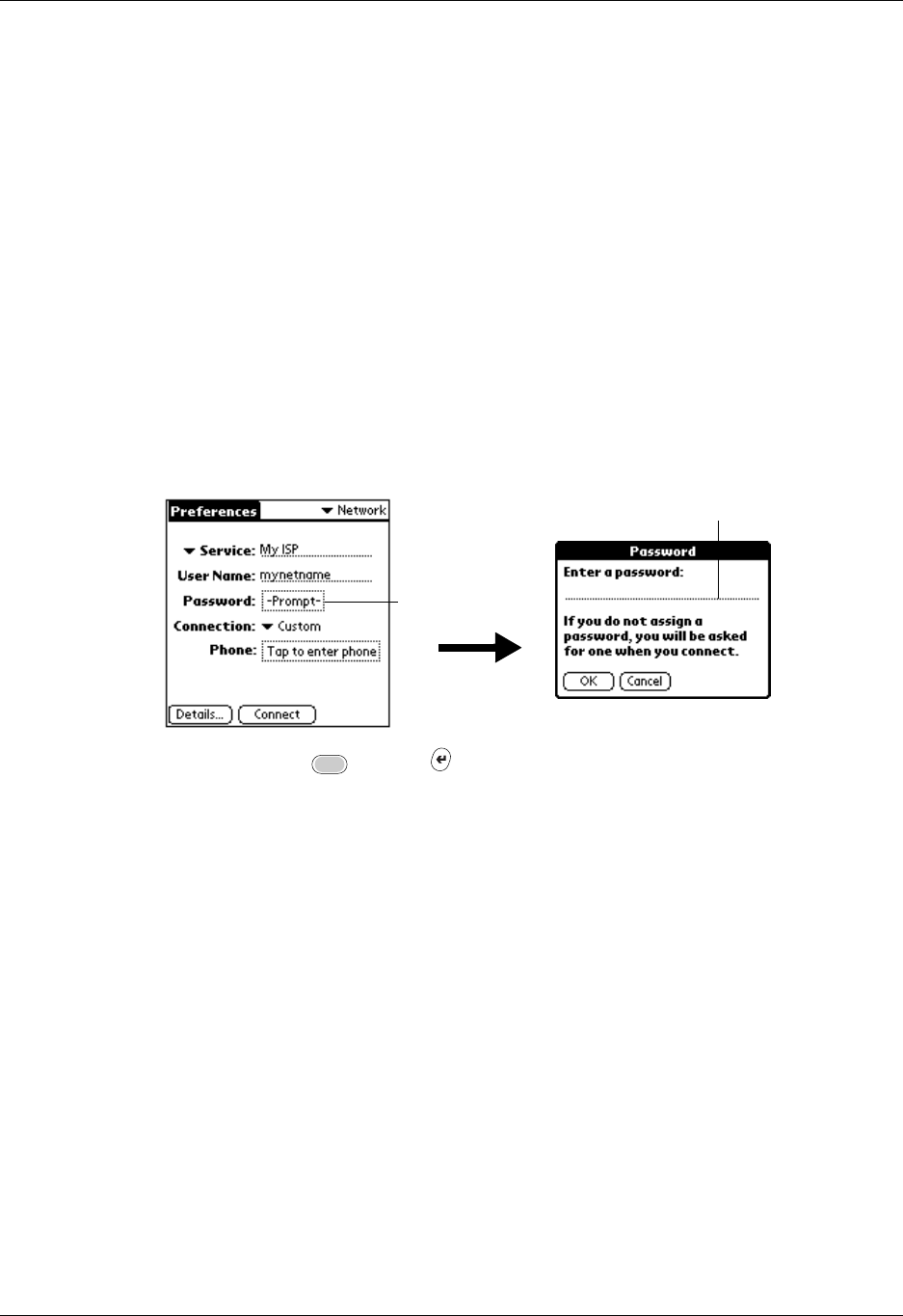
Chapter 21 Setting Preferences for Your Handheld
348
Entering a password
The Password box identifies the password you use to log in to your server or
wireless service provider. Your entry in this field determines whether your
handheld prompts you to enter a password each time you log in to your network:
■If you do not enter a password, your handheld displays the word “Prompt” in
this field and asks you to enter a password during the login procedure.
■If you enter a password, your handheld displays the word “Assigned” in this
field and does not prompt you to enter a password during the login procedure.
If you are concerned about security, select the Prompt option and do not enter
a password.
To enter a password:
1. Tap the Password box.
2. Enter the password you use to log in to your server.
.
3. Press Function + Enter , or tap OK.
The Password field updates to display the word “Assigned.”
Enter password here
Tap here
Palm, Inc. Confidential
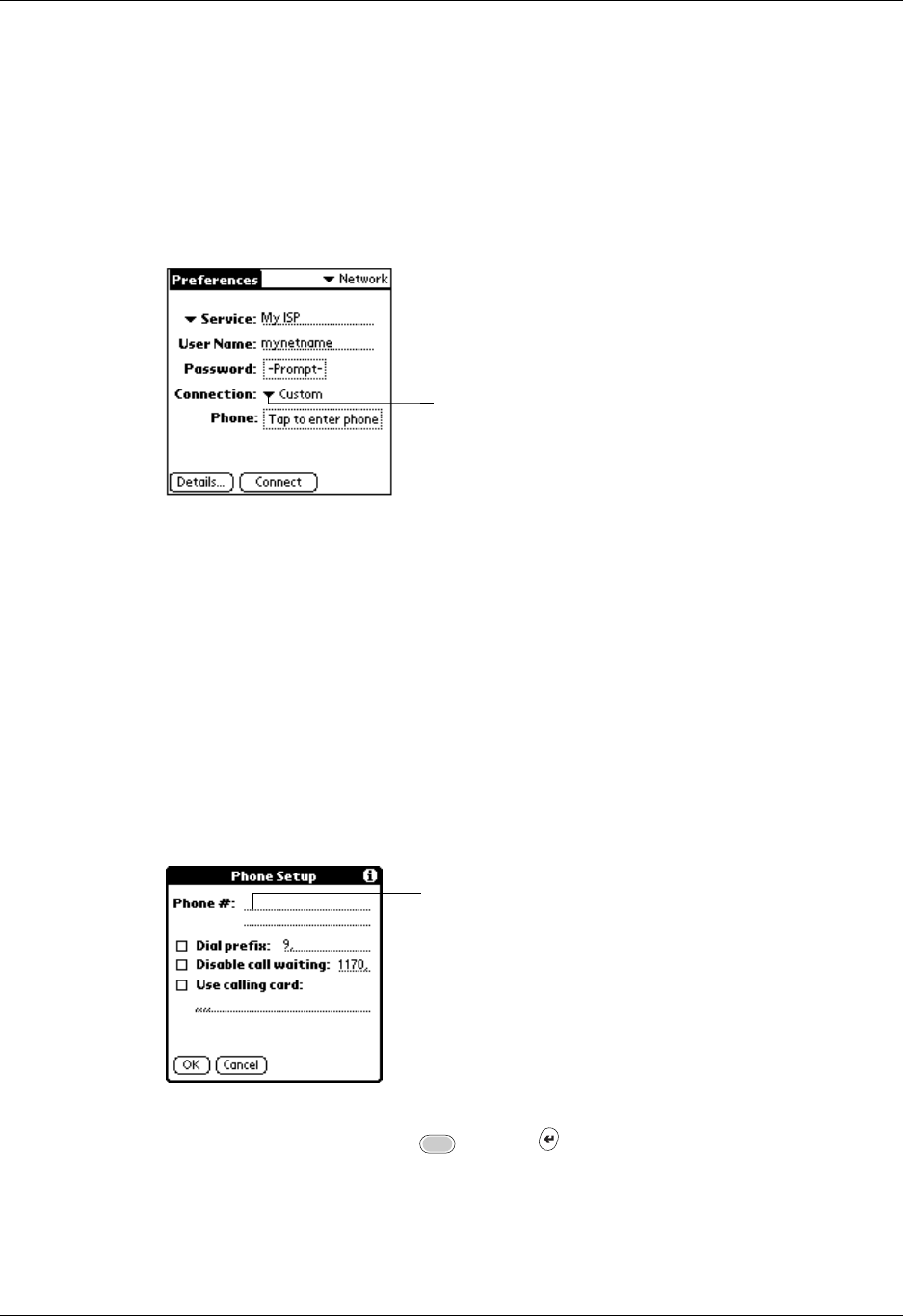
Network preferences
349
Selecting a connection
Use the Connection setting to select the method you want to use to connect to your
wireless service provider or a dial-in server. See “Connection preferences” earlier
in this chapter for information about creating and configuring connection settings.
To select a connection:
1. Tap the Connection pick list.
2. Select the connection you want to use.
Adding telephone settings
Some services require a telephone number. When you select the Phone field, a
dialog box opens in which you define the telephone number you use to connect
with your wireless service provider or dial-in server. In addition, you can define a
prefix, disable call waiting, and give special instructions for using a calling card.
To enter your server phone number:
1. Tap the Phone field.
2. Enter the phone number for your wireless service provider or dial-in server.
3. If you need to enter a prefix or disable call waiting, skip to those procedures.
Otherwise, press Function + Enter , or tap OK.
Tap here to display a
list of available
connections
Enter the phone number here
Palm, Inc. Confidential
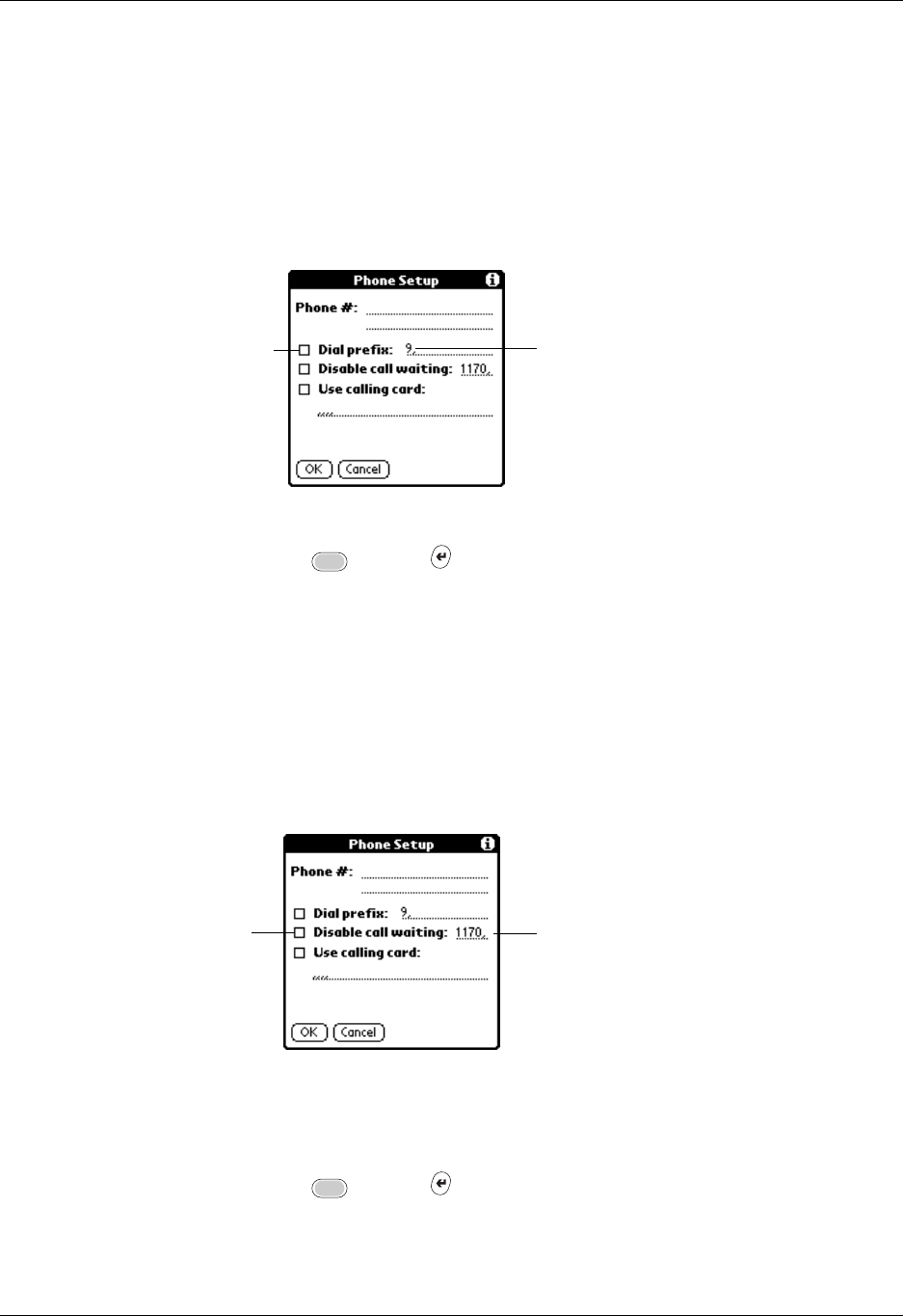
Chapter 21 Setting Preferences for Your Handheld
350
Entering a prefix
A prefix is a number that you dial before the telephone number to access an outside
line. For example, many offices require that you dial “9” before dialing a number
outside the building.
To enter a prefix:
1. Tap the Dial prefix check box to select it.
2. Enter the prefix.
3. Press Function + Enter , or tap OK.
Disabling call waiting
Call waiting can cause your session to terminate if you receive a call while you are
connected. If your telephone has call waiting, you need to disable this feature
before logging in to your wireless service provider or dial-in server.
To disable call waiting:
1. Tap the Disable call waiting check box to select it.
2. Enter the code to disable call waiting on the Disable call waiting line.
Each telephone company assigns a code to disable call waiting. Contact your
local telephone company for the code that is appropriate for you.
3. Press Function + Enter , or tap OK.
Enter your
prefix here
Select this
box if you
need to use a
prefix
Enter your disable
code here
Select this
box if you
need to
disable call
waiting
Palm, Inc. Confidential
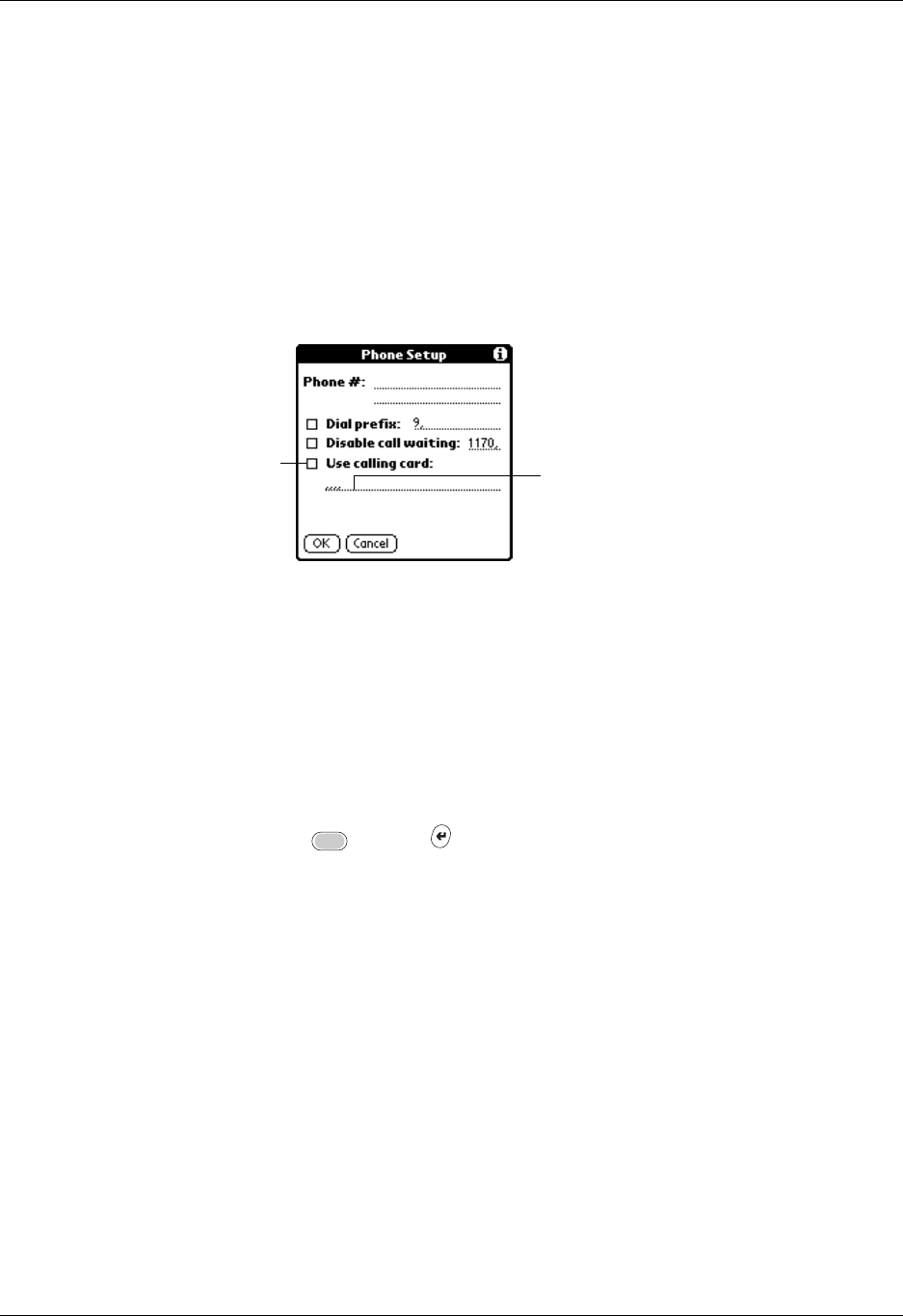
Network preferences
351
Using a calling card
The Use calling card field enables you to use your calling card when dialing your
wireless service provider or Intranet server. Keep in mind that there is usually a
delay before you enter your calling card number. When you define your calling
card number, you need to add commas at the beginning to compensate for this
delay. Each comma delays transmission of your calling card number for two
seconds.
To use a calling card:
1. Tap the Use calling card check box to select it.
2. Enter your calling card number on the Use calling card line.
NOTE The Phone Setup dialog box works correctly for AT&T and Sprint long-
distance services. However, because MCI works differently, MCI customers
need to put the calling card number in the Phone # field and the phone number
in the Use calling card field.
TIP It’s a good idea to add at least three commas before your calling card
number to compensate for the cue delay.
3. Press Function + Enter , or tap OK.
Connecting to your service
After you set your Connection and Network Preferences, establishing a connection
to your wireless service provider or your company’s network (dial-in server) is
easy.
To establish a connection:
■Tap Connect to dial the current service and display the Service Connection
Progress messages.
To see expanded Service Connection Progress messages, press the lower half of
the Scroll button.
To close a connection:
■Tap Disconnect to terminate the connection between your handheld and your
service.
Enter your
calling card
number here
Select this
box to use a
calling card
Palm, Inc. Confidential
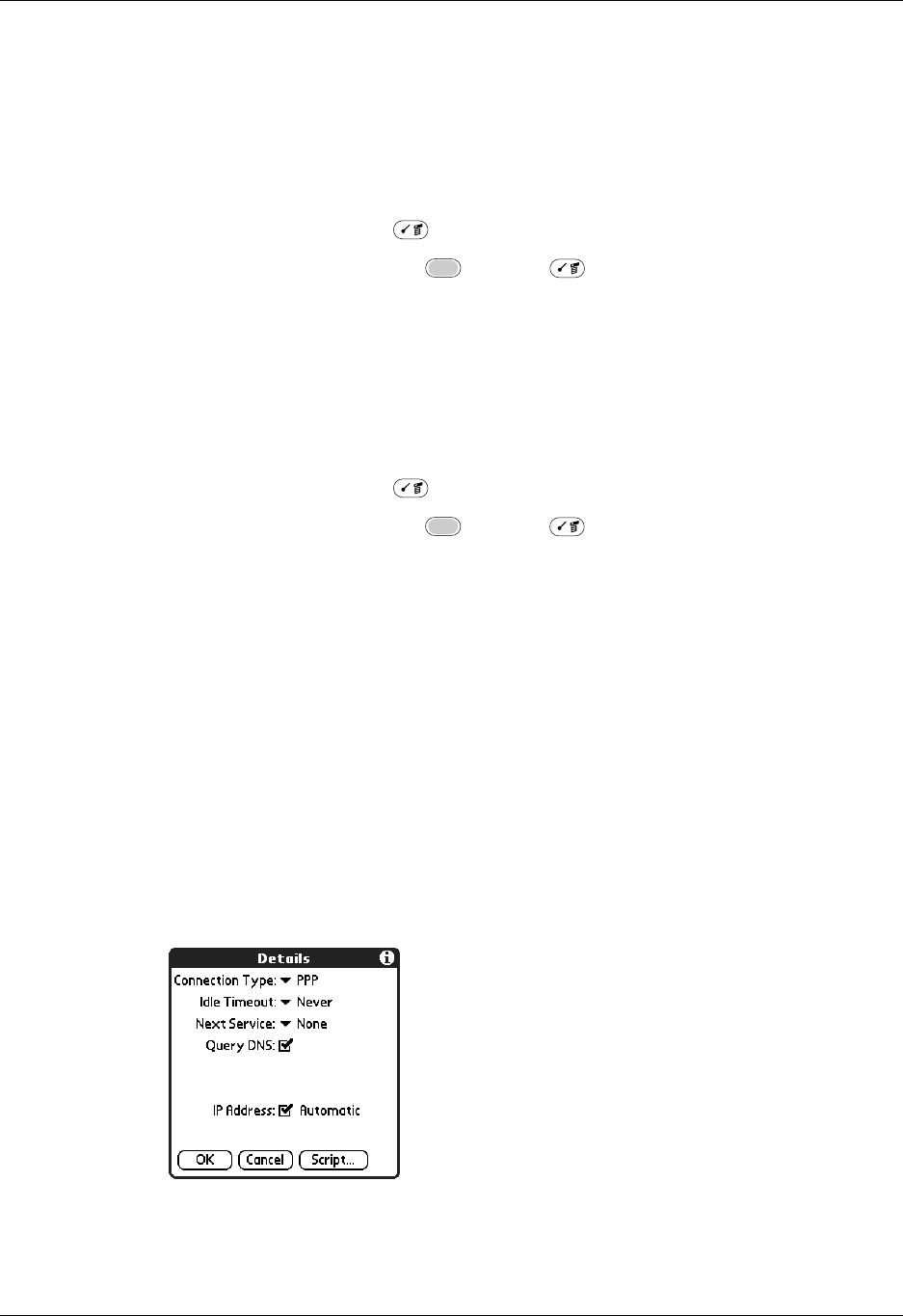
Chapter 21 Setting Preferences for Your Handheld
352
Creating additional service templates
You can create additional service templates from scratch, or you can duplicate
existing templates and editing information. After you create a new or duplicate
template, you can add and edit settings.
To add a new service template:
■Press Command Stroke + N.
Alternately, press Function + Menu , and then select New on the
Service Menu.
An Untitled service template is added to the Service pick list.
To duplicate an existing service template:
1. Tap the Service pick list.
2. Select the predefined service template you want to duplicate.
3. Press Command Stroke + L.
Alternately, press Function + Menu , and then select Duplicate on the
Service Menu.
A copy of the service template is added to the Service pick list.
Adding detailed information to a service template
If you are using one of the predefined service templates, you probably need to
enter only your username and telephone number. If you are creating a new service
template, you may need to provide additional information to your wireless service
provider or dial-in server. You use the Details dialog box to add more information
to a selected service template.
To add connection details:
1. Tap the service field.
2. Tap De ta il s.
Palm, Inc. Confidential

Network preferences
353
Idle timeout
The Idle timeout setting defines how long your handheld waits before dropping
the connection with your wireless service provider or dial-in server when you
switch out of a TCP/IP application.
To set the Idle timeout:
1. Tap the Idle timeout pick list and select one of the following options:
2. Press Function + Enter , or tap OK.
Selecting Next Service
Next Service allows you to automatically try another connection method when the
primary method fails. If the current connection fails, then a connection to the
selected service is attempted. If you do not want to try another service connection,
select None.
To select the Next Service:
■Tap the Next Service pick list and select a service.
Defining primary and secondary DNS
The Domain Naming System (DNS) is a mechanism in the Internet for translating
the names of host computers into IP addresses. When you enter a DNS number (or
IP address) you are identifying a specific server that handles the translation
services.
Each IP address has four sections, separated by periods. In the Details dialog box,
you enter each section separately. Each section of an IP address is made up of a
number from 0 to 255; numbers are the only allowable characters in this field.
Ask your wireless service provider or system administrator for the correct primary
or secondary DNS IP numbers.
Many systems do not require that you enter a DNS. If you are not sure, leave the
DNS field blank.
1 minute Waits one minute for you to open another application before it
drops the connection.
2 minutes Waits two minutes.
3 minutes Waits three minutes.
Never Maintains your PPP or SLIP connection until you turn off your
handheld (or until it times out).
CAUTION By enabling this option, you may incur significant
charges if the connection to your wireless service provider is left
open.
Palm, Inc. Confidential
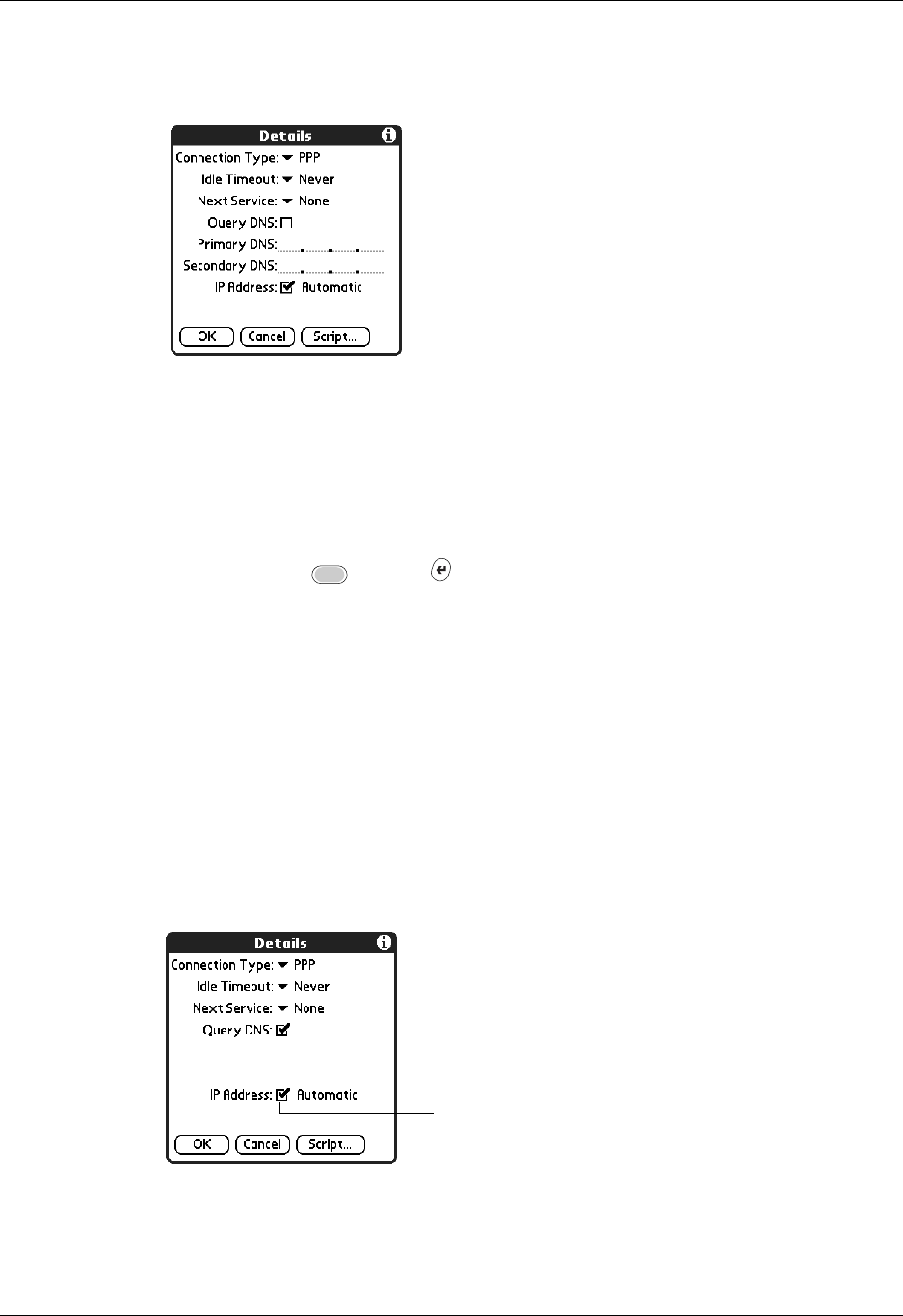
Chapter 21 Setting Preferences for Your Handheld
354
To enter a primary and secondary DNS:
1. Tap the Query DNS check box to deselect it.
2. Tap the space to the left of the first period in the Primary DNS field, and then
enter the first section of the IP address.
Each section must be a number from 0 to 255.
3. Repeat step 2 for the second, third, and last sections of the Primary DNS field.
4. Repeat steps 2 and 3 for the secondary DNS number.
5. Press Function + Enter , or tap OK.
IP address
Everyone who logs in to the Internet needs to have a unique identifier (an IP
address), whether permanent or temporary. Some networks dynamically assign a
temporary IP address when clients log in. The IP Address field lets you identify
whether your network provides automatic (dynamic) temporary IP addressing.
If your IP address is permanently assigned, you need to get that information from
your system administrator. If you are not sure, select Automatic.
To identify dynamic IP addressing:
■Tap the IP Address check box to select it.
Tap to select automatic IP
address
Palm, Inc. Confidential
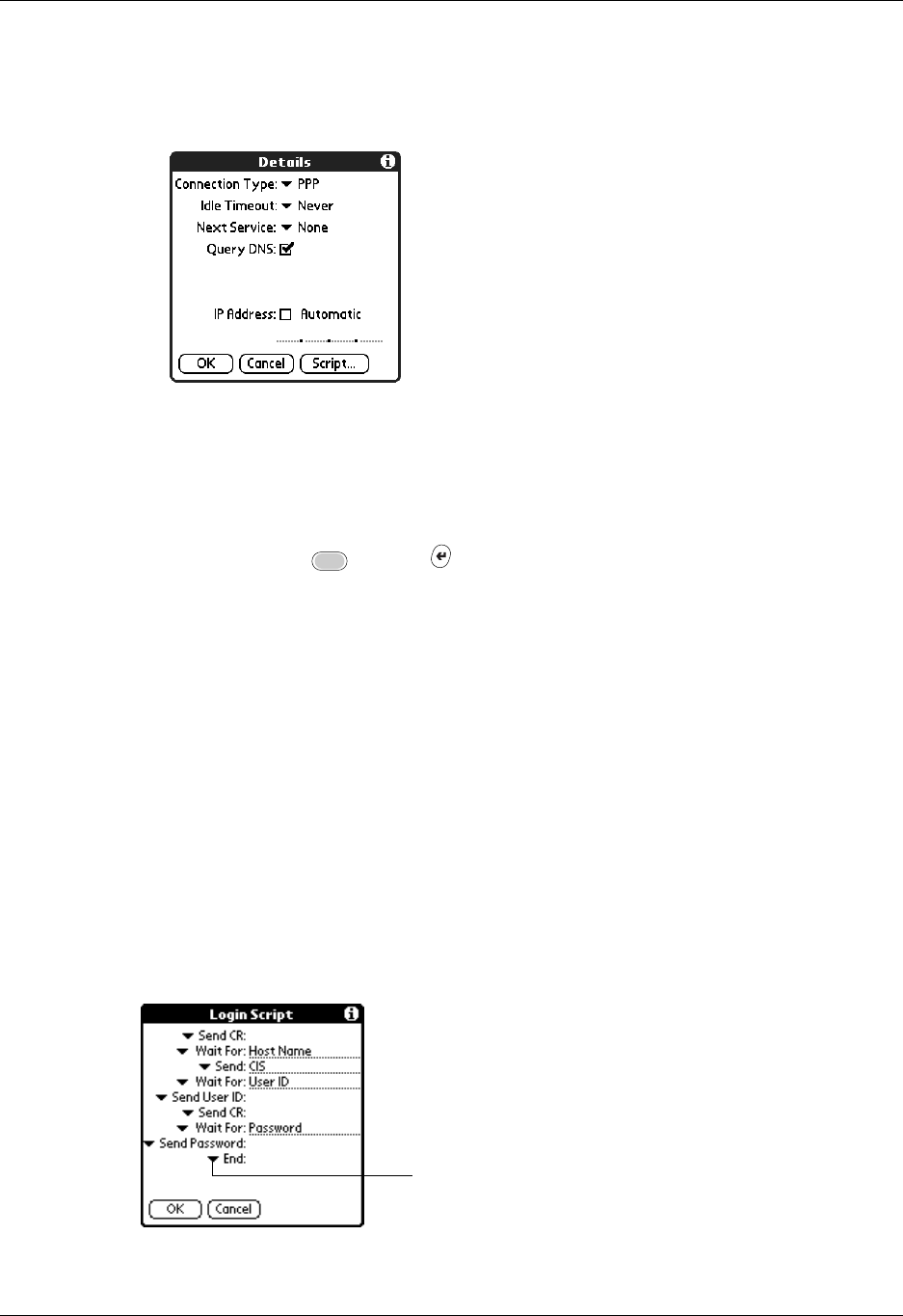
Network preferences
355
To enter a permanent IP address:
1. Tap the IP Address check box to deselect it and display a permanent IP address
field below the check box.
2. Tap the space to the left of the first period, and then enter the first section of the
IP address.
Each section must be a number from 0 to 255.
3. Tap and enter the remaining sections of the IP address.
4. Press Function + Enter , or tap OK.
Login scripts
A login script is a series of commands that automates logging in to a network
server–for example, your corporate network or your wireless service provider.
A login script is associated with a specific service template created in Network
Preferences.
A login script is something that you are likely to receive from your system
administrator if your company has a system in which you log in to the corporate
servers from your handheld using a modem or network connection. The script is
generally prepared by the system administrator and distributed to users who need
it. It automates the events that must take place in order to establish a connection
between your handheld and the corporate servers.
You can create login scripts from the Login Script dialog box on your handheld,
accessed from the Details dialog box in Network Preferences.
NOTE You can also use non-ASCII and literal characters in your login script.
Tap here to see the list of
available commands
Palm, Inc. Confidential
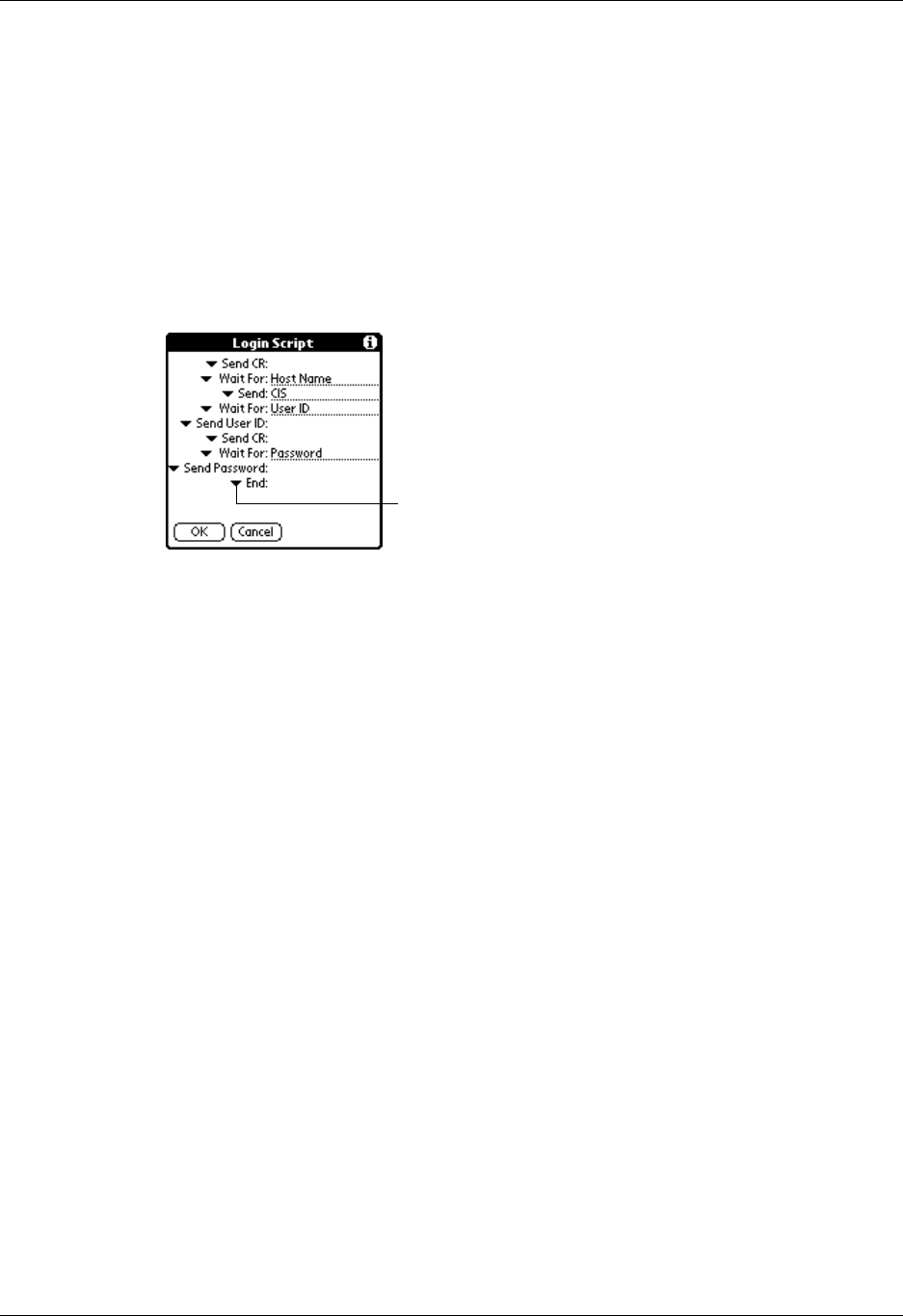
Chapter 21 Setting Preferences for Your Handheld
356
Creating a login script on your handheld
You can create login scripts by selecting commands from the Command pick list in
the Login Script dialog box. Some commands, such as Send, require you to supply
additional information. Those commands have a parameter field so that you can
add the necessary data.
To create a login script:
1. Tap Script.
2. Tap the End pick list.
3. Select the command you want from the Command list. If the command requires
additional information, a field appears to the right of it for you to enter the
information. The following commands are available:
Wait For Tells your handheld to wait for specific characters from the
TCP/IP server before executing the next command.
Wait For
Prompt Detects a challenge-response prompt coming from the server
and then displays the dynamically generated challenge value.
You then enter the challenge value into your token card, which
in turn generates a response value for you to enter on your
handheld. This command takes two arguments, separated by a
vertical bar (|) on the input line.
Send Transmits specific characters to the TCP/IP server to which you
are connecting.
Send CR Transmits a carriage return or LF character to the TCP/IP server
to which you are connecting.
Send User ID Transmits the user ID information entered in the User ID field of
the Network Preferences screen.
Send
Password Transmits the password entered in the Password field of the
Network Preferences screen. If you did not enter a password,
this command prompts you to enter one. The Password
command is usually followed by a Send CR command.
Ta p h e r e
Palm, Inc. Confidential

Network preferences
357
4. Repeat steps 2 and 3 until the login script is complete.
5. Press Function + Enter , or tap OK.
Plug-in applications
You can create plug-in applications containing script commands that extend the
functionality of the built-in script commands. A plug-in application is a standard
PRC application that you install on your handheld just like any other application.
After you install the plug-in application, you can use the new script commands in
a login script.
Plug-in applications have the following characteristics:
■Written in C language
■Compiled into a device executable
■Called properly from a login script
■Able to return control to a login script after it terminates
■Created using a development environment that supports Palm OS® software,
such as Metrowerks CodeWarrior for Palm Platform.
For additional information on creating plug-in applications, send e-mail to Palm
Developer Support at devsupp@palm.com.
Deleting a service template
There is only one way to delete a service template: use the Delete command from
the Service menu.
To delete a service template:
1. Tap the Service pick list.
2. Select the service template you want to delete.
Delay Tells your handheld to wait a specific number of seconds before
executing the next command in the login script.
Get IP Reads an IP address and uses it as the IP address for your
handheld. This command is used with SLIP connections.
Prompt Opens a dialog box and prompts you to enter text of some kind
(for example, a password or a security code).
End Identifies the last line in the login script.
Palm, Inc. Confidential
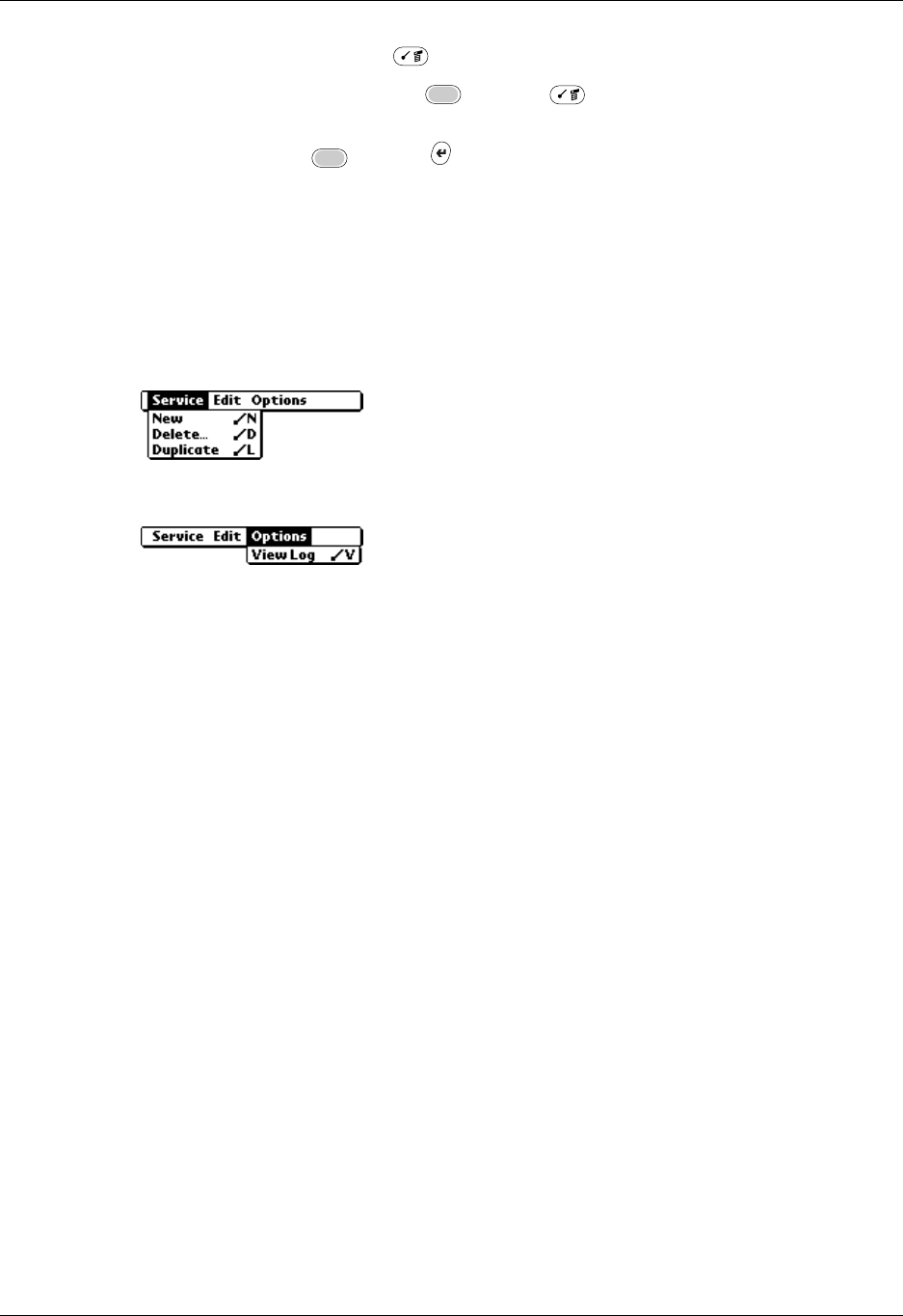
Chapter 21 Setting Preferences for Your Handheld
358
3. Press Command Stroke + D.
Alternately, press Function + Menu , and then select Delete on the
Service Menu.
4. Press Function + Enter , or tap OK.
Network preferences menu commands
The Network Preferences screen includes menu commands to make it fast and
easy to create and edit service templates. See “Using menus” in Chapter 4 for more
information about choosing menu commands.
Service menu
Options menu
View Log
The Network Log lists all of the communication that occurs between your modem
and your dial-in server during the login procedure. The information in the
Network Log can help your wireless service provider or your system
administrator pinpoint where the login procedure communication fails and why.
Owner preferences
The Owner Preferences screen enables you to record a name, company name,
phone number, or any other information that you want to associate with your
handheld. This information can be from the business card created during
installation.
If you use the Security Preferences screen to turn off and lock your handheld with
a password, information that you put in the Owner Preferences is displayed the
next time you turn on your handheld.
Palm, Inc. Confidential

Security preferences
359
To enter the Owner preferences:
■Enter the text that you want to associate with your handheld in the Owner
Preferences screen. If you enter more text than can fit on one screen, a scroll bar
automatically appears on the right side of the screen.
If you assign a password with the Security Preferences screen, the information in
the Owner Preferences screen cannot be changed. In this case, an Unlock button
appears at the bottom of the screen.
To unlock the Owner Preferences screen:
1. Tap Unlock .
2. Enter the password that you defined in the Security Preferences screen.
3. Press Function + Enter , or tap OK.
Security preferences
Your handheld comes with a Security feature so that unauthorized users cannot
view the entries you wish to protect. Use the Security feature to do the following:
■Lock and turn off your handheld so that it does not operate until you enter the
correct password.
■Mask all records that you mark as private so the information appears grayed
out.
■Hide all records that you mark as private so they do not appear on any screen.
You can mask and hide private records with or without a password. Without a
password, private records are hidden or masked until you set the Security
preference to show them. With a password, you must enter the password to view
the private entries.
Palm, Inc. Confidential
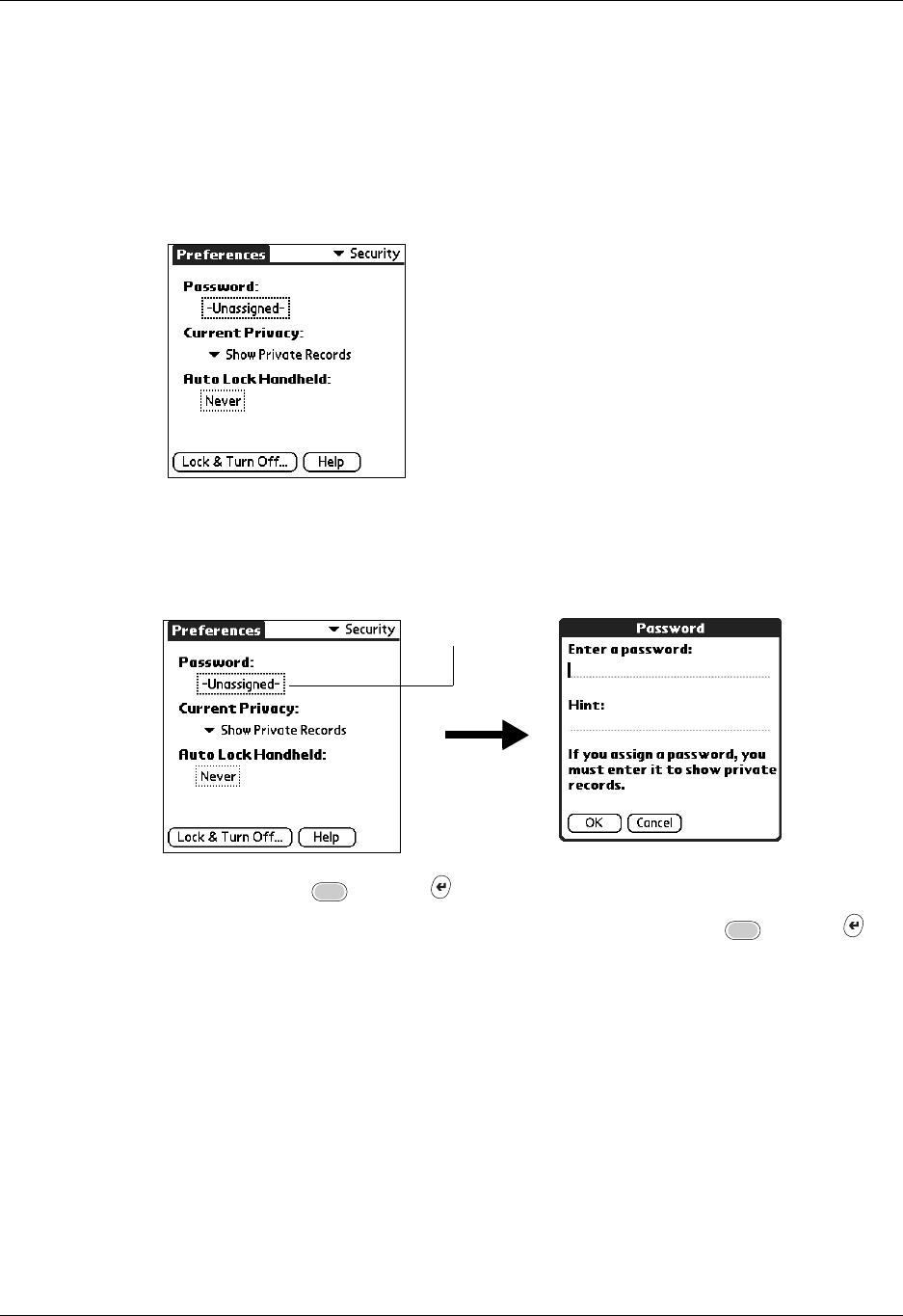
Chapter 21 Setting Preferences for Your Handheld
360
Assigning a password
You can assign a password to protect your private records and to lock your
handheld.
To assign a password:
1. Tap the Password box.
2. Enter a password.
3. Enter a hint to help your remember your password if you forget it. This is
optional.
4. Press Function + Enter , or tap OK.
5. Enter the same password a second time, and press Function + Enter , or
tap OK.
Changing or deleting a password
Once you define a password for your handheld, you can change or delete it at any
time. You must enter the current password before you can change or delete it.
Tap here
Palm, Inc. Confidential
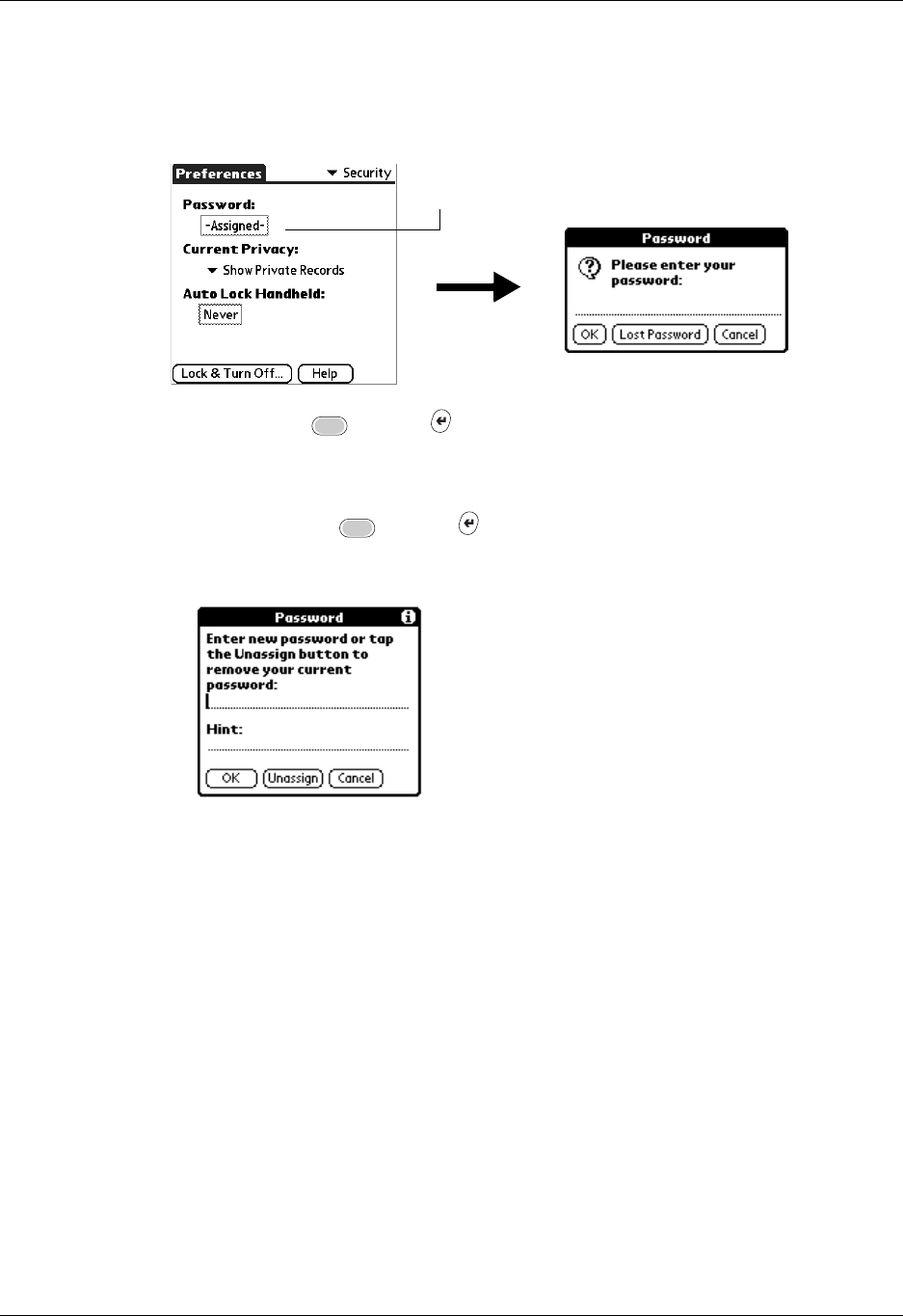
Security preferences
361
To change or delete your password:
1. Tap the Password box.
2. Enter the current password.
3. Press Function + Enter , or tap OK.
4. Do one of the following:
– To change the password and hint, enter the new password and hint, and
press Function + Enter , or tap OK.
– To remove the password, tap Unassign.
Locking your handheld
You can lock your handheld so that it cannot be operated until your password is
entered. In the event that your handheld is lost or stolen, this helps protect your
data from unauthorized use. You can set your handheld to lock automatically, or
you can lock it manually.
NOTE The lockout screen has an Emergency Call button in case the phone needs to
be used in an emergency.
Locking your handheld automatically
You can set your handheld to lock automatically when any one of the following
occur:
■When you turn off the power
■At a time you specify
■After a period of inactivity you specify
Ta p h e r e
Palm, Inc. Confidential
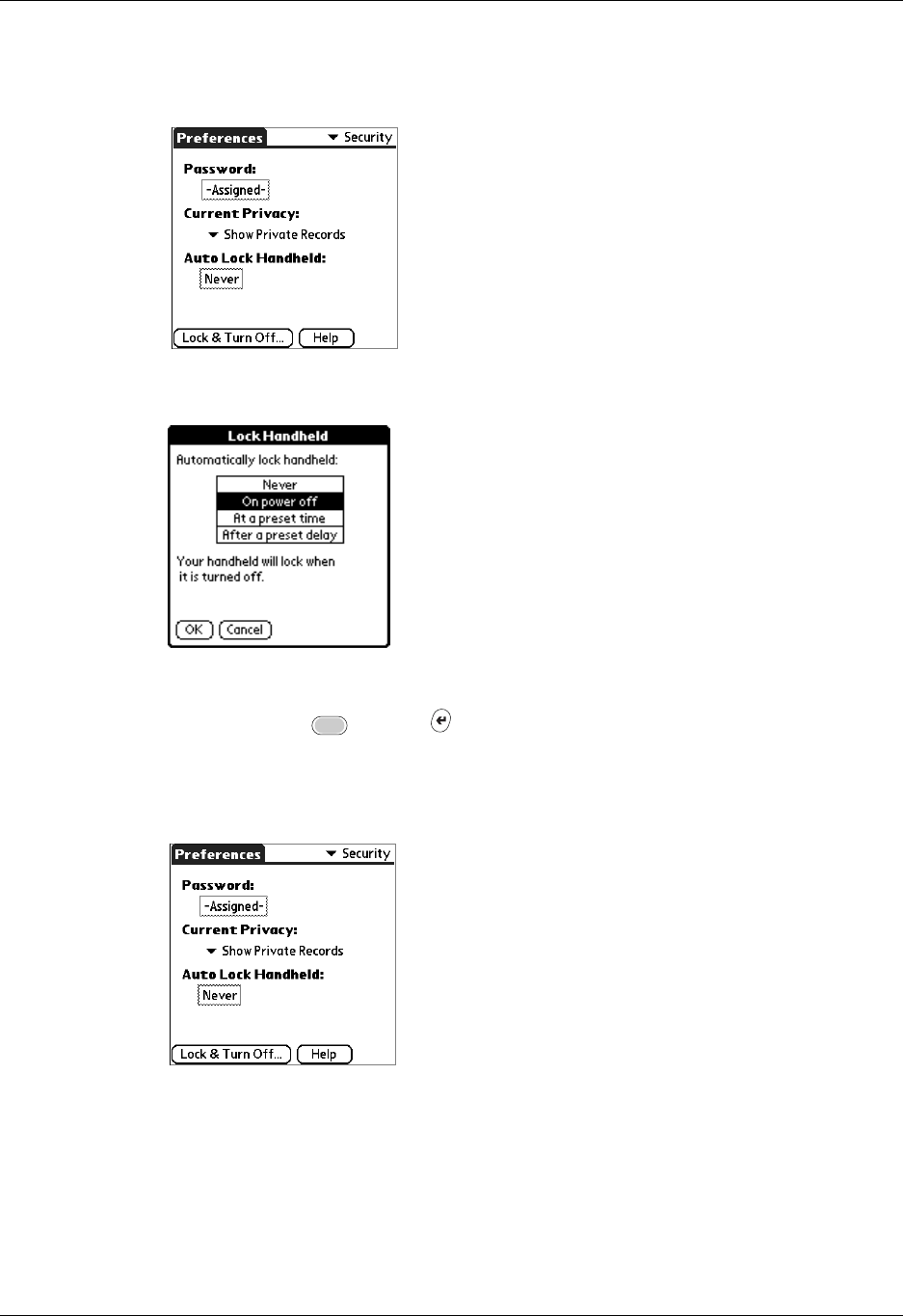
Chapter 21 Setting Preferences for Your Handheld
362
To set your handheld to lock when you turn it off:
1. Tap the Auto Lock Handheld box.
2. Enter your password.
3. Select On power off.
4. Press Function + Enter , or tap OK.
To set your handheld to lock at a preset time:
1. Tap the Auto Lock Handheld box.
2. Enter your password.
Palm, Inc. Confidential
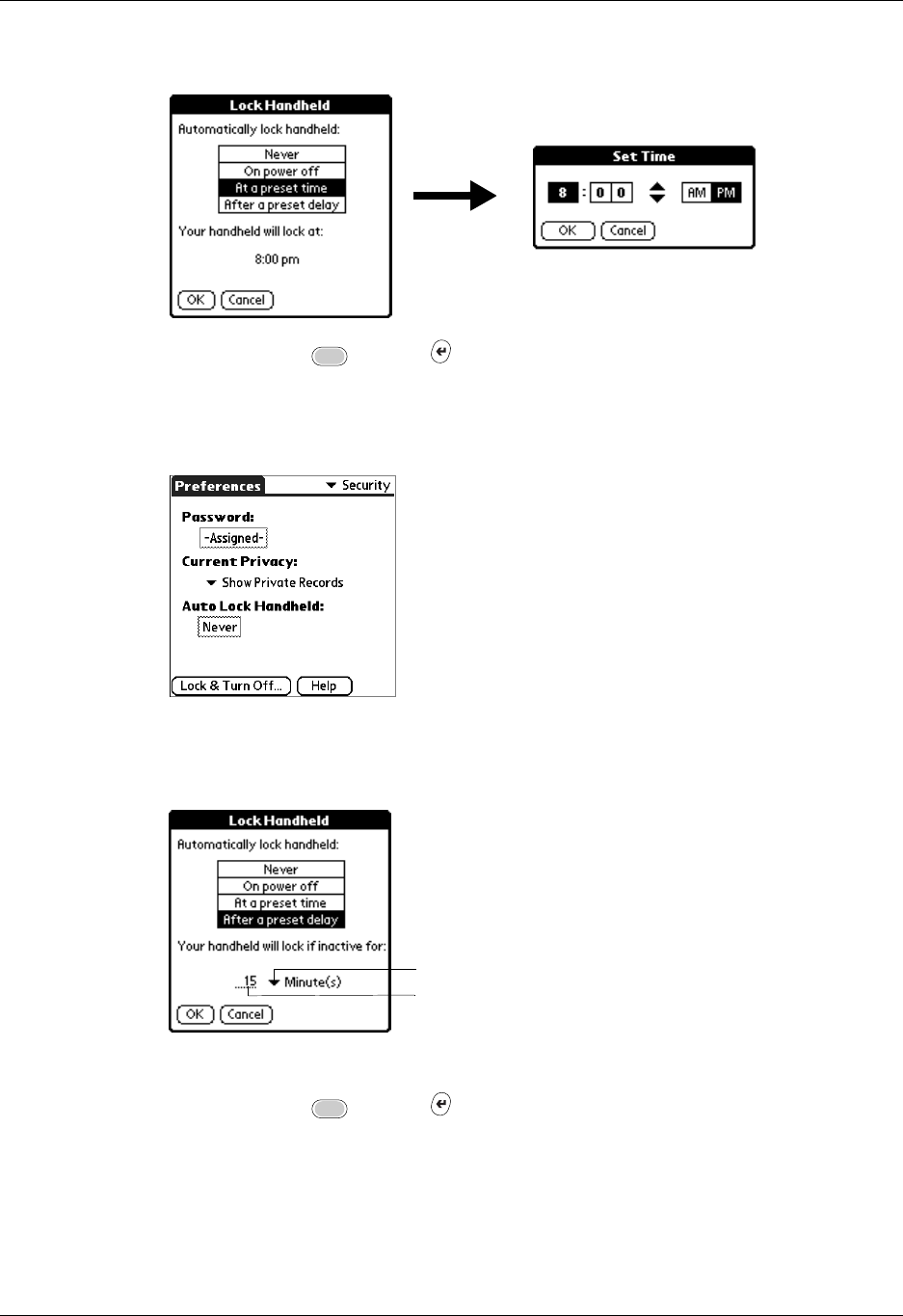
Security preferences
363
3. Select At a preset time, and then use the arrows to set the time.
4. Press Function + Enter , or tap OK.
To set your handheld to lock after a period of inactivity:
1. Tap the Auto Lock Handheld box.
2. Enter your password.
3. Select After a preset delay.
4. Enter the inactive period, and then select Minute(s) or Hour(s) from the pick list.
5. Press Function + Enter , or tap OK.
Tap to select Minutes or Hours
Enter the amount of time
Palm, Inc. Confidential
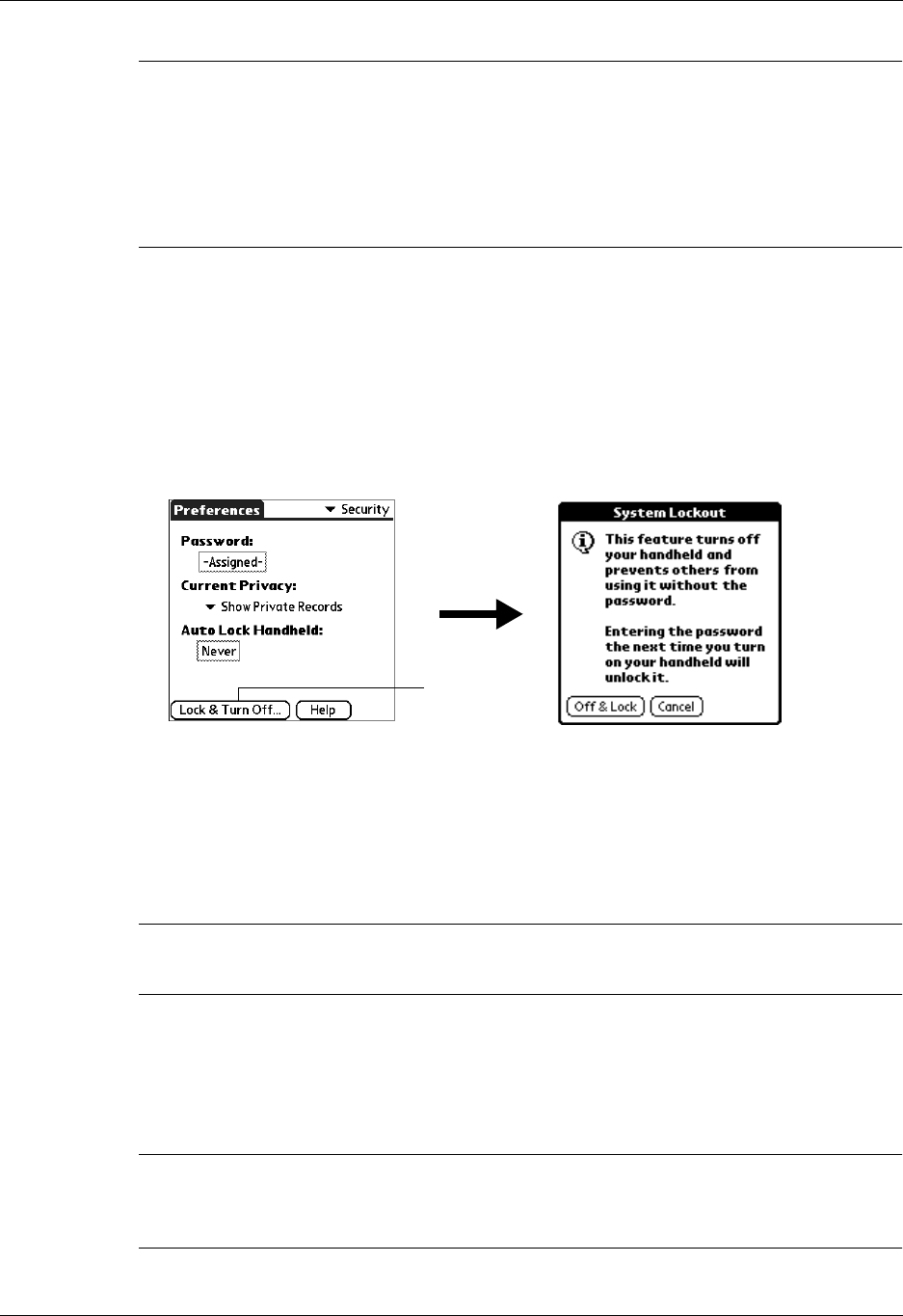
Chapter 21 Setting Preferences for Your Handheld
364
IMPORTANT If you lock your handheld, you must enter the exact password to
reactivate your handheld. If you forget the password, your handheld will present the
hint you have entered to help you remember the password. If you still cannot
remember the password, you must perform a hard reset to resume using your
handheld. Performing a hard reset deletes all the records in your handheld; however,
you can restore all synchronized data at the next HotSync operation. See “Performing
a hard reset” in Appendix A for more information.
Locking your handheld manually
You can turn off and lock your handheld manually. When the handheld is locked,
you can only make emergency calls by pressing the four application buttons
simultaneously.
To lock and turn off your handheld:
1. Tap Lock & Turn Off.
2. Tap Off & Lo ck .
3. To use your handheld, turn it on and then enter the password.
Recovering from a forgotten password
IMPORTANT Deleting a forgotten password also deletes all entries and files marked
as Private.
If you forget your password, your handheld displays the password hint, if you
entered one, to help you remember the password. If you are still unable to
remember the password, you can delete it from your handheld.
IMPORTANT If you synchronize with your computer before deleting a forgotten
password, your handheld restores your private entries the next time you perform a
HotSync operation, but it does not restore the password.
Ta p Lo ck
and Turn
Off
Palm, Inc. Confidential
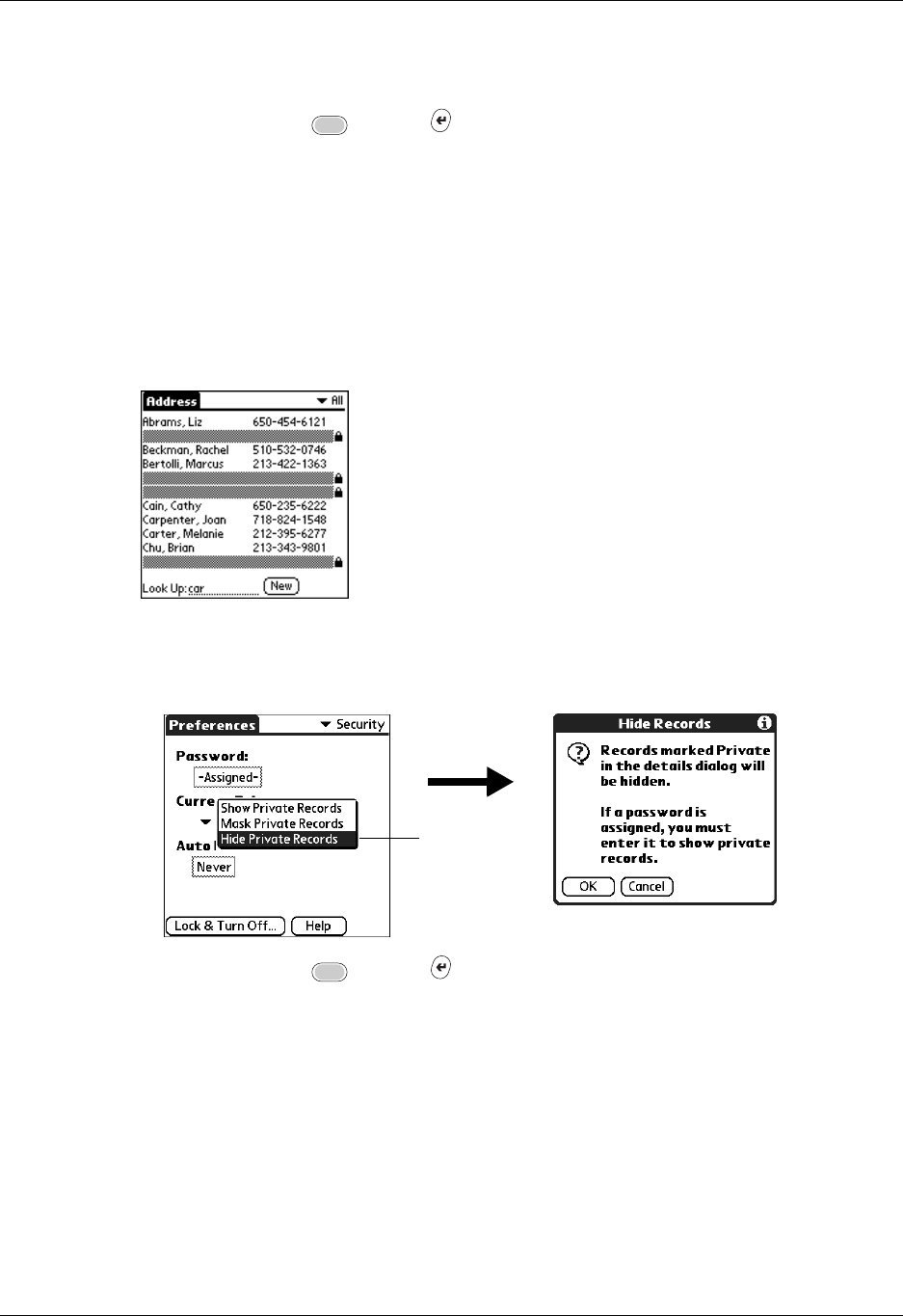
Security preferences
365
To delete a forgotten password:
1. Tap Lost Password.
2. Press Function + Enter , or tap Yes.
Making records private
In many applications, you can make individual records private. Private records
remain visible and accessible, however, until you select the Security setting to hide
or mask all private records. Masked records appear as grey placeholders in the
same position they would appear if they were not masked, and are marked with a
lock icon. Hidden records disappear completely from the screen. If you define a
password for your handheld, you must enter it to display private records.
To hide all private records:
1. Tap the Current Privacy pick list and select Hide Records.
.
2. Press Function + Enter , or tap OK to confirm that you want to hide
private records.
Tap Hide
Records
Palm, Inc. Confidential
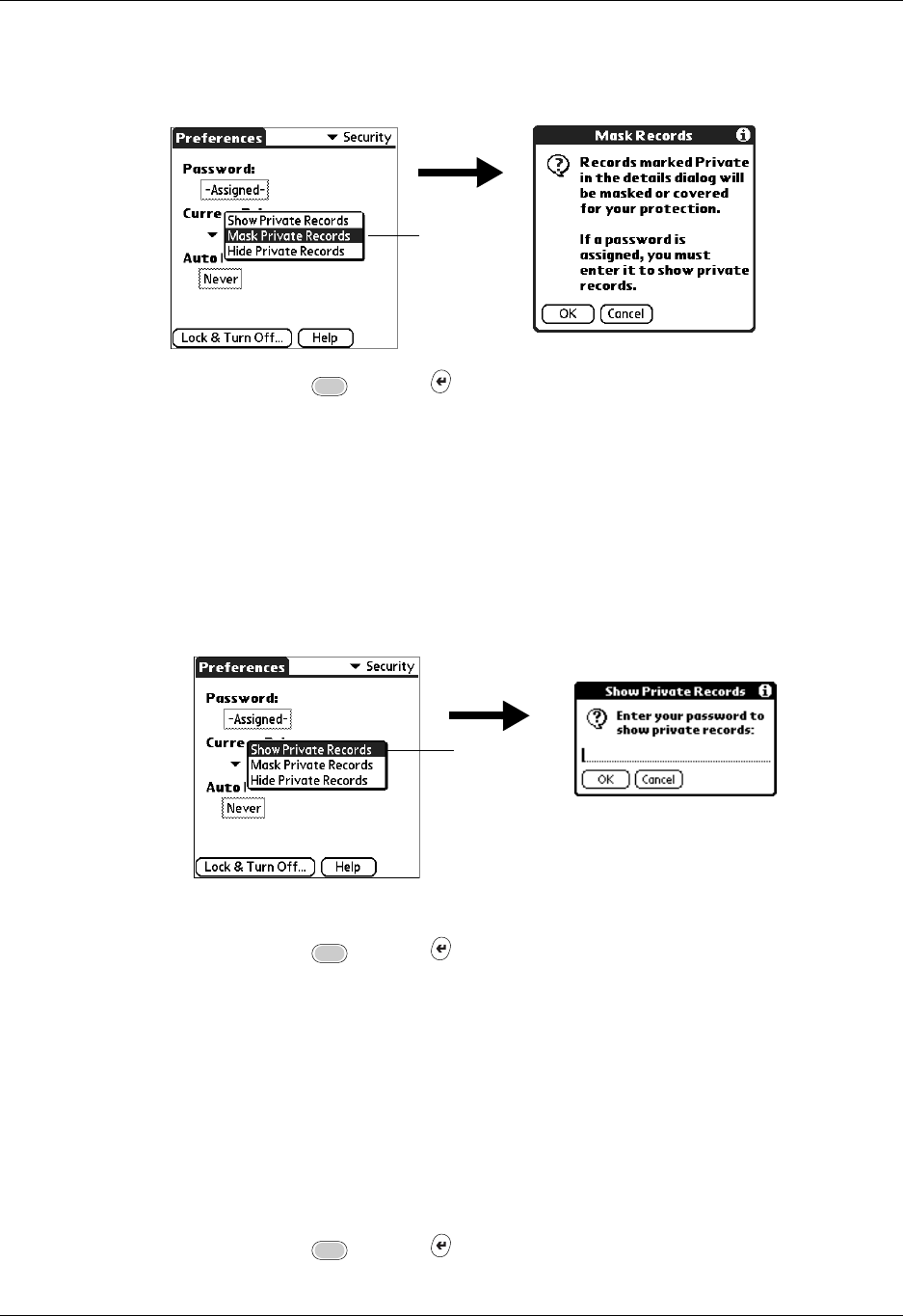
Chapter 21 Setting Preferences for Your Handheld
366
To mask all private records:
1. Tap the Current Privacy pick list and select Mask Records.
2. Press Function + Enter , or tap OK to confirm that you want to mask
private records.
To display all private records:
1. Do one of the following:
– Tap the Current Privacy pick list and select Show Records.
– If you do not have a password, hidden and masked records become visible.
If you have a password, the Show Private Records dialog box appears. Go to
step 2.
2. Enter your password.
3. Press Function + Enter , or tap OK.
To unmask individual records:
1. Select a masked record.
2. Do one of the following:
– If you do not have a password, a masked record becomes visible.
– If you have a password, the Show Private Records dialog box appears. Go to
step 3.
3. Enter your password.
4. Press Function + Enter , or tap OK.
Tap Mask
Records
Select
Show
Records
Palm, Inc. Confidential
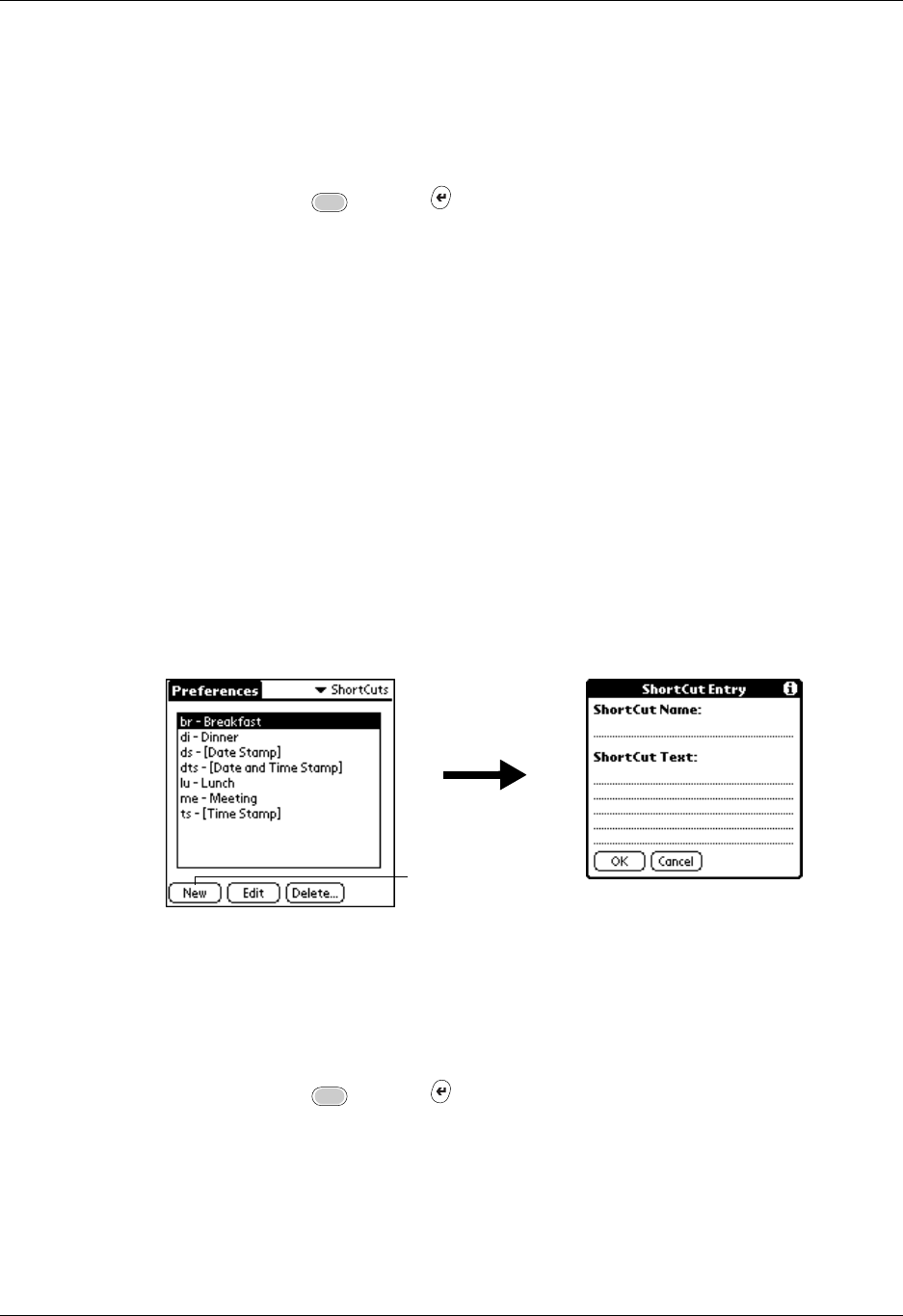
ShortCuts preferences
367
To make a record private:
1. Display the entry that you want to make private.
2. Tap De ta il s.
3. Tap the Private check box.
4. Press Function + Enter , or tap OK.
ShortCuts preferences
The ShortCuts Preferences screen enables you to define abbreviations for entering
text. This section describes how to create, edit, and delete a ShortCut.
Creating a ShortCut
You can create a ShortCut for any words, letters, or numbers. All ShortCuts you
create appear on the list in the ShortCut Preferences screen. All the ShortCuts are
available in any of your handheld applications and are backed up on your
computer when you perform a HotSync operation.
To create a ShortCut:
1. Tap New.
2. On the ShortCut Name line, enter the letters you want to use to activate the
ShortCut.
3. Select the ShortCut Text area and enter the text that you want to appear when
you write the ShortCut characters.
TIP You may want to add a space (space character) after the last word in your
ShortCut text. This way, a space automatically follows the ShortCut text.
4. Press Function + Enter , or tap OK.
Ta p N e w
Palm, Inc. Confidential
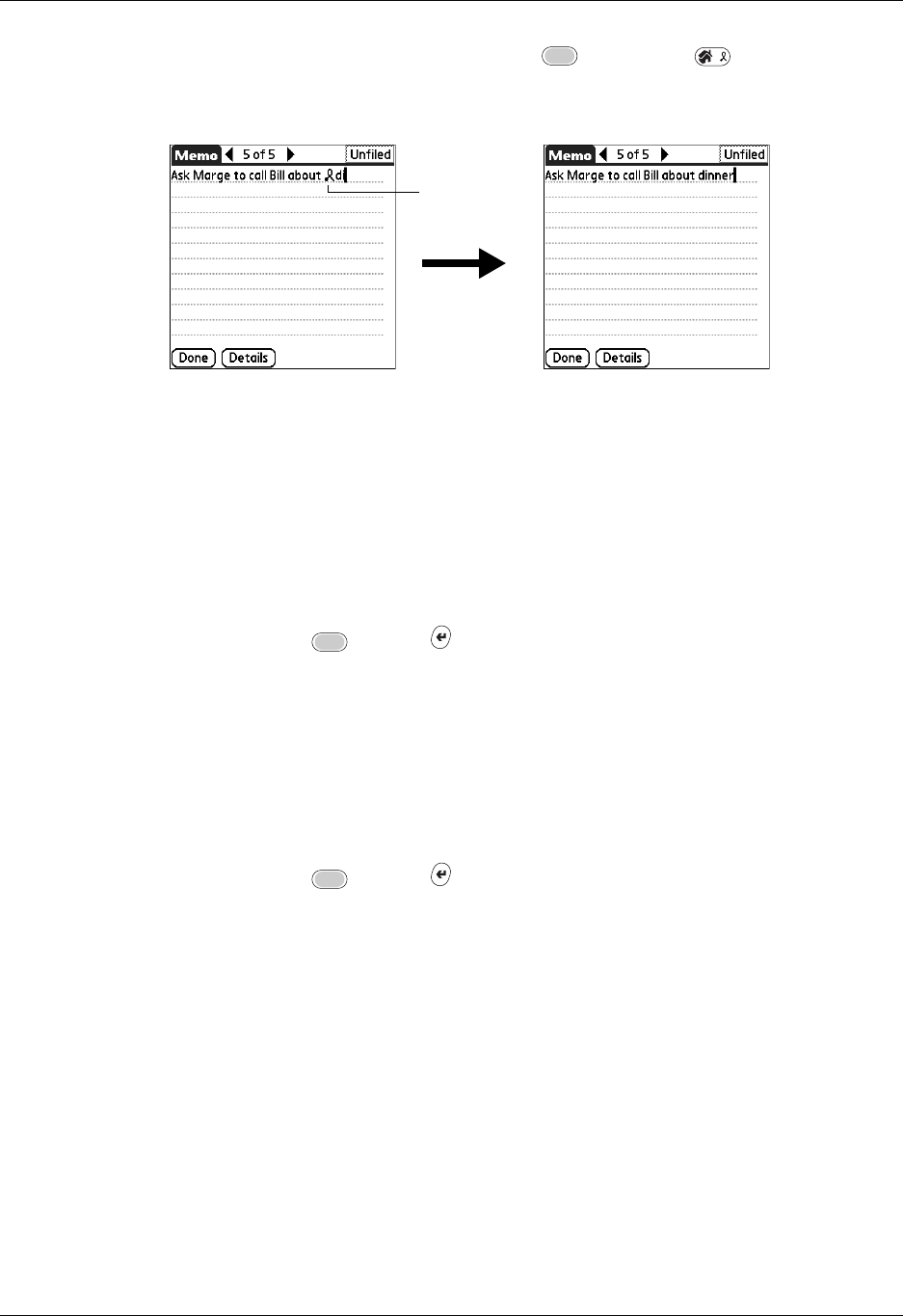
Chapter 21 Setting Preferences for Your Handheld
368
To use a ShortCut, press Press Function + ShortCut followed by the
ShortCut characters. The ShortCut symbol appears at the insertion point to
show that you are in ShortCut mode.
Editing a ShortCut
After you create a ShortCut, you can modify it at any time.
To edit a ShortCut:
1. Tap the ShortCut you want to edit.
2. Tap Edit.
3. Make the changes you want.
4. Press Function + Enter , or tap OK.
Deleting a ShortCut
If you no longer need a ShortCut, you can delete it from the list of ShortCuts.
To delete a ShortCut:
1. Tap the ShortCut you want to delete.
2. Tap Delete.
3. Press Function + Enter , or tap Yes.
ShortCut
symbol
Palm, Inc. Confidential

369
APPENDIX A
Maintaining Your Handheld
This appendix provides information on the following:
■Proper care of your handheld
■Prolonging battery life
■Resetting your handheld
■Removing and installing your SIM card
Caring for your handheld
Your handheld is designed to be rugged and reliable and to provide years of
trouble-free service. Please observe the following general tips when using your
handheld:
■Take care not to scratch the screen of your handheld. Keep the screen clean.
When working with your handheld, use the supplied stylus or plastic-tipped
pens intended for use with a touch-sensitive screen. Never use an actual pen or
pencil or other sharp object on the surface of the handheld screen.
■Your handheld is not waterproof and should not be exposed to rain or moisture.
Under extreme conditions, water may enter the circuitry through the front
panel buttons. In general, treat your handheld as you would a pocket calculator
or other small electronic instrument.
■Take care not to drop your handheld or subject it to any strong impact. Do not
carry your handheld in your back pocket: if you sit on it, you may damage it.
■Protect your handheld from temperature extremes. For example, do not leave
your handheld on the dashboard of a car on a hot day or on a day when
temperatures are below freezing, and keep it away from heaters and other heat
sources.
■Do not store or use your handheld in any location that is extremely dusty,
damp, or wet.
■Use a soft, damp cloth to clean your handheld. If the surface of the handheld
screen becomes soiled, clean it with a soft cloth moistened with a diluted
window-cleaning solution.
Palm, Inc. Confidential

Appendix A Maintaining Your Handheld
370
Battery considerations
Please note the following considerations for the battery in your handheld:
■Under normal conditions, you can keep your handheld battery charged by
placing it in the cradle between 30 and 60 minutes each day. You can conserve
battery life by minimizing the use of the backlight feature, and changing the
Auto-off setting that automatically turns the handheld off after a period of
inactivity. See “Auto-off delay” in Chapter 21 for more information.
■If the battery becomes low in the course of normal use, an alert appears on the
handheld screen describing the low battery condition. If this alert appears,
perform a HotSync® operation to back up your data; then leave your handheld
in the cradle to recharge the unit. This helps prevent accidental data loss.
■If the battery becomes too low, the wireless operations are disabled to save
battery strength.
■If the battery drains to the point where your handheld does not operate, it stores
your data safely for about five days. In this case, there is enough residual energy
in the battery to store the data, but not enough to turn on your handheld. If your
handheld does not turn on when you press the power button, you should
recharge the unit immediately. The battery may not have enough residual
energy to power the indicator light, which normally displays green when
charging.
■If your battery drains and you have the unit in an uncharged state for an
extended period of time, you can lose all of the stored data.
■There are no serviceable parts inside your handheld, so do not attempt to open
the unit.
■If you ever dispose of your handheld, please dispose of it without damaging the
environment. Take your handheld to your nearest environmental recycling
center.
Resetting your handheld
Under normal circumstances, you will not have to use the reset button. On rare
occasions, however, your handheld may no longer respond to buttons or the
screen. In this case, you need to perform a reset to get your handheld running
again.
Palm, Inc. Confidential
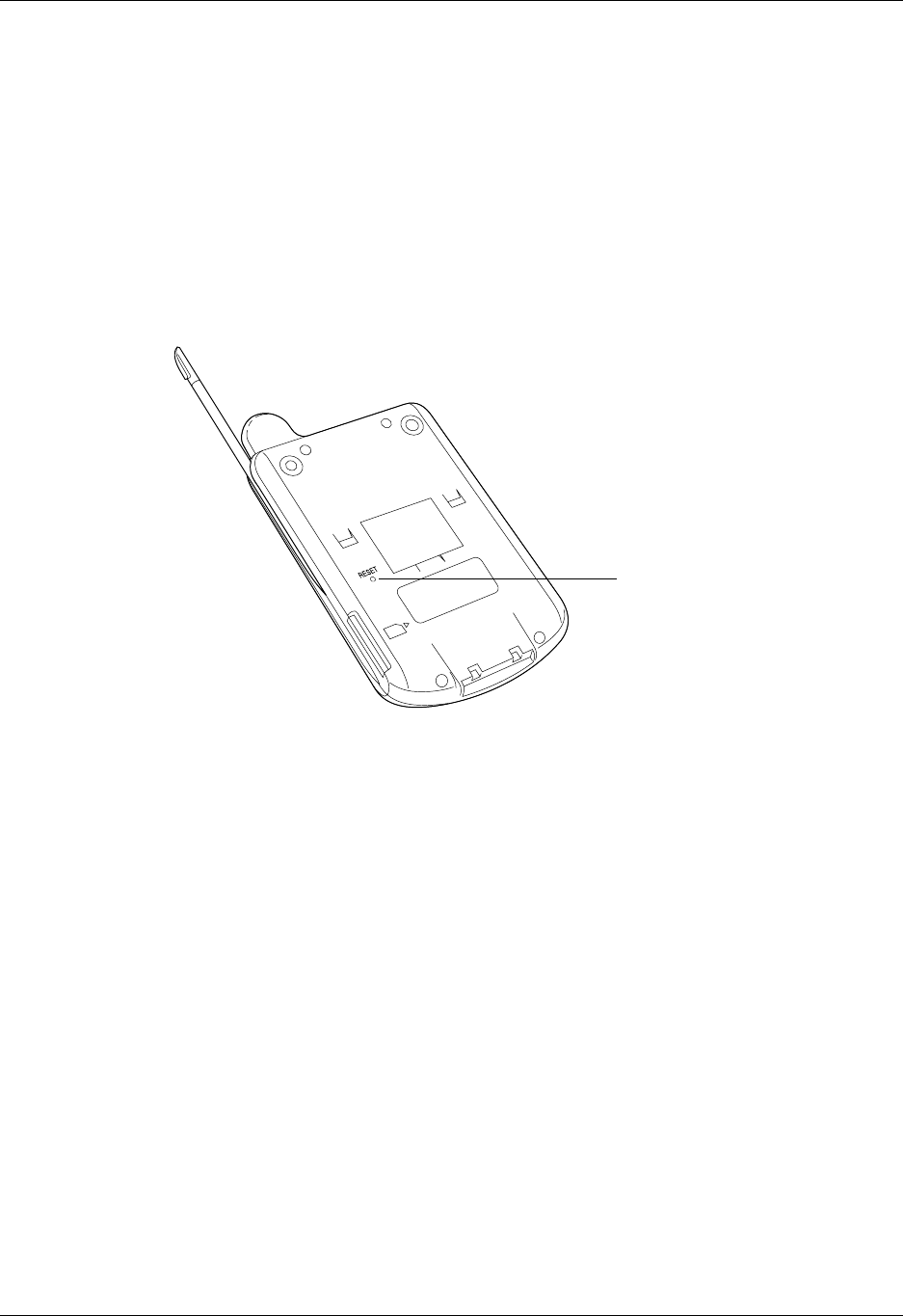
Resetting your handheld
371
Performing a soft reset
A soft reset tells your handheld to stop what it’s doing and start over again. All
records and entries stored in your handheld are retained with a soft reset. After a
soft reset, the Welcome screen appears, followed by the Date and Time Preferences
screen (to set date and time).
To perform a soft reset:
■Use the reset tip tool, or the tip of an unfolded paper clip (or similar object
without a sharp tip), to gently press the reset button inside the hole on the back
panel of your handheld.
TIP The metal and plastic stylus that comes with your handheld has a reset tip
inside. To use it, unscrew the barrel from the stylus quill.
Performing a hard reset
With a hard reset, all records and entries stored in your handheld are erased.
Never perform a hard reset unless a soft reset does not solve your problem.
NOTE You can restore any data previously synchronized with your computer during
the next HotSync operation.
To perform a hard reset:
1. Hold down the power button on the front panel of the handheld.
2. While holding down the power button, use the reset tip tool, or the tip of an
unfolded paper clip (or similar object without a sharp tip), to gently press and
release the reset button.
Reset button
Palm, Inc. Confidential
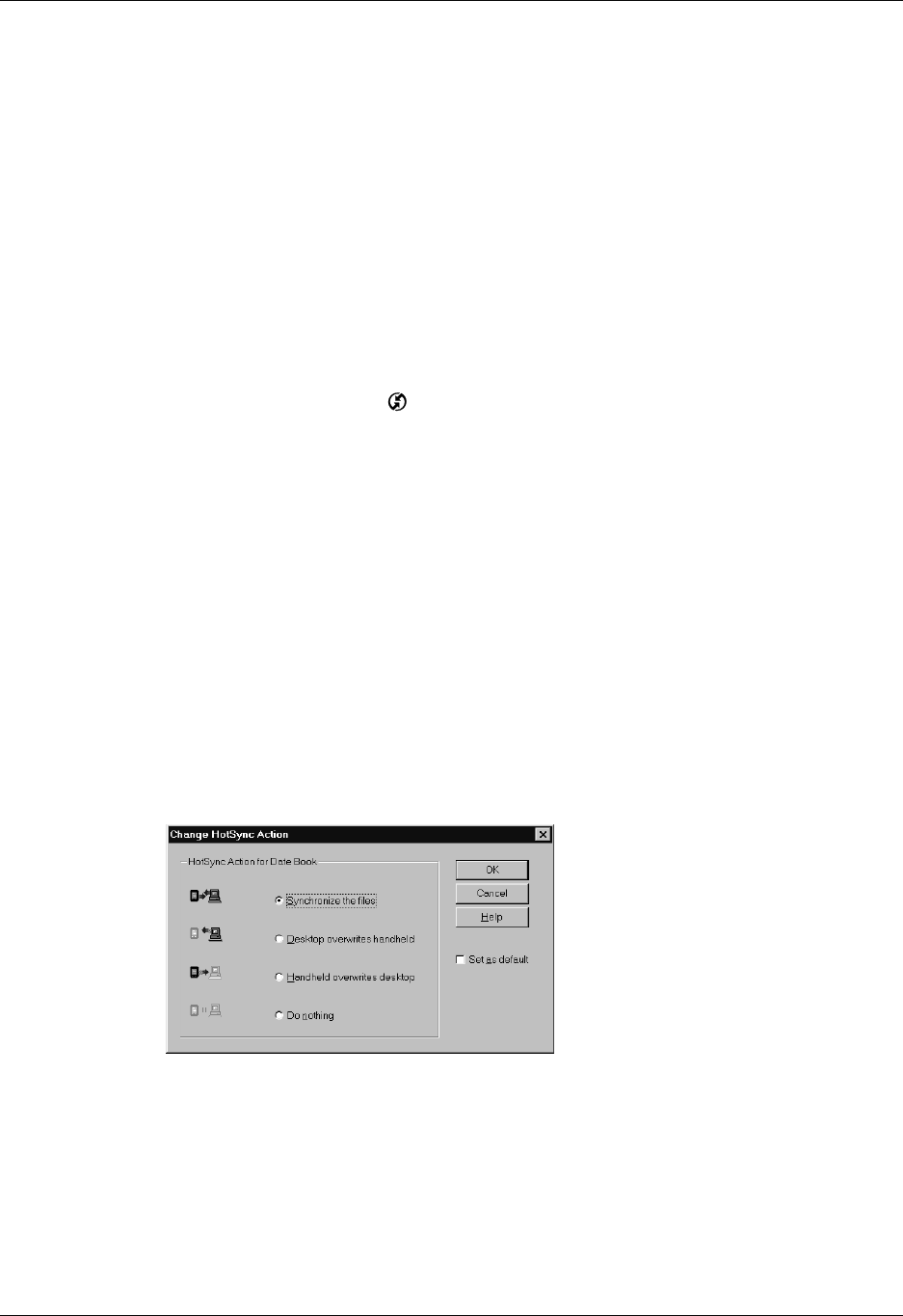
Appendix A Maintaining Your Handheld
372
3. Wait for the Palm Powered™ logo to appear; then release the power button.
4. When a message appears on the handheld screen warning that you are about to
erase all the data stored on your handheld, do one of the following:
– Press Up on the navigator to complete the hard reset and display the
Digitizer screen.
– Press any application button to perform a soft reset. (Pressing a keyboard
key has no effect.)
NOTE With a hard reset, the current date and time are retained. Formats
Preferences and other settings are restored to their factory default settings.
To restore your data from a Windows computer after a hard reset:
1. Click the HotSync icon ™ in the Windows system tray (lower-right corner of
the taskbar).
You can also click the HotSync command on the Palm™ Desktop software
menu bar.
2. From the HotSync Manager menu, select Custom.
3. Select the appropriate username from the list.
4. Select an application in the Conduit list.
5. Click Change, and select Desktop overwrites the handheld.
Changing the HotSync setting from the default affects only the next HotSync
operation. Thereafter, the HotSync Actions revert to their default settings. To
use a new setting on an ongoing basis, select the Set As Default box. Thereafter,
whatever you selected as the default setting is used when you click the Default
button in the Custom dialog box.
6. Click OK.
7. Repeat steps 4 through 6 to change conduit settings for other applications.
8. Click Done to activate your settings.
9. Perform a HotSync operation.
Palm, Inc. Confidential
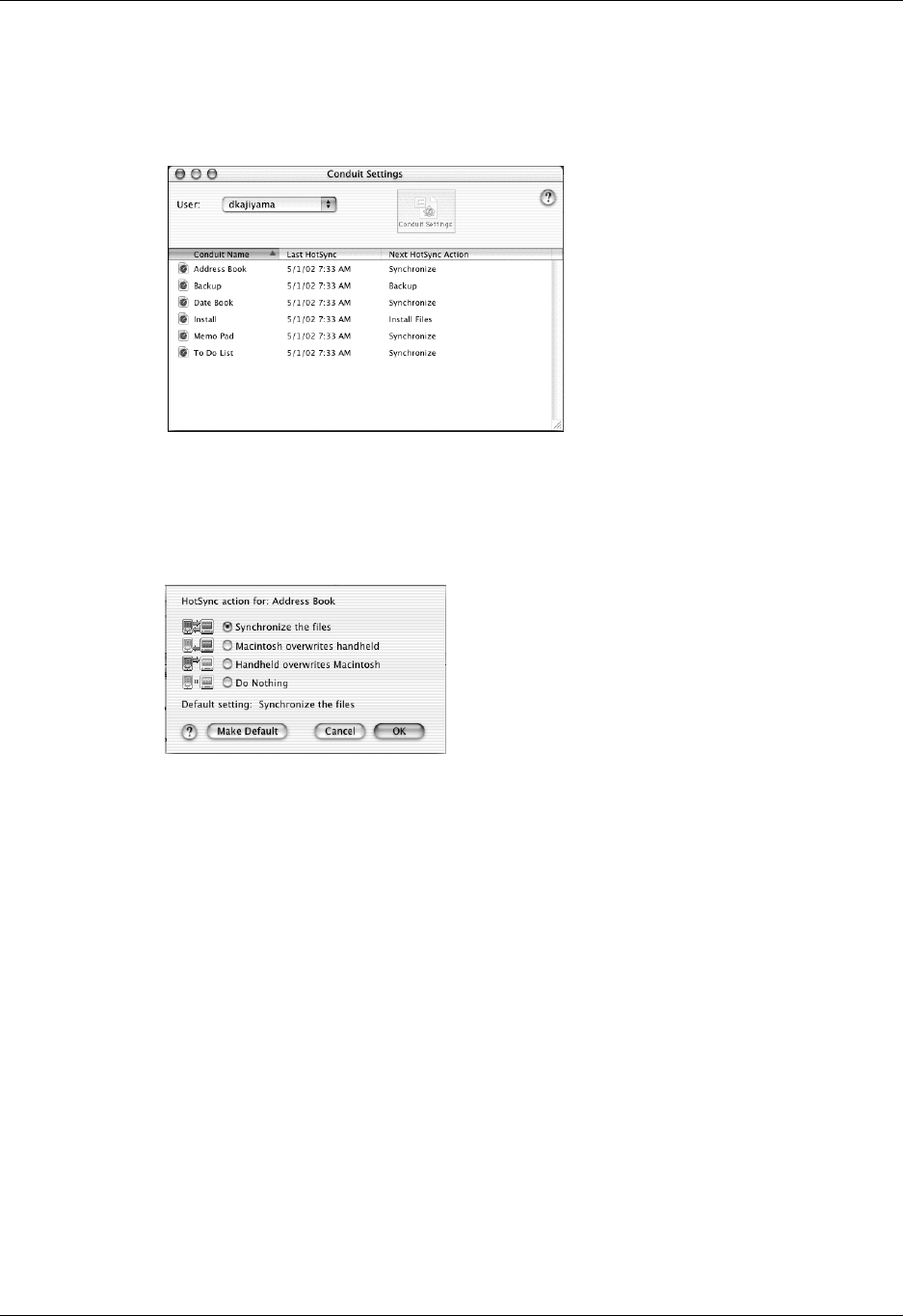
Resetting your handheld
373
To restore your data from a Mac computer after a hard reset:
1. Double-click the HotSync Manager in the Palm folder.
2. From the HotSync menu, choose Conduit Settings.
3. From the Users pop-up menu, select the appropriate username.
4. Select an application from the list.
5. Click Conduit Settings.
6. Click Macintosh overwrites handheld.
NOTE Changing the HotSync setting from the default affects only the next
HotSync operation. Thereafter, the HotSync Actions revert to their default
settings. To use a new setting on an ongoing basis, click Make Default.
Thereafter, whatever you selected as the default setting is used for HotSync
operations.
7. Click OK.
8. Repeat steps 4 through 7 to change conduit settings for other applications.
9. Close the Conduit Settings window.
10. Perform a HotSync operation.
Palm, Inc. Confidential
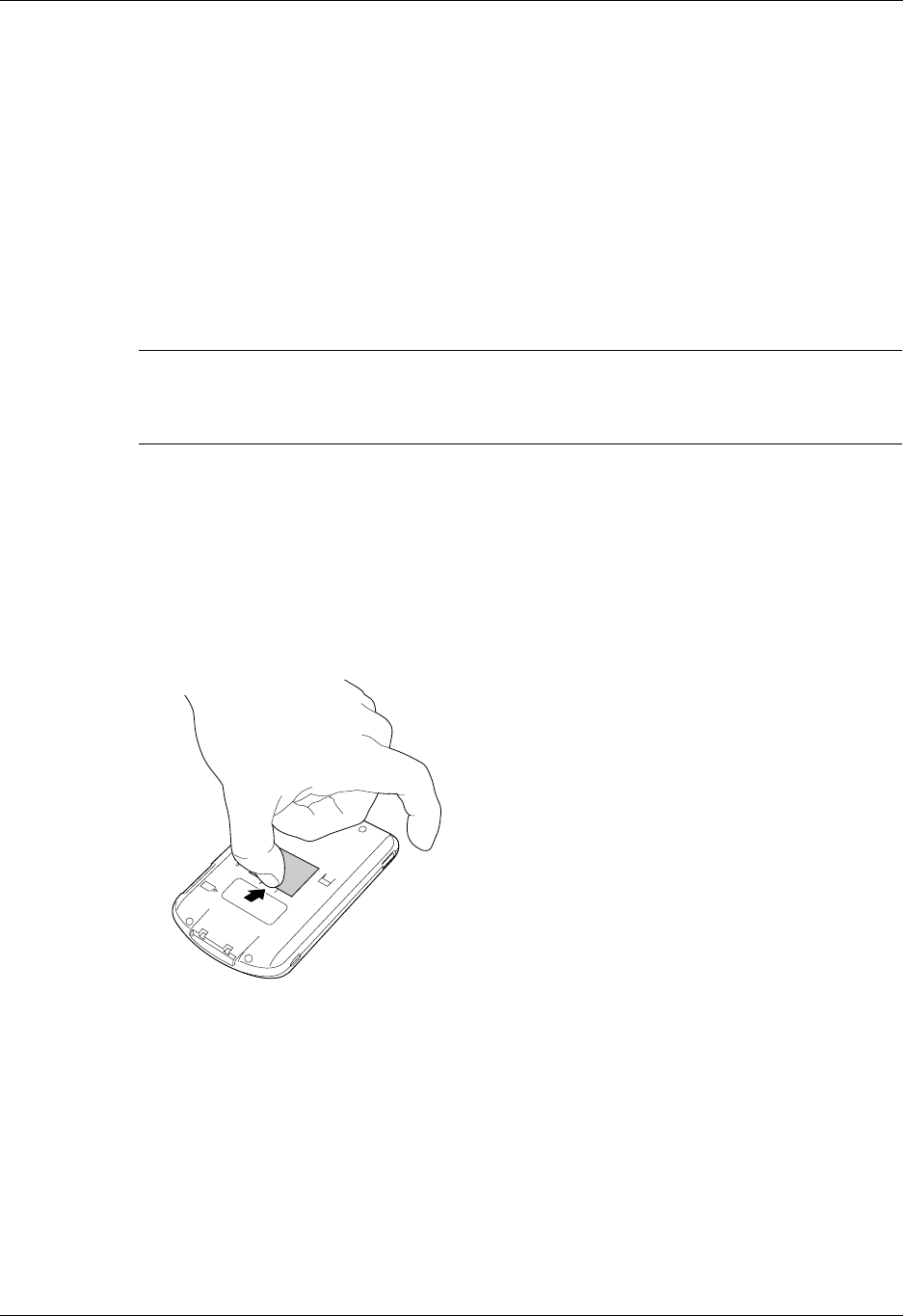
Appendix A Maintaining Your Handheld
374
Installing and removing the SIM card
With the SIM card installed, you can use your handheld’s wireless features, such
as the mobile phone, SMS, and wireless e-mail. Without the SIM card, you can
operate your handheld, but you cannot use the wireless features.
If you have not installed your SIM Card, see the Getting Started that came with your
handheld or use the following instructions. Most likely, the SIM card either is in
your package or was handed to you by a representative of your wireless service
provider. In some cases the SIM card is already installed in your handheld by your
wireless service provider.
IMPORTANT If you are sending in your handheld for service to Palm, you must
remove the SIM card before sending in your handheld. Use the following instructions
if you need to exchange or remove the SIM card.
To install the SIM card or verify installation:
1. If you have the SIM card attached to its plastic holder, carefully detach the SIM
card from the holder.
2. On the back panel of your handheld, slide a thin, flat edge (similar to your
thumb nail) in the indent and under the access door until the access door is
released.
Palm, Inc. Confidential

Installing and removing the SIM card
375
3. Do one of the following:
– If a placeholder card is present, remove the placeholder card. Then slide the
SIM card into place on the access door. Close the access door.
– If the SIM card is present (look for the gold contact area), close the access
door.
To remove the SIM card:
1. Turn off the handheld.
IMPORTANT Turn off the handheld before opening the access door and removing
the SIM card. This prevents any static discharge and damage to the connector.
2. On the back panel of your handheld, slide your thumbnail into the indent and
under the access door until the access door is released.
After removing the placeholder card,
slide the SIM card into place on the
access door
SIM card
Palm, Inc. Confidential

Appendix A Maintaining Your Handheld
376
3. Slide the SIM card out of guides on the underside of the access door. Close the
access door.
4. Place the SIM card in a nonstatic container for safe keeping.
Palm, Inc. Confidential

377
APPENDIX B
Frequently Asked Questions
If you encounter a problem with your handheld, do not call technical support until
you have reviewed the following list of frequently asked questions and you have
also reviewed the following:
■This handbook
■The Getting Started that came with your handheld
■The README file located in the folder where you installed the Palm™ Desktop
software on your Windows computer or on your installation CD for Macintosh
users
■The Palm Desktop online Help
■The Palm Desktop Software for the Macintosh User’s Guide located in the
Documentation folder on your installation CD
■The Palm Knowledge Library, accessible at www.palm.com/support/intl under
the Support section
■The most recent Palm™ Tungsten™ W handheld HelpNotes on your regional
web site
If you are still having problems, contact Technical Support. See the Customer
Support card that comes with your handheld, or go to www.palm.com/support/intl.
NOTE Thousands of third-party add-on applications have been written for Palm OS®
handhelds. Unfortunately, we are not able to support such a large number of
third-party applications. If you are having a problem with a third-party application,
please contact the developer or publisher of that software.
Palm, Inc. Confidential

Appendix B Frequently Asked Questions
378
Software installation problems
Problem Solution
The Palm Desktop Installer
Menu did not appear when I
inserted the CD-ROM into my
Windows computer.
1. Click the Start button.
2. Choose Run from the Start menu.
3. Click Browse.
4. Locate your CD-ROM drive and select the autorun.exe file.
5. Click Open.
6. Click OK.
I cannot install Palm Desktop
software on my Windows
computer.
Try the following:
1. Disable any virus scanning software on your computer.
2. Press CTRL-ALT-DELETE and end all tasks except Systray
and Explorer.
If a dialog box with buttons appears instead of a list of tasks,
click the Task List button and then end all tasks except
Systray and Explorer.
3. Make sure your computer has at least 30MB of disk space
available.
4. Delete all temporary files.
5. Run ScanDisk on your computer.
6. Reinstall Palm Desktop software.
I cannot install Palm Desktop
software on a Mac computer.
Try the following:
1. Disable any virus-scanning software on your computer.
2. Quit any open applications.
3. Make sure your computer has at least 25MB of disk space
available.
4. Reinstall Palm Desktop software.
Palm, Inc. Confidential

Operating problems
379
Operating problems
Problem Solution
I don’t see anything on my
handheld’s screen.
Try each of these in turn:
■Press an application button to ensure your handheld is
turned on.
■Press Function + Brightness . If the Brightness dialog
box appears, adjust the brightness by holding down the up
scroll button for a few seconds. If this doesn’t work, hold the
down scroll button for a few seconds.
■If your handheld was exposed to cold, make sure it is at
room temperature.
■Recharge the unit.
■Perform a soft reset. If your handheld still doesn’t turn on,
perform a hard reset. See “Resetting your handheld” in
Appendix A.
IMPORTANT With a hard reset, all records and entries stored
in your handheld are erased. Never perform a hard reset
unless a soft reset does not solve your problem. You can
restore any data previously synchronized with your computer
during the next HotSync® operation.
My battery doesn’t charge. ■Make sure the power outlet is active and the HotSync cradle
is properly plugged in.
■If the battery does not hold a charge, return your handheld
to an authorized Palm service center.
I get a warning message telling
me my handheld memory is
full.
■Purge records from Date Book and To Do List. This deletes
To Do List items and past Date Book events from the
memory of your handheld. See “Purging records” in
Chapter 4. You may need to perform a HotSync operation to
recover the memory.
■Delete unused memos and records. If necessary, you can
save these records. See “Deleting records” in Chapter 4.
■If you have installed additional applications on your
handheld, remove them to recover memory. See “Removing
applications” in Chapter 4.
Palm, Inc. Confidential

Appendix B Frequently Asked Questions
380
Tapping and writing problems
My handheld keeps turning
itself off.
Your handheld is designed to turn itself off after a period of
inactivity. This period can be set at one, two, or three minutes.
Check the Auto-off setting. See “Auto-off delay” in Chapter 21.
My handheld is not making any
sounds.
Check the System, Alarm, and Game Sound settings.
See “System, alarm, and game sounds” in Chapter 21.
My handheld’s indicator light is
not blinking when alarms occur.
Check the Alarm LED setting. See “Alarm Vibrate and
indicator light settings” in Chapter 21.
My handheld does not vibrate
when alarms occur.
Check the Alarm Vibrate setting. See “Alarm Vibrate and
indicator light settings” in Chapter 21.
My handheld has frozen. Perform a soft reset. See “Resetting your handheld” in
Appendix A.
My handheld appears to freeze
when I place it near my
computer.
Move your handheld away from the computer’s infrared port.
Problem Solution
When I tap the buttons or
screen icons, my handheld
activates the wrong feature.
Calibrate the screen. See “Digitizer preferences” in Chapter 21.
When I press Function +
Menu , or tap the Menu bar
nothing happens.
Not all applications or screens have menus. Try changing to a
different application.
Palm, Inc. Confidential

Wireless problems
381
Wireless problems
Problem Solution
The signal strength is weak. You can monitor the transmission signal strength using the
Signal Strength bar graph. Monitor the signal strength while
you try the following solutions:
■Move away from your original location, five to ten feet in
any direction.
■If you’re indoors, stand near a window, or move outdoors.
■Open metal blinds on windows.
■If you’re in an underground parking lot or other space
below street level, move to a location above ground.
■If you’re in a crowd, move to a less crowded area.
■If you’re in a vehicle, keep your handheld level with the
windshield. The metal frame of the vehicle shields mobile
radio signals. Mountains and buildings may also block
signals.
■If you’re outdoors, move away from overhead electrical
wires. Move from under trees.
I can’t access the Internet. ■Check the battery icon to verify that the battery is charged.
■Make sure the mobile radio is on and within range by
verifying that the indicator light is flashing green.
See “Using the indicator light” in Chapter 2.
■Verify that the signal strength indicator shows a strong
signal.
■Your wireless service provider’s server may be down. Try
again later.
Palm, Inc. Confidential

Appendix B Frequently Asked Questions
382
I can’t access a web page or a
web clipping application.
■Make sure the mobile radio is on and within range by
verifying that the indicator light is flashing green.
See “Using the indicator light” in Chapter 2.
■Try to access the home page of your wireless carrier by
pressing the Wireless button.
– If you can access the home page, network service is
available. It may be that the web page or the web clipping
server currently is not accessible. Try again later.
– If you cannot access the home page, network service may
be down. Try again later.
■For questions and support for third-party web clipping
applications, please contact the software developer directly.
I am having a problem
establishing a network
connection.
■Display expanded Service Connection Progress messages.
It’s helpful to identify at what point in the login procedure
the connection fails. An easy way to do this is to display the
expanded Service Connection Progress messages.
Expanded Service Connection Progress messages describe
the current stage of the login procedure. Press Up on the
navigator during login to display these messages.
■View the Network Log.
If viewing the expanded Service Connection Progress
messages does not give you enough information to find out
why you cannot connect to your wireless service provider
or dial-in server, take a look at the Network Log. The
Network Log lists all of the communication that occurs
between your modem and your dial-in server during the
login procedure. The information in the Network Log can
help your wireless service provider or your system
administrator pinpoint where the login procedure
communication fails and why.
To view the Network Log, go to the Network Preferences
screen and press Command Stroke + V. (Alternately,
press Function + Menu . Select Options, and then
select View Log.)
Palm, Inc. Confidential

Wireless problems
383
Palm WAP Browser problems
I am having a problem
establishing a network
connection. (continued)
■Add a DNS number.
If your wireless service provider or dial-in server requires a
DNS number and you did not enter that information in the
Network Preferences screen, it will appear that you
successfully logged into your network. When you try to use
an application or look up information, however, the
connection fails. If this occurs, try adding a DNS number.
Ask your wireless service provider or your system
administrator for the correct primary and secondary DNS IP
numbers.
Problem Solution
I cannot connect to my wireless
service provider.
You may need to enter additional technical networking
information. Contact your wireless service provider to
obtain their primary and secondary DNS address and their
IP address.
I can connect to my ISP, but I can’t
access a WAP site.
Try alternate WAP sites. A WAP site could be temporarily
unavailable due to site problems.
If you can’t access the alternate sites, then contact your ISP
and verify the following WAP browser settings: APN,
Mode, and Gateway Server. Also check Gateway ID and
Gateway password, if applicable.
I can’t access some WAP sites. The WAP browser can access all WAP web sites compliant
to WAP version 1.1 or WAP version 1.2.1 (WAP June 2000
Conformance Release).
I can’t access an HTML web site. The WAP browser does not open HTML web sites, only
WML web sites.
When generating a new password
or signature key pair, my handheld
froze.
Key generation can take up to an hour. During this time,
your handheld appears to be completely frozen and you
are not able to use your handheld.
I am having problems within a
specific WAP Internet site.
Contact the site administrator.
Palm, Inc. Confidential

Appendix B Frequently Asked Questions
384
SMS problems
Palm Mobile problems
Application problems
Problem Solution
I cannot connect to my
SMS center.
You may need to enter the SMS center telephone number in
the SMS Preferences Details dialog box. To find this number,
check your mobile phone options screen or your wireless
service provider’s web site. See “Setting preferences” in
Chapter 15 for details.
Problem Solution
I connect to my wireless service
provider, but the number
doesn’t work.
■Be sure the telephone number you are dialing has all the
digits required by your wireless service provider. If you are
dialing an international telephone number, a + (plus) sign
might be required at the beginning of the telephone
number.
■Verify that your wireless service provider plan includes
phone services. Contact your wireless service provider for
information.
Problem Solution
I tapped the Today button, but
it does not show the correct
date.
Your handheld is not set to the current date. Make sure the Set
Date box in the Date and Time Preferences screen displays the
current date. See “Date and Time preferences” in Chapter 21
for more information.
I know I entered some records,
but they do not appear in the
application.
■Check the Categories pick list (upper-right corner). Choose
All to display all of the records for the application.
■Check Security and confirm that Private Records is set to
Show private records.
■In To Do List, tap Show and see if Show Only Due Items is
selected.
Palm, Inc. Confidential

Application problems
385
I am having problems listing
memos the way I want to see
them.
■If you cannot manually arrange the order of the memos in
the list screen, check the Memo Preferences setting. Make
sure that Sort by is set to Manual.
■If you choose to view your memos alphabetically on Palm
Desktop software and then perform a HotSync operation,
the memos on your handheld still appear in the order
defined in the Memo Preferences setting. In other words, the
sort settings you use with Palm Desktop software are not
transferred to your handheld.
I created an event in Date Book,
but it doesn’t appear in the
Week View.
In the Week View, you cannot select overlapping events that
have the same start time. If you have two or more events with
the same start time, choose the Day View to see the
overlapping events.
My vCard or vCal e-mail
attachment isn’t forwarding
correctly.
Palm Desktop software provides several features that interact
with e-mail client software on a Windows computer. In order
for these features to work correctly, the e-mail client software
must be properly configured. Follow these steps to check the
configuration:
1. Click the Windows Start menu, and then select Settings.
2. Select Control Panel.
3. Select Internet Options, and then click the Programs tab.
4. Make sure that the E-mail field is set to the correct E-Mail
client software.
5. Click OK.
6. Start the e-mail client software and make sure it is
configured as the default MAPI client. Consult the
documentation for your desktop E-Mail application for
more information.
Palm, Inc. Confidential

Appendix B Frequently Asked Questions
386
HotSync problems
Problem Solution
I cannot perform a HotSync
operation; what should I check
to make sure I am doing it
correctly?
Make sure the HotSync cradle is connected securely.
On a Windows computer try these steps:
■Check the Windows system tray to make sure the HotSync
Manager is running. If it is not, open Palm Desktop
software.
■Make sure you selected Local USB or Local Serial, as
appropriate, from the HotSync Manager menu.
■If you are using the serial cradle, make sure you selected the
correct serial port on the Local tab in the Setup dialog box.
It should be set to the port where you connected the
HotSync cradle.
On a Mac computer, try the following:
■Make sure HotSync Manager is enabled. If it is not, double-
click the HotSync Manager icon in the Palm folder and
enable HotSync Manager on the HotSync Controls tab.
I performed a HotSync
operation, but one of my
applications did not
synchronize.
■On a Windows computer, click the HotSync Manager and
choose Custom. Check that the correct conduit is active.
■On a Mac computer, double-click the HotSync Manager
icon. From the HotSync menu, choose Conduit Settings.
Select your username from the User pop-up menu, and
check that the correct conduit is active.
I am using Outlook as my PIM,
but I cannot do a HotSync
operation.
■Click the HotSync Manager and choose Custom. Check that
the correct conduit is active.
■Check that the correct conduit is installed. Reinstall the
HotSync Manager and make sure the correct conduit is
selected.
I cannot launch the HotSync
Manager.
■If you are using the optional serial cradle, or if you are
performing a HotSync operation using a modem, make sure
you are not running another program, such as America
Online, that uses the serial port you selected in the Setup
dialog box.
■Back up the Palm Desktop software, uninstall it, and then
reinstall it.
Palm, Inc. Confidential

HotSync problems
387
I tried to perform a local
HotSync operation, but it did
not complete successfully.
■Make sure your handheld is seated in the cradle correctly.
■Check the connection between the HotSync cradle and the
USB or serial port on your computer.
■Make sure the username you selected in Palm Desktop
software matches the username assigned to your handheld.
■Make sure the date on your computer matches the date on
your handheld.
■Read the HotSync Log for the user account for which you
are performing a HotSync operation.
On a Windows computer, try each step in turn:
■Make sure HotSync Manager is running. If it is running,
close it, and restart it.
■Make sure you selected Local USB or Local Serial, as
appropriate, from the HotSync Manager menu.
■If you are using the serial cradle, make sure you selected the
correct serial port on the Local tab in the Setup dialog box.
It should be set to the port where you connected the
HotSync cradle.
■If you are using the serial cradle, try a lower baud rate
setting on the Local tab in the Setup dialog box.
■If you are using the serial cradle, make sure you aren’t
running a program, such as America Online, that uses the
serial port you selected in the Setup dialog box.
On a Mac computer, try the following:
■Make sure that HotSync Manager is enabled on the HotSync
Controls tab in the HotSync Software Setup window.
Palm, Inc. Confidential

Appendix B Frequently Asked Questions
388
I tried to perform a modem
HotSync operation, but it did
not complete successfully.
Check the following on your computer:
■Make sure your computer is turned on and that it does not
shut down automatically as part of an energy-saving
feature.
■Make sure the modem connected to your computer is
turned on and is connected to the outgoing phone line.
■Make sure the modem you are using with your handheld
has an on-off switch. Your handheld cannot “wake up” a
modem that has an auto-off feature.
■Make sure the modem is connected properly to your
computer and is connected to the incoming phone line.
On a Windows computer, check the following:
■Make sure that Modem is checked in the HotSync Manager
menu.
■Confirm that the Setup String in the Setup dialog box
configures your modem correctly. You may need to select a
different Modem Type or enter a custom Setup String. Most
modems have a Setup String that causes them to send initial
connection sounds to a speaker. You can use these sounds to
check the modem connection.
■Confirm that the Speed setting in the Setup dialog box
works for your modem. If you have problems using the As
Fast As Possible option or a specific speed, try using a
slower speed.
■Make sure you are not running another program, such as
WinFax, CompuServe, or America Online, that uses the
serial port you selected in the Setup dialog box.
■Make sure your modem resets before you try again. (Turn
off your modem, wait a minute, and then turn it back on.)
On a Mac computer, check the following:
■Make sure that Modem is selected on the Connection
Settings tab in the HotSync Software Setup window.
■You may need to select a different Modem type or enter a
Custom setup string on the Connection Settings tab. Most
modems have a setup string that causes them to send initial
connection sounds to a speaker. You can turn on the Modem
Speaker option and use these sounds to check the modem
connection.
Palm, Inc. Confidential

HotSync problems
389
I tried to perform a modem
HotSync operation, but it did
not complete successfully.
(continued)
■Make sure you are not running another program, such as
America Online, fax or telephony software, or AppleTalk
networking, that uses the serial port you selected in the
Serial Port Settings tab.
■Make sure your modem resets before you try again. (Turn
off your modem, wait a minute, and then turn it back on.)
Check the following on your handheld:
■Confirm that the telephone cable is securely attached to
your modem.
■Make sure the dialing instruction dials the correct phone
number.
■If you need to dial an outside line prefix, make sure you
selected the Dial Prefix option on your handheld and
entered the correct code.
■If the telephone line you are using has Call Waiting, make
sure you selected the Disable call waiting option under
Modem Sync Phone Setup on your handheld and entered
the correct code.
■Make sure the telephone line you are using is not noisy,
which can interrupt communications.
■Check the batteries in your modem and replace them if
necessary.
I can’t perform an IR HotSync
operation.
■On a Windows computer, be sure the HotSync Manager is
running and the Serial Port for local operations is set to the
simulated port for infrared communication.
See “Conducting IR HotSync operations” in Chapter 20 for
details.
■On a Mac, open the HotSync Software Setup window and be
sure that HotSync Manager is enabled and that the IR Port
Connection Setting is set to On. See “Conducting IR
HotSync operations” in Chapter 20 for more information.
■On your handheld, be sure the HotSync application is set to
Local, with the option IR to PC/Handheld.
■Be sure the IR port of your handheld is aligned directly
opposite to, and within a few inches of, the infrared device
of your computer.
■IR HotSync operations do not work after you receive a low
battery warning. Check the battery power of your
handheld. Recharge the internal battery.
Palm, Inc. Confidential

Appendix B Frequently Asked Questions
390
When I press the HotSync
button on the cradle, nothing
happens on Palm Desktop
software and my handheld
times out.
■Make a copy of your Palm folder. Uninstall, and then
reinstall, Palm Desktop software.
■Turn on your handheld and press the Home . Tap the
HotSync icon, and then tap Local.
When I perform a HotSync
operation, my information does
not transfer to Palm Desktop
software.
■If you perform a HotSync operation for more than one
device, make sure the correct user is active on the Palm
Desktop software.
■If you have performed a HotSync operation successfully but
you cannot find the data from your handheld on Palm
Desktop software, check to see that you have the correct
user name selected for viewing data.
■On a Windows computer, click the HotSync Manager and
choose Custom. Check that all conduits are set to
synchronize files.
■On a Mac computer, double-click the HotSync Manager
icon. From the HotSync menu, choose Conduit Settings.
Select your username from the User pop-up menu, and
check that the correct conduit is active.
My handheld displays the
message “Waiting for sender”
when it’s near my computer’s
infrared port.
■Your computer’s infrared port may be set to search
automatically for the presence of other infrared devices.
Consult the documentation for your operating system for
information about turning off this option.
■In some cases, simply moving your handheld away from the
computer’s infrared port solves the problem.
I want to synchronize my
computer with more than one
handheld.
■If the computer running Palm Desktop software
synchronizes with more than one handheld, each handheld
must have a unique name. Assign a username to your
handheld the first time you perform a HotSync operation.
■Please be aware that synchronizing more than one handheld
with the same username causes unpredictable results and,
potentially, loss of your personal information.
Palm, Inc. Confidential

Beaming problems
391
Beaming problems
Recharging problems
Problem Solution
I cannot beam data to another
device with an IR port.
■If you are beaming to another Palm handheld, confirm that
your handheld and the other handheld are between ten
centimeters (approximately 4") and one meter
(approximately 39") apart, and that the path between the
two handhelds is clear of obstacles. Beaming distance to
other devices with an IR port may be different.
■Move your handheld closer to the receiving device.
When someone beams data to
my handheld, I get a message
telling me it is out of memory.
■Your handheld requires at least twice the amount of
memory available as the data you are receiving. For
example, if you are receiving a 30KB application, you must
have at least 60KB free.
■Perform a soft reset. See “Performing a soft reset” in
Appendix A for more information.
Problem Solution
When I place my handheld in
the cradle, the indicator light
does not go on.
■Confirm that your handheld is well seated in the cradle.
■Confirm that your recharger cable is properly connected to
the back of the cradle’s USB or serial port connector that
plugs into your computer.
■Confirm that your recharger is plugged into an AC outlet
that has power.
■If you have not used your handheld for a long period, such
as an extended vacation, the battery may not contain
enough charge to power the indicator light. After your
handheld has recharged, the indicator light will function
normally.
Palm, Inc. Confidential

Appendix B Frequently Asked Questions
392
Password problems
Technical support
If, after reviewing the sources listed at the beginning of this appendix, you cannot
solve your problem, contact your regional technical support office by e-mail,
phone, or fax.
Before requesting support, please experiment a bit to reproduce and isolate the
problem. When you do contact support, please be ready to provide the following
information:
■The name and version of the operating system you are using
■The actual error message or state you are experiencing
■The steps you take to reproduce the problem
■The version of handheld software you are using and available memory
■The wireless service provider’s name
■The software version of your mobile radio
Problem Solution
I forgot the password, and my
handheld is not locked.
First, use the password hint to try and remember the password.
If this does not help, or if you do not have a password hint, you
can use Security to delete the password, but your handheld
deletes all entries marked as private. However, if you perform
a HotSync operation before you delete the password, the
HotSync process backs up all entries, whether or not they are
marked private. Then you can follow these steps to restore
your private entries:
■Use the Palm Desktop software and the cradle or infrared
communication to synchronize your data.
■Tap Forgotten Password in Security to remove the
password and delete all private records.
■Perform a HotSync operation to synchronize your data and
restore the private records by transferring them from your
computer to your handheld.
I forgot the password and my
handheld is locked.
First, use the password hint to try and remember the password.
If this does not help, or if you do not have a password hint, you
must perform a hard reset to continue using your handheld.
See “Performing a hard reset” in Appendix A for more
information.
Palm, Inc. Confidential

Technical support
393
To find your handheld version and memory information:
1. Press the Home .
2. Press Command Stroke + L.
Alternately, press Function + Menu , and then select Info on the App
Menu.
NOTE Thousands of third-party add-on applications have been written for
Palm OS handhelds. Unfortunately, we are not able to support such a large
number of third-party applications. If you are having a problem with a third-
party application, please contact the developer or publisher of that software.
3. Tap Version to see version numbers, and tap Size to see the amount of free
memory in kilobytes.
To find your wireless service provider’s name and mobile radio software version:
1. Press the Home .
2. Tap the Preferences icon .
3. Tap the pick list in the upper-right corner of the screen.
4. Select Mobile.
5. Select Current status.
6. Scroll down to SV number to view the software version of your mobile radio.
Palm, Inc. Confidential

Appendix B Frequently Asked Questions
394
Palm, Inc. Confidential

395
Product Regulatory and Safety Information
FCC Statement
This device complies with part 15 of the FCC rules. Operation is subject to the following two
conditions: (1) This device may not cause harmful interference, and (2) this device must accept any
interference received, including interference that may cause undesired operation.
NOTE This equipment has been tested and found to comply with the limits for a Class B digital device,
pursuant to Part 15 of the FCC rules. These limits are designed to provide reasonable protection against
harmful interference in a residential installation. This equipment generates, uses, and can radiate radio
frequency energy and, if not installed and used in accordance with the instructions, may cause harmful
interference to radio communications. However, there is no guarantee that interference will not occur in a
particular installation. If this equipment does cause harmful interference to radio or television reception,
which can be determined by turning the equipment off and on, the user is encouraged to try to correct the
interference by one or more of the following measures:
■Reorient or relocate the receiving antenna.
■Increase the separation between the equipment and receiver.
■Connect the equipment into an outlet on a circuit different from that to which the receiver is connected.
■Consult the dealer or an experienced radio/TV technician for help.
The use of shielded I/O cables is required when connecting this equipment to any and all optional
peripheral or host devices. Failure to do so may violate FCC rules.
CAUTION Changes or modifications not covered in this manual must be approved in writing by the
manufacturer’s Regulatory Engineering Department. Changes or modifications made without written
approval may void the user’s authority to operate this equipment.
In August 1996, the Federal Communications Commission (FCC) of the United States with its action
in Report and Order FCC 96-326 adopted an updated safety standard for human exposure to radio
frequency electromagnetic energy emitted by FCC regulated transmitters. Those guidelines are
consistent with the safety standard previously set by both U.S. and international standards bodies.
The design of this product complies with the FCC guidelines and these international standards.
Exposure To Radio Frequency Energy (SAR)
In order to comply with FCC RF exposure safety guidelines, users MUST use a Palm brand body-
worn accessory during body-worn operation. Use of accessories not provided by Palm or that have
not been tested for RF exposure compliance with this product may not comply with the FCC RF
exposure safety guidelines and should not be used.
Palm, Inc. Confidential

Product Regulatory and Safety Information
396
Industry Canada
The term "IC:" before the certification/registration number only signifies that the Industry Canada
technical specifications were met.
Battery Warning
Do not mutilate, puncture, or dispose of batteries in fire. The batteries can burst or explode, releasing
hazardous chemicals.
Varning
Eksplosionsfara vid felaktigt batteribyte. Använd samma batterityp eller en ekvivalent typ som
rekommenderas av apparattillverkaren. Kassera använt batteri enligt fabrikantens instruktion.
Advarsel!
Lithiumbatteri—Eksplosionsfare ved fejlagtig håndtering. Udskiftning må kun ske med batteri af
samme fabrikat og type. Levér det brugte batteri tilbage tilleverandøren.
Varoitus
Paristo voi räjähtää, jos se on virheellisesti asennettu. Vaihda paristo ainoastaan valmistajan
suosittelemaan tyyppiin. Hävitä käytetty paristo valmistajan ohjeiden mukaisesti.
Advarsel
Eksplosjonsfare ved feilaktig skifte av batteri. Benytt samme batteritype eller en tilsvarende type
anbefait av apparatfabrikanten. Brukte batterier kasseres i henhold til fabrikantens instruksjoner.
Waarschuwing!
Bij dit produkt zijn batterijen geleverd. Wanneer deze leeg zijn, moet u ze niet weggooien maar
inleveren als KCA.
Uwaga
Palm™ Tungsten™ W Product Family
Tested to Comply
With FCC Standards
FOR HOME OR OFFICE USE
Responsible Party:
Palm, Inc.
400 N. McCarthy Blvd.
Milpitas, California 95052
United States of America
(408) 878-9000
Palm, Inc. Confidential

Product Regulatory and Safety Information
397
Declaration of Conformity
Declaration of Conformity
Application of Council Directive(s): 89/336/EEC, 99/5/EC, 95/54/EC, EN60950
Standards to which Conformity is Declared:
89/336/EEC EMC directive
99/5/EC RTTE directive
95/54/EC Vehicular directive
EN60950 Safety directive
ICNIRP SAR exposure directive 1998
NAPRD 2.3.0 PTCRB compliance
GCF Field trial compliance
Manufacturers Name: Palm Inc.
Manufacturers Location: 5470 Great America Pkwy
Santa Clara, CA 95052
USA
Importers Name: Palm Germany GmbH
Importers Location: Landsberger Strasse 155
D-80687 Munchen
Germany
Type of Equipment: Handheld Computer
Model Number: Palm i710
Year of Manufacture: 2002
I, the undersigned hereby declare that the equipment specified above
conforms to the above Directive(s) and Standard(s)
Place: Santa Clara, CA Signature: _____________________________
Date: April 20, 2002 Typed Name: David Woo
Title: Global Compliance Manager
Palm, Inc. Confidential

Product Regulatory and Safety Information
398
Palm, Inc. Confidential

399
Index
A
ABA (Address Book archive file) 29
Access Point Name, changing 264
Account. See E-mail account
Add-on applications
compatibility 6
installing using a Mac 59
installing using Windows 57
removing 61
Address Book
*If Found Call* entry 65
adding custom fields 70
adding e-mail address from 196
adding entry from e-mail 218–219
archive files (.aba) 29
business card for beaming 27
categorizing records 45
conduit for synchronizing 285
creating records 41
deleting records 43
displaying category 70
displaying data in the Address list 66
finding records 18, 49
fonts 55
menus 69
notes for records 54
opening 63
overview 63
private records 367
sorting records 53
using to address e-mail 196
Addressing e-mail
displaying another address 170, 176,
182, 239
message 196–198
using Smart Addressing 197
Addressing messages 144
Advanced options 263
Advanced preferences 215
Agenda (Date Book view) 89
Alarm
LED setting 321
lists 56
preset 92
setting in Clock 281
setting in Date Book 83
setting in Note Pad 134
sound 92, 282, 321, 380
vibrate setting 321
APN, changing 264
APOP
adding to an account 238, 241, 242
and synchronization 222
requirement 166, 238
Application buttons 11, 33, 63, 79, 310
Applications
Address Book 63
beaming 26–28
Calculator 71
Card Info 75
categories 35–36
Clock 275
Date Book 79
Expense 93
font style 55
installing 57–60
Launcher 33–37
Memo Pad 101
Note Pad 131
opening 33
plug-in 357
preferences for 41
removing 61
security 359
sending data from 151
To Do List 155
viewing as icons 36
viewing as list 36
See also Add-on applications
Palm, Inc. Confidential

Index
400
Archive files
importing data from 29
for main applications 29
saving deleted records 44
saving purged records 45
Archive messages 148
Attaching a signature to messages 171, 177,
183
Attachments 148
downloading 218
icon for 189
selecting plug-ins 227
sending 198
using Documents To Go 226–227
Automatic fill, in Expense 100
Auto-off delay 320
Autotext 19
B
Back icon 256
Backing up e-mail databases 246
Backlight 11
adjusting 15
Battery
conserving power 320
doesn’t charge 379
gauge 33
life and use 370
recycling 370
warning 396–397
Bcc field 196
See also Blind copies
Beaming
location of IR port 11
problems with 391
ring tunes 127
See also Infrared
Blind copies 170, 171, 176, 177, 182, 183, 196,
239
Bluetooth Card. See Palm Bluetooth Card
Bold font for text 55
Bookmark
adding 258
deleting 260
editing 259
opening a web site 259
overview 257
Brightness
adjusting 15
key location 19
using backlight 15
Business card for beaming 27
Buttons
mapping 310
preferences 310
C
CA certificate
description 266
storing 271
Cache memory
clear 264
enable or disable 263
overview 263
reload icon 256
Calculator
buttons explained 71–72
memory 72
overview 71
recent calculations 71, 72
Calibration 17, 318
Call barring 340
password 341
Call history, dialing from 122
Call waiting
answering 112
disabling 350
setting 324
Call Waiting, disabling 299, 350
Calling card, using in phone settings 299,
351
Capitalizing, CAPS key location 20
CAPS key
function 20
location 20
Card Info 75
Caring for the handheld 369
Carrier. See Wireless carrier
Categories 147
application 35–36
assigning records to 45–46
beaming 26–28
creating 47
default 35, 45
displaying 46, 70, 384
Palm, Inc. Confidential

Index
401
merging 48
renaming 48
using in Applications Launcher 35, 36
Cc field 196
Certificate
download 271
friendly name 273
storing 271
supported types 271
view information about 257
viewing 273
WAP gateway server 257
Certificate Authority
description 266
sending information 270
Chain calculations 72
Check boxes 25
Clearing Calculator entries 71
Combining categories 48
Comma delimited files, importing data
from 29
Command
buttons 25
toolbar 23
Command bar in VersaMail 244
Command stroke key 23, 41
Compressing Day view 91
Conduits
for modem HotSync operations 300
for synchronizing applications 386, 285–
286, 372, 373
for synchronizing applications,
Macintosh 286–287
Conference call
creating 113
managing 114
Conflicting events 90
Connecting
service templates 352
to server or ISP 351
Connection
GPRS 312
GSM 315
IR to PC 316
selecting for network 349
Connection Oriented mode 265
Connection types
changing in account 235
GPRS, prerequisite for 165
GPRS, using 165
GSM, prerequisite for 165
GSM, using 165
modem sled, prerequisite for 165
network connection 163
Palm Bluetooth Card, prerequisite
for 165
Palm Modem accessory, prerequisite
for 165
synchronize-only connection 163
Connectionless mode 265
Continuous events
deleting from Date Book 44
scheduling 85
Contrast control 15
Contrast. See Brightness
Copying
notes into other applications 131
text 43
Cradle
connecting to computer 13
for local HotSync operations 288, 295
viewing data from 320
Creating
Address Book entries 64–65
categories 35–36, 47
currency symbols 97
custom fields in Address Book 70
Date Book events 79
Expense items 94
expense reports 99
messages 144
notes for records 54
records 41
signature 150
Currency
default 97
defining 97
for Expense items 96
Current date 384
Current time 33
Custom
currencies and symbols 97
fields in Address Book 70
Cutting text 43
Cycling through views 63, 79
Palm, Inc. Confidential

Index
402
D
Data compression 313
Data entry. See Entering data
Database, upgrading a MultiMail
database 162
Databases, backing up 246
Date
displaying in Clock 282
Expense item 95
setting 317
setting current 276, 384
setting preference 317
To Do List record due 158–159
Date Book
adding Address Book data to records 51
Agenda view 89
alarm 83
archive files (.dba) 29
changing event time 83
changing event to untimed 83
conduit for synchronizing 285
conflicting events 90
continuous events 85–86
creating records 41, 80–83
Day view 87
deleting records 43
display options 91
end time for Day view 92
fonts 55
menus 90
Month view 88
notes for records 54
opening 79
overview 79
private records 367
purging records 44–45
repeating events 44, 85–86
scheduling events 79–81
selecting dates 81
start time for Day view 92
Sunday or Monday to start week 319
switching views 87
untimed events 80, 82
Week view 87, 319, 385
Day (Date Book view) 80, 91
Day, displaying in Clock 282
DBA (Date Book archive file) 29
Decimal point 319
Default
categories 35, 45
currency in Expense 97
Delete key 20
Deleted data, saving in archive files 44
Deleting
applications 61
Desktop software 61
e-mail 211–213, 239
filters 233
mail in the trash 214
old messages 212
passwords 360
records 43
service templates 357
text 43
See also Purging records
Desktop software
displaying euro 99
linking to external files 30, 304
removing 61, 62
saving deleted data to an archive file 44
upgrade 6
Dialing phone number 110
Digitizer 17, 318
Disconnecting a modem 178
Divert calls 326
DNS (Domain Naming System) 353
DNS number 383
Documents To Go
converting attachments 226–227
installing new version 162
Double-booked events 90
Download message size 169, 175, 182, 224
Downloading
messages from phone 146
WAP page 255
Downloading attachments 189
Draft messages 149
Drafts
creating 194
saving 198, 199
Dragging
memos into other applications 101
using the stylus 18
Palm, Inc. Confidential

Index
403
E
Editing records 42
E-mail
accessing corporate e-mail 248
adding Address Book entry from e-
mail 218–219
adding attachments 208–210
addresses in Address Book 65
addressing 196
attaching files 187
attachments 204–210
backing up databases 246
composing 198
copying and pasting text 244
creating new messages 195–198
days to synchronize 224
deleting messages on handheld 211–213
deleting messages on server 239
downloading large attachments 206–208
drafts 199
emptying trash 214–215
filters for 230–231
folder on server 239
forwarding 201, 202
forwarding attachments 210
getting entire message 187
getting on desktop 220–223
getting subject only 187
header details 245
icons 189
leaving mail on server 169, 175, 181, 238
managing mail settings 234
marking read and unread 215–217
maximum message size 169, 175, 182,
224
personal signature 200, 218
preferences 217–218
reading 186
replying to 202–203
sending 198
signature, adding 171, 177, 183
storing in Outbox 198
trash 214
viewing attachments 204–206
E-mail account
APOP setting 238
before setting up 165
changing e-mail address 237
changing mail server settings 238
changing protocol type 235
changing username and password 235
checking for new messages 186, 187
creating a synchronize-only
account 171–177
creating new 166–170, 175
default account preconfigured by
carrier 163–164
default mail service 184–186, 236
deleting accounts 183–184
displaying Inbox 186
editing 183
editing accounts 178–240
incoming and outgoing server 168, 174,
180
managing mail settings 234
outgoing mail server 239
password 167, 173, 180
selecting for synchronization 221
synchronization options 220–223
synchronizing 220, 228
username 167, 173, 180
E-mail provider. See ISP, Network provider,
Wireless carrier
Emergency call 6
Entering data
importing from other applications 29–32
using the computer keyboard 29
using the onscreen keyboard 21
Entries. See Address Book
Envelope icon 189
Error log 221
ESMTP 166, 240
adding to an account 242
Eudora, configuring for e-mail 226
Euro
displaying on desktop computer 99
in Expense 96, 97
in onscreen keyboard 21
printing 99
Events. See Date Book
Exclamation marks in To Do List 159
Expansion Card
adding hardware 13
applications 34
copying applications 37
described 14
formatting 76
Palm, Inc. Confidential

Index
404
renaming 76
using cards 75
Expense
adding Address Book data to records 52
categorizing records 45
creating records 94
currency 96
date of item 95
defining new currency 97
menus 100
overview 93
receipt details 95
reports 99
type 95, 100
vendor 96
Extended MAPI 222
F
FAQs 383
FCC Statement 395
Filed messages 148
Files
converting attachments 226–227
error log 221
Files, linking to external 30, 304
Filters
creating 230–232
deleting 233
editing 233
examples of 233
turning on and off 232–233
Find key 20
Finding
Find key location 20
information in applications 48–52
phone numbers 51
using the Find application 50
Fixed number dialing
PIN2 345
setting 342
FND
PIN2 setting 345
setting 342
Folders
creating new 194
viewing other 190
Fonts 55, 99
Formats preferences 319
Forwarding 201
Forwarding e-mail 201
Frequently asked questions (FAQs)
application problems 384
beaming problems 391
HotSync problems 386
Mobile 384
operating problems 379
password problems 392
recharging problems 391
SMS 384
software installation problems 378
tapping and writing problems 380
WAP browser 383
wireless problems 381
Frozen handheld 380
Function key
location 20
using 22
G
Games 321
Gateway
changing 262
changing stack configuration 265
changing to secure site 256
description 262
secure 256
WAP gateway address 257
General preferences 309
alarm LED setting 321
alarm sounds 321
alarm vibrate setting 321
auto-off delay 320
system sounds 321
Generate key pairs 267
Getting e-mail
checking for new messages 187
Go menu, Push Inbox 261
GPRS
connection settings 313
creating connections 312
indicator 6
prerequisite for connection 165
quality of service settings 314
setting compression 313
using 165
Green indicator light 12
Palm, Inc. Confidential

Index
405
GSM
creating connections 315
new connection 315
prerequisite for connection 165
using 165
H
Handheld, increasing space on 14
Hard reset 371, 379
Hardware add-ons 13
Header compression 313
Headset 106
Help, online tips 26
Hiding records 365
HotSync
conduits for synchronizing
applications 285–286, 372, 373
conduits for synchronizing applications,
Mac 286
customizing 286
first-time operation 287–292, 305–307
IR operation 292–295
linking to external files 30, 304
local operation 284, 288, 387
local operation on Mac 291
modem operation 284, 296–300, 388–389
modem settings 297
network operation 301–304
operations using cradle 295, 311
operations using IR port 292–294, 316–
317
problems launching application 386
problems with 386–390
problems with IR 389
restoring data 372–373
setting options 283–284
starting Manager 219
synchronize active accounts 220
synchronizing e-mail 228
using with another PIM 62
I
Icon
alarm 83
application 36
back 256
note 54
online Tips 26
padlock 257
reload 256, 264
repeating event 85
stop 255
Icons
for e-mail messages 189
HotSync Manager 219
paperclip 189
VersaMail e-mail 189
Idle timeout of ISP or server connection 353
IMAP
adding an account 167, 172, 179
ESMTP synchronization in 223
mail retrieval options 229
root mailbox 239
server options 169, 175, 181
synchronize an account 223
wireless folder sychronization 247
IMEI number 331
Importing data 29–32
IMSI number 331
Inbox 147
synchronizing 224
viewing mail 186
Incoming mail server 167, 168, 173, 174, 180
changing 238
Indicator light
alarm notification 12
described 12
problems 380
setting 321
showing radio status 12
Infrared
connections 311
HotSync operations 292–294, 316–317
PC connection 316
port 11, 292
problems with IR HotSync
operations 389
requirements for computer 292
Initialization string 317
Installing
applications 57–60
conduit to install applications 285
Documents To Go 162
International characters
keyboard 20
typing 20
Palm, Inc. Confidential

Index
406
Internet
access problems 381
password 348
selecting connection 349
username 347
IP address 352, 354
IR port.
See also Beaming and Infrared
IR. See Infrared
IrCOMM 292, 311
IrDA (Infrared Data Association) 292
ISP
login script 166
requirements for 165
requiring APOP 238, 241, 242
requiring ESMTP 242
using 165
Items. See To Do List or Expense
K
Key pair
changing password 268
changing signature 268
creating 266
description 266
time to generate 268
Keyboard
computer 29
description 19
key clicking 322
key repeat rate 322
keyboard type 19
onscreen 21
press-and-hold 322
remapping keys 323
setting preferences 322
Keyboard shortcuts in VersaMail 250
L
LED alarm 321
Letters
font style 55
onscreen keyboard 21
List, in Applications Launcher 36
Location
setting primary 276, 277
setting secondary 278
Locking the handheld with a password 358,
361–364
Logging informational errors 221
Login script 166, 355–357
Looking up Address Book data
to add to other records 51
scrolling in Address list 49
Lost
handheld, contact for 65
records 384
Lotus Notes, selecting as mail client 222
Lotus Organizer, importing data from 29
M
Mac computer, system requirements 4
Mail server settings, changing 238
Mail service, default service for e-mail
account 184–186, 236
Mail settings
changing e-mail address 237
changing mail server settings 238
changing protocol type 235
changing username and password 235
managing 234
Mailbox, adding new 166
Maintenance information 369
Marking messages unread/read 215
Maximum message size
for HotSync operation 224
incoming e-mail 169, 175, 182
POP and IMAP server 238
Medical emergency call 6
Memo Pad
adding Address Book data to records 51
archive files (.mpa) 29
conduit for synchronizing 285
creating records 41
deleting records 43, 86
dragging memos into other
applications 101
fonts 55
menus 73, 102
opening 101
private records 367
reviewing memos 102
sorting records 53, 385
Palm, Inc. Confidential

Index
407
Memory
for beaming 391
cache 263
Calculator 72
regaining 44, 379
Memos. See Memo Pad
Menu commands 23, 41
accessing 24
key location 20
using 23
Menus 23, 39–41, 154
Address Book 69
choosing 40
command equivalents (Graffiti
writing) 23, 41
command toolbar 23
commands 23
Date Book 90, 282
Edit menu 42–43
Expense 100
key location 20
Memo Pad 73, 102, 135
menu bar 24, 40
menu commands 24
mobile 128
Network Preferences 358
problems 380
SIM Manager 139
SIM Services 142
To Do List 160
WAP Browser 274
Messages
archive 148
creating 144
deleted 149
draft 149
filed 148
folders 147
icons 147–148
multi-part 144
outgoing 148
receiving 146
restoring deleted 149
sending 146
signature 150
viewing 147
Microsoft Exchange 5.0 222
Microsoft Outlook
connecting to 386
synchronizing with 222
Microsoft Outlook Express
configuring for e-mail 225
selecting as mail client 222
Mobile
adjusting volume 107
answering call 109
answering call waiting 112
call history dialing 122
cell location 331
conference call 113
dialing 110
IMEI number 331
IMSI number 331
managing phone calls 111
managing profiles 124
managing ring tunes 126
menus 128
opening 108
phone number 331
problems connecting 384
redial 110
redial reminder 112
retrieving voicemail 117
setting network search mode 333
software version number 331
speed dialing 118
tower location 331
using headset 106
using redial reminders 123
Mobile carrier 331
Mobile preferences 324
call barring 340
call waiting 324
conceal number 325
current status 331
divert calls 326
fixed number dialing 342
GPRS usage 332
network selection 333
preferred network 334
setting PIN 337
track phone time 330
unlocking SIM card 339
Mobile radio
changing PIN 338
current status 331
Palm, Inc. Confidential

Index
408
description 5
PUK 339
setting PIN 337
statistics 331
turning on and off 324
Mode 265
Modem
auto-disconnect 178
HotSync operations via 296–300, 388–
389
initialization string 317
initializing 178
preferences 177
timeout 178
Modem sled, prerequisite for
connection 165
Monday, to start week 319
Month (Date Book view) 88, 91
MPA (Memo Pad archive file) 29
MultiMediaCard 10
See also Expansion Card
Multi-part messages 144
Multiple addressees 196
N
Navigator 18
accessing international characters 21
description 11
in VersaMail 248
location 10, 11
look up Address Book record 49
scroll 26
scroll in Address Book 65
Netscape 222
Network
connecting 351
HotSync operation 301–304
idle timeout 353
login scripts 355–357
password 348
phone settings 349
preferences 383
primary DNS 353
secondary DNS 353
selecting connection 349
selecting service 347
user name 347
Network connection 163
adding preferred network 335
connection methods 163
GPRS, prerequisite for 165
GPRS, using 165
GSM, prerequisite for 165
GSM, using 165
modem sled, prerequisite for 165
Palm Bluetooth Card, prerequisite
for 165
Palm Modem accessory, prerequisite
for 165
preferred network settings 334
problems establishing 382
search mode 333
use statistics 332
Nokia ring tunes 127
Note Pad
alarm 134
copying notes into other
applications 131
menus 135
opening 131
overview 131
reviewing notes 132
Notes, attaching to records 54
Numbers
decimal point and thousands
separator 319
onscreen keyboard 21
O
Old messages, deleting 211
Onscreen keyboard 21, 43
Opening
Address Book 63
applications 33
Calculator 71
Clock 275
Date Book 79
Memo Pad 101
Note Pad 131
To Do List 155
Organizer (Lotus PIM) 29
Outbox 148, 194
storing e-mail 198
synchronizing 224
Outgoing server, settings 168, 174, 180, 239
Outlook, connecting to 386
Palm, Inc. Confidential

Index
409
Overlapping events 90
Owner preferences 358
P
Padlock icon 257
Palm Bluetooth Card, prerequisite for
connection 165
Palm Modem accessory, prerequisite for
connection 165
Palm OS upgrade 3
Paperclip icon 189
Password 167, 173, 180
call barring 341
changing 235, 269, 360
characters used 268
creating key pair 266
deleting 360
description 266
editing in account 178
for network 348
forgotten 364, 392
Pasting
notes into other applications 131
Pasting text 43
Payment, Expense item 96
Peripheral hardware 13
Phone
downloading messages from 146
Lookup 51
settings for ISP or dial-in server 349
Phone call
adding note 112
answering 109
answering call waiting 112
call history dialing 122
conference calling 113
managing 111
save to Address Book 112
speed dialing 118
voicemail 117
Phone headset
using 106
using button 106
Phone number
barring 340
conceal 325
dialing 110
redial 110
your mobile 331
Phone numbers
selecting for Address list 66
selecting types 65
Phone profiles, managing 124
Pick lists 25
PIM (personal information manager), using
HotSync Manager with 62
PIN 337
PIN2 345
PKI 266
Plug-ins 227, 357
POP accounts, APOP synchronization in 222
POP3 accounts 169, 175, 181
adding an account 167, 172, 179
Port number 238, 240, 265
Ports
IR on handheld 292
serial 4, 5
USB 4, 5
Power button 11
PPP 352
PRC (application file extension) 58, 357
Preferences
Advanced 215
Buttons 310
choosing 41
Connection 311–317
cradle setting 320
Date and Time 317–318
deleting e-mail 217
Digitizer 318
Formats 319
General 309, 320
getting mail 217
Keyboard 322–323
mail databases 246
Mobile 324–346
modem 177
Network 346–358
Owner 358
Security 359–367
ShortCuts 367
SMS 152–154
Trash 215
viewing 310
Palm, Inc. Confidential

Index
410
Preferred network
sort priority 335
viewing 334
Primary DNS 353
Prioritizing To Do List records 156, 159
Private records
displaying and creating 365–367, 384
lost with forgotten password 364
Profile 223
Profile, Mobile user 305
Protocol, changing type 235
Public Key
infrastructure 266
viewing 270
PUK 339
Purging
records 44–45
See also Deleting
Push Inbox
description 261
opening 261
Push message 262
R
Radio status 12
Range of times in Day view 92
Read messages, marking 215
Reading e-mail 186–189
Receipts, recording in Expense 95
Receiving messages 146
Recharging the battery 320
Records
beaming 26–28
choosing categories 45
creating 41
Date Book 80
defined 41
deleting 43, 86
displaying a category of 46
editing 42
Expense 94
fonts 55
hiding private 359, 365
lost 384
masking private 359
Memo Pad 101
notes for 54
private 365–367
purging 44–45
sorting 53
To Do List 156
unmasking individual 366
Red indicator light 12
Redial reminder
creating 123
managing 124
setting 112
using 123
Registering Documents To Go 162
Reload icon 256, 264
Reminder lists 56
Removing
applications 61
Desktop software 61
Renaming categories 48
Repeating events
deleting from Date Book 44
scheduling 85
Replying to e-mail 202
Rescheduling events 83
Resetting handheld
hard reset 371, 379
location of reset button 13, 371
soft reset 370
Restoring data
Mac 373
Windows 372
Ring tunes
beaming 127
deleting 127
managing 126
Nokia 127
Root certificate 271
S
Safety emergency call 6
Saving
data 34, 41, 44
e-mail databases 246
e-mail messages 212
Scheduling events 79–83
Screen
backlight 11
blank 379
calibrating 17, 318
Palm, Inc. Confidential

Index
411
caring for 369
touching with your finger 12
Scroll bar 26
SD card 10
Searching. See Finding
Secondary DNS 353
Secure gateway, transfer permission 256
Secure mode 265
Secure WAP site 256
Security 359–365
changing password 360
creating password or signature 266
deleting password 360
forgotten password 364
private records 365–367
setting a password hint 360
unmasking individual records 366
using 266
Selecting
date for event 81
phone numbers in Address Book 65
text 42, 43
Sending
data from applications 151
e-mail 198
messages 146
Serial port 4, 5, 284, 296, 297
Server
deleting messages on 214, 217
sent mail folder 239
Server certificate 271
Service
selecting for network 347
templates 352, 357
Settings. See Preferences
ShortCuts
backing up 285
for entering data 24, 368
key location 20
managing 367–368
menu commands 23, 41
preferences 367
using 24
Signal strength
indicator 256
location 6
weak 381
Signature 171, 177, 183
adding to a message 150
attaching personal 200, 218
changing 268–271
characters used 268
creating key pair 266
Signed public key 270
SIM card
installing 374
removing 375
unlocking 339
verifying installation 374
SIM Manager
adding records 138
menus 139
SIM Services
accessing a service 142
menus 142
SMAPI (Simple MAPI) 222
Smart Addressing
turning on 198
using 197
SMS
menus 154
overview 143
preferences 152–154
problems connecting 384
SMTP settings 239
Soft reset 371
Sorting
applications 35
records 53, 385
Sounds. See Alarm and System sounds
Special characters, typing 20
Speed dial
creating entry 118
dialing 119
editing 120
using 118
Spelling correction, automatic 19
Stack configuration 257
Starting applications 33
Stop icon 255
Stylus
dragging with 18
tapping with 17
Sunday, to start week 319
Symbol key 20
Symbol, for currency 96
Synchronize-only account, creating 171–177
Synchronize-only connection 163
Palm, Inc. Confidential

Index
412
Synchronizing an existing username 162
Synchronizing e-mail 228
active accounts 228
e-mail applications for 222
HotSync operation 220
logging errors 221
setting how many days 224
turn off synchronization 228
Synchronizing IMAP folders 247
System
conduit 285
sounds 321
System requirements 4
T
Tab delimited files, importing data from 29
Tab key 19
Tapping 17
TCP/IP 346
TDA (To Do List archive file) 29
Technical support 377, 392
Text
copying 43
copying and pasting in e-mail 244
cutting 43
entry. See Entering data
files, importing data from 29, 31
fonts for 55
selecting all 43
Thousands separator 319
Time
alarm setting 83
format 319
setting current 277, 318
setting event 80
setting preference 317
start and end for Date Book Day view 92
Time Zone 279
setting 318
Tips, online 26
To 237
To Do List
adding Address Book data to records 51
archive files (.tda) 29
categorizing records 45, 159
checking off items 157
completed items 159
completion date 159
conduit for synchronizing 285
creating records 41
deleting records 43, 86
due date 158–159
fonts 55
menus 160
notes for records 54
opening 155
overview 155
prioritizing records 156, 159
private records 367
purging records 44–45, 159
sorting records 54
To field 196
Today. See Current date
Track phone time 330
Trash 149
automatically emptying 215
creating other folders 194
emptying deleted e-mail 214–215
setting frequency in preferences 215
Troubleshooting 384, 389
Turning off handheld
automatically 320
problems with 380
Turning on handheld
displaying owner’s name 358
power button 11
problems with 379
U
Undoing actions 43
Uninstalling Desktop software 61
Universal connector 13, 311
Unread mail 169, 175, 181, 238
Unread messages, marking 215
Unresponsive handheld 380
Untimed events 80, 82, 83, 84
Upgrading 3
Upgrading a MultiMail database 162
USB
infrared communication 295
Local tab settings 284
port 4, 5
User certificate 271
User profiles, HotSync operation with 306–
307
Palm, Inc. Confidential

Index
413
Username 167, 173, 180
changing 235
editing in account 178
entering 235
for ISP 347
identifying handheld 358
synchronizing existing 162
V
vCal 29
vCard 29
Vendor for Expense item 96
VersaMail
icons 189
setting preferences for 217
VersaMail application 161–251
Vibrate alarm 321
Viewing
archive messages 148
deleted messages 149
draft messages 149
incoming messages 147
messages with attachments 148
messages, overview 147
outgoing messages 148
Voice jack 13
Voicemail, retrieving 117
Volume dialog box 107
Volume, adjusting headset 107
W
WAP Browser
menus 274
problems 383
WAP Identity Module
description 266
protect with password 266
viewing certificate 273
WAP page
bookmark 258
download new 264
downloading 255
WAP site
browsing 255
opening 254
secure sites 256
title bar 255
WAP stack configuration, changing 265
Web
Documents To Go 162
sites 383
Week (Date Book view) 87–88, 319, 385
WIM
description 266
protect with password 266
viewing certificate 273
Windows, system requirements 4
Wireless carrier
default e-mail account 163–164
Wireless features 5
Wireless modem 178
Wireless service provider
access services 142
password 348
username 347
World Clock
alarm 281
alarm preferences 282
display options 282
menus 282
opening 275
Time Zone 279
Writing area 11
Writing. See Entering data
WTLS Conn. Oriented mode 265
WTLS Connectionless mode 265
Palm, Inc. Confidential

Index
414
Palm, Inc. Confidential